Étiquette : Karel
Ambiance hausmannienne
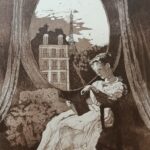
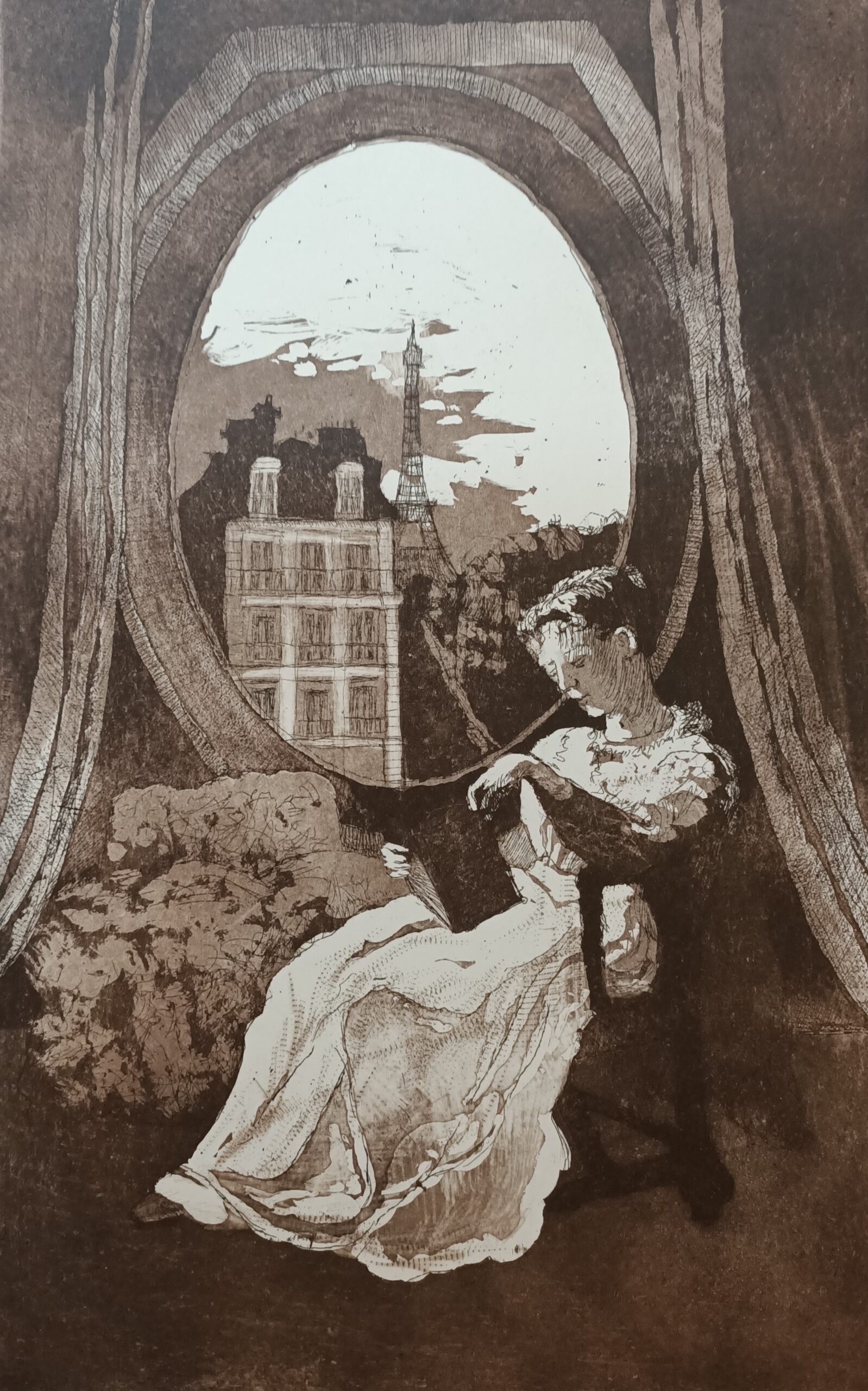

4e état, janvier 2023.

3e état, janvier 2023.
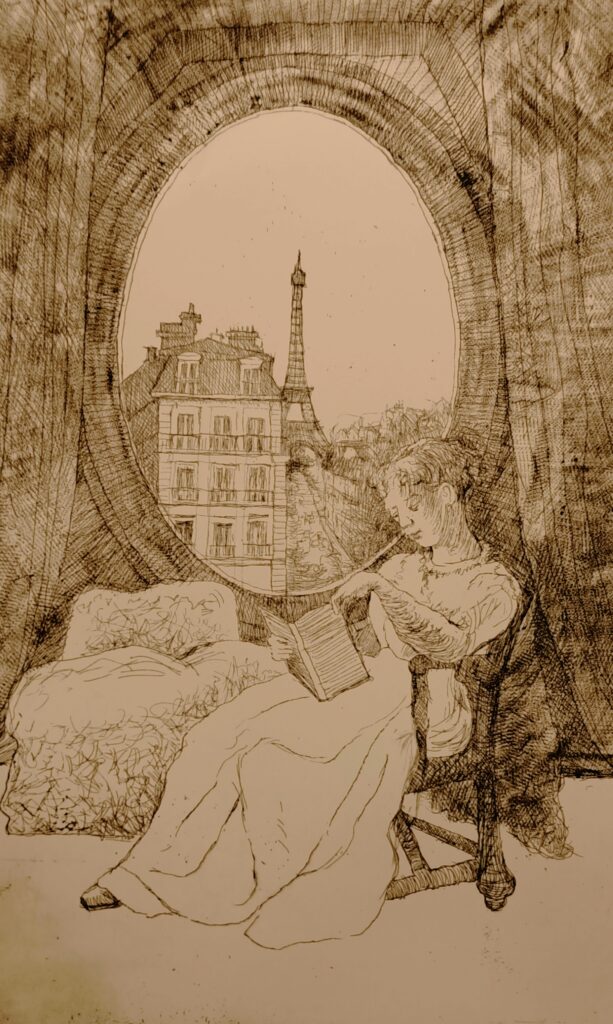
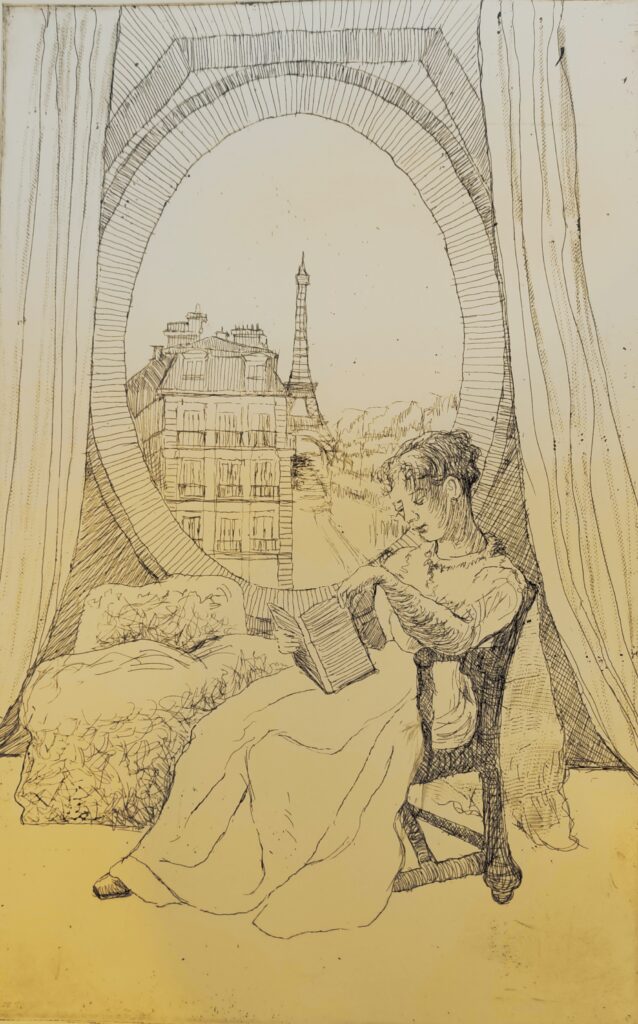
L’olivier du Pont du Gard
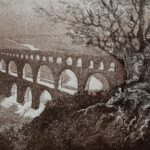



Autoportrait à l’écharpe
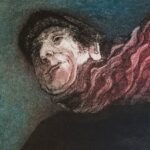
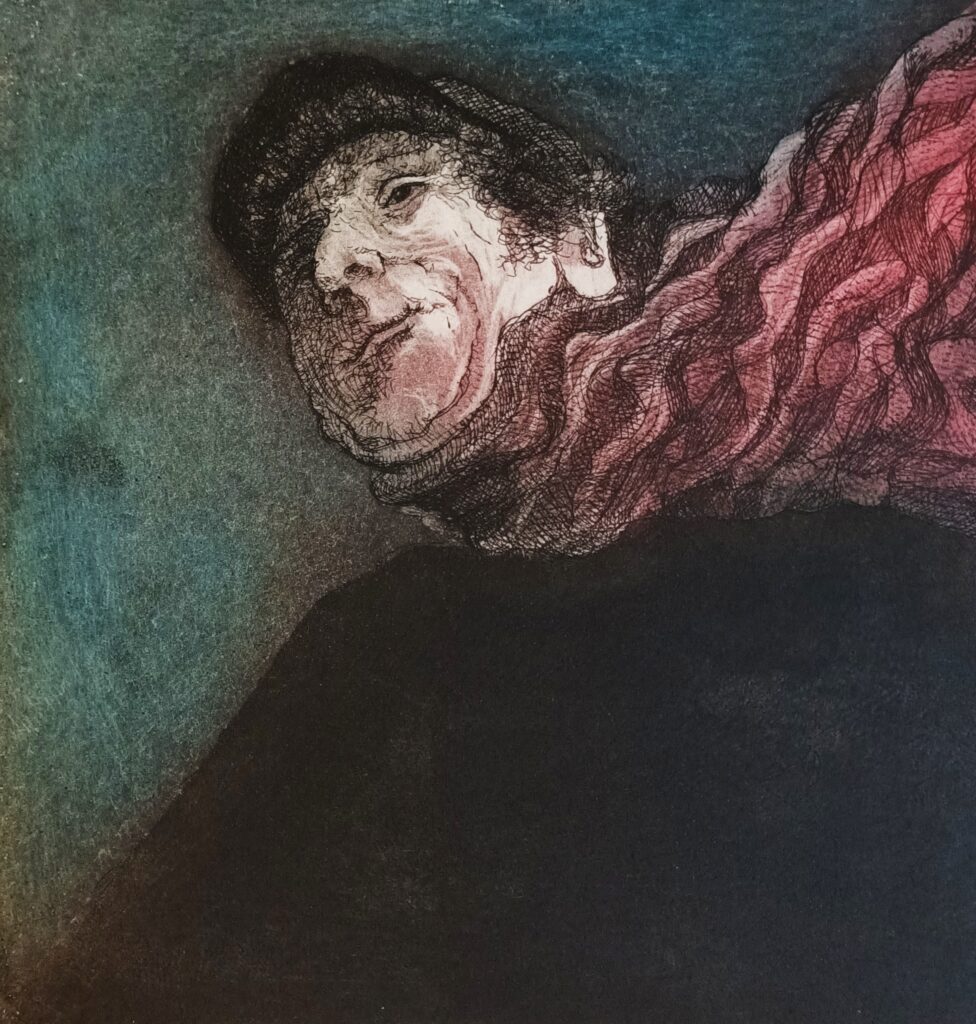
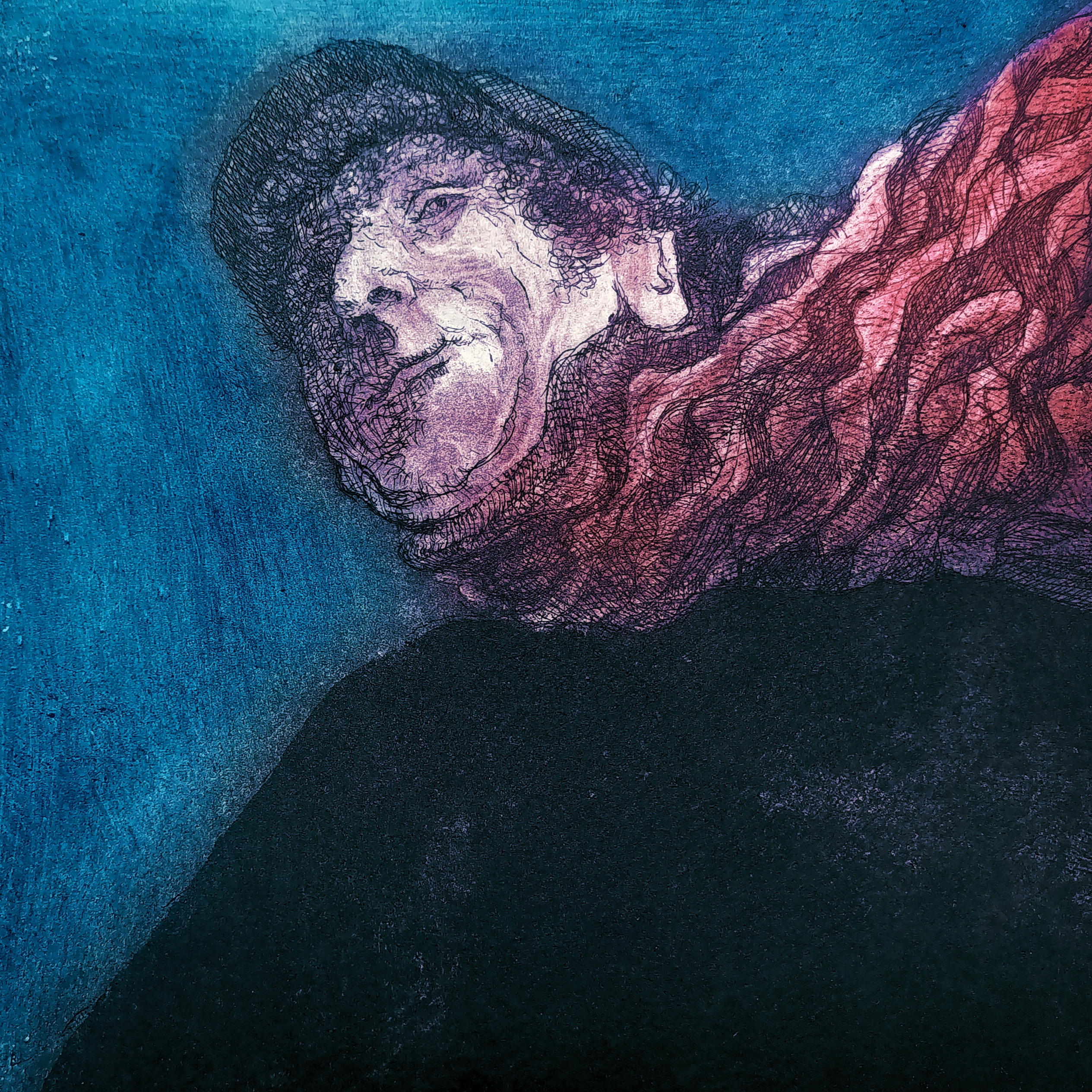
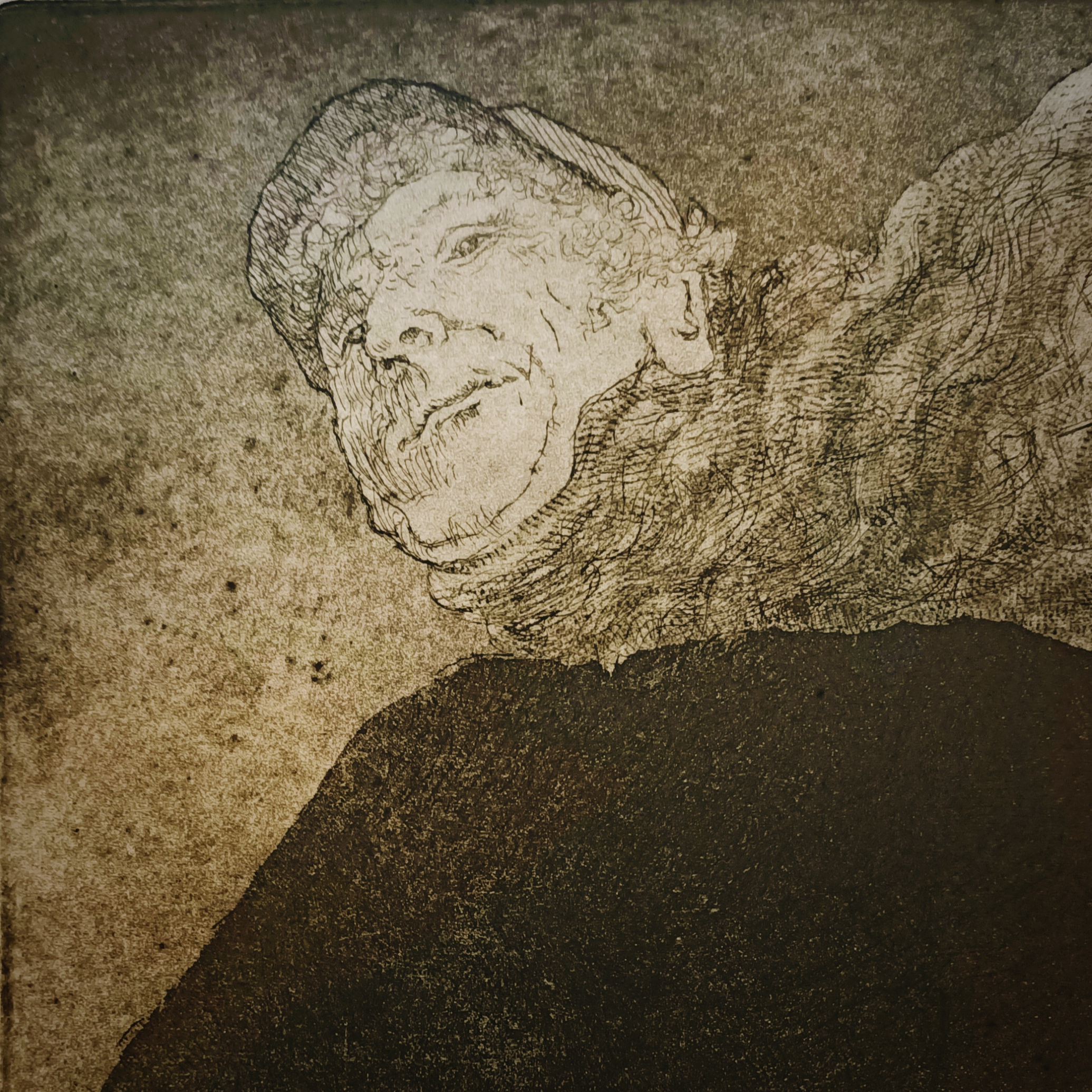

Raphael 1520-2020: What Humanity can learn from « The School of Athens »

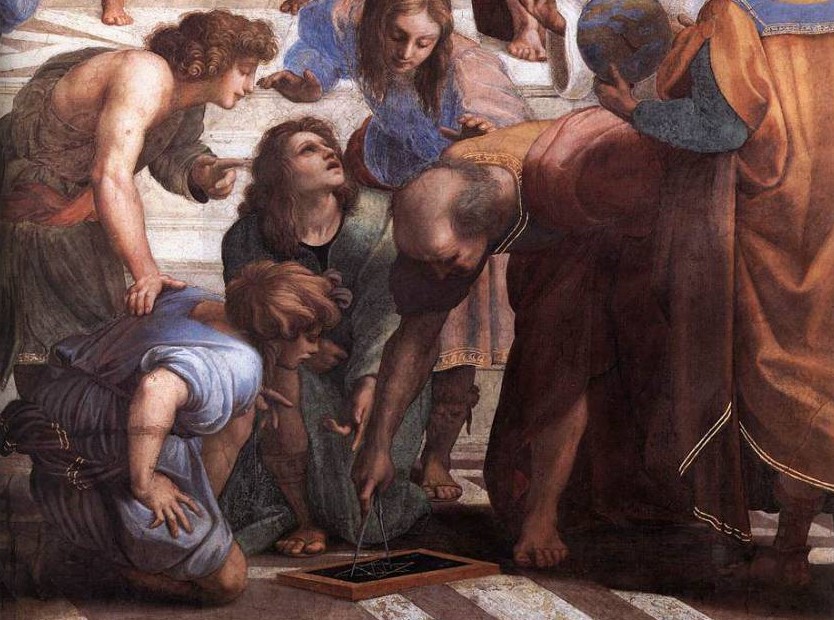
On the occasion of the five-hundredth anniversary of the death of the Italian painter Raffaello Sanzio da Urbino (1483-1520), several exhibitions are honoring this artist, notably in Rome, Milan, Urbino, Belgrade, Washington, Pasadena, London, and Chantilly in France.
The master is honored, but what do we really know about the intention and meaning of his work?
Introduction
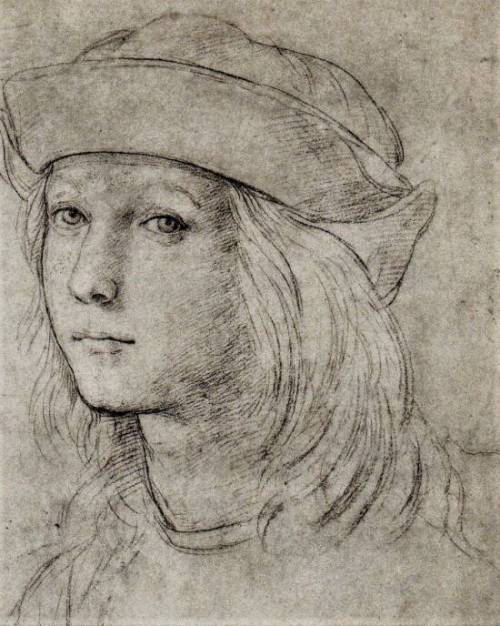
There is no doubt that in the collective mind of the West, Raphael, along with Michelangelo and Leonardo da Vinci, appears as one of the most brilliant artists and even as the best embodiment of the « Italian Renaissance”.
Although he died at the age of 37, Raphael was able to reveal his immense talent to the world, in particular by giving birth, between 1509 and 1511, to several monumental frescoes in the Vatican, the most famous of which, 7.7 meters long and 5 meters high, is known as The School of Athens.
The viewer finds himself inside a building that brings together the thoughts of all mankind: united in a timeless space, fifty philosophers, mathematicians and astronomers of all ages meet to discuss their vision of man and nature.
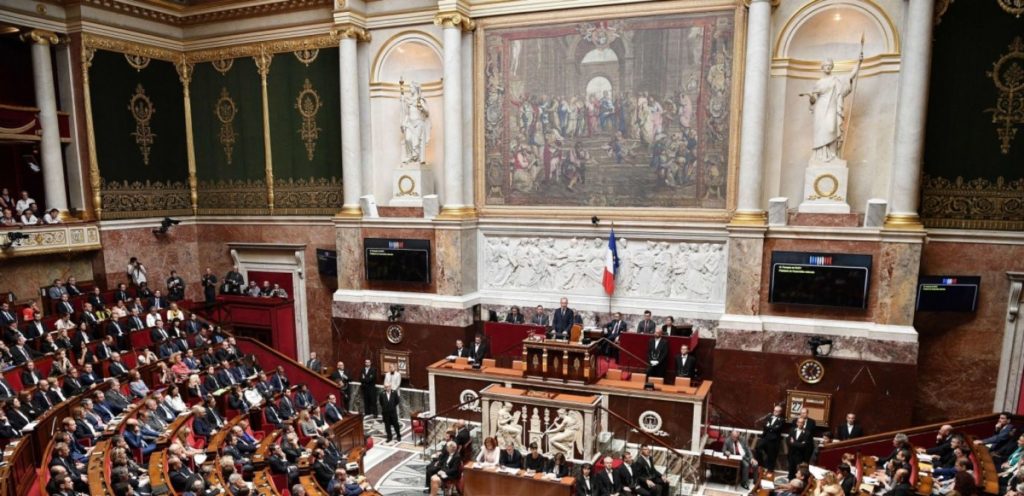
The image of this fresco embodies so powerfully the « ideal » of a democratic republic, that in France, during the February 1848 revolution, the painting representing Louis Philippe (till then hanging behind the President of the National Assembly) was taken down and replaced by a representation of Raphael’s fresco, in the form of a tapestry from the Manufacture des Gobelins, produced between 1683 and 1688 at the request of Jean-Baptiste Colbert, the founder of the French Academy of Sciences.
Then, in France, arrived the idea that Raphael, being « the Prince of painters », embodied « the ultimate artist ». Superior to Rubens or Titian, Raphael was thought to have achieved the subtle « synthesis » between the « divine grace » of a Leonardo da Vinci and the « silent strength » of a Michelangelo. What more can be said ? A true observation as long as one looks only at the purity of the « forms » and thus of the « style ». Adored or hated, Raphael was erected in France as a model to be imitated by every young talent attending our Academies of Fine Arts.
Hence, for five centuries, artists, historians and connoisseurs have not ceased to comment and often to confront each other, not on the intention or the meaning of the artist’s works, but on his style! In a way akin to some of our contemporaries who adore Star Wars and its special effects without paying attention to the ideology that, underhandedly, this TV series conveys…
For this brand of historians, « iconography », that branch of art history which is interested in the subjects represented, in the possible interpretations of the compositions or particular details, is only really useful to appreciate the « more primitive » paintings, that is to say that of the « Northern Schools »…
One knows well, especially in France, that once the « form » takes the appearance of perfection, it does not matter what the content is! This or that writer tells abject horrors, but « it is so well written! »
The good news is that in the last twenty years or so, a handful of leading historians and especially female art historians, have undertaken and published in depth new research.
I am thanking in particular of Marcia Hall (Temple University), Ingrid D. Rowland (University of Chicago), Reverend Timothy Verdon (Florence and Stanford), Jesuit historian John William O’Malley, and especially Christiane L. Joost-Gaugier.
The latter’s book Raphael’s Stanza della Signatura, Meaning and Invention (Cambridge University Press, 2002), which I was able to read (thanks to the pandemic lockdown), allowed me to adjust some of the leads and intuitions I had summarized in 2000 in, let’s be honest, a rather messy note.
If my work had consisted in trying to give some coherence to what is in the public domain, through their assiduous archival work in the Vatican and elsewhere, these historians, for whom neither Latin nor Greek have any secrets, have largely contributed to shed new light on the political, philosophical, cultural and religious context that contributed to the genesis of Raphael’s work.
Enriched by these readings, I have tried here, in a methodical way, to « make readable » what is rightly considered Raphael’s major work, The School of Athens.
Instead of identifying and commenting from the outset on the figures we see in the Stanza della Segnatura (« Room of the Segnatura” of the Vatican in Rome), I have chosen first to sketch a few backgrounds that serve as “eye-openers” to penetrate this work. For, in order to detect the painter’s intentions, actions and feelings, it is essential to penetrate the spirit of the epoch that engendered the artist’s: those days political and economic challenges, the cultural heritage of Rome and the Church, a close-up on the pope who commissioned the work, the philosophical convictions of the advisors who dictated the theme of the work, etc.
However, if all this seems too tedious for you dear reader, or if you are just eager to familiarize yourself with the work, nothing prevents you from going back and forth between the deciphering of the frescoes at the end of this article (Guided visit) and the contextualization that precedes them.
Cleaning our eyeglasses

To see the world as it is, let’s wipe our glasses and stop looking at the tint of our glasses. For as is often the case, what « prevents » the viewer from penetrating a work, from seeing its intention and meaning, is not what his eyes see as such, but the preconceived ideas that prevents him from looking at the outside world. Learning to see usually starts by challenging some of our preconceptions.
1. It’s not a easel painting! Since the 16th century, we Europeans have been thinking in terms of « easel paintings » (as opposed to mural). The artist paints on a support, a wooden panel or a canvas, which the client then hangs on the wall. However, The School of Athens, as such, is not a « painting » of this type, but simply, in the strict sense, a part or a « detail » of what we would call today, « an installation ». I explain myself. What constitutes the work here is the whole of the frescoes and decorations covering the ceiling, the floor and the four walls of the room! We will explain them to you. The viewer is, in a way, inside a cube that the artist has tried to make appear as a sphere. So, to « explain » the meaning of The School of Athens, in isolation from the rest and without demonstrating the thematic and symbolic interconnections with the iconography of the other walls, the ceiling and the floor, is not only an exercise in futility but utter incompetence.
2. Error of title! Neither at the time of its commission, nor at the time of its realization or in the words of Raphael, the fresco carried the name “School of Athens”! That name was given later. Everything indicates that the entire room covered with frescoes was to express a divine harmony uniting Philosophy (The School of Athens), Theology (on the opposite side), Poetry (on its right side) and Justice (on its left side). We will come back to that.
3. The theme is not the artist’s choice! The only person who met both Raphael and Pope Julius II during his lifetime was the physician Paolo Giovio (1483-1552) who arrived in Rome in 1512, a year before the death of Julius II. According to Giovio, it was the pontiff himself who, as early as 1506, that is, two years before Raphael’s arrival, conceived the contents of the « Signing Chamber ». This is logical, since it was the place where he installed his personal library, a collection of some 270 books, arranged on shelves below the frescoes and classified according to the themes of each wall decoration (Philosophy, Theology, Poetry and Justice). However, given the complexity of the themes, and given Julius II’s poor literary culture, historians agree that the intellectual authorship of the frescoes was attributed to the pope’s advisors and especially to the one who would have been able to synthesize them, his chief librarian, Thomaso Inghirami (1470-1516).
Raphael, who seems to have constantly modified his preparatory drawings according to the feedback and comments he received from the commissioners, was able to translate this theme and program into images with his vast talent. In short, if you like the images, congratulate Raphael; if you like or don’t like the content, talk to the « boss ».
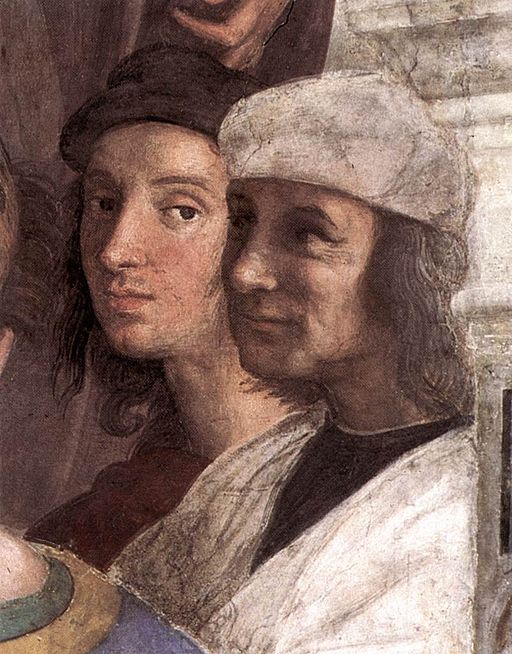
4. Painted by several people? What remains to be clarified is that, according to Vatican accounts, the entire decoration of the room was entrusted in mid-1508 to the talented fresco artist Giovanni Antonio Bazzi (1477-1549), six years older than Raphael and known as Il Sodoma. He appears to be the only person to have received any money for this work. Raphael does not appear in these accounts until 1513…
However, as the cycle of frescoes on the life of St. Benedict in the territorial abbey of Santa Maria in Monte Oliveto Maggiore testifies, Sodoma also had considerable talent, and above all, an incomparable know-how in fresco technique. Although he has never been honored, his style is so similar to Raphael’s that it is hard to mistake him.
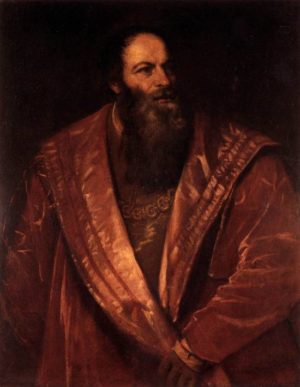
It should also be noted that Sodoma, who came to Rome at the request of the pope’s banker Agostino Chigi (1466-1520), was asked to decorate the latter’s villa in 1508, which would have given Raphael free rein in the Vatican before joining him on the same site.
According to the french historian Bernard Levergeois, the sulphurous Pietro Aretino (1495-1556), a pornographic pamphleteer, before becoming the protégé and « cultural agent » of the banker Chigi in Rome, spent many years in Perugia.
There he took interest in the young pupils of Pietro Perugino (c. 1448-1523), Raphael’s master, and, says Levergeois, it was there that he
met the most prestigious painters of the day: Raphael, Sebastiano del Piombo, Julius Romano, Giovanni da Udine, Giovan Francesco Penni and Sodoma, all of whom took turns decorating the magnificent villa (the Farnesina) that Chigi had built in Rome. Some of them also worked on the no less famous Villa Madam (for pope Julius II), a grandiose project that was never completed.
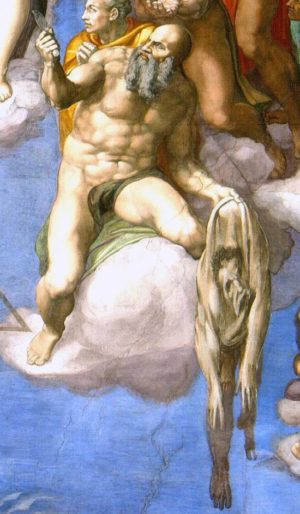
As seen in the portrait painted by Titian, Aretino, nicknamed « the scourge of Princes », was a powerful, possessive and tyrannical character. A blackmailer, a flamboyant pansexual and well-informed about what was going on in the alcoves of the elites, he worked himself up, like FBI boss Edgar Hoover in the Kennedy era, as a king-maker, a power above power. Historians report that both Raphael and Michelangelo, before showing their works to the public, felt compelled to seek the advice of this pervert Aretino.
And in the Sistine Chapel, Michelangelo depicts St. Bartolomeo in the guise of the Aretino. The artist must have thought that the traditional attribute of the martyr flayed alive was a perfect fit for the one who was bullying him: he is wearing the remains of his own skin and holding in his hand the large knife that was used for the torture…
It is therefore tempting to think that it was Aretino, the favorite of the Pope’s banker, and not necessarily Renaissance architect Donato Bramante, as is commonly accepted, who may have played the role of intermediary in bringing both Sodoma and Raphael to Rome in order to revive the glory of his patron and the oligarchy that held the Eternal City in contempt.
To my knowledge, Raphael, neither in his own letters nor in the statements reported by his entourage, would have commented on the theme and intention of his work. Strange modesty. Did he consider himself a simple « decorative painter »?
Finally, if Sodoma‘s participation in the realization of the School of Athens remains to be clarified, his portrait does appear. He is in the foreground on the far right, standing side by side to a rather sad Raphael (both on the side of the Aristotelians). A double signature?
This makes the question arise: Can one continue to speak of the frescoes as painted « by Raphael »? Are they not rather the frescoes of the four men team composed of Julius II, Inghirami, Sodoma and Raphael?
An unusual patron, « the warrior pope » Julius II
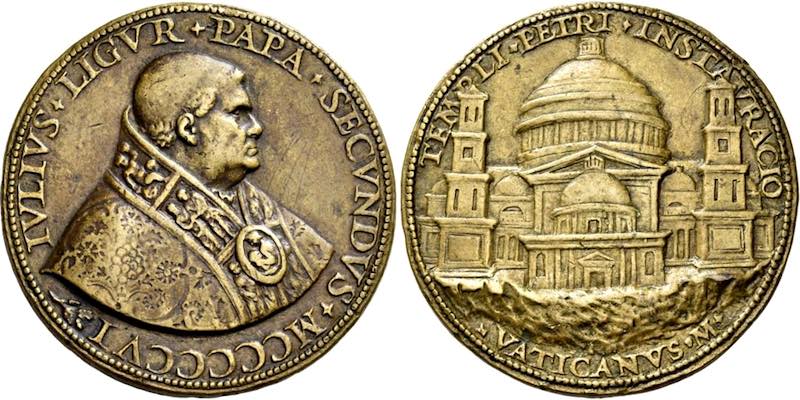
Before talking about these famous « impresarios of the Renaissance » and understanding their motivations, it is necessary to explore the character of future pope Julius II: Giuliano della Rovere (1443-1513). He was appointed bishop of Carpentras by Pope Sixtus IV, his uncle. He was also successively archbishop of Avignon and cardinal-bishop of Ostia.
On October 31, 1503, 37 of the 38 cardinals composing the Sacred College, make him the head of the Western Church, under the name of Julius II, until its death in 1513, a moment Giuliano had been waiting for 20 years.
Before him, others had made their way. In fact, in 1492, his personal enemy, the Spanish Rodrigo de Borgia (1431-1503), succeeded in getting himself elected as pope Alexander VI. True to the legendary corruption of the Borgia dynasty, he was one of the most corrupt popes in the history of the Church. Jealous and angry at his own failure, Giuliano accused the new pope of having bought a number of votes. Fearing for his life, he leaves for France to the court of King Charles VIII, whom he convinces to lead a military campaign in Italy, in order to depose Alexander VI and to recover the Kingdom of Naples… Accompanying the young French king in his Italian expedition, he enters Rome with him at the end of 1494 and prepares to launch a council to investigate the pope’s actions. But Alexander VI managed to circumvent the machinations of his enemy and preserved his pontificate until his death in 1503.
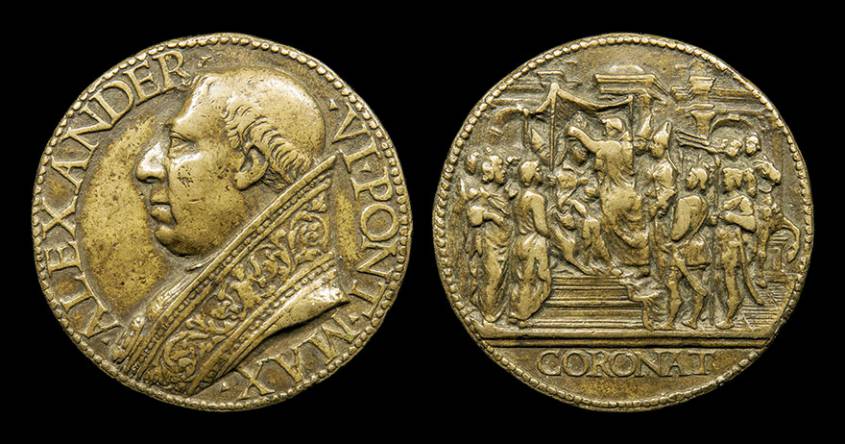
From the moment of his accession, Giuliano della Rovere confessed that he had chosen his name as pope, Julius II, not after Pope Julius I, but in reference to the bloodthirsty Roman dictator Julius Caesar. He asserts from the start his firm will to restore the political power of the popes in Italy. For him, Rome must once again become the capital of an Empire much larger than the Roman Empire of the past.
When Julius II took office, decadence and corruption had brought the Church to the brink. The territories that would later become Italy were a vast battlefield where Italian condottieri, French kings, German emperors and Spanish nobles came to fight. The ancient city of Rome was nothing more than a vast heap of ruins systematically plundered by rapacious entrepreneurs in the service of princes, bishops and popes, each one seeking to monopolize the smallest column or architrave likely to come and decorate their palace or church. Reportedly, out of the 50,000 inhabitants of the city, there were 10,000 prostitutes and courtesans…
Obviously, Julius II was the pope chosen by the oligarchy to restore a minimum of order in the house. For, particularly since 1492, the extension of Catholicism in the New World and then in the East, required a « rebirth », not of « Christian humanism », as during the Renaissance of the early 15th century, but of the authority of the Church.
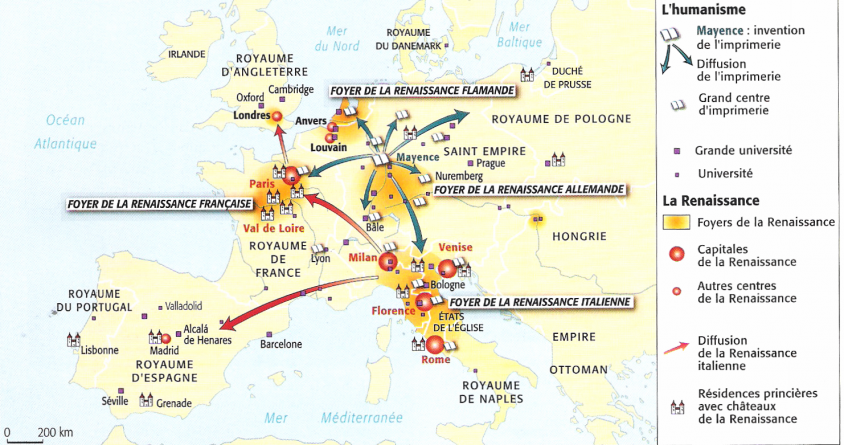
For us today, the word « Renaissance » evokes the heyday of Italian culture. However, for the powerful oligarchs of Raphael’s time, it was a matter of resurrecting the splendor of Greco-Roman antiquity, embodied in the glory of the Roman « Republic », mistakenly idealized as a great and well-administered state, thanks to efficient laws, capable civil servants possessing a great culture, based on the assiduous study of Greek and Latin texts.
And it is well to this rebirth of the Roman authority that Julius II is going to dedicate himself. In first place by the sword. In less than three years (1503-1506), the rebellious César Borgia is reduced to impotence. He was the illegitimate son of Pope Alexander VI who, at the head of an army of mercenaries, waged war in the country and terrorized the Papal States,
In 1506, Julius II, quickly nicknamed « the warrior pope » at the head of his troops, took back Perugia and Bologna.
As the humanist Erasmus of Rotterdam (1467-1537), who was present in Italy and was an eyewitness to the sacking of Bologna by the papal troops, reproached him, Julius II preferred the helmet to the tiara. Questioned by Michelangelo in charge of immortalizing him with a bronze statue, to know if he did not wish to be represented with a book in his hand to underline his high degree of culture, Julius II answers:
Why a book? Rather, show me a sword in hand.
Originally from the region of Genoa (Liguria), Julius II undertook to chase the Venetians, whom he abhorred, out of Romagna, which they occupied. « I will reduce your Venice to the state of hamlet of fishermen from which it left, » had said one day the Ligurian pope to the ambassador Pisani, to which the proud patrician did not fail to retort:
And we, Holy Father, we will make of you a small village priest,
if you are not reasonable…
This language gives the measure of the bitterness to which one had arrived on both sides. In the bull of excommunication launched shortly afterwards (April 27, 1509) against the Venetians, these were accused of « uniting the habit of the wolf with the ferocity of the lion, and of flaying the skin by pulling out the hairs… ».
The League of Cambrai

Against the rapacious practices of Venice, on December 10, 1508, in Cambrai, Julius II officially rallies to the « League of Cambrai », a group of powers (including the French King Louis XII, the regent of the Netherlands Margaret of Austria, King Ferdinand II of Aragon and the German Emperor Maximilian I).
For Julius II, the happiness is total because Louis XII comes in person to expel the Venetians of the States of the Church. Better still, on May 14, 1509, after its defeat by the League of Cambrai at the battle of Agnadel, the Republic of Venice agonizes and finds itself at the mercy of an invasion. However, at that juncture, Julius II, fearing that the French would establish their influence on the country, made a spectacular turnaround. He organized, from one day to the next, the survival of Venice!
His treasurer general, the Sienese banker Agostino Chigi (a Sienese billionaire close to the Borgias, to whom he had lent colossal sums of money and later Raphael’s patron), set the conditions:
- In order to pay for the Swiss mercenaries capable of repelling the attackers of the Ligue of Cambrai, Chigi granted the Venetians a substantial loan.
- In exchange, the Serenissima agreed to give up its monopoly on the trade of alum that it imported from Constantinople. At the time, alum, an irreplaceable mineral used to fix fabric dyes, represented a real « strategic » issue.
- Once Venice stopped importing alum, the entire Mediterranean world was forced, from one day to the next, to obtain supplies, not from Venice, but from the Vatican, that is to say, from Chigi, who was in charge of exploiting the « alum of Rome » for the Papacy, located in the mines of the Tolfa mountains, northwest of Rome in the heart of the Papal States.
- Aware that its very survival was at stake, and for lack of an alternative, Venice grudgingly accepted the golden deal.
In his biography on Jules II, french historian Ivan Cloulas specifies:
Above all stands out Agostino Chigi, the banker from Siena, farmer of the pontifical mines of alum of Tolfa since the reign of Alexander VI. The favor that this character enjoyed with Julius II is surprising, since he was a banker who had long served Caesar Borgia. The pontiff, according to the tradition, conferred at the time of his accession the load of ‘depositary’ to one of his Genoese compatriots, Paolo Sauli, charged to carry out all the financial transactions of the Holy See in connection with the cardinal camerlingue Raffaelo Sansoni-Riario. But Chigi did not suffer disgrace, because he advanced Julian della Rovere considerable sums of money to buy electors [cardinal members of the Sacred College], and he made the exploitation and export of alum extracted from the pontifical mines a success. The experience and value of the Sienese made him a partner of the various bankers of the papacy, notably the Sauli and the Fugger, who gained new wealth as the fruitful trade in indulgences developed in Germany.
Hence, now in alliance with Venice, Julius II, in what appears to the naive as a spectacular « reversal of alliance », set up the « Holy League » to « expel from Italy the Barbarians » (Fuori i Barbari!). A coalition in which he made enter the Swiss, Venice, the kings Ferdinand of Aragon and Henri VIII of England, and finally, the emperor Maximilian. This league will then drive out the French out of Italy. Julius II said with irony:
If Venice had not existed,
it would have been necessary to invent it.
In response, Louis XII, the King of France, attempted to transpose the struggle into the spiritual realm. Thus, a national council, meeting in Orleans in 1510, he declared France exempt from the obedience of Julius II. A second council was convened in Italy itself, in Pisa, then in Milan (1512) trying to depose the pope. Julius II opposed to the King of France the Vth ecumenical council of the Lateran (1512) where he will welcome warmly those who abandoned that of Milan…
Maritime Empires
Julius II was determined to re-establish his authority both on land and on the oceans. A bit like in ancient Greece, Italy experienced a rather particular phenomenon, that of the emergence of « maritime republics ». If the « Republic of Venice » is famous, the maritime republics of Pisa, Ragusa (Dubrovnik on the Dalmatian coast), Amalfi (near Naples) and Genoa are less known.
In each case, operating from a port, a local oligarchy built a maritime empire and above all poisoned its competitors. However, maritime activity, by its very nature, implies taking risks over time. Hence the need for skillful, robust and forward-looking finance, offering insurance and purchase options on future assets and profits. It is therefore no coincidence that most financial empires developed in symbiosis with maritime empires, notably the Dutch and British, and with the West and East India Companies.
At the end of the 15th century, it was essentially Genoa and Venice that were fighting for control of the seas. On the one hand, Venice, historically the bridgehead of the Byzantine Empire and its capital Constantinople (Istanbul), was by far the largest city in the Mediterranean world in 1500 with 200,000 inhabitants. Since its heyday in the 13th century, the Serenissima has defended tooth and nail its status as a key intermediary on the Silk Road to the West. On the other hand, Genoa, which, after having established itself in the Levant thanks to the crusades, by taking control of Portugal, financed all the Portuguese colonial expeditions to West Africa from where it brought back gold and slaves.
Two maritime achievements will exacerbate this rivalry a little more:
- 1488. Although the works of the Persian scholar Al Biruni (11th century) and old maps, including that of the Venetion monk Fra Mauro, made it possible to foresee the bypassing of the African continent by the Atlantic Ocean to reach India, it was not until 1488 that Portuguese sailors passed the Cape of Good Hope. Thus, Genoa, without any intermediary, could directly load its ships in Asia and bring its goods back to Europe;
- 1492. Seeking to open a direct trade route to Asia without having to deal with the Venetians or the Portuguese (Genoese), Spain sent the Genoese navigator Christopher Columbus west in 1492. More than a new route to Asia, Columbus discovered a new continent that would be the object of covetousness.
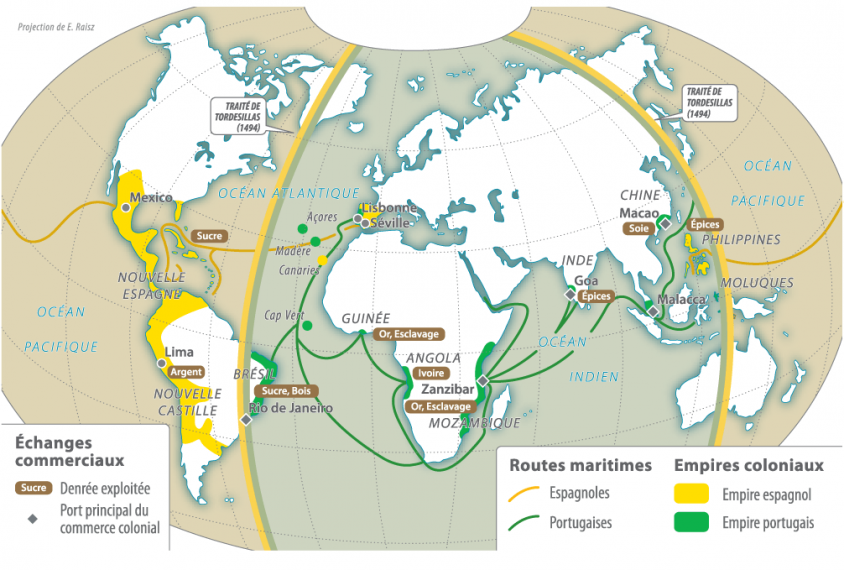
as signed on by Pope Alexander VI Borgia with the treaty of Tordesillas in 1494
Two years later, on June 7, 1494, the Portuguese and Spanish signed the Treaty of Tordesillas to divide the entire world between them. Basically, all of the New World for Spain, all of the old one (from the Azores to Macao) for Portugal. To delimit their empires, they drew an imaginary line, which Pope Alexander VI Borgia set in 1493 at 100 leagues west of the Azores and the Cape Verde Islands.
Later, the line was extended, at the request of the Portuguese, to 370 leagues. Any land discovered to the east of this line was to belong to Portugal; to the west, to Spain. At the same time, any other Western maritime power was denied access to the new continent. However, in 1500, to the horror of the Spaniards, it was a Portuguese who discovered Brazil. And given its geographical position, to the west of the famous line, this country fell under the control of the Portuguese Empire!
Julius II, a child of Liguria (region of Genoa, therefore linked to Portugal) and vomiting Alexander VI Borgia (Spanish), in 1506, takes great pleasure in confirming, by the bull Inter Cætera, the treaty of Tordesillas of 1494 allowing to fix the dioceses of the New World, obviously to the advantage of the Portuguese and therefore to his own.
The ultimate weapon, culture
On the « spiritual » and « cultural » level, if Julius II spent most of his time at war, posterity retains essentially the image of « one of the great popes of the Renaissance » as a great protector and patron of the arts.
Indeed, to re-establish the prestige (the French word for soft power) and therefore the authority of Rome and its Empire, culture was considered a weapon as formidable as the sword. To begin with, Julius II opened new arteries in Rome, including the Via Giulia. He placed in the Belvedere courtyard the antiques he had acquired, in particular, the « Apollo of Belvedere » and the « Laocoon », discovered in 1506 in the ruins of Nero’s Imperial Palace.
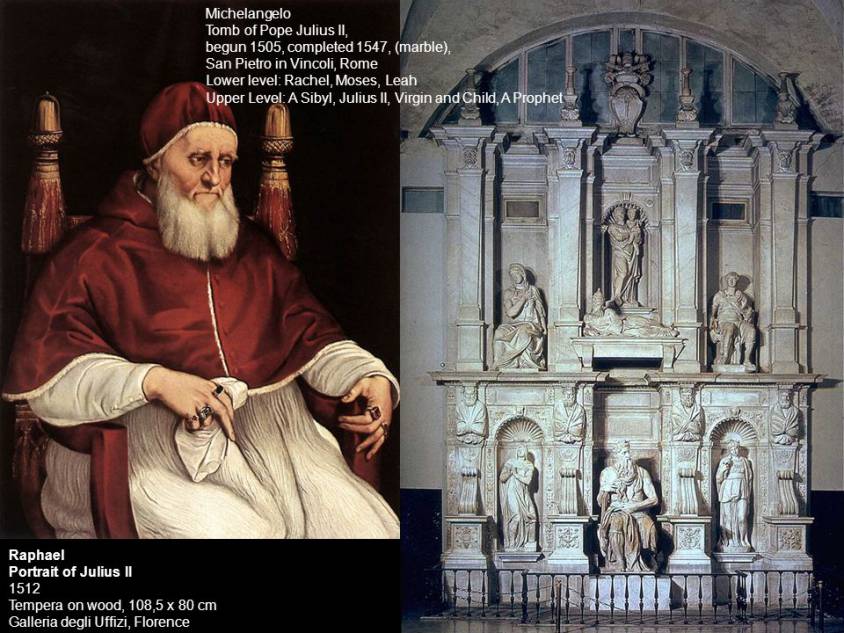
In the same year, that is to say six years before the end of the military operations, Julius II also launched great projects, some of which were only partially or entirely completed after his death:
- The reconstruction of St. Peter’s Basilica, a task entrusted to the architect and painter Donato Bramante (1444-1514) ;
- The tomb of Julius II, which the sculptor Michelangelo was entrusted with in the apse of the new basilica and of which his famous statue of Moses, one of the 48 bronze statues and bas-reliefs originally planned, should have been part;
- The decoration of the vault of the Sistine Chapel built by Pope Sixtus IV, the uncle of Julius II, was also entrusted to Michelangelo. Julius II let himself be carried away by the creative spirit of the sculptor. Together, they worked on ever more grandiose projects for the decoration of the Chapel. The artist gave free rein to his imagination, in a different artistic genre that did not please the pope. Until October 31, 1512, Michelangelo painted more than 300 figures on the vault;
- The frescoes decorating the personal library of the pope will be entrusted to the painter Raphael, called to Rome in 1508, probably at the suggestion of Chigi, Aretino or Bramante. The Stanza was the place where the pope signed his briefs and bulls. This room later became the private library of the pontiff Julius II, then the room of the Tribunal of Apostolic Signatures of Grace and Justice and later, that of the Supreme instance of appeal and cassation. Before the arrival of Julius II, this room and « the room of Heliodorus », were covered with frescoes by Piero della Francesca (1417-1492), a painter protected by the great Renaissance genius cardinal philosopher Nicolaus of Cusa (1401-1464), immortalizing the great ecumenical council of Florence (1438). Decorations by Lucas Signorelli and Sodoma were added later. Following his election, Julius II, anxious to mark his presence in history, and to re-establish the authority of the oligarchy and the Church, had the frescoes of the Council of Florence covered with new ones. Convinced by his advisors, the pope agreed to entrust the direction of the work to Raphael. Officially, it is said that Raphael spared some of the frescoes on the ceiling, notably those executed by Sodoma, so as not to antagonize him entirely. But, as we have said, the content, the very elaborate theme and part of the iconography of the frescoes were decided upon as early as 1506, even before Raphael’s arrival in 1508;
- To modernize the city of Rome. Julius II, undoubtedly advised by the architect Bramante, singularly transformed the road system of Rome. In order for all the roads to converge towards St. Peter’s Basilica, he ordered the Via Giulia to be pierced on the left bank and the Lungara, the paths that meandered along the river on the right bank, to be transformed into a real street. His death interrupted the great works he had planned, in particular the construction of a monumental avenue leading to St. Peter’s and that of a new bridge to relieve the congestion of the bridge over St. Angelo, to which he had also facilitated access by widening the street leading to it. The extent of the work undertaken poses the problem of materials; although it was, in principle, forbidden to attack the ancient monuments, the reality was quite different. Ruinante, became the nickname of Bramante.
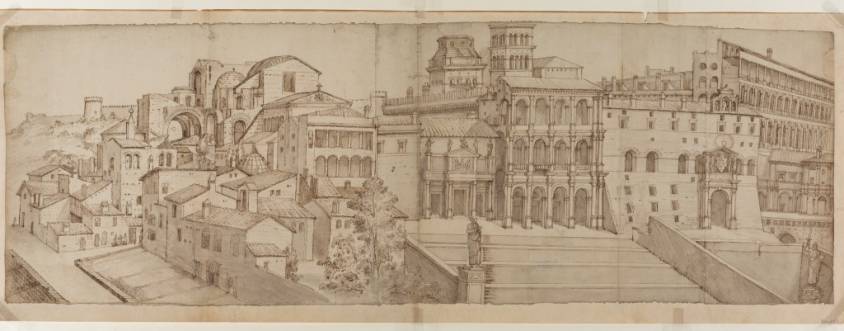
These major construction projects, patronage and military expenses drained the Holy See’s revenues. To remedy this, Julius II multiplied the sale of ecclesiastical benefits, dispensations and indulgences.
In the twelfth century, the Roman Catholic Church established the rules for the trade of « indulgences » (from the Latin indulgere, to grant) through papal decrees. They provided a framework for the total or partial remission before God of a sin, notably by promising, in exchange for a given amount of money, a reduction in the time spent in purgatory to the generous faithful after their death. In the course of time, this practice, essentially exploiting a form of religious superstition, turned into a business so lucrative that the Church could no longer do without it.
In northern Europe, particularly in Germany, the Fugger bankers of Augsburg were directly involved in organizing this trade. This practice was strongly denounced and fought against by the humanists, in particular by Erasmus, before Luther made it an essential part of the famous 95 theses that he posted, in 1517, on the doors of the church in Wittenberg.
In his book Erasmus and Italy, french historain Augustin Renaudet writes that Erasmus, after having met the highest authorities of the Vatican, was not fooled:
He was not long in understanding that apart from the Holy See, the services of the Curia and the Chancellery, apart from the cardinals, the innumerable prelates on mission and in charge, apart from a motley crowd of civil servants and scribes, who populated the administrative or financial offices and the courts, there was nothing in Rome. In all the cities he had known, in Brussels, in Paris, in London, in Milan, in Florence, and recently in Venice, an active economy, fed by industry, commerce, and finance, supported a strong urban bourgeoisie, or as in Venice, an aristocracy of shipowners. In Rome, all the economy, all the trade, all the finance, were in the hands of foreigners: Florentine or Genoese merchants, Florentine or Genoese bankers. These foreigners held in their dependence a people of small merchants, of small craftsmen who sold in the back room, of money changers and Jewish traffickers. Very little industry, the Roman population lived at the service of the Curia, the prelates and the convents. Erasmus marveled at the pride with which the descendants of the people-king pretended to maintain their ancient majesty.
The word of the Roman people was no longer an empty word; Erasmus was to write one day that, in the modern world, a Roman citizen counted less than a burgher of Basel.
Historians André Chastel and Robert Klein, in L’Humanisme, l’Europe de la Renaissance, share this observation:
Another trend, favorable to Caesar and Augustus, had emerged: Rome becoming again more and more the ‘imperial’ capital of all the powerful borrowed or sought to borrow a style from it.
This new style associates besides more and more arma and litterae, the sword and the book.
(…) Rich or poor, any sovereign of the Renaissance will occupy the artists and the scholars insofar as he needs prestige: the greatest patrons of the Renaissance were the ambitious and the warriors, Maximilian, Julius II, Henry VIII, François I, Charles V.
Raphael’s « impresarios »
If, from a contemporary point of view, it seems close to unthinkable for an artist to be « dictated » the theme of his work, this was not the case at the time of the Renaissance and even less so in the Middle Ages. For example, although he was a high-level diplomat of the Duke of Burgundy Philip the Good, the Flemish painter Jan Van Eyck (, one of the first painters to sign his works with his name, was advised on theology by the Duke’s confessor, the erudite Dionysus the Cartusian (1401-1471), a close friend of Cardinal Nicolaus of Cusa. And no one will dare say that Van Eyck « did not paint » his masterpiece The Mystic Lamb.
Raphael’s position was more delicate. In his time, painters still had the status of craftsmen. Including Leonardo da Vinci, who was known for his superior intelligence, declared himself to be a « man without letters », that is to say, unable to read Latin or Greek. Raphael could read and write Italian, but was in the same condition. And when, towards the end of his short life, he was asked to work on architecture (St. Peter’s Basilica) and urban planning (Roman antiquities), he asked a friend to translate the Ten Books of the Roman architect Vitruvius into Italian. Now, any visitor to the « Chambers of the Signature » is immediately struck by the great harmony uniting several dozen philosophers, jurists, poets and theologians whose existence was virtually unknown to Raphael before his arrival in Rome in 1508.
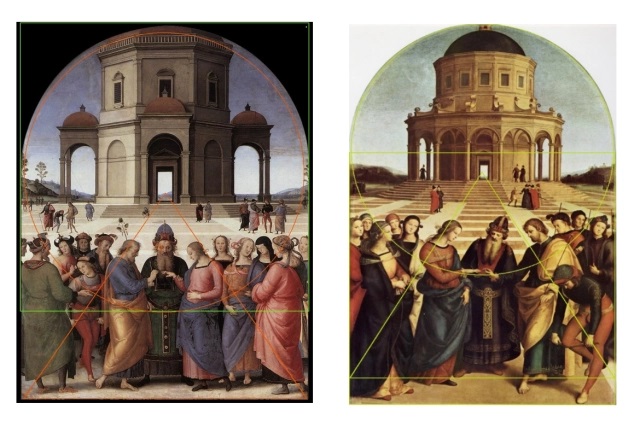
Moreover, with the exception of The Marriage of the Virgin, painted in 1504 at the age of 21, based on the way his master Pietro di Cristoforo Vannucci, known as Pietro Perugino (c. 1448-1523) had treated the same subject, Raphael had not yet had to meet the kind of challenge that the Stanza would pose to him.
As we have already said, the cartoons and other preparatory drawings, sometimes quite different from the final result, also suggest that, following the « commission, » discussions with one or more impresarios led the artist to modify, improve or change the iconography to arrive at the final result.
As for the theme, as we have already mentioned, the ideas and concepts seem to have emerged during a long period of maturation and were undoubtedly the result of multiple exchanges between Pope Julius II and several of his advisors, librarians, and « orators » of the papal court.
According to historian Ingrid D. Rowlands, the archival documents unquestionably indicate the decisive contribution of three very different personalities of the time:
- Battista Casali ;
- Giles of Viterbo;
- Tommaso « Fedra » Inghirami.
The thorough investigation of the historian Christiane L. Joost-Gaugier has established the predominant role of Inghirami. He was the only one in a position, and in a position, as the pope’s chief librarian, to set the program of the rooms. Raphael, will be his enthusiastic collaborator and will undoubtedly end up being « recruited » to the orientations and vision of his commissionners. This is evidenced by the fact that he demanded to be buried in the Roman Pantheon, considered the most Pythagorean, and believed to be the most neo-Platonic, temple of the Roman era.
Battista Casali
As documented by the Jesuit historian John William O’Malley, it was on January 1, 1508, the year of his appointment to St. John Lateran, a few months before Raphael’s arrival in Rome, that Battista Casali (1473-1525), a professor at the University of Rome, evoked the image of The School of Athens in an oration delivered in the Sistine Chapel in the presence of Julius II:
One day (… ) the beauty of Athens inspired a contest between the gods, where humanity, learning, religion, primacies, jurisprudence and law came into being before being distributed in every country, where the Athenaeum and so many other gymnasiums were founded, where so many princes of knowledge trained their youth and taught them virtue, fortitude, temperance and justice – all of this destroyed in the whirlwind of the Mohaematan war machine… ) However, just as [your illustrious uncle Pope] Sixtus IV [who ordered the construction of the Sistine Chapel], in a way, laid the foundations of education, you laid the cornice. Here is the Vatican library which he erected as if it had come from Athens itself, gathering the books he was able to save from the wreckage, and created in the image of the Academy. You, now, Julius II, supreme pontiff, have founded a new Athens when you invoke the downtrodden world of letters as if it were rising from the dead, and order it, surrounded by threats of suspended work, that Athens, its stadiums, its theaters and its Athenaeums, be restored.
Giles of Viterbo
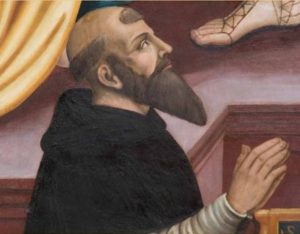
Another major influence on the theme, Giles of Viterbo (1469-1532) of which we will say more below.
- An outstanding orator, he was called to Rome in 1497 by Pope Alexander VI Borgia ;
- In 1503, he became the Superior General of the Order of Hermits of Saint Augustine; with 8000 members, it was the most powerful order of its time;
- He is known for the boldness and seriousness of the speech he gave at the opening of the Fifth Lateran Council in 1512;
- He severely criticized the bellicose policy of Julius II and urged him to triumph by culture rather than by the sword;
- After the death of the latter, he became the preacher and theologian of Pope Leo X who appointed him cardinal in 1517.
Tommaso Inghirami
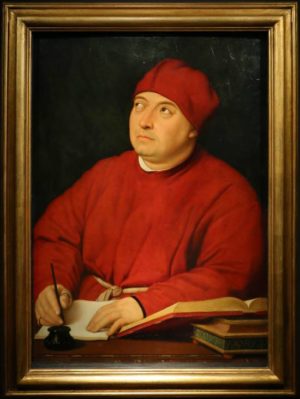
Finally, the prelate Tommaso Inghirami (1470-1516), who spoke both Latin and Greek, was also a formidable orator. The man owed his fortune to Lorenzo the Magnificent (1449-1492).
Educated by the Neoplatonic philosopher Marsilio Ficino, Lorenzo the Magnificent was the patron of both Botticelli and Michelangelo who lived with him for three years.
Born in Volterra, Inghirami was also taken in by the Magnificent after the sacking of that city. He carefully supervised his studies and later sent him to Rome where Alexander VI Borgia welcomed him. Inghirami was a handsome and well-dressed man.
At 16, Inghirami earned the nickname « Phaedra » after brilliantly playing the role of the queen who commits suicide in a Seneca tragedy performed in a small circle at the residence of the influential Cardinal Raphael Riario, cousin of Julius II or nephew of Pope Sixtus IV and therefore cousin of Julius II. Thereafter, Phaedra, bon vivant and for whom the celestial and terrestrial pleasures were happily completed, gained in political and especially… physical weight.
- In 1475, he accompanied the nuncio of Pope Alexander VI to the court of Emperor Maximilian I of the Holy Roman Empire, who named him Count Palatine and poet laureate;
- On January 16, 1498, Inghirami delivered an oration in the Spanish Church of Rome in honor of the Infant Don Juan, the murdered son of the King of Spain. Inghirami, in the name of Alexander VI Borgia, fully endorsed the Spanish policy of the time: to extend Christianity as well as imperial looting into the New World, to drive the Moors out of Europe and to strengthen the colonial plunder of Africa. If Julius II hated Alexander VI, he will continue this policy;
- In 1508, Julius II nominates Inghirami to head the Library of the Vatican to be installed in the Stanza;
- In 1509, while he was heavily involved in the realization of the frescoes of the Stanza, Raphael made his portrait. Raphael shows us a man suffering from divergent strabismus who seems to turn his gaze towards the sky in order to signify where this « humanist » drew his inspiration from;
- In 1510, the Pope appointed him Bishop of Ragusa;
- Finally, in 1513, he became papal secretary and at the urgent request of the dying pope, Inghirami delivered his funeral oration: « Good God! What a mind this man had, what sense, what ability to manage and administer the Empire! What a supreme and unshakable strength! »
Inghirami soon served as secretary to the conclave electing Pope Leo X (John of Medici, second son of Lorenzo de Medici, also a great protector of neo-Platonists and « culture »), another pope whose portrait Raphael will paint.
In 1509, eager to reform the Catholic church on the basis of the study of the three languages (Latin-Greek-Hebrew) to settle the religious conflicts which were looming and announced the religious wars to come, Erasmus of Rotterdam meets Inghirami in Rome. The latter exposes to him the imposing cultural building sites which he directed. Erasmus does not say a word about it.
However, a long time after the death of Inghirami, Erasmus complained that the Vatican and the oligarchy recruited among the humanists. He notably fingerpointed the sect of “the Ciceronians”, omnipresent in the Roman Curia and of which Inghirami was one of the leaders.
Thus, in 1528, in a pamphlet titled The Ciceronians, Erasmus quoted Inghirami’s oration on Good Friday of 1509. He denounced the fact that the members of this sect, on the grounds of the elegance of the Latin language, only used Latin words that appeared as they were in the works of Cicero! As a result, all the new language of evangelical Christianity, enshrined in the Council of Florence, which Erasmus wished to promote, was either banned or « re-translated » into pagan terms and words of the Roman era! For example, in his sermon, Inghirami had presented Christ on the cross as a pagan god sacrificing himself heroically rather than as a redeemer.
Finally, shortly after Raphael’s death, Cardinal Jacopo Sadoleto (1477-1547) wrote a treatise on philosophy in which Inghirami (meanwhile tragically deceased) defended rhetoric and denied the value of philosophy, his main argument being that everything written was already contained in the mystical and mythological texts of Orpheus and his followers…
Plato and Aristotle, the impossible synthesis
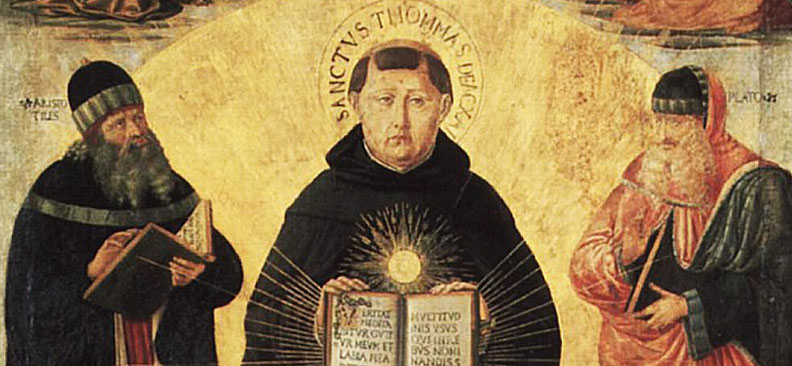
Now, in order to be able to « read » the theme deployed by Raphael in the « Chamber of the Signature, » let us examine this Florentine « neo-Platonism » that animated both Giles of Viterbo and Tommaso Inghirami.
The approach of these two orators consisted above all in putting their « neo-Platonism » and their imagination at the service of a cause: that of asserting with force that Julius II, the pontifex maximus at the head of a triumphant Church, embodied the ultimate outcome of a vast line of philosophers, theologians, poets and humanists. At the origin of a civilizational and theological « big bang » presumed to lead to the immeasurable lustre of the Catholic Church under Julius II, not only Plato and Aristotle themselves, but those who had preceded them including Apollo, Moses and especially Pythagoras.
From 1506 onwards, Giles de Viterbo, in an exercise that can be described as « beyond” impossible, wrote a text entitled Sententia ad mentem Platonis (« Sentences with the mind of Plato »). In it, he tried to combine into one ideology the Sentences of Peter Lombard (1096-1160), the scholastic text par excellence of the 13th century and the starting point for the commentaries of the Dominican Saint Thomas Aquinas (1225-1274) for his Summa Theologica, and the esoteric Florentine neo-Platonism of Marsilio Ficino (1433-1499) * of whom Giles de Viterbe was a follower.
All this could only please a pope who, in order to establish his authority on earthly and spiritual matters, warmly welcomed this agreement between Faith and Reason defended by Thomas Aquinas who says that “the Truth being one”, reason’s only role is to confirm faith’s superiority.
The very idea to present the wedding of Aristotelian scholasticism (logic presented as « reason ») with Florentine neo-Platonism (Plotinus’ emanationism dressed as « faith ») as a source of poetry and justice as « The Signing Room » does, comes from this.
Let us recall that in the middle of the 13th century, two mendicant Orders, the Franciscans and the Dominicans, were contesting the drift of a Church that had become, above all, the simple manager of its earthly possessions. The one who would later be called St. Thomas Aquinas, opposed on this point (his competitor) St. Bonaventure (1221-1274), founding figure of the Franciscan Order.
For his part, Aquinas relies on Aristotle, whom Albert the Great (1200-1280), whose disciple he was in Cologne, had made known to him, to establish the primacy of « reason ». For the man who was nicknamed « the dumb ox », faith and human reason, each managing their own domain, had to move forward together, hand in hand while of course, the Church had the last word.

Several paintings (the great fresco of 1366 in the Spanish chapel of Santa Maria Novella in Florence; the painting by Filippino Lippi of 1488 in the Carafa chapel in Rome; or the painting by Benozzo Gozzoli (1421-1497), painted around 1470, in the Louvre in Paris), have immortalized the “Triumph of Thomas Aquinas”.
Gozzoli’s painting in the Louvre is of particular importance because several elements prefigure the iconography of the Signing Chamber, notably the three levels found in Theology (Trinity, Evangelists and religious leaders) as well as the couple Plato and Aristotle found in Philosophy.
In Gozzoli’s painting, we see Aquinas, standing between Plato and Aristotle, throwing down before him the Arab philosopher Averroes (1126-1198) (Ibn-Rushd of Cordoba) expelled for having denied the immortality and the thought of the individual soul, in favor of a « Single Intellect » for all men that activates in us the intelligible ideas.
In the West, before the arrival of Greek delegations in Italy to attend the Council of Ferrara-Florence in 1438, if several works of Plato, including the Timaeus, were known to a handful of scholars, such as those of the School of Chartres or Italians as Leonardo Bruni in Florence, most of the West’s knowledge of Greek thought came down to the works of Aristotle.
For the Aristotelians, who became dominant in the Catholic Church with Aquinas, Plato had to be considered as incompatible with Christianity.
On the other hand, for the Platonists, including Augustine, Jerome and especially Nicholas of Cusa and Erasmus, who honored and adorned him that Erasmus called « Saint Socrates », Plato was to be venerated by Christians: he was monotheistic, believed in the immortality of the soul and venerated, in the form of the Pythagorean triad, the mystery of the Trinity.
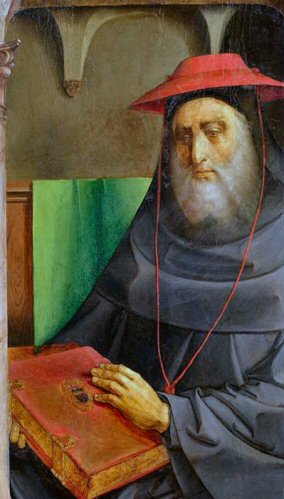
In the 15th century, for lack of epistemological clarity and some confusion on the authorship of certain manuscripts, some humanists, in particular Nicolaus of Cusa‘s friend and close collaborator Cardinal John Bessarion (1403-1472), one of the key organizers of the reunification of the Eastern and Western Churches, presented Plato as the « equal » of Aristotle, the latter’s disciple, with the sole purpose of making Plato « as acceptable as possible » to the Catholic Church.
Hence Bessarion‘s now famous phrase « Colo et veneror Aristotelem, amo Platonem » (I cultivate and venerate Aristotle, I love Plato) which appears in his In Calumniatorem Platonis (republished in 1503), a rejoinder to the virulent charge against Plato elaborated by the Greek Georges Trébizond.
Thus, in the School of Athens painted by Raphael, Plato and Aristotle appear side by side, not confronting each other but complementing the other with their respective wisdom : the first holding his book the Timaeus (on the creation of the universe) in one hand, and with the other, pointing to the sky (To the One, to God), the second holding his Ethics (the science of the good in personal life) in one hand, and raising the other arm horizontally to indicate the earthly realm (Physics).
If the commissioners had wanted to underscore the opposition of both philosophers, Plato would have rather been portrayed with his Parmenides (On Ideas) and Aristotle with his Physics (On natural sciences). That is clearly not the case.
Giles de Viterbo in his Sententia ad mentem Platonis will mobilize extreme sophism to erase the irreconcilable and very real oppositions (see box below) between the Platonic thought and that of Aristotle.
Why Plato and Aristotle are not complementary
By Christine Bierre
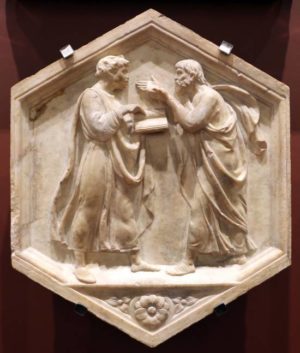
The fundamental concepts that gave birth to our European civilization can be traced back to classical Greece, and through it, to Egypt and other even more ancient civilizations.
Among the Greek thinkers, Plato (-428/-347 B.C.) and Aristotle (-385/-323 B.C.) asked all the great questions that interest our humanity: who are we, what are our characteristics, how do we live, where are we situated in the universe, how can we know it?
The accounts that have come down to us from this distant period speak of the disagreements that led Aristotle to leave Plato’s Academy, of which he had been a disciple. History then bears witness to the violence of the oppositions between the disciples of the one and the other. During the Renaissance, the most reactionary Catholic currents, the Council of Trent in particular, were inspired by Aristotle, whereas Plato reigned supreme in the camp of humanism, in the hands of some of the greatest, such as Erasmus and Rabelais.
There were various attempts, however, to make them complementary, as discussed in this article by Karel Vereycken. If Plato represents the world of Ideas, Aristotle represents the world of matter. Impossible to build a world without both, we are told. It seems so obvious!
The Greek philosopher, Plato.

All this starts, however, from a false idea opposing these two characters. For Plato, we are told, reality is found in the existence of ideas, universal concepts which represent, in an abstract way, all the things which participate of this concept. For example, the general concept of man contains the concept of particular men such as Peter, Paul and Mary; similarly for good, which includes all good things whatever they are. For Aristotle, on the contrary, reality is located in matter, as such.
What is false in this reasoning is the concept that the Platonic Ideas are abstractions. The Platonic Ideas are, on the contrary, dynamic entities that generate and transform reality. In the myth of the cave in The Republic, Socrates says that at the origin of things is the sovereign Good. In The Phaedo, he explains that it is through « Ideas » that this sovereign Good has generated the world.
In the myth of the cave, Socrates uses an offspring of the idea of the good, the Sun, to help us understand what the sovereign Good is. The Good, he says, has generated the Sun, which is, in the visible world, in relation to sight and objects of sight, what the Good is in the intelligible world in relation to intelligence and intelligible objects. The prisoners in the cave saw only the shadows of reality, and then, on coming out, they saw, thanks to the Sun, the real objects, the firmament and the Sun. After this, they will come to the conclusion about the Sun, that it is he who produces the seasons and the years, that he governs everything in the visible world and that he is in some way the cause of all those things that he and his companions saw in the cave.
The Sun not only gives objects the ability to be seen, but is also the cause of their genesis and development. In the same way for the knowable objects, they hold from the Good the faculty to be known but, in addition, they owe him their existence and their essence. The idea of the Good is thus for Plato the dynamic cause of the things: material and immaterial and not dead universals.
Aristotle’s splintered « One »
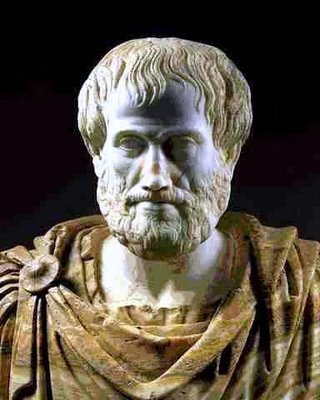
For Aristotle, as for all the empiricist current which followed him, reality is situated at the level of the objects knowable by the senses. Nature sends us its signals that we decode with our mental faculties. Ideas are only abstractions of the sensible universe which constitutes reality. For him the universals have no real existence: man « in general », does not generate anything. It is only an abstraction of all the men in particular. The particular man is generated by the particular man; Peter is generated by Paul.
It is also said of Aristotle that he « exploded » Plato’s One. There are two ways of conceiving the One. One can think of it either as an absolute One (God or first cause), depending on whether one is a religious person or a philosopher, a purely intelligible principle but a dynamic cause that has generated all things; or one can think of it as the number « one » that determines each particular thing: the number one when we say: a man, a chair, an apple.
Aristotle‘s One simply becomes a particular unity, characteristic of all things that participate in unity. It is not the cause of what « is » but only the predicate of all the elements that are found in all the categories. The Being and the One, he will say, are the most universal of predicates. The One, he will say again, represents a definite nature in each kind but never the nature of the One will be the One in itself. And the Ideas are not the cause of change.
What is the point of all this?
Does this discussion make more sense than all the never-ending debates about the sexes of angels that gave scholasticism such a bad name in the Middle Ages? The One or the many, what does it matter in our daily lives?
This point is however essential. The fact of being able to go back to the intelligible causes of all that exists, puts the human species in a privileged situation in the universe. Unlike other species, it can not only understand the laws of the universe, but also be inspired by them, in order to improve human society. This is why, in history, it is the « Platonic » current that was at the origin of the great scientific, technological and cultural breakthroughs in astronomy, geometry, mechanics, architecture, but also the discovery of proportions that allow the expression of beauty in music, painting, poetry and dance.
As for Aristotle, it must be said that his conceptions of man and knowledge only led him to establish categories defining a dozen possible states of being. Aristotle was also the founder of formal logic, a system of thought that does not claim to know the truth, but only to define the rules of a correct reasoning. Logic is so little interested in the search for truth that one can consider that a judgment that is totally false in relation to reality can be said to be right if all the rules of « good reasoning » of logic have been used.
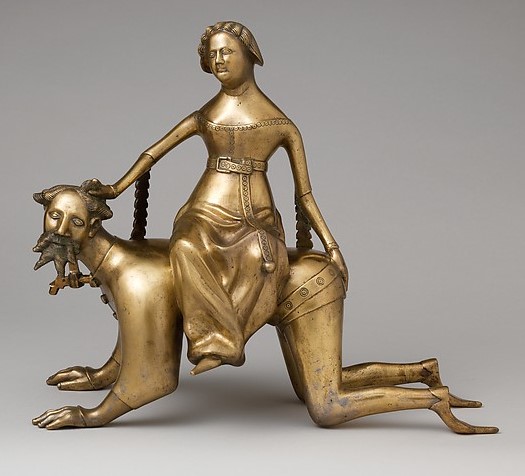
Suite
To begin with, Giles de Viterbo underlines that Aristotle is a « pupil » of Plato and that the « two princes of philosophy » could be reconciled. Very much imbued with the neo-Pythagorean spirit, and for whom Plato was only one of the greatest disciples of Pythagoras, the author argues that both philosophers agree that, contrary to the pagan pantheon, the « One » is the ultimate expression of the divine. Clearly, they were both monotheists and thus their convictions anticipated those of Christianity.
Giles of Viterbo:
Philosophy, which traces and examines all things, judges that all number and multiplicity are absent from God, as Plato and his pupil Aristotle say. Humanity has as its goal the understanding of divine things, as even Aristotle admits in his Ethics.
Thus, if it is necessary to pursue this goal, it is necessary to arrive at the understanding of God.
And he continues:
Now these princes of Philosophy [Plato and Aristotle] can be reconciled, and no matter how much they disagree about creation, the Ideas, or the goal of the Good, these points [of agreement] can be identified and demonstrated (…) [Then], they appear not to disagree with each other at all (…) These great princes can be reconciled if we postulate the double nature of things, one which is free from matter and the other which is within matter (…) Plato follows the first, Aristotle the second, and because of this, these two great leaders of philosophy hardly differ from each other. If you think that we are making this up, listen to them yourselves. For if we speak of humanity, after all the subject of our conversation, then Plato says the same thing, he says humanity is the soul, in the (First) Alcibiades; and in the Timaeus, he says that humanity has two natures, and we know one of these natures by means of the senses, and the other by means of reason. Also, in the same book, he teaches us that each part in us does not exist in isolation from the other, that each nature is concerned with the other nature. Aristotle, in the tenth book of his Ethics, calls humanity Understanding. So you can know that each philosopher (Plato and Aristotle) feels the same way, no matter how much it seems to you that they are not saying the same thing.
Pico della Mirandola the Neo-Platonist

Giles of Viterbo, like Tommaso Ingharimi, seems to have taken up the gauntlet thrown to them by John Pico della Mirandola (1463-1494), the young disciple of Ficino.
A precocious scholar, a protégé of Lorenzo de’ Medici (like Inghirami), this man of omniscience was fearless. Thus, in 1485, at the age of 23, he announced his project to gather, at his own expense, in the eternal city and capital of Christianity, the greatest scholars of the world to debate the mysteries of theology, philosophy and foreign doctrines. The objective was to go back from scholasticism to Zoroaster, passing by the Arabs, the Kabbalah, Aristotle and Plato, to expose to the eyes of all, the concordance of wisdom. The affair failed. His initiative, which reserved an important place for magic, could only arouse distrust. For the Vatican, all this could only smell of sulfur, and the initiative was discarded at the time.
However, it will mark the minds of a generation. For his Oratio de hominis dignitate, his inaugural speech written in an elegant and almost Ciceronian style, intended for the presentation of his nine hundred theses, published together after his death, was a great success, especially among young scholars like… Inghirami.
Pico’s achievement, which was not well received by the authorities, was to give humanistic studies (studia humanitatis) a new purpose: to seek the concordance of doctrines and define the dignity of the human being. The aim was, by bringing out what unites them despite their differences, to discover their common ground and, by a coincidence of opposites, to have them meet in a unity that transcends them.
Pico della Mirandola:
That is why, not content with having added to the common doctrines a quantity of remarks on the primitive theology of Mercury Trismegistus, on the teachings of the Chaldeans and Pythagoras, on the most secret mysteries of the Jews, we have also proposed for discussion a certain number of discoveries and conceptions of our own in the physical and theological fields. First of all, we have argued that Plato and Aristotle agree: many have thought so before us, no one has proved it sufficiently. Among the Latins, Boethius had promised himself to do so, but there is no indication that he ever realized what was always his project. Among the Greeks, Simplicius had given himself the same program: heaven forbid that he should have lived up to his intentions! Augustine himself, in his work Against the Academicians, writes that many authors have conceived, with great finesse in argumentation, the project of establishing this same point, namely that the philosophies of Plato and Aristotle are one. Thus John the Grammarian [The Hellenist John Lascarus] affirms well that only those who do not hear the words of Plato believe him to be in disagreement with Aristotle, but it is to his successors that he left the care of the demonstration. We have also added various developments where the concordance between the opinions – reputedly discordant – of Scotus and Thomas on the one hand, of Averroes and Avicenna on the other hand, is affirmed. Secondly, our considerations on Aristotelian and Platonic philosophy have been enriched by seventy-two new physical and metaphysical propositions: by making them one’s own, if I am not mistaken (and I will soon be sure of this), one will be able to solve any problem of a natural or theological nature, according to a philosophical method which is quite different from the one taught orally in schools and which is in honor among the doctors of our time.
In a manuscript found unfinished at the time of his death in 1494 and entitled Concordia Platonis et Aristotelis, Pico della Mirandola explicitly mentions Plato’s Timaeus and Aristotle‘s Ethics, precisely the two books that appear as attributes of their authors in Raphael’s fresco.
Then, in his Heptaplus, a work he completed in 1489, Pico della Mirandola asserted that the writings of Moses and the Mosaic Law, according to him the foundation of all wisdom, were the basis of Greek civilization before becoming that of the Church of Rome. The Timaeus, the major work of Plato, says Pico, demonstrates that its author was an “attic Moses” (from Athens).
Cicero the Neo-platonist
For Inghirami, fascinated by the eloquence and the style of Cicero (-106/-43 BC) of whom he believed himself the reincarnation, the challenge launched by Pico della Mirandola to reconcile Apollo, Pythagoras, Plato and Aristotle, appeared almost as a divine test and the frescoes of Raphael decorating the Stanza will be above all his answer.
In addition, Cicero himself claimed to be a neo-Platonist. In the first volume of his work, the Academica, after condemning Socrates for continually asking questions without ever « laying the foundations of a system of thought », Cicero asserts, several centuries before Pico della Mirandola, that the ideas of Plato and Aristotle, in essence, « had the same principles »:
In the shadow of Plato’s genius, a fertile, varied, universal genius, a unique philosophy was established under the double banner of the academicians and the peripatetics, who, agreeing on things, differed only on the terms. For Plato, who had made Speusippus, son of his sister, the heir of his philosophy, also left two disciples of great talent and rare science, Xenocrates of Chalcedony and Aristotle of Stagire: those who followed Aristotle, were named peripatetics, because they discussed while walking in the Lyceum; whereas those who, according to the institution of Plato, held their assemblies and disserted in the Academy, the other gymnasium of Athens, received from this place the name of Academicians. But both of them, all penetrated by Plato’s fertile genius, formulated philosophy into a certain complete and finished system, and abandoned the universal doubt of Socrates, and his habit of discussing everything without affirming anything. There was then what Socrates entirely disapproved of, a philosophical science, with regular divisions and a whole methodical apparatus. This philosophy, as I have said, under a double name, was one; for between the doctrine of the peripatetic [Aristotle] and the ancient Academy [Plato] there was no difference. Aristotle prevailed, in my opinion, by the richness of his genius; but the one and the other had the same principles, and judged the goods and the evils in the same way.

Inghirami was also strengthened by the reading of countless Christian authors in this sense, such as the Frenchman, Bernard of Chartres (12th century), a Neoplatonist philosopher who played a fundamental role in the Chartres school, which he founded. He was appointed master (1112) and then became chancellor (1119) responsible for the teaching of the cathedral school.
You wonder the sculptures of Pythagoras and Aristotle appear side by side on the western portal of the cathedral?
Historian Etienne Gilson writes:
Bernard of Chartres was first of all influenced by Boethius, whose Platonism he adapts. He then set out to reconcile Plato’s thought with that of Aristotle, which made him the greatest Aristotelian and Platonic thinker of the 12th century. John of Salisbury affirmed, in the most formal terms, that Bernard of Chartres and his disciples did not believe that they were simply expounding Plato’s thought by explaining in this way the relation of ideas to things, but that they had the pretension of putting Aristotle in agreement with Plato. That the trouble they took was wasted, is what John of Salisbury clearly states. With a very British humor he notes that these philosophers arrived too late and that they worked uselessly to reconcile dead men who had been arguing all their lives.
Inghirami will have read St. Bonaventure (1217-1274), one of the founders of the Franciscan order, who pointed out that Plato and Aristotle each excelled in their own field:
And so it appears that among philosophers, Plato’s gift is to speak of wisdom, Aristotle‘s of science.
Or the Florentine Marsilio Ficino, this neo-Platonic philosopher of the XVth century whose « Platonic Academy » had put in saddle Pico della Mirandola. Ficino, had he not written in his Platonic Theology that
Plato treats natural things divinely while Aristotle treats even divine things naturally.
In the preface he wrote for The Fable of Orpheus, a play written by his disciple Poliziano (1454-1494), Ficino, referring to Saint Augustine, makes the mythical Hermes Trismegistus (Mercury) the first of the theologians: his teaching would have been transmitted successively to Orpheus, Aglaophemus, Pythagoras, Philolaos and finally Plato.
Thereafter, Ficino will place Zoroaster at the head of these prisci theologi, to finally attribute to Zoroaster and Mercury an identical role in the genesis of the ancient wisdom: Zoroaster teaches this one among the Persians at the same time as Trismegistus taught it among the Egyptians.
Preceding Plato, Pythagoras

In Raphael’s School of Athens, the figure of Pythagoras of Samos (580-495 B.C.), surrounded by a group of admirers, takes a major place. He is clearly identifiable by a tablet on which the musical chords and the famous Tetraktys appear, which we will discuss here.
While historians have so far mainly explored the influence of the Platonic and Neo-Platonic currents on the Italian Renaissance, historian Christiane L. Joost-Gaugier, in her book Pythagoras and Renaissance Europe, has highlighted the extent to which the ideas of the great pre-Socratic thinker Pythagoras influenced the thought and art of the Renaissance.
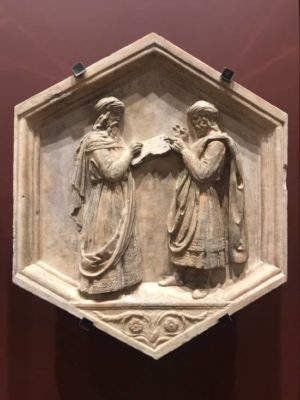
In art, Pythagoras inspired the Roman architect Vitruvius (90-15 BC), and later such theorists of the golden mean such as the Franciscan monk Luca Pacioli (1445-1517), whose treatise, De Divina Proportiona, illustrated by Leonardo da Vinci, appeared in Venice in 1509.
However, if a theorem, probably from India, bears his name (attributed to Pythagoras by Vitruvius), little is known of his life. Just like Confucius, Socrates and Christ, if we are sure that he really existed, no writing from his hand has come down to us.
By necessity, Pythagoras
became a living legend, and even very active during the Renaissance, so much so that most people saw Plato as a mere « disciple » of the « divine Pythagoras ».
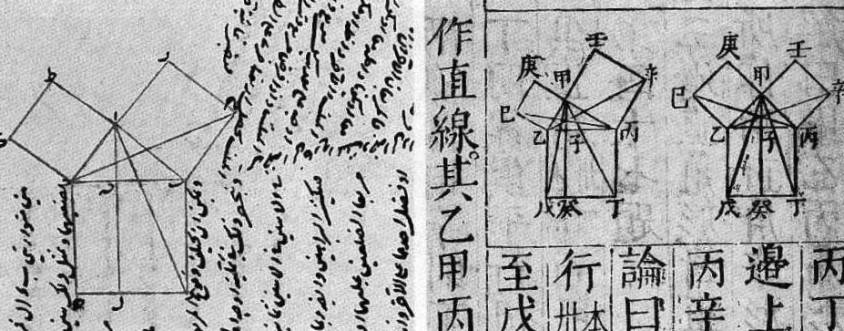
Born in the first half of the 6th century B.C. on the island of Samos in Asia Minor, Pythagoras was probably in contact with the school of geometer’s founded by Thales of Miletus (-625/-548 B.C.).
Around the age of 40, he left for Crotone in southern Italy to found a society of friends, both philosophical, political and religious, whose chapters were to multiply.
For Pythagoras, the issue is to build a bridge between man and the divine and on this basis to transform society and the city. When asked about his knowledge, Pythagoras, before Socrates and Cusa, asserted that he knew nothing, but that he sherished « the love of wisdom ». The word philo-sophy would have thus been born.
No Christian humanist, reading Saint Jerome (347-420), one of the Fathers of the Catholic Church, could escape the praise that the latter gives to Pythagoras.
In his polemic Apology against the Books of Rufinus, Jerome, in order to evoke an exemplary behavior, quotes what two disciples of Pythagoras would have said:
We must by all possible means avoid softness of the body, ignorance of the spirit, intemperance, civil dissensions, domestic dissensions and in general excess in all things.
And Jerome invokes the « Precepts of Pythagoras » :
Everything must be common among friends; a friend is another ourselves. We must consider two periods in life, the morning and the evening, that is, what we have done and what we must do. After God, we must seek the truth, which alone can bring men closer to the Creator.”
Secondly, Jerome believes that Pythagoras, in affirming the concept of the immortality of the soul, preceded Christianity:
Listen to what Pythagoras was the first to find in Greece, Jerome says: That souls are immortal, that they pass from one body into another, and, it is Virgil himself who tells us in the sixth book of the Aeneid: When they have made a revolution of a thousand years, God calls them in great numbers to the banks of the river Lethe, so that they may undoubtedly see again the heaven they no longer remember; it is then that they begin again to revive a new body, which first was Euphorbus, then Calide, then Hermoticus, then Perhius and finally Pythagoras ; and that after a certain time what has existed begins to be born again, that there is nothing new in the world, that philosophy is a collection of meditations on death, that every day it strives to free the soul from the chains that bind it to the body and to give it back its freedom. Plato communicates many other ideas in his writings, especially in the Phaedo and in the Timaeus.
The hidden geometry of numbers
For Pythagoras « the beginning is half of everything ». According to Theon of Smyrna (v. 70/v. 135), for the philosopher, « numbers are, so to speak, the principle, the source and the root of all things ».
Aristotle, in his Metaphysics reports:
The Pythagoreans first applied themselves to mathematics… Finding that things [including musical sounds] model their nature mainly on the set of numbers and that numbers are the first principles of the whole of nature, the Pythagoreans concluded that the elements of numbers are also the elements of everything that exists, and they made the world a harmony and a number.
And as Cleinias of Tarantum (4th century BC), a Pythagorean friend of Plato, said:
When these things, therefore, are at rest, they give birth to mathematics and geometry, when they are in motion to the harmonica and astronomy.
The idea of the « monad », a dynamic unity participating in the One, perfected several centuries later by the philosopher and scientist Gottfried Wilhelm Leibniz (1646-1716) in his « Monadology« , comes to us from this period. Etymologically meaning « unity » (monas), it is the supreme unity (the One, God, the principle of numbers) which, while being at the same time the minimal unity, reflects in the microcosm the same dynamic activity that the One represents in the macrocosm.
Already, just the name of Apollo (a god considered as « the father » of Pythagoras) means, as Plato, Plutarch and other ancient authors point out: free of all multiplicity (Pollo = multiplicity; a-pollo = non-multiple).
Xenophanes of Colophones (born around 580 BC), asserts the existence of a unique God governing all things by the power of his intelligence. It is about a god not similar to the men, because eternal, incorporeal and spherical.

As much as this conception of a dynamic One has sometimes provoked an explosion of esoteric interpretations, it has stimulated the most creative minds and terrorized the formalists of thought.
When speaking about simple things, arithmetic numbers, Pythagoras uses the terms of one, two, three, four, five, ten…, while to evoke ideal numbers and their power, he speaks about: monad, dyad, triad, tetrad, decad, etc. Thus, by conceiving numbers in a non-linear but figurative way, he offers an arithmetic applicable to astronomy, music and architecture. By arranging these numbers, like marbles, in a particular way, Pythagoras discovered the famous « geometry of numbers ». For example, in the case of triangular numbers, three points form a triangular surface. If we add three points below, we find the number 6, but it is still a triangle. And if we add four more points, we get the number 10, still a triangular number.
The Patriarch of Constantinople Photius (810-893) confirms that :
The Pythagoreans proclaimed that the complete number is ten.
The number ten, is a compound of the first four numbers that we count in their order. That is why they called Tetraktys the whole constituted by this number.
Besides the plane and triangular numbers (1, 3, 6, 10, etc.), Pythagoras explored the square numbers (1, 4, 9, 16, …), rectangular, cubic, pyramidal, star-shaped, etc. In doing so, Aristoxenus said, Pythagoras had « raised arithmetic above the needs of merchants ». This approach, that of seeing harmony above and within the multiple, has inspired many scientists throughout history. One thinks of Mendeleev for the elaboration of his table of elements or of Einstein.
The power of numbers was also well understood by the cardinal-philosopher Nicolaus of Cusa, who evokes Pythagoras in the first chapter of his treatise De Docta Ignorantia (1440), when he states that :
All those who search, judge the uncertain by comparing it to a certain presupposition by a system of proportions. All research is therefore comparative, and uses the means of proportion: if the object of research can be compared to the presupposition by a small proportional reduction, the judgment of apprehension is easy; but if we need many intermediaries, then difficulty and pain arise. This is well known in mathematics: the first propositions are easily brought back to the first principles which are very well known, whereas the following ones, because they need the intermediary of the first ones, have more difficulty. Therefore, all research consists of a comparative proportion, easy or difficult, and this is why the infinite, which escapes, as infinite, from all proportion, is unknown. Now, the proportion which expresses agreement in a thing on the one hand and otherness on the other hand, cannot be understood without the number. This is why the number encloses all that is susceptible of proportions. Therefore, it does not create a proportion in quantity only, but in everything that, in some way, by substance or by accident, can agree and differ. Therefore, Pythagoras strongly believed that everything was constituted and understood by the power of numbers. Now, the precision of combinations in material things and the exact adaptation of the known to the unknown are so far above human reason that Socrates considered that he knew nothing but his ignorance; at the same time as the very wise Solomon affirms that all things are difficult and that language cannot explain them.
The Geometry of numbers,
the secret of mental calculations
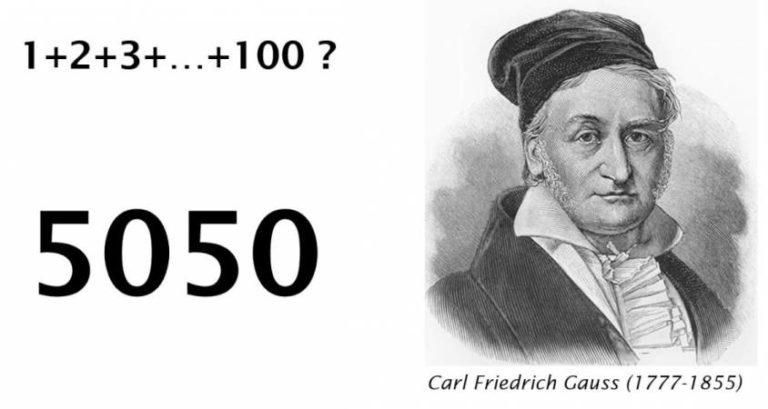
Here is a simple example.
One day, in Göttingen, the teacher of the young German mathematician Carl Gauss (1777-1855) asked his students to calculate the sum of all the numbers from one to one hundred. The students did so and began to add the numbers 1 + 2 + 3 + 4 + 5, etc.
The young Gauss raises his hand and, following a mental calculation, announces the result of the operation: « 5050, Sir! »
The teacher, surprised, asks him how he arrived at the result so quickly. The young Gauss explains: to see if there is a geometry in the number 100, I added the first digit (1) with the last (100). This gives 101. Now, if I add the second digit (2) with the second to last one (99), it also makes 101. I concluded that within the number 100 there are fifty pairs of even and odd numbers whose sum is 101 each time. Thus, by multiplying 101 by the number of couples (50), I immediately arrive at 5050.
From Pythagoras to Plato
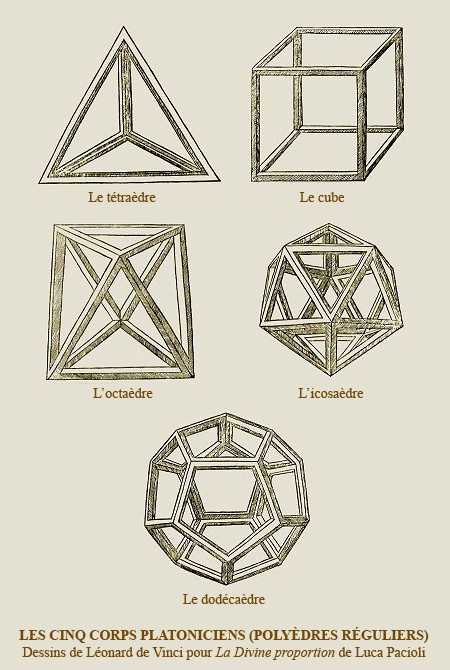
For Pythagoras, the most perfect surface is the circle and the ideal volume is the sphere since regular polyhedra can be inscribed. According to one of his disciples, the Italian Philolaus of Croton (-470/-390 BC), Pythagoras would have been the first to define the five regular polyhedrons:
- the cube,
- the tetrahedron (a pyramid with 4 triangular faces),
- the octahedron (composed of 8 triangles),
- the icosahedron (64 triangles) and
- the dodecahedron (composed of 12 pentagons).
Since Plato describes them in his work, the Timaeus, these regular polyhedra took the name of « Platonic solids ». Let’s recall that Plato went to Italy several times, notably to meet his close friend, the great Pythagorean scientist, astronomer, musical theorist and political leader, Archytas of Tarantum (-428/-387), considered today as « the father of robotics ».
A direct disciple of Philolaos, Archytas became the mathematics teacher of the brilliant Greek astronomer and physician Eudoxus of Cnidus (-408/-355).

Starting with Archytas, the Pythagoreans associate the 1 to the point, the 2 to the line, the 3 to the surface (the two-dimensional geometrical figure: circle, triangle, square…), the 4 to the solid (the three-dimensional geometrical figure: tetrahedron, cube, sphere, etc.).
Let’s add that in the Timaeus, one of Plato’s last dialogues, after a brief exchange with Socrates, Critias and Hermocrates, the Pythagorean philosopher Timaeus of Locri (5th century BC) exposes a reflection on the origin and the nature of the physical world and of the human soul seen as the works of a demiurge while addressing the questions of scientific knowledge and the place of mathematics in the explanation of the world.
Cicero (Republic, I, X, 16) specifies that Timaeus of Locri was an intimate of Plato:
No doubt you have learned, Tuberon, that after the death of Socrates, Plato went first to Egypt to learn, then to Italy and Sicily, in order to learn all about the discoveries of Pythagoras.
There he lived for a long time in the intimacy of Archytas of Taranto and Timaeus of Locri, and had the chance to obtain the Commentaries of Philolaos.
The music of the spheres
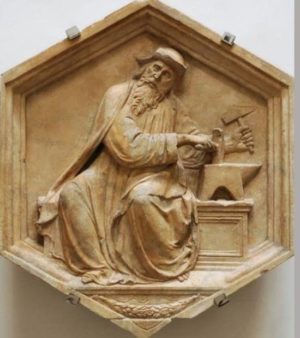
A magnificent bas-relief on the campanile of the Florence cathedral reflects what the early Italian humanists knew about Pythagoras.
Luca della Robbia (1399-1482), the sculptor working on the instructions of the humanist chancellor of Florence Leonardo Bruni (1370-1444), shows Pythagoras, a large hammer in one hand, a small hammer in the other, striking an anvil and concentrating his mind on the difference in the sounds he produces.
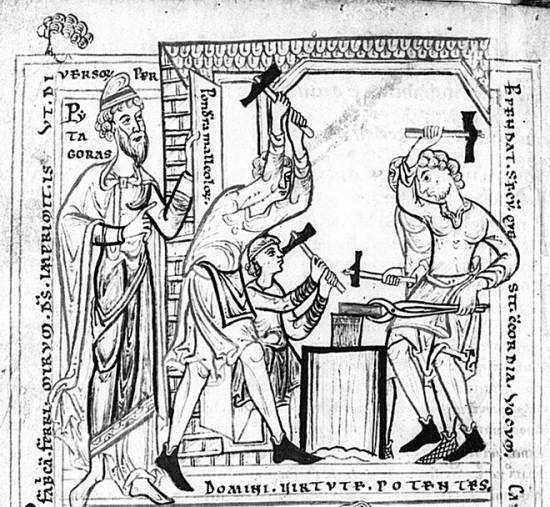
According to the legend, Pythagoras was walking near a forge when his attention was caught by the sound of hammers striking the anvil. He discerned in his ear the same consonances as those he could produce with his lyre. His intuition led to a fundamental discovery: musical sounds are governed by numbers.
This is how Guido d’Arezzo (992-1050), the Benedictine monk who created the system of musical notation still in use, relates the event in the last chapter (XX) of his book Micrologus around 1026:
A certain Pythagoras, a great philosopher, was traveling adventurously; he came to a workshop where an anvil was being struck with five hammers. Amazed by the pleasant harmony [concordiam] they produced, our philosopher approached them and, believing at first that the quality of sound and harmony [modulationis] lay in the different hands, he interchanged the hammers. When this was done, each hammer retained its own sound. After having removed one that was dissonant, he weighed the others, and, admirably, by the grace of God, the first weighed twelve, the second nine, the third eight, the fourth six of I don’t know what unit of weight. He thus knew that the science [scientiam] of music resided in the proportion and ratio of numbers [in numerorum proportione et collatione] […] What can we say about the science of music? […] What more can be said? By arranging the notes according to the intervals mentioned above, the illustrious Pythagoras was the first to perfect the monochord. As it is not lasciviousness that one finds there, but a fast revelation of the knowledge of our art, it met a general assent among the scholars. And this art has gradually been affirmed and developed to this day, for the Master himself always illuminates the human darkness and his supreme Wisdom endures for all centuries. Amen.
Here, the diagram (found on a slate placed at the feet of Pythagoras in Raphael’s fresco), which visualizes the musical harmonies obtained by dividing a string. Dividing it in two gives the octave, in three the fifth and in four the fourth. Finally, epogdoon (from the prefix epi- meaning above and ogdoon meaning the eighth) translates the interval of 9/8, which here corresponds to the tone.
IMAGE
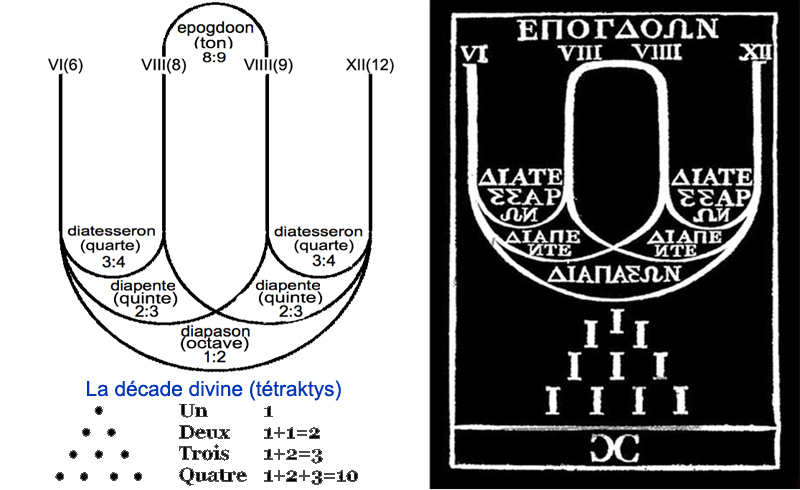
Let’s go back to the harmonic ratios that Pythagoras discovered from the weights of the hammers: 12, 9, 8 and 6.
- The ratio between 12 and 6 is the half and corresponds to the octave (diapason). It is found on a musical instrument by vibrating half a string;
- The ratio between 12 and 8 is a ratio of two thirds, which corresponds to the fifth (diapente);
- The ratio between 8 and 6, is a ratio of three quarters, which corresponds to the fourth (diatessaron);
- Finally, the ratio between 8 and 9 gives the interval of a tone (epogdoon, the prefix epi- meaning above and ogdoon meaning the eighth).

Later, the Pythagoreans transposed the same proportions to other objects, including volumes of water in glasses, the size of bells as well as bronze disks or the length of strings of musical instruments or flutes. For Pythagoras, this experience is fundamental because it corroborates the basic intuition of his philosophy: everything that exists is number, including phenomena as immaterial as musical intervals. In a famous passage of the Timaeus (35-36), Plato describes the fabrication of the proportions of the World Soul by the Demiurge. This passage is based on the numerical series 1, 2, 3, 4, 9, 8, 27, which corresponds to the fusion of the series of the first powers of 2 (2, 4, 8) and the series of the first powers of 3 (3, 9, 27). Now, from this series, we can derive the numerical relationships on which the musical intervals are based.
In his Metaphysics, Aristotle also notes :
The Pythagoreans noticed that the whole of the modes of musical harmony and the relations which compose it are resolved in proportional numbers.
With the French philosopher Pierre Magnard, we would rather say:
If to know is to measure, music is the art of pursuing measurement beyond the threshold of incommensurability. When numerical, metric and weight standards are no longer capable of establishing proportions between natural realities, harmony comes to the rescue of its own scales – diatonic, chromatic, enharmonic – and of its intervals – fifth, fourth, third, octave – to make up for the lack of calculation.
Finally, as the Roman musicologist Theon of Smyrna (70-135) stated:
The Pythagoreans assert that music is a harmonic combination of opposites, a unification of multiples and an agreement of opposites.
In addition, for the Pythagoreans, music also had an ethical and medical value:
He started education with music, using certain melodies and rhythms, thanks to which he healed the character traits and passions of men, and brought harmony between the faculties of the soul.
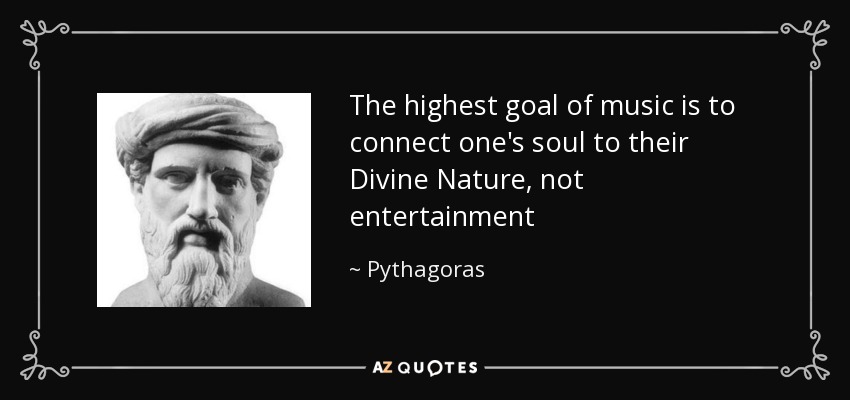
All this made Pythagoras the incarnation of a cosmic and universal harmony**. Moreover, he would have been the first to have used the word « cosmos » (perfection, order).
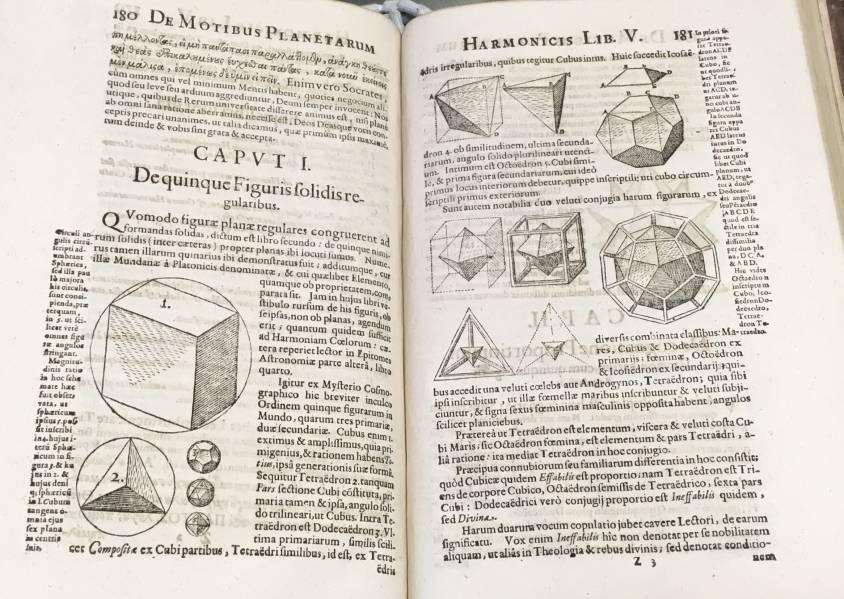
Pythagoras, praised by the first true astrophysicist Johannes Kepler (1571-1630), is said to have been the first to coin the concept of « the music of the spheres » or « the harmony of the spheres ».
For, as Sextus Empiricus (towards the end of the second century) states in his Pyrrhonian sketches, Pythagoras would have noted that the distances between the orbits of the Sun, the Moon and the fixed stars correspond to the proportions regulating the intervals of the octave, the fifth and the fourth. In the Republic, Plato states that astronomy and music are « sister sciences ».

Copernicus admits that the work of the Pythagoreans inspired his own research:
Others think that the Earth moves. Thus, Philolaos the Pythagorean says that the Earth moves around the Fire in an oblique circle, as do the Sun and the Moon. Heraclitus of Pontus and Ecphantos the Pythagorean do not, it is true, give the Earth a translational motion [motion around the Sun, heliocentrism]… Starting from this, I too began to think of the mobility of the Earth
(Copernicus, letter to Pope Paul III, preface to De revolutionibus orbium caestium [On the Revolutions of the Celestial Orbs], 1543).
The name Pythagoras (etymologically, Pyth-agoras: « he who was announced by the Pythia », the goddess), derives from the announcement of his birth made by the oracle to his father during a trip to Delphi. However, legend has it that Pythagoras was the son of Apollo, the god of light, poetry and music.
According to the oldest pre-Socratic traditions, Apollo had conceived a plan to control the universe. This plan was revealed in « the music of the spheres » under the wise supervision of Apollo, the sun god and god of music; a Greek god who passed to the Romans without changing his name. Apollo is represented with a crown of laurels and a lyre, surrounded by the nine muses.
GUIDED TOUR
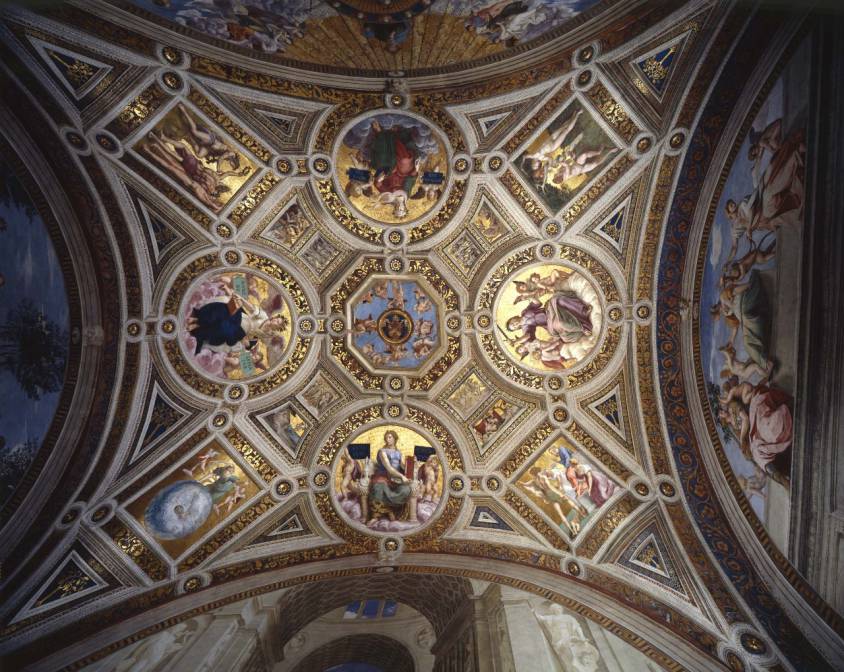
After reviewing the political situation of the time, the motivations of Pope Julius II and his advisors seeking to re-establish the authority of a « Triumphant Church, » the ultimate culmination for centuries to come of a culture that goes back to Apollo, Moses, Pythagoras, Plato, Cicero and their disciples, the viewer now has some solid « keys » (the « codes ») in hand that will allow him or her to « read » Raphael’s frescoes adorning the Stanza.
Without Raphael’s account of his work, this reading remains an obstacle course. For example, the identification of the figures remains uncertain, since, with a few rare exceptions, no tablet tells us this. The idea, in any case, is that the spectator, by analyzing the appearance and gestures of each one, discovers for himself who is represented.
As we said, when entering the room, the viewer is immediately asked to appreciate each fresco not in isolation, but as an expression of a coherent whole.
When entering the Stanza, as if inside a painted cube, one immediately realizes that one is facing a theatrical setting. For the great vaults that the spectator discovers are only painted images and do not respond to any structural reality of the building. Inghirami was a speaker, an actor and a director who knew who should appear where, with what attitude and dressed in what way. Thanks to this imagination, a room that was at first sight rectangular and boring, was transformed into a spherical cube because the corners of the room were « rounded » with stucco.
A. THE CEILING
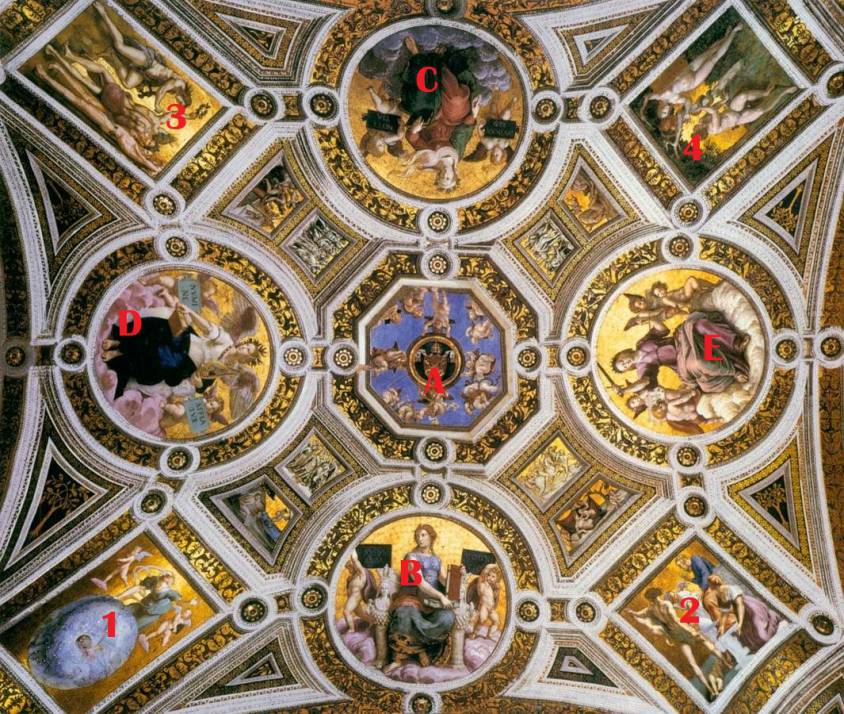
From the thematic point of view, the visual path, as one might expect, begins on the ceiling and ends on the floor. In the center of the ceiling, a small circle with the coat of arms of Julius II. Around it, an octagon surrounded by four circles connected by four rectangles. Each of the four circles touches the top of one of the four vaults painted on the four walls and shows an allegorical figure and a text announcing the theme of the large frescoes below.
Each time, it is a question of emphasizing the harmony uniting all the opposing (circle, square) parts. While the real incompatibilities are left to the checkroom, the oppositions and the formal differences will even be strongly emphasized, but exclusively to show that one can accommodate them by submitting them to a higher design.
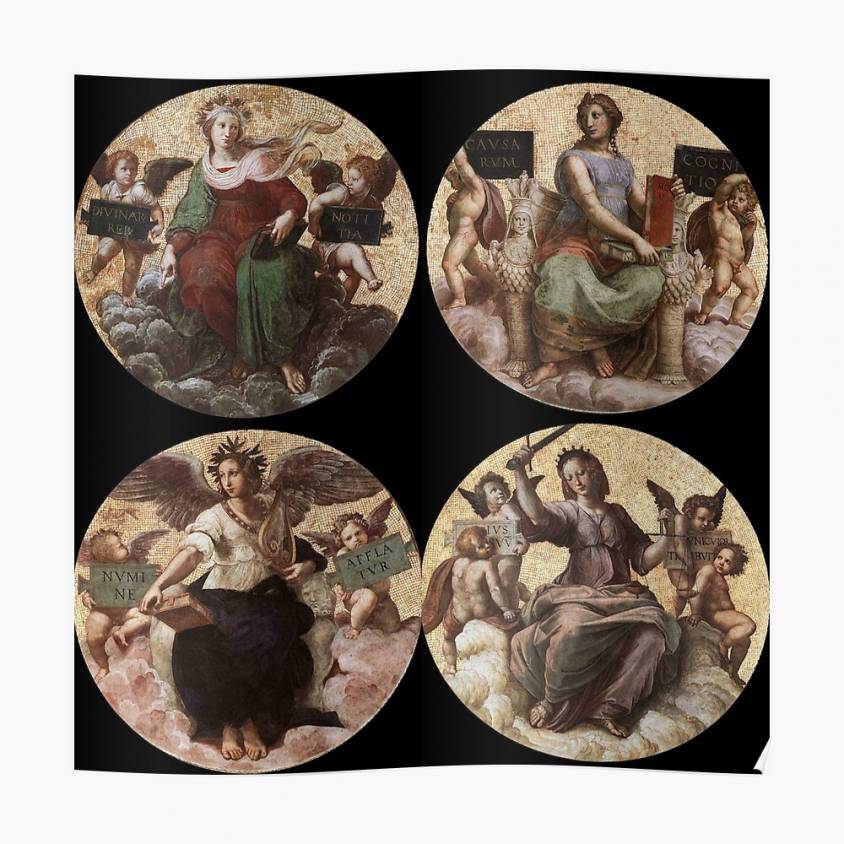
Thus two double themes (2 x 2) are articulated:
- Philosophy (the true accessible by reason), nicknamed The School of Athens, and Theology (the Truth accessible by divine revelation), nicknamed since the Council of Trent, the « Dispute of the Holy Sacrament »; a theme common to Aquinas and the neo-Platonists.
- Poetry and music (the Beautiful), and Justice (the Just), a theme of Ciceronian origin.
- Above the theme Philosophy, in one of the four circles, is represented by a woman wearing a dress with each of the four colors symbolizing the four elements evoked by a motif: blue illustrates the stars, red the tongues of fire, green the fish and golden brown the plants. Philosophy holds two books entitled « Morality » and « Nature », while two small genius (geniuses) carry tablets on which one can read « CAUSARUM » and « COGNITO », read together meaning « To know the causes ». Clearly, the aim of moral and natural philosophy is to know the causes, that is to say to go back to God.
- Above Theology, a woman dressed in red and green, colors of the theological virtues. In her left hand, she holds a book, her right hand points to the fresco below. Two geniuses carry tablets saying « DIVINAR.RER » and « NOTITIA », « The revelation of sacred things ».
- Above Poetry, the winged figure of the Poetry carrying lyre and crown of laurels. Two putti (cherubs) present us with tablets on which are inscribed the words of Virgil: « Inspired by the spirit » (NVMINE AFFLATVR). Since we are dealing with puttis and not geniuses, there is a clear reference to the Christian spirit that inspires the arts.
- Finally, above the last fresco, Justice, a woman holds the attributes of justice: the scales and the sword. Two putti carry tablets with the words of the Emperor Justinian: « IVS SVVM VNICUMQUE », that is, « to each his just punishment ».
Then, still on the ceiling, as we have indicated, there are four rectangular frescoes connecting the four circles whose theme we have just specified. Again, these are two pairs that complement each other.
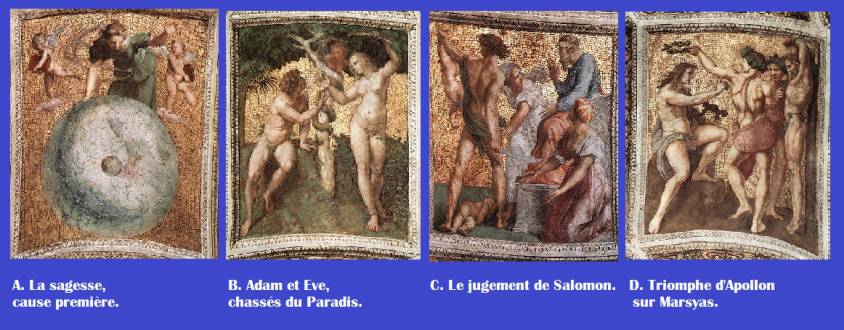
A. A first rectangular fresco, linking Philosophy with Poetry, shows us a woman (wisdom, the first mover) here as the first cause and setting a celestial globe in motion and thus the universe in action. It may be the mythical Sibyl mentioned by Heraclitus, a superhuman incarnation of the prophetic voice. Philosophically, it is an allegory of the creation of the universe (or Astronomy). The constellation that appears on the globe has been identified. It corresponds to the sky map of the night of October 31, 1503, the date of the election of Julius II… which of course the date he became the “prime mover” of the universe.
B. The second rectangle, diametrically opposed to the first one and linking Justice to Theology, represents « Adam and Eve driven out of Paradise ». Considered as the beginning of theology, « The Fall of Man », will be repaired by the « redemption » that the Church and Pope Julius II will bring, embodied by the creative wisdom putting the universe back into motion.
C. The third rectangle, linking Philosophy and Justice, represents « The Judgment of Solomon, » a scene showing King Solomon’s wise judgment when two mothers claimed the same child.
D. And finally, the fourth, at the other end of the diagonal, connecting Poetry and Theology, represents, not « The Flogging of Marsyas » as has been claimed, but another rather rare scene, « The Triumph of Apollo over Marsyas » in the struggle for the lyre. The latter receives a crown of laurels. The two judgments are based on different bases for their mutual appreciation. While King Solomon, representing the Old Testament, judges on the basis of the divine law, Apollo, who represents antiquity here, prevails thanks to the rules of the pagan pantheon, his will power.
B. THEOLOGY
(THE DISPUTE OF THE HOLY SACRAMENT)

*In the upper (celestial) register :
A. God the Father, B. Jesus Christ, C. Mary, D. St. John the Baptist, E. Apostle Peter, F. Adam, G. St. John the Evangelist, H. King David, I. St. Lawrence, J. Judas Maccabaeus, K. St. Stephen, L. St. Stephen, M. Moses, N. James the Greater, O. Abraham, P. St. Paul, SE. Holy Spirit.
*In the lower (earthly) register:
1. Fra Angelico, 2. ?, 3. Donato Bramente, 4. ?, 5. ?, 6. Pico della Mirandola, 7. ?, 8. ?, 9. ?, 10. Saint Gregory, 11. Saint Jerome, 12. ?, 13. ?, 14. ?, 15. ?, 16. Saint Ambrose, 17. Saint Augustine, 18. Saint Thomas of Aquinas, 19. pope Innocent III, 20. Saint Bonaventure, 21. pope Sixtus IV, 22. Dante Alighieri, 23. ?, 24. ?; 25. a mason, 26. ?, 27. ?
Historians tell us that it was the first fresco to be made. The core subject here is the Trinity and « transubstantiation », a supernatural phenomenon signifying the conversion of one substance into another, in the case of Christians, the conversion of bread and wine into the body and blood of Christ in the Eucharist under the action of the Holy Spirit. This meant a « real presence » of God at mass and thus a major attraction to attract the faithful and a precondition to obtain « indulgences » from him. For some humanists, such as the Swiss Protestant Ulrich Zwingli (1484-1531), any doctrine of the real presence is idolatry because it would be tantamount to worshiping bread and wine as if it were God.
Erasmus, for whom the performance of rituals should never be a substitute for true faith, explains that when Christ said to his disciples, in offering them bread, « this is my body » and « this is my blood, » in offering them wine, he was in reality talking metaphorically, not of bread and wine, but of his disciples (his body) and his teaching (his blood).
The idea of the composition is to show the triumph of the unity of the Church in Christ in all its complexities and diversities. The scene takes place on two levels, one celestial and the other terrestrial, lining up, as in a theater, a vast variety of actors presenting themselves to the public.
Above, in the celestial register, the heart of the subject, « the Trinity » with God the Father (A) blessing enthroned above a Christ (C) surrounded by Mary (B) (the New Testament) on his right and St. John the Baptist (D) (the Old Testament) on his left, themselves appearing above a dove symbolizing the Holy Spirit (SE).
Around them, to match the architecture of the School of Athens opposite, sit peacefully on a semi-circular cloud bench, the remarkable figures of the Church Triumphant, accompanied by their traditional attributes and dressed in colorful garments specific to each.
At the ends of the semicircle, two apostles: the Apostle Peter (E), representing the Jews, and the Apostle Paul (P), representing the Gentiles, face each other, as if they were the outer guards of the triumphant Church, the custodians of both the key and the letter of it. The Old Testament is represented by Adam (F) facing Abraham (O), and Moses (M) facing King David (H) with his harp in hand. The New Testament is also represented by St. John (G) facing St. Matthew (N) (two authors of the Gospel), by St. Lawrence (I) and St. Stephen (L) (both martyred saints).
At the bottom, in the terrestrial register, there is an enormous altar (Y) on which is written (in the middle) « IV LI VS » (Julius). A golden monstrance (X) with a host in its center proclaims the presence of Christ in the mystery of transubstantiation. Next to it, the Doctors of the Church of the early days of Christianity: on the left (under the features of Julius II) St. Gregory (No. 10), the great reformer of the ritual and the chant of the Mass, next to St. Jerome (No. 11), the most profound scholar of Christianity), accompanied by his lion. On his right Saint Augustine (N° 17) and Saint Ambrose (N° 16). These four doctors are, unlike the other figures, seated, which already brings them closer to the figures in the heavens; we can also distinguish two later doctors who are St. Thomas Aquinas (No. 18), a Dominican; and St. Bonaventure (No. 20), a Franciscan.
The historian Konrad Oberhuber, adds that these last two,
embody two tendencies of the Church: one that sees its essence of Christianity in ritual and devout adoration (the dimension of feeling), the other that defends the importance of theology (the dimension of thought).
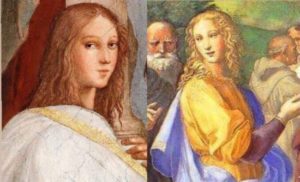
Then, Popes Innocent III (1160-1216) (N° 19), the most powerful pope of the Middle Ages who established the political independence of Rome) and Sixtus IV (1414-1471) (N° 21, Francesco della Rovere by name) rub shoulders with religious figures such as the Dominican Savonarola (instigator in 1494 in Florence of a political revolution (return to the Republic) and moral revolution (rechristianization) or, the painter Fra Angelico (N° 1), contemporary of Savonarola, admired for his frescoes and his sublime paintings, accompanied by Dante Alighieri (N° 20), whose Divine Comedy (with hell, purgatory and paradise) had an influence on theology in the Middle Ages, Donato Bramante (N° 3), the famous architect of St. Peter’s Basilica, not forgetting Pico della Mirandola (N° 6), (mistaken for Francesco Maria della Rovere) who, with his hair blowing in the wind, is pointing towards the Trinity in a light and graceful wiggle. On the right, masons (N° 22), who build churches, bend forward. If on the right, behind the figures, the white marble foundations (Z), allude to the new St. Peter’s Basilica whose reconstruction Julius II has just launched, on the left, a village church (Q) reminds us that Christianity must penetrate the daily life of the humble.
C. PHILOSOPHY
(“SCHOOL OF ATHENS”)

A. Apollo, B. Pallas Athena
Philosophy (« School of Athens »).
1. Porphyry, 2. Plotinus, 3. Alcibiades, 4. Crito, 5. Phaedo of Elis, 6. Socrates, 7. Isocrates, 8. Parmenides,
9. Plato, 10. Aristotle, 11. ?; 12. ?, 13. Apelles of Cos (Raphael), 14. Protogenes (Sodoma), 15. Strabo,
16. Ptolemy, 17. Hippocrates of Chios, 18. Diogenes of Sinope, 19. Heraclitus of Ephesus, 20. Anaximander of Milèt, 21. Pico della Mirandola, 22. Pythagoras, 23. Boethius, 24. Avicenna, 25. Epicurus, 26. Metrodorus.
A beautiful central view perspective shows a get together of 58 Greek and other thinkers in an ideal temple. No chiaroscuro effect disturbs the balance of the colors and the clarity of the composition.
The American thinker Lyndon LaRouche (1922-2019), during his visit to the Vatican, marveled at the graceful harmony that radiates from this work. It could not help but resonate with a concept LaRouche developed throughout his life: that of the « simultaneity of eternity »; the poetic idea that « immortal » ideas continue their dialogue in a place beyond material time and space.
According to historians, Raphael, faced with the Herculean task of creating this series of portraits, and lacking reliable visual data about the figures to be portrayed, sent one of his assistants to Greece to collect indications and provide him with documentation to meet the challenge.
Small detail: the event doesn’t take place in Athens or Greece, but in Rome. The architecture is clearly inspired by the church of Sant’Andrea of Mantua, renovated shortly before his death by Leon Battista Alberti (1404-1472) and by Bramante‘s plans for the reconstruction of St. Peter’s Basilica in Rome. It is Rome set to become the new Athens.

Although the steps can be found in the preparatory drawings, the large arches with their coffered vaults, typical of the dome of the Roman Pantheon, do not appear. Another probable source of inspiration is the arches, also with coffered vaults, the Basilica of Maxentius and Constantine, built in Rome at the beginning of the 4th century to reaffirm the power of the beauty of the Eternal City.
It is not excluded that Bramante himself, who had made a tromp-l’oeil using this type of pattern in the apse of the church of Santa Maria presso San Satiro in Milan, designed them in person. With three arches (tetrad) and seven rows of caissons, Pythagorean numerology is never far away.
Visually, the ensemble is divided in two. The audience is on the same level as the foreground, a paved parterre behind which a very wide staircase leads to a raised forecourt. For the viewer, a slightly cavalier perspective reinforces the monumental dimension of the figures on the upper level. This setting is inevitably reminiscent of a theater stage.
The actors, arriving from the old world, can enter the stage on one side, under the statue of the Greek god Apollo (A), god of light, and leave on the other, towards the new world, under the statue of Pallas Athena (B), which became Minerva in Roman times, protector of the Arts, to exchange ideas with each other, address the audience or climb the stairs and leave through the back.
In the center of the square and in the center of a perspective with a central point of view, Plato (N° 9) and Aristotle (N° 10) don’t confront each other but move forward, side by side, towards the viewers (and the Triumphant Church on the opposing wall).
The first one, with the Timaeus in his hand, points a finger towards the sky, meaning that beyond the visible, a higher principle exists. The second one extends his arm and his hand horizontally underlining that all truth comes to us from the testimony of the senses, while carrying the Ethics with the other arm.
Strangely, these are the only two books in the stanza whose names appear in Italian (Timeo, Etica) and not in Latin. As the art critic Eugenio Battisti (1924-1989) observed:
If we (…) examine the titles of the works respectively held by Plato and Aristotle, we see the philosopher of the Academy holding the Timaeus, that is to say the most Aristotelian and the most systematic of his works and the Stagirite, the Nicomachean Ethics, that is to say the most Platonic of his works.
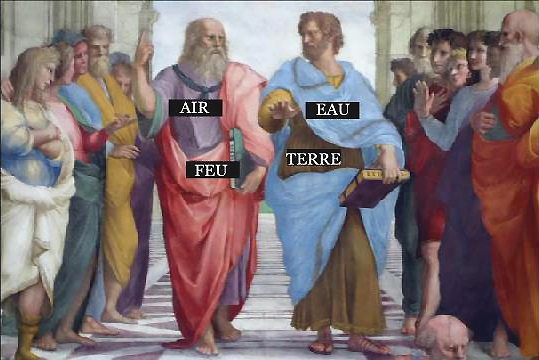
The colors of the clothes of the two philosophers symbolize the four elements: Plato is dressed in red (fire) and purple (ether); Aristotle in blue (water) and yellow (earth).
If the whole fresco cuts the world in two between Platonists and Aristotelians, both walk together towards what is in front of them and behind the spectator who looks: towards the fresco of Theology with the Trinity in the center without forgetting the monstrance and the imposing altar on which is marked « JV-LI-VS PON TI CUS ». How generous of the Church to welcome so many pagans into its midst!

Raphael however communicates a great sense of movement. In the same way that the Dutch painter Rembrandt, in his 17th century masterpiece The Company of Captain Frans Banning Cocq, known as The Night Watch, broke with the formal representations of the dignitaries of the city guilds, Raphael here drew a line under the frozen and static representations of the series of « great men » often decorating the palaces and libraries of the great princes and lords in the style of his master Perugino.
His fresco, like Leonardo’s Last Supper in Milan, is organized as a sequence of small groups of three or four people conversing with a great thinker or each other, never out of sync with what is happening around them. In this sense, Raphael translated into images, and thus made accessible to the eyes of the spectators, that harmonic unity transcending the multiple so sought after by the commissioners.
Raphael and Inghirami did not hesitate to use portraits of people living in their time to represent historical figures. In addition to themselves, there are their patrons, colleagues and other personalities whom they hoped to please or charm.
In the foreground, four groups are shown.

On the left, Epicurus (N° 25), here with the features of Inghirami writing the setting of the play. Born in Samos like Pythagoras, he wears here, not a crown of laurels, reward given to great orators, but a crown of oak leaves, symbols that we find in the coat of arms of pope Julius II.
Some historians believe that Inghirami was a Dionysian follower of Orphism, another pre-Socratic current. Dionysus is indeed the brother of Apollo and according to some, their teachings are one and the same.
As mentioned above, shortly after Raphael’s death (1520), Cardinal Jacopo Sadoleto published a treatise in which Inghirami defends rhetoric and denies any value of philosophy, his main argument being that everything written is already in the mystical and mythological texts of Orpheus and his followers.
In Rome, the scholars of the time knew Epicurus mainly through their readings of Cicero for whom Epicurus was not a debauchee but someone who sought the noblest pleasure. Cicero had a friendship with an Epicurean philosopher, a certain Phaedrus, as it happens the nickname of Inghirami…
Finally, on the extreme left, there is an old bearded man, the Greek thinker Metrodorus (N° 26), disciple of Anaxagoras and for whom it is « the acting spirit » that organized the World. In front of him, a newborn baby. Together they could symbolize the birth of truth (the child) and wisdom (the old man) and experience.
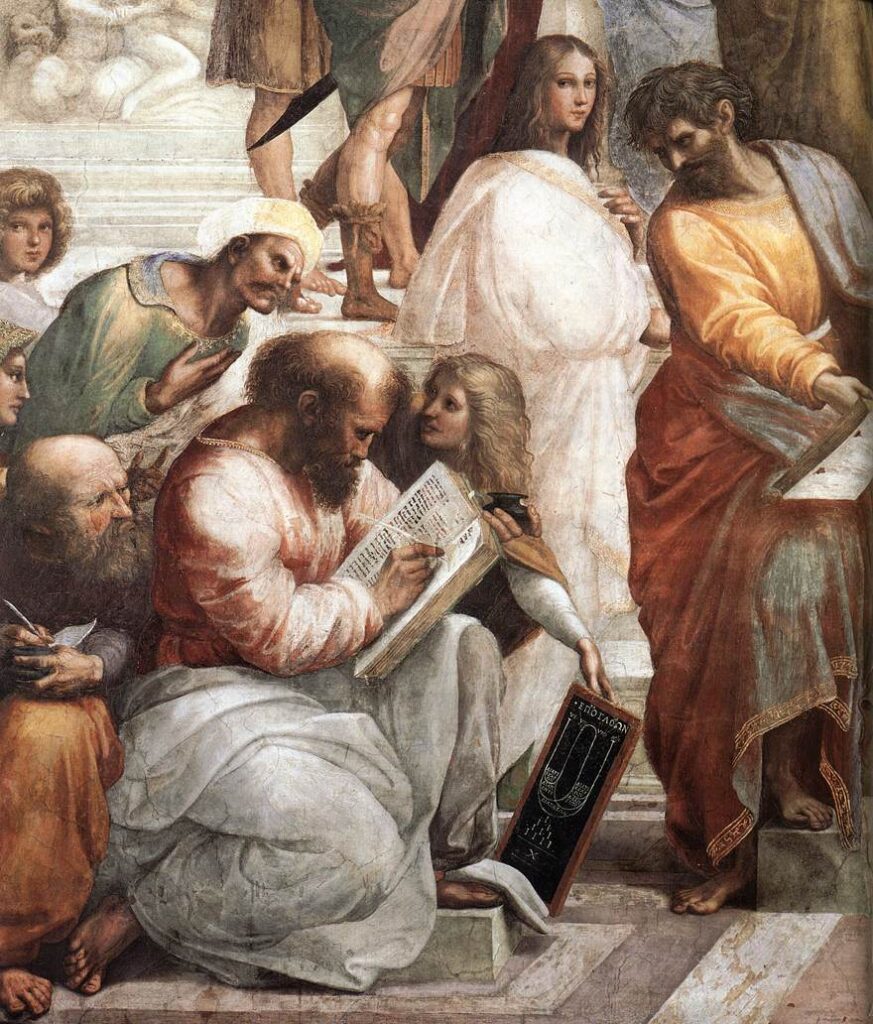
Next to him, a little more in the center, the imposing figure of Pythagoras (N° 22) (whom the Italian historian Georgio Vasari mistook for the evangelist Saint Matthew), seated with a book, an inkwell and a pencil, writing surrounded by visibly intrigued people. Behind him, seated on the left, an old man, representing Boethius (N° 23), Roman author, in the sixth century, of a treatise on music, the first part of which evokes « the harmony of the spheres », tries to look at what he is writing in his book. Without capturing a moment of potential transformation, as Leonardo knew how to do, the scene is obviously inspired by his unfinished painting, the Adoration of the Magi.
At his feet, a black slate with the famous Tetraktys and a diagram of musical intervals (see our section in this article on Pythagoras).
Since it is totally unthinkable that it is Averroes (banned from the Church, as said, by Aquinas), the turbaned man who seems to admire him could be Avicenna (Ibn Sina) (N° 24). This Persian physician, influenced by the thought of both Hippocrates and Galen, in his Qanûn (of Medecine), operates a vast medico-philosophical synthesis of Aristotle‘s logic (which he corrects) and neo-Platonism, compatible with monotheism.
It could also be Al Fârâbi (872-950), another Arab scientist and musician who sought to reconcile faith, reason and science with the philosophy of Plato and Aristotle, whose translations from Greek into Arabic he had made. Avicenna admired him and the title of one of Al Fârâbî’s works leaves no ambiguity: The Harmony of the Opinions of the Two Sages: Plato the Divine and Aristotle.
Moreover, given his position on the side of the Platonists, although he wears a white turban, it is totally excluded that he is Averroes (Ibn Rushd), an author struck down by Aquinas (see the paintings showing The Triumph of Saint Thomas) and then by the Neoplatonists of Florence for having denied the immortality of the individual soul.
More in the center of the fresco, two isolated figures immersed in their thoughts. The first, on the left, appears to have been added later by Raphael and is not in his drawing. The man is dozing on a cube, a Pythagorean volume par excellence. It is thought to be Heraclitus of Ephesus (No. 19) (an Ionian pre-Socratic for whom « there is nothing permanent but change ») with the features of Michelangelo. This sculptor fascinated Raphael, not only for his gifts in drawing, anatomy and architecture, but also for his spirit of independence from a pope he considered tyrannical.
It should be noted that the Moses that Michelangelo sculpted for the tomb of Julius II is said to be looking at him with anger because the artist captured the moment when Moses, coming down from Mount Sinai with the Tables of the Law, noticed that the Hebrew people had returned to worshiping idols, such as « the Golden Calf ». Irritated by this return to idolatry, Moses broke the Tables of the Law.
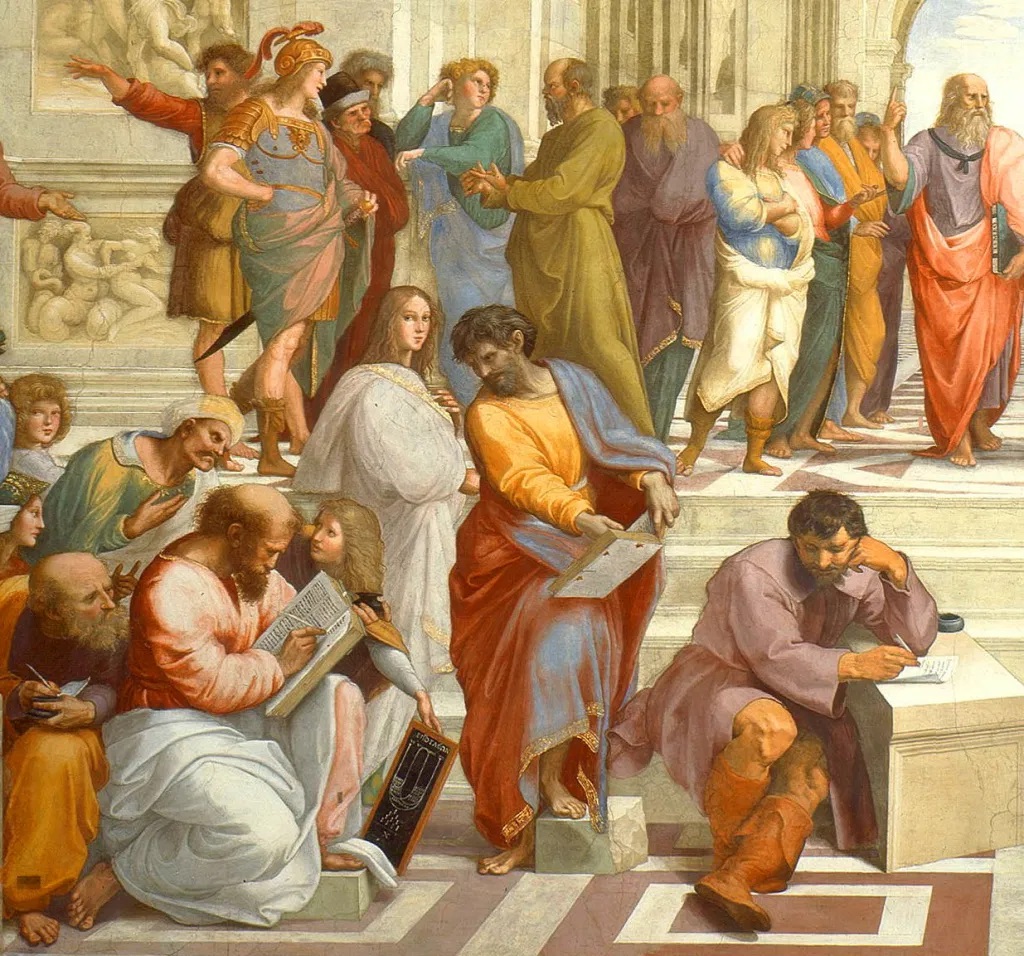
One detail raises questions: Anaximander of Miletus places his right foot on a cubic block of marble whose volume seems to be eight times smaller than the one on which Heraclitus of Ephesus rests. However, to solve the problem of Delos (the duplication of the volume of the cube) it is necessary to wait for the Pythagorean and friend of Plato, Archytas of Taranto.
Anaximander of Miletus (N° 20) (and not Parmenides), also a representative of the Ionian school, stands behind Heraclitus and seems to contest the demonstration of Pythagoras (representative of the so-called « Italian » school). Behind him, a young man with long hair, looks at the spectator. Dressed in a white toga, an attribute of the Pythagoreans, he is once again Pico della Mirandola (N° 21), triumphant and surrounded by Pythagoras and two of his disciples. Legend has it that Raphael portrayed Hypatia of Alexandria (c. 370-415), a mathematician who headed the Neoplatonist school in Alexandria. When one of the cardinals examined the painting and knew that the woman depicted was Hypatia, he is said to have ordered that she be removed from it. Raphael is said to have obeyed, but replaced her with the effeminate figure of a nephew of Pope Julius II, Francesco Maria Della Rovere, future Duke of Urbino…
If this is really Pico della Mirandola, it would be a superb piece of praise, for appearing in both Philosophy and Theology, the two images of Pico, reminiscent of the kneeling angel looking at the viewer while pointing at St. John the Baptist in Leonardo’s Madonna of the Rocks, can contemplate each other!
The second isolated figure, nonchalantly spread out on the stairs, is the cynical and hedonistic philosopher Diogenes of Sinope (N° 18), here presented as an ascetic, but in the Aristotelian tradition.

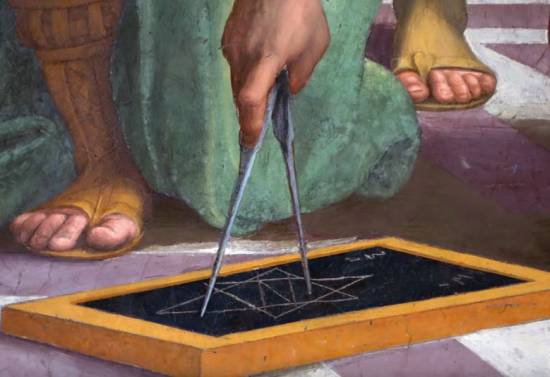
Then, in the center right, an inspiring group of young people, amazed by their discoveries and exchanging their complicit glances with their comrades, around a surveyor who is examining or drawing with a compass parallel lines inside a hexagonal star on a slate laid on the ground.
This is an illustration of a theorem that neither Euclid (an Aristotelian) nor Archimedes mentioned, although the identity of one or the other is attributed to this figure in the guise of the architect Donato Bramante.
It could be, it is my conviction, the geometer Hippocrates of Chios (N° 17) of which Aristotle speaks in great good. He wrote the first mathematics textbook, entitled The Elements of Geometry. This work precedes Euclid’s Elements by a century. Unless we are talking about the architect Leon Battista Alberti, whose church in Mantua may have inspired Bramante and after all, author, in 1435, of De Pictura, a treatise (of Aristotelian spirit) on perspective.
However, in 1485, in his treatise on architecture De re Aedificatoria, Alberti, in a passage (IX, 5) that may have been of interest to the author of the fresco, stressed that:
“Beauty consists in a harmony and in an agreement of the parts with the whole, in accordance with determinations of number, proportionality and order such as the harmony requires it, that is to say the absolute and sovereign law of the nature.”

Finally, to add to the mystery, on the collar of the tunic of this figure can be read: « R.V.S.M. » (Raphael Vrbinas Sua Manu), meaning « By the Hand of Raphael of Urbino »).
For what the surveyor is addressing on the slate is the role played by the diagonals of the hexagon. The answer is provided by the geometrical composition, in the form of a hexagon, which underlies the entire construction of the perspective of the fresco.
The diagonals show a beautiful complementarity between the arithmetic mean and the harmonic mean (see authors diagram below).
It is a masterly demonstration in the field of the visible, of the concept structuring the whole theme of the work: complementarity, the foundation of universal harmony.
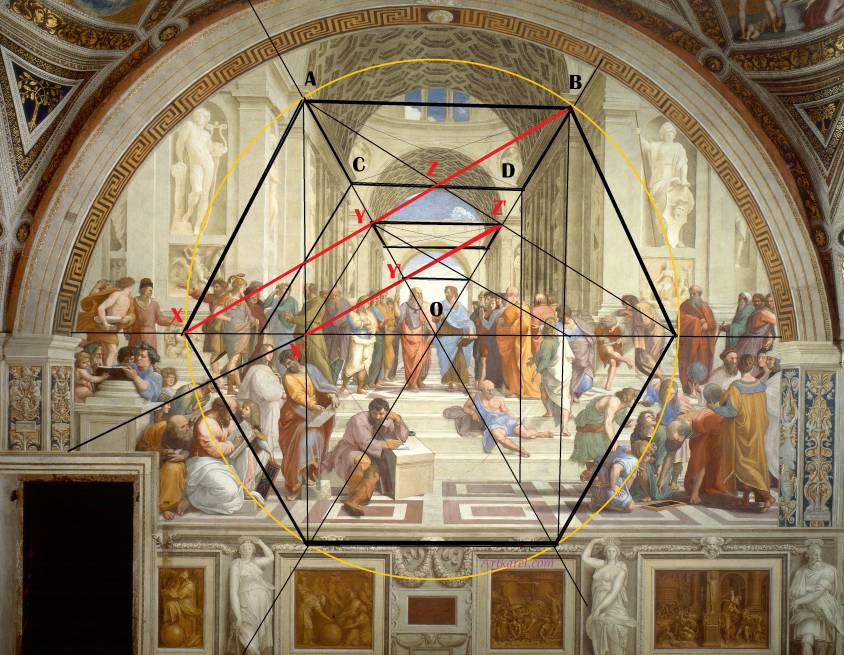
Credit: Karel Vereycken
On the right, the geographers Ptolemy (No. 16) and Strabo (No. 15) (in the guise of Baldassare Castiglione, the head of the Pope’s army and a friend of Raphael’s?), who is identified without real evidence with Zoroaster but to whom Pico della Mirandola indeed refers, stand face to face. The first shows the Earth as a sphere, the second a globe of the Heavens.
Finally, on the far right of the first register, with the features of Raphael, the legendary painter of the court of Alexander the Great, Apelles of Cos (N° 13). It should be remembered that, during his lifetime, Raphael was nicknamed « the Apelles of his time ». Next to him, his rival, the Greek painter Protogenes (N° 14) in the guise of Raphael’s colleague, the sulfurous but virtuoso fresco artist Sodoma. Coming from the world of the craftsmen, it is a question here of marking the entry of two painters-decorators into « the court of the big guys » and making their first steps in the world of philosophy.

On the steps, the central subject, as we have said, Plato and Aristotle. Plato‘s features in the fresco have nothing to do with any supposed portrait by Leonardo da Vinci. Leonardo was born in 1452 and was only 56 years old when the fresco was painted. Raphael is said to have used the image of a bust of Plato discovered in Athens in the ruins of the ancient academy. In reality, the famous drawing of an old man (Turin), supposed to be a self-portrait of Leonardo and resembling the image of Plato in the School of Athens, has been proven to date from the 19th Century.
In the crowd to the left of Plato is Socrates (no. 6), his teacher, whose face was known to everyone from Roman statues. The identification of the other figures remains largely hypothetical. One thinks of the speakers of Plato‘s dialogues. Close to Socrates, his old friend Crito (N° 4). Behind Socrates, the Athenian intellectual Isocrates (N° 7) who had withdrawn from political life and although close to Socrates, set himself up as Plato‘s rival. Close to the latter, the five interlocutors of Plato‘s dialogue, Parmenides. Among them, Parmenides (N° 8), considered at the origin of the concept of the One and the multiple, and the pre-Socratic thinker Zeno of Elaea, known for his philosophical paradoxes.
The Athenian general (here dressed as a Roman soldier) Alcibiades (N° 3) and the young man in blue could be Phaedo of Elis (N° 5) or Xenophon, both listening to Socrates counting on his fingers, a gesture suggesting his famous dialectic.
All around the Greek thinkers, other figures are stirring. Behind general Alcibiades, a figure (perhaps a librarian) holds back another running figure, begging him not to disturb the ongoing exchanges between philosophers and scientists.
At the far left, a man with a hat enters the stage. It could be Plotinus (N° 2), a founding figure of Neoplatonism admired by cardinal Bessarion, accompanied by Porphyry (N° 1), another Neoplatonist who brought his biography of Pythagoras as a messenger from the ancient world.

Here the giornata of the School of Athens.
D. JUSTICE
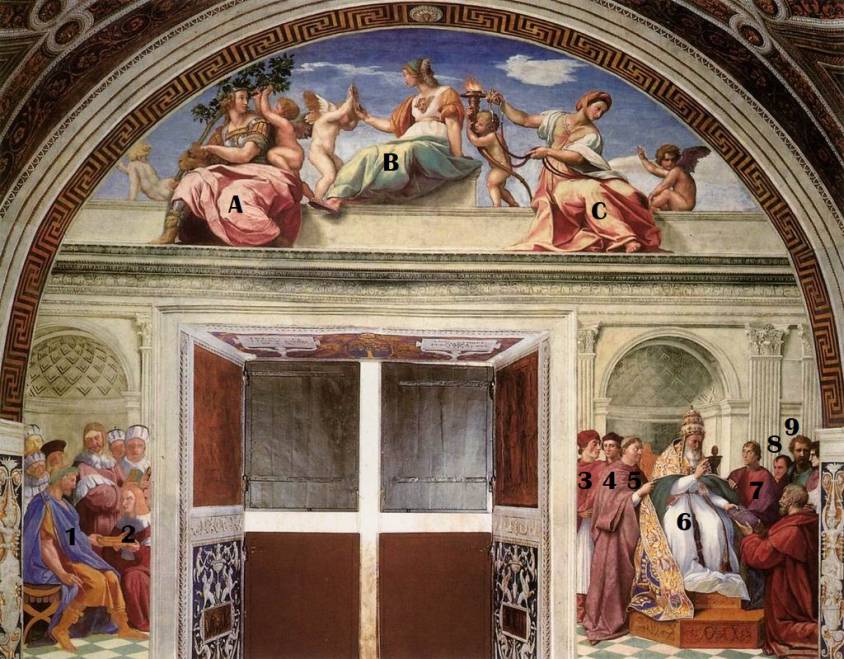
A. Fortitude, B. Prudence and C. Temperance.
1. Justinian, 2. Tribonian, 3. pope Paul III, 4. Antonio Del Monte,
5. pope Leo X, 6. pope Gregory IX (Julius II), 7. pope Clement VII.
On top, in the lunette (half moon), the three virtues represented would be Fortitude (A), Prudence (B) and Temperance (C). Together with Justice, they constitute the four cardinal (profane) virtues. The central female figure, holding a mirror, refers to Prudence. On the left, Fortitude holds an oak branch, an allusion to the della Rovere family from which Julius II, the pope who commissioned the frescoes, descended.
Below, once again, complementarity is at work. On the left, painted by Lorenzo Lotto, the Roman emperor Justinian I (N° 1) receives the Pandects (the civil law) from the Byzantine jurist Tribonian (N° 2).
On the right, in the guise of Julius II, Pope Gregory IX (N° 6) promulgates the Decretals; a masterly sum of canon law which he had ordered to be compiled and published in 1234.
On his right (thus on the left of the spectator), one sees a cardinal, in purple dress, having the features of the cardinal Jean de Médicis, future pope Leo X (N° 5). The two other cardinals behind him would be Alessandro Farnese, the future pope Paul III (N° 3), and Antonio Del Monte (N° 4). And to his left (right for the viewer) a cardinal representing Cardinal Julius de Medici, the future Pope Clement VII (N° 7). With your image immortalized on a fresco in the right place, your career to become pope would seem to be better engaged!
The fact that Julius II is represented wearing a beard allows to date the fresco beyond June 1511. Indeed, the pontiff, who left Rome beardless to wage war, then let his beard grow and vowed not to shave it off until he had liberated Italy. He returned to Rome in June. Historians point out that the prominence of the pope’s portrait indicates how the theme of the decoration of the Chambers was transformed, around 1511, into that of the glorification of the papacy. Hence, in this way “Justice” becomes the right of Julius II to impose « his » justice.
E. POETRY
(« PARNASSUS”)
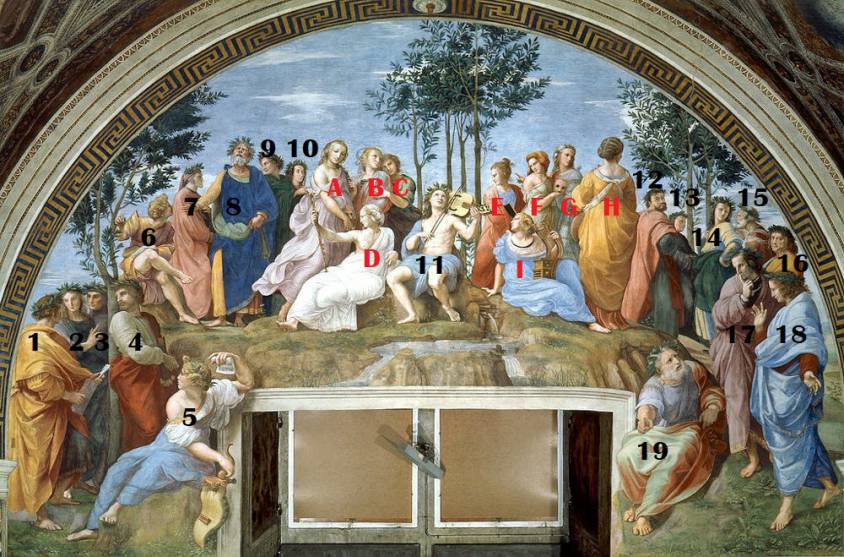
The poets:
1. Alcaeus of Mytilene, 2. Corinna, 3. Petrarch, 4. Anacreon, 5. Sappho, 6. Ennius, 7. Dante, 8. Homer, 9. Virgil, 10. Statius (Poliziano), 11. Apollo, 12. Tebaldeo, 13. Boccaccio, 14. Tibullus, 15. Ariosto,
16. Propertius, 17. Ovid, 18. Sannazaro, 19. Pindar.
The nine muses:
A. Thalia, B. Clio, C. Euterpe, D. Calliope, E. Polyhymnia, F. Melpomene, G. Terpsichore, H. Urania. I. Erato.
A window reduces the space available for the fresco to a large lunette where the characters are divided into small groups on a semi-circular line.
The underlying idea here, taken from St. Thomas, is that truth is made accessible to man, either by Revelation (Theology) or by Reason (Philosophy). For the Neoplatonic school, this truth manifests itself to our senses through Beauty (poetry and music).
The scene painted here takes place near Delphi, at the top of Parnassus, the sacred mountain of Apollo and home of the Muses of Greek mythology.
The large window around which the fresco is organized offers a view, beyond the cortile (small circular temple) of Bramante, on the hill of Belvedere (Mons Vaticanus), where shows were given and where, in ancient times, Apollo was honored, which earned him the name of Apolinis.
Apollo is the patron of musicians: « It is through the Muses and the archer Apollo that there are singers and citharists », says Hesiod. He even inspires nature: when he passes by, « the nightingales, swallows and cicadas sing ». His music soothes the wild animals and moves the stones. For the Greeks, music and dance are not only entertainments: they allow to heal men by tuning the discords that eat away at their souls and thus to bear the misery of their condition.
At the top of the hill, seven laurels. Near the Castalia spring, Apollo (N° 11), crowned with laurel leaves and in the center of the composition, is tuning around him the nine muses (A to I) playing on his lyre.
On the left side Calliope (D), the one « who has a beautiful voice » and represents the epic poetry, and on the right, Erato (I), « the lovable one » who represents the lyric and erotic poetry as well as the nuptial song. Each presides over the tuning of the other’s chorus: on the left, behind Calliope, Thalia (A) (« the flourishing, the abundant »), Clio (B) (« who is famous » and represents history) and Euterpe (C) (« the joyful » who represents music). Finally, just behind Erato, Polyhymnia (E) (« the one who says many hymns » and represents rhetoric, eloquence and pantomime), Melpomene (F) (« the singer » who represents tragedy and song); Terpsichore (G) (« the charming dancer ») and Urania (H) (« the celestial one » who represents astronomy).
And you don’t have to be Pythagoras to count 7 laurels on the mountain and remember that nine muses plus Apollo make… ten.
As one of the square frescoes on the ceiling reminds us, Apollo had triumphed over Marsyas in a fight to seize the lyre, considered as the divine instrument capable of leading souls to heaven, better than the flute which only excites the lower passions. By detaching the man from his immediate material concerns, the victorious lyre allowed to arouse the divine love in men. In addition, the Romans knew of a seven-stringed lyre, a Pythagorean legacy, the number seven referring to the seven heavenly bodies orbiting the central fire.

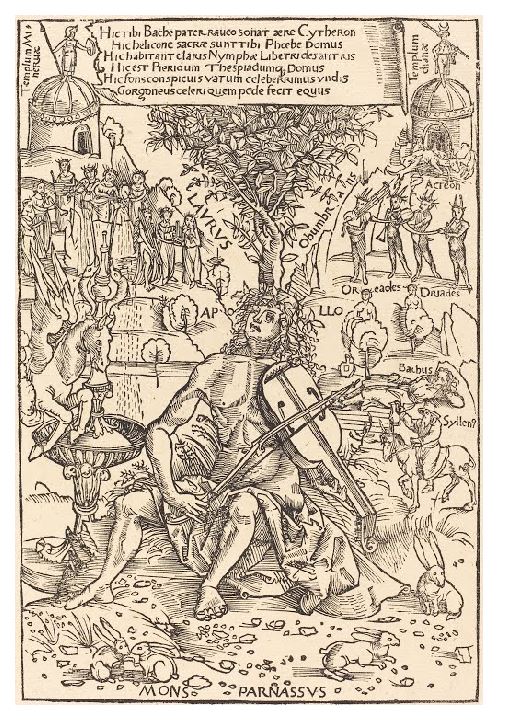
However, strangely enough, Apollo is not holding a traditional four-stringed lyre, but a lira da braccio. If Apollo plays here the lyre with arms, the muses Calliope, Erato and the sibyl Sappho hold lyres identical to those of the sarcophagus known as « of the Muses » of the Museo delle Terme in Rome.
In many representations of the 16th century, the lyre is played by a group of angels or mythological characters, such as Orpheus and Apollo, but also King David, Homer or the Muses. Among its interpreters, we can count Leonardo da Vinci. The instrument is essentially designed like a violin, but with a wider fingerboard and a flat bridge that allows for chordal playing. The lyre generally has seven strings: four like a violin, augmented by an additional low string (making five), and two strings beyond the fingerboard, which are not played but serve as a drone and resonate in the octave. Now, Raphael, in order to create a perfect harmony with the number of muses around Apollo, will increase the number of strings from seven to nine, that is to say seven adjustable plus two drones. This detail concerning the lyre seems to have been modified in time. Indeed, an engraved reproduction, from 1517, probably from drawings prior to the fresco, or from its preliminary project, by Marcantonio Raimondi, reveals a state quite different from what we see today.

The composition is less dense and highlights, like the School of Athens, several groups of three figures each. What is striking at first is that the ancient lyre played by Apollo with his fingers rests on his thigh, while in the present version, Apollo vibrates the strings of his lira da braccio with a bow, while looking up to the sky, in accordance with the fresco on the ceiling where are inscribed the words of Virgil: « Inspired by the spirit » (NVMINE AFFLATVR).
All around, eighteen poets are divided into several groups. The identification of some is unequivocal, that of others more doubtful. They are all chained to each other by gestures and looks, forming a kind of continuous crescent.
At the top left, the father of Latin poetry Ennius (N° 6), seated, listens raptly to the song of Homer (N° 8), while Dante (N° 7), further back, looks at Virgil (N° 9) who turns towards him, the Roman poet Statius (N° 10), in the guise of Poliziano, at his side. The latter was a disciple of the florentine Neoplatonist Marsilio Ficino. To represent the historical figures, Raphael drew inspiration from Roman statuary. For the face of Homer, for example, he adopted the dramatic expression of the Laocoon, which he had found in Rome in 1506.
At the bottom left are the Greek poet Alcaeus of Mytilene (N°1), the Greek poetess Corinna (N° 2), Petrarch (N° 3) as well as the Greek poet Anacréon (N° 4). In the final version, two characters who leave the frame came to enrich the composition. On the left, the sibyl Sappho (N° 5) as indicated by a tablet. Considered the first poetess of ancient Greece, she lived in the seventh and sixth centuries BC. According to the Homeric Hymns, it is her who would have built the first lyre to accompany the poetic recitation. The only woman in entire fresco is painted with a monumentality that is reminiscent of Michelangelo in the Sistine Chapel.
Sappho is the counterpart of Pindar (N° 19), and not Horace as is claimed, considered one of the greatest lyric poets of Greece and for whom Apollo was the symbol of civilization. Pindar is here in conversation with the Italian poet Jacopo Sannazaro (N° 18), dressed in blue and standing, and above them Ovid (N° 17).
On the right, on the side of the mount, besides Pindar, Sannazaro and Ovid, five other poets and orators : Antonio Tebaldeo (N° 12), with his back turned towards Apollo and under the features of Baldassare Castiglione ? ), Boccaccio (N° 13), behind, Tibullus (N° 14), Ariosto (N° 15), Propertius (N° 16), under the features of the cardinal poet very « Petrarquist » Pietro Bembo, a friend of Inghirami and enemy of Erasmus, and at his sides two unknown poets said « poets of the future judging the past ».
The identification of these characters remains largely hypothetical and controversial. To arrive at satisfactory results, it would be necessary according to the historian Albert Chastel, to find precise correspondences between the nine muses, nine classic poets and nine modern, in addition to the grouping by poetic genre.
After the death of Julius II, Pope Leo X made the Stanza della signatura his music room, replacing the books of his predecessor (which were moved to the large library on the lower floor) with intarsiae. Leo X will also have the pavement completed.
F. THE MOSAIC ON THE FLOOR
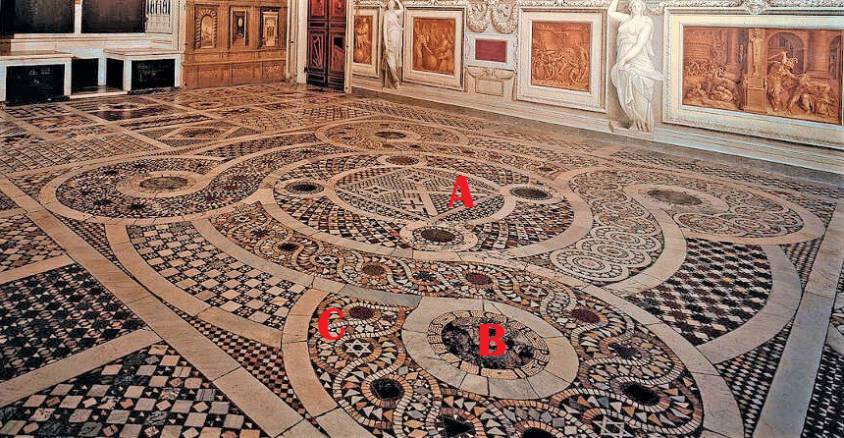
A. Coat of arms of the pope, B. Spiral arm, C. Star of David, reference to the Jewish heritage.

The mosaic decorating the floor is said to be « cosmatesque », after the name of Cosmati, an old family of craftsmen and specialized in mosaics with four colors. Some materials come from Roman ruins, the green marble of the Peloponnese in Greece, the porphyry of Aswan in Egypt, and the yellow marble of North Africa. The white marble comes from the famous marble quarries of Carrara where Michelangelo chose his materials.
As on the ceiling, in the center of the room the coat of arms of the pope (A), this time inside a square (his earthly reign) inscribed in a circle (his theological mission). This first circle is surrounded by four spiral arms, each of which creates a new circular motif (B). This pattern is believed to be of Jewish origin. The Star of David (C) appears several times in this creation vortex. The doctrine of the four worlds, described in cabalistic cosmology, underlines their dynamic unity.
After all, for Giles de Viterbe, the recent discovery of Jewish mystical writings was of the same importance as the discovery of America by Christopher Columbus. Let us recall that for Julius II, like Plato and Pythagoras, Moses, whom Michelangelo sculpted for his tomb, already announced the later triumph of the Church of Rome which would, under his direction, synthesize them.
Conclusion
Thus, the whole theme of the « Chamber of the Signature » finds its full coherence with the idea of harmony and concordance. But when we look more closely, we see that it is only a question of « complementarity » at the level of forms and in the service of a temporal power disguised as a divine mission. Raphael, a talented painter, submitted to this by providing the product for which he was paid. He would end up painting things increasingly decadent by submitting to the pagan whims of the papal banker Agostino Chigi for the decoration of his villa, the Farnesina.
With the « Chamber of the Signature », we are far from the famous « coincidence of opposites » dear to Pythagoras, Plato, Nicholas of Cues and today Schiller Institute’s President Helga Zepp-LaRouche, which allows, in an uncompromising search for truth and for the love of humanity, to overcome paradoxes and solve a great number of problems from a higher point of view.
By piling up allegories and symbols, if it impresses, this masterly work ends up suffocating us. By the rules of its composition, it can only sink into the theatrical and the didactic. In a universe purged of the slightest irony or surprise, no real metaphor will be able to awaken us. And although Raphael tried to bring some life into it, the spectator is fatally left with a vast sediment of fossilized ideas, as dead as the most glorious ruins of the Roman Empire.
Brief bibliography:
- Julius II, Ivan Cloulas, Fayard, Paris 1990;
- Léon X et son siècle, Gonzague Truc, Grasset, Paris, 1941;
- Une histoire des empires maritimes, Cyrille P. Coutensais, CNRS, 2013;
- L’Humanisme, l’Europe de la Renaissance, André Chastel and Robert Klein, Editions Skira, Geneva, 1995;
- L’Arétin ou l’insolence du plaisir, Bertrand Levergeois, Fayard, Paris, 1999;
- Giorgio Vasari, l’homme des Médicis, Grasset, Paris, 1995;
- Marsile Ficin et l’Art, André Chastel, Droz, Geneva, 1996 ;
- Raphael and the Pope’s librarian, Nathaniel Silver, Ingrid Rowland, Paul Holberton Publishing, 2019;
- Raphael’s Stanza della Signatura, Meaning and Invention, Christiane L. Joost-Gaugier, Cambridge University Press, 2002;
- Pythagoras and Renaissance Europe, Finding Heaven, Christiane L. Joost-Gaugier, Cambridge University Press, 2009;
- Raphael, Stephanie Buck and Peter Hohenstatt, Könemann, 1998;
- The Intellectual Background of the School of Athens: Tracking Divine Wisdom in the Rome of Julius II, Ingrid D. Rowland, 1996;
- Pagans in the Church: The School of Athens in Religious Contex, Timothy Verdon, 1996;
- Raphael’s School of Athens, Marcia Hall, Cambridge University Press, 1997;
- Raphael, Konrad Oberhuber, Editions du Regard, Paris, 1999;
- L’énigme de la Segnatura, Raphael and Sodoma, André-Charles Coppier, Paris, 1928;
- Raphael, John Pope-Hennessy, Harper & Row, London, 1970;
- Who was Raphael, Nello Ponente, Editions Skira, Geneva, 1967:
- Lives and doctrines of the illustrious philosophers, Diogenes Laërtius, La pochothèque, Paris, 1999;
- Erasmus and Italy, Augustin Renaudet, Editions Droz, Paris, 2000 ;
- Erasmus among us, Léon Halkin, Fayard, 1987 ;
- Comment la folie d’Erasme sauva notre civilisation, Karel Vereycken, 2005 ;
- The egg without shadow of Piero della Francesca, Karel Vereycken, 2007;
- Albrecht Dürer against neo-platonic melancholy, Karel Vereycken, 2007.
NOTES:
* For an in-depth treatment of the subject, see Karel Vereycken, Albrecht Dürer against Neo-Platonic Melancholy, 2007.
**We can see here where certain sects, notably Rudolf Steiner’s Anthroposophists, draw their inspiration. Some still insist on demonstrating that Pythagoras, who believed in the transmigration of souls and therefore their possible reincarnation in animals or plants, was a vegetarian. Diogenes Laertius tells us that one day, « passing by someone who was mistreating his dog, it is said that he [Pythagoras, in a joking tone] was moved by compassion and addressed the individual with these words: ‘Stop and do not strike again, for it is the soul of a man who was my friend, and I recognized him by hearing the sound of his voice’ « . A whole series of authors ended up falling into numerology and irrational esoteric mumbo-jubo, in particular Francesco Zorzi, Agrippa of Nettesheim and Paracelsus.
La mort de Melencolia

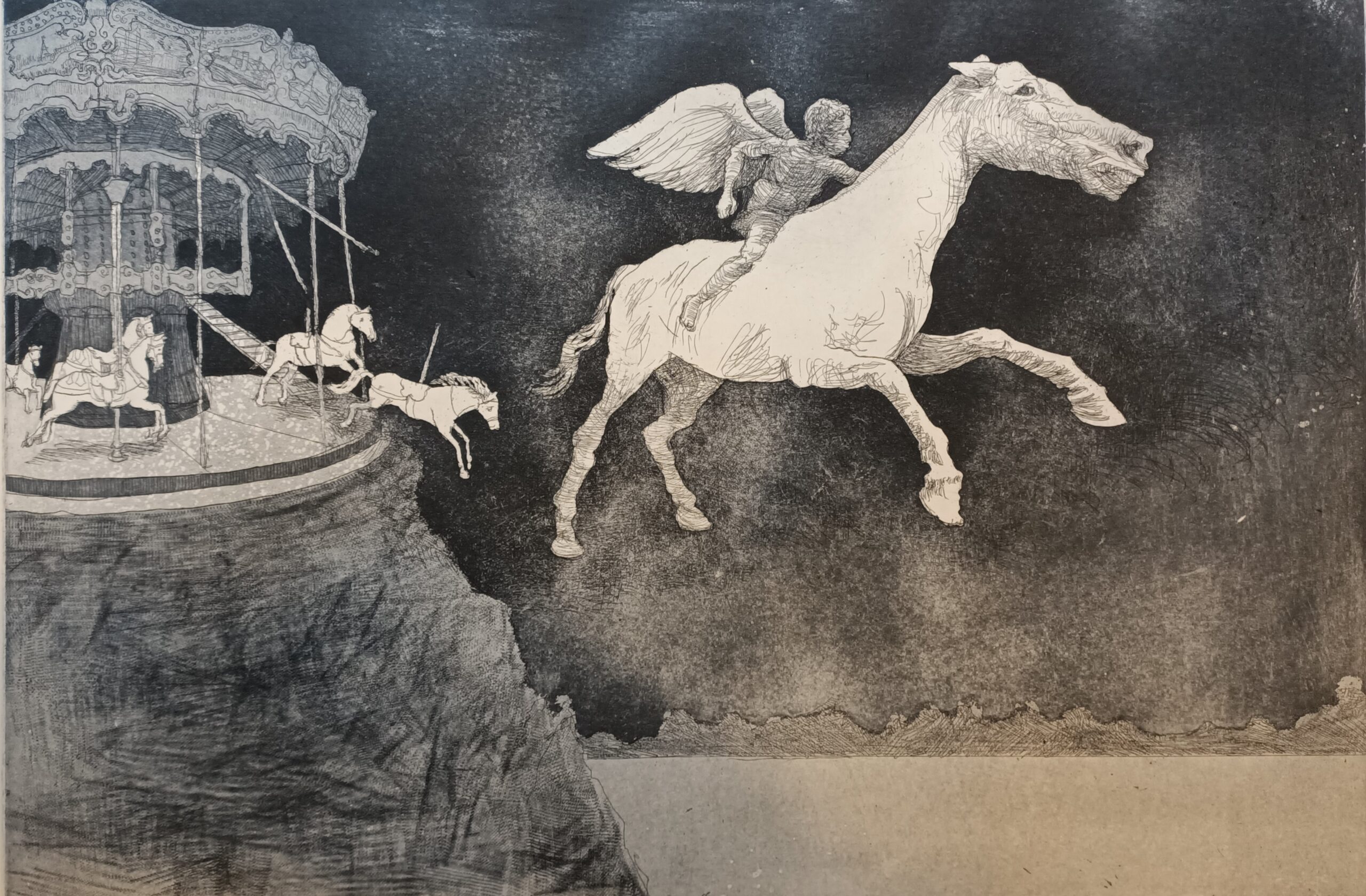

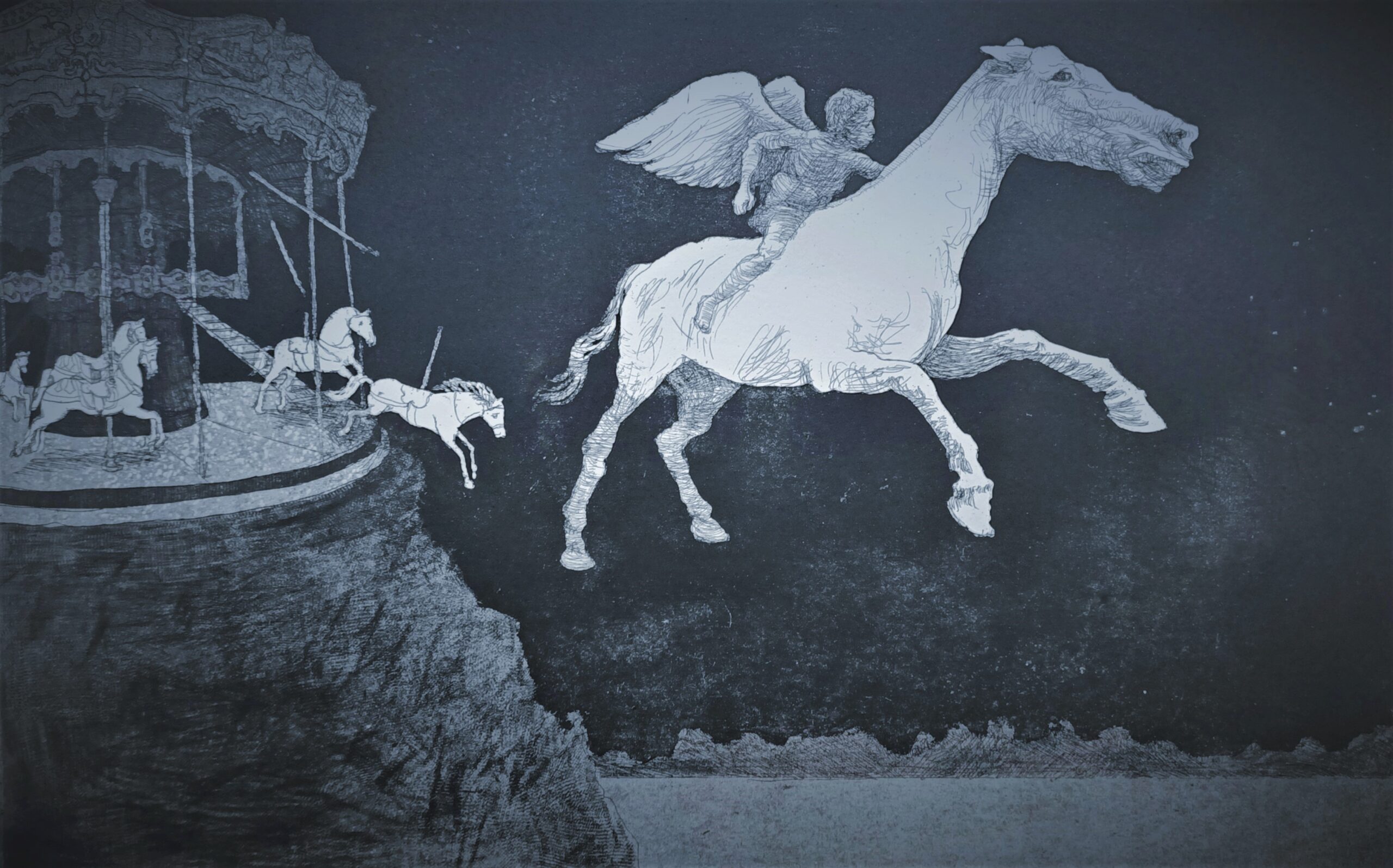
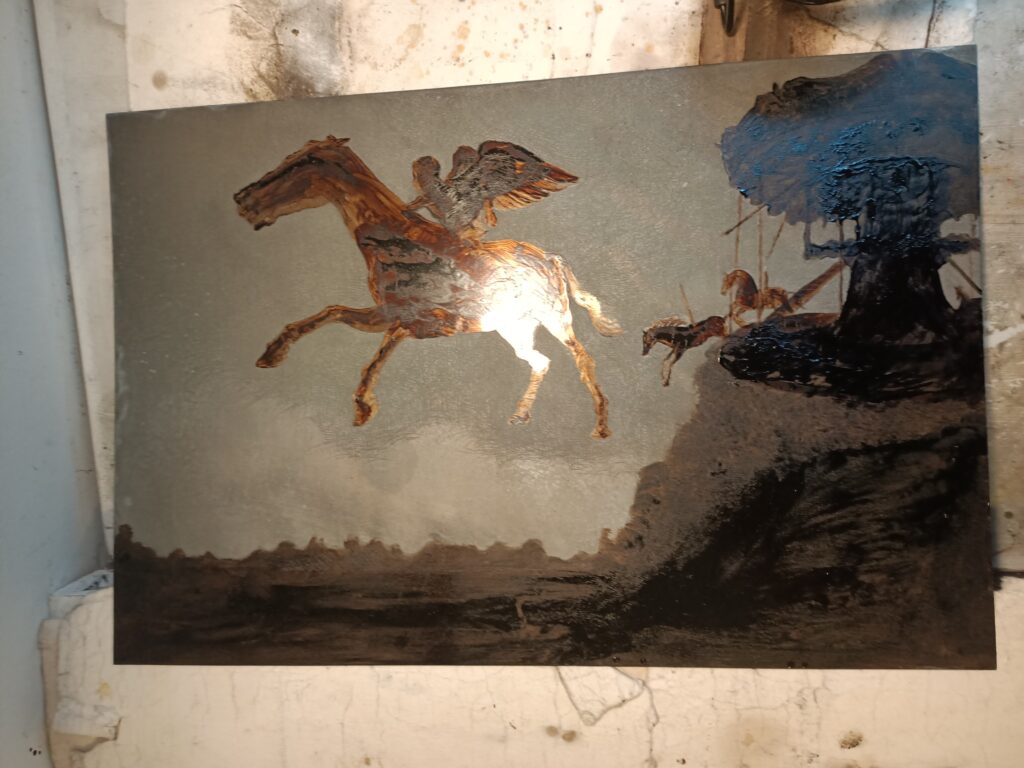
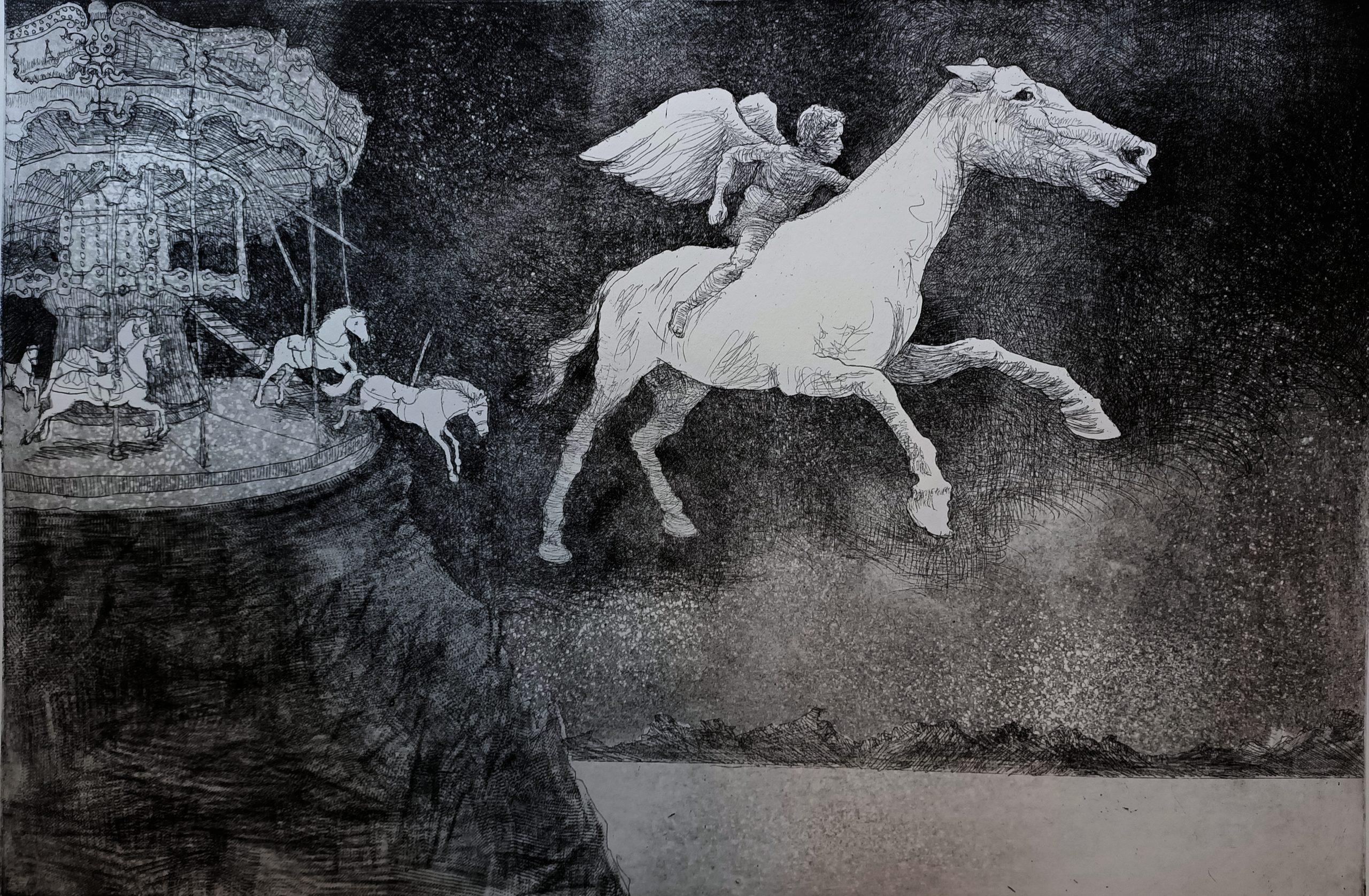


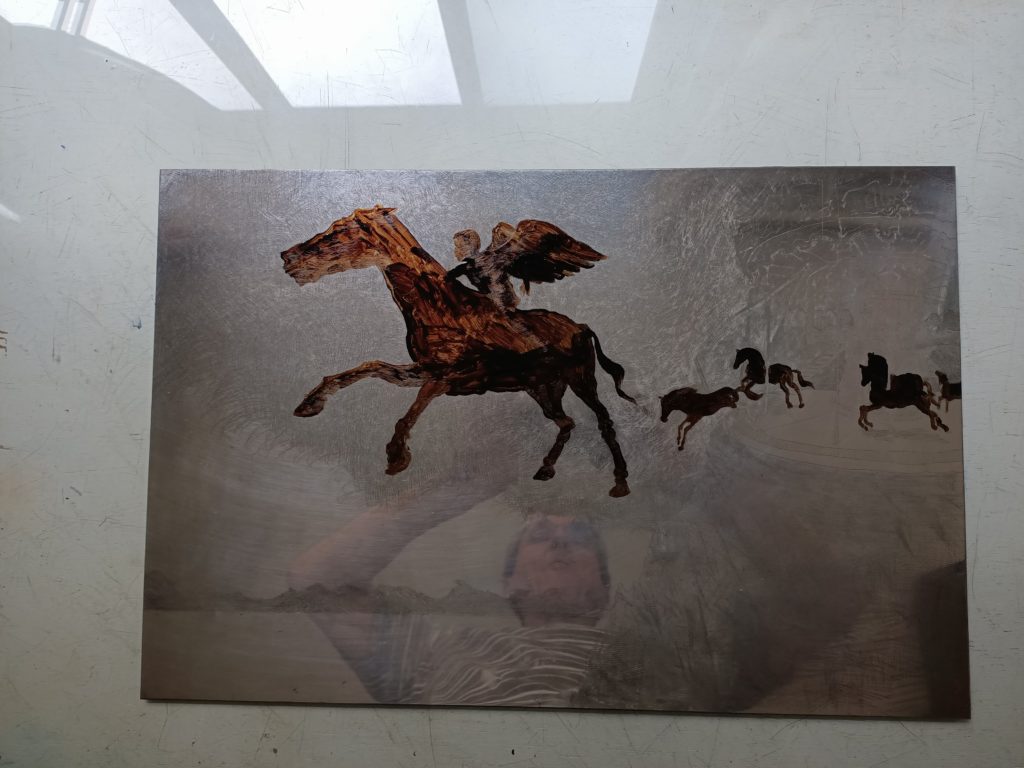

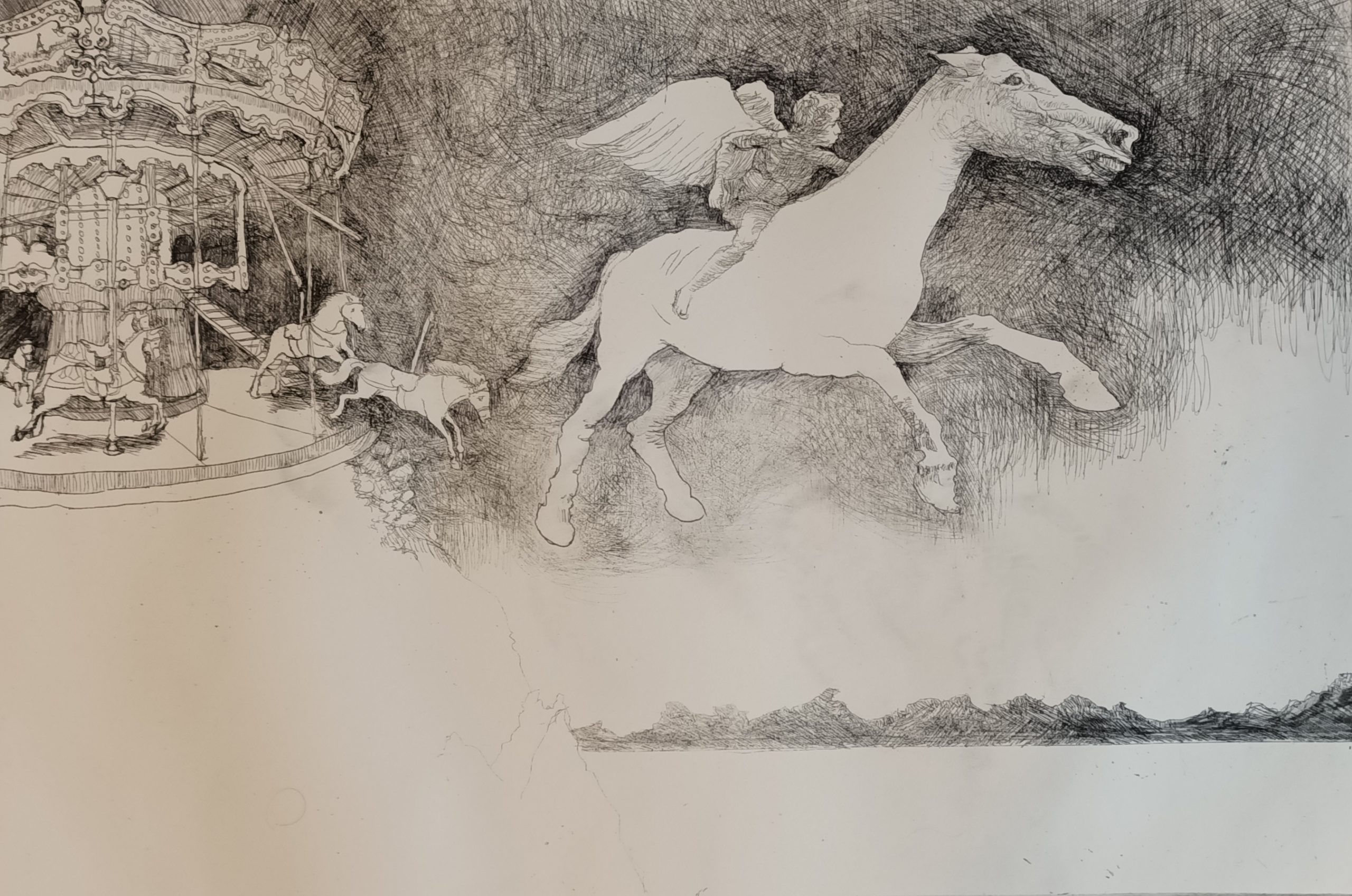
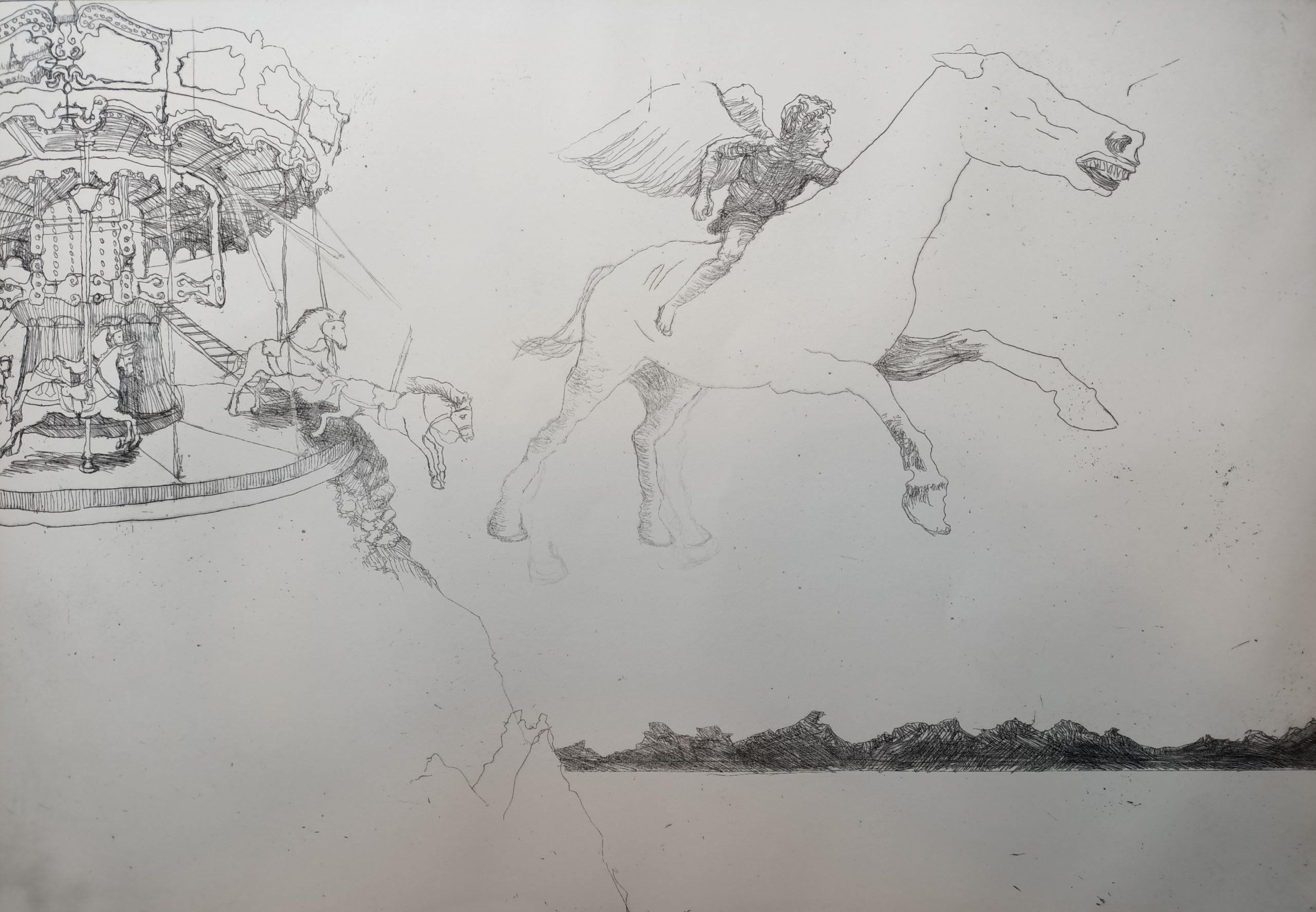
Le retour de Poséidon
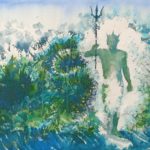
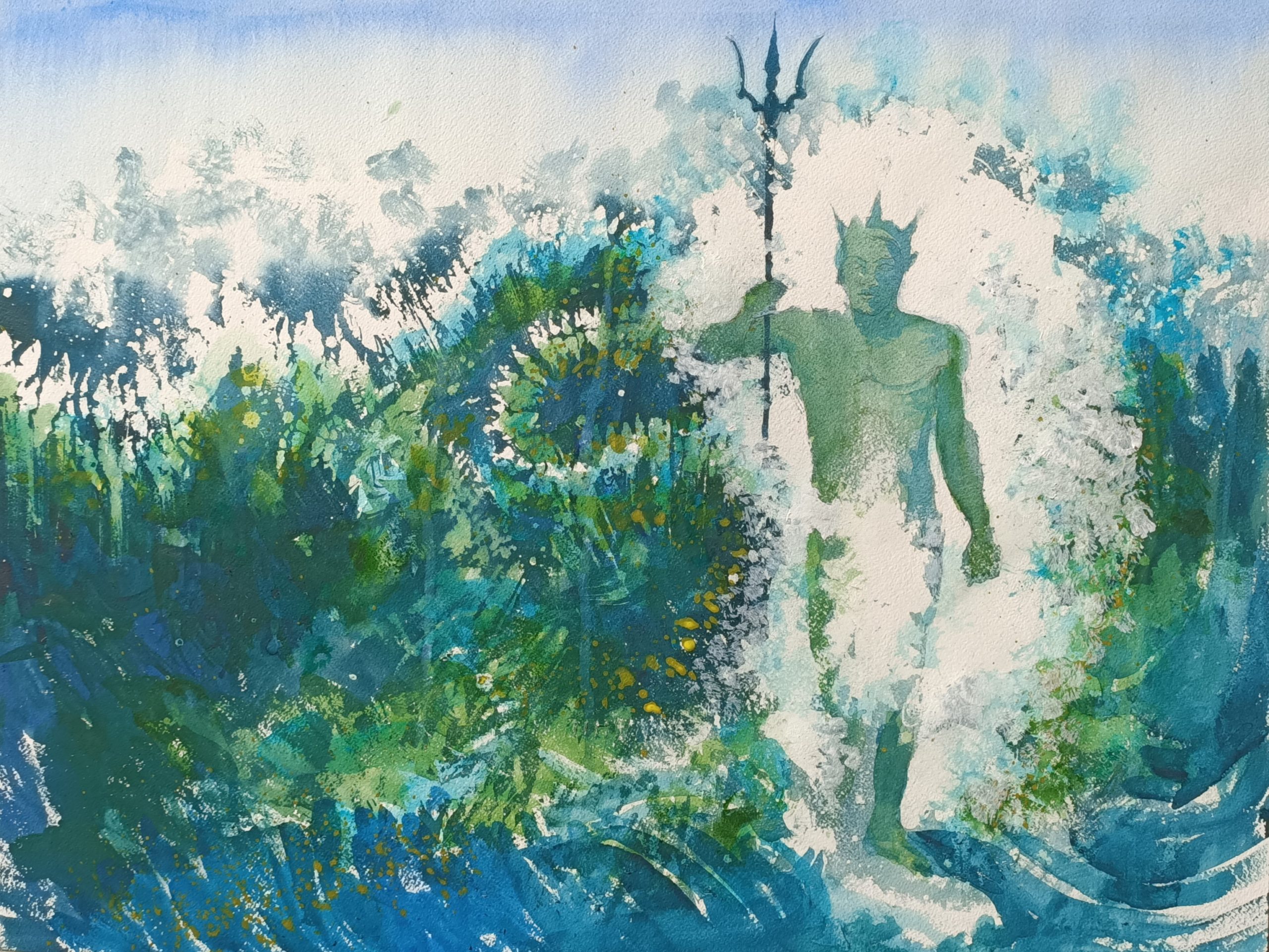
Papier Arches (300 grammes/m2), couleurs Sennelier et Blockx.
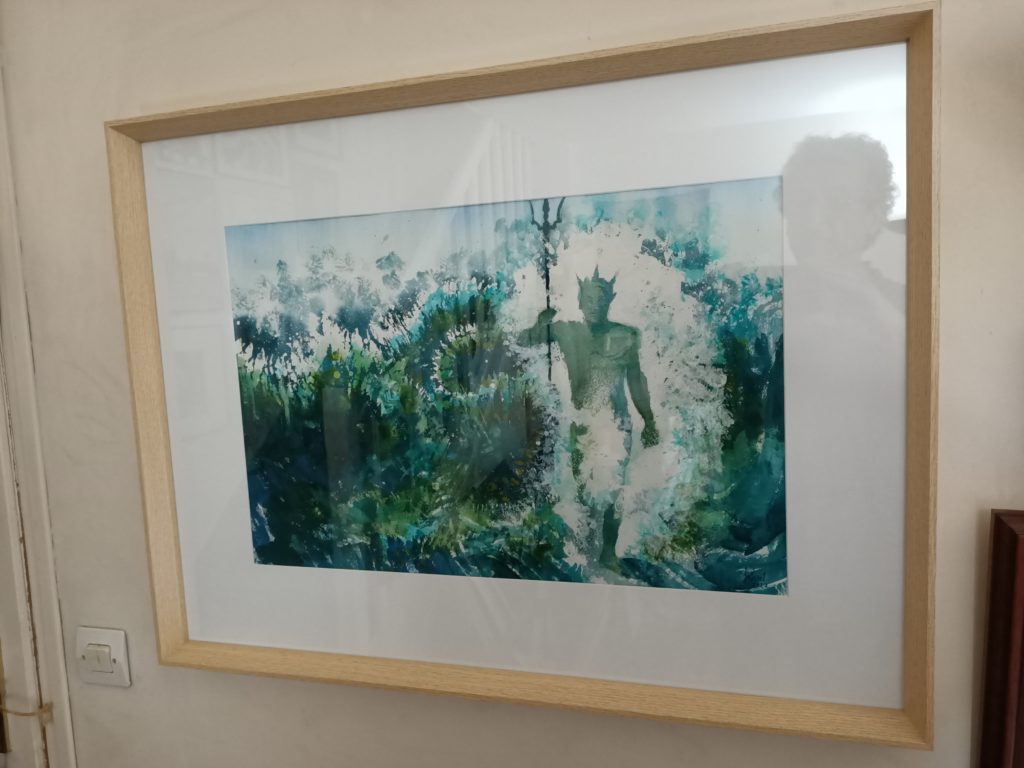
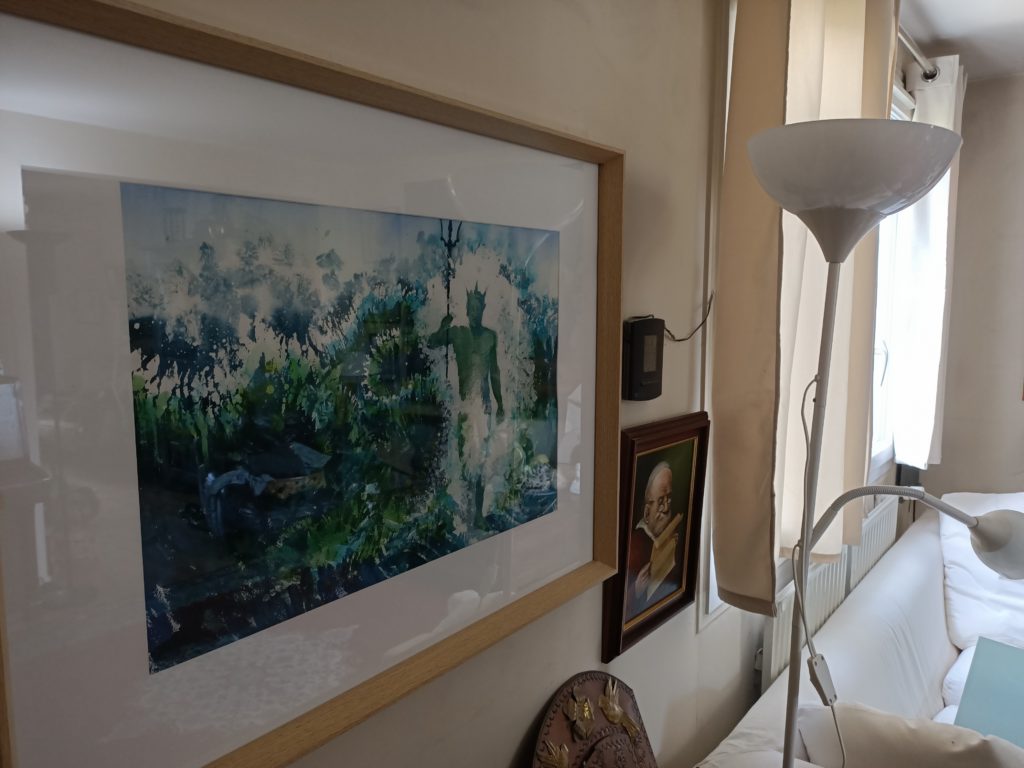

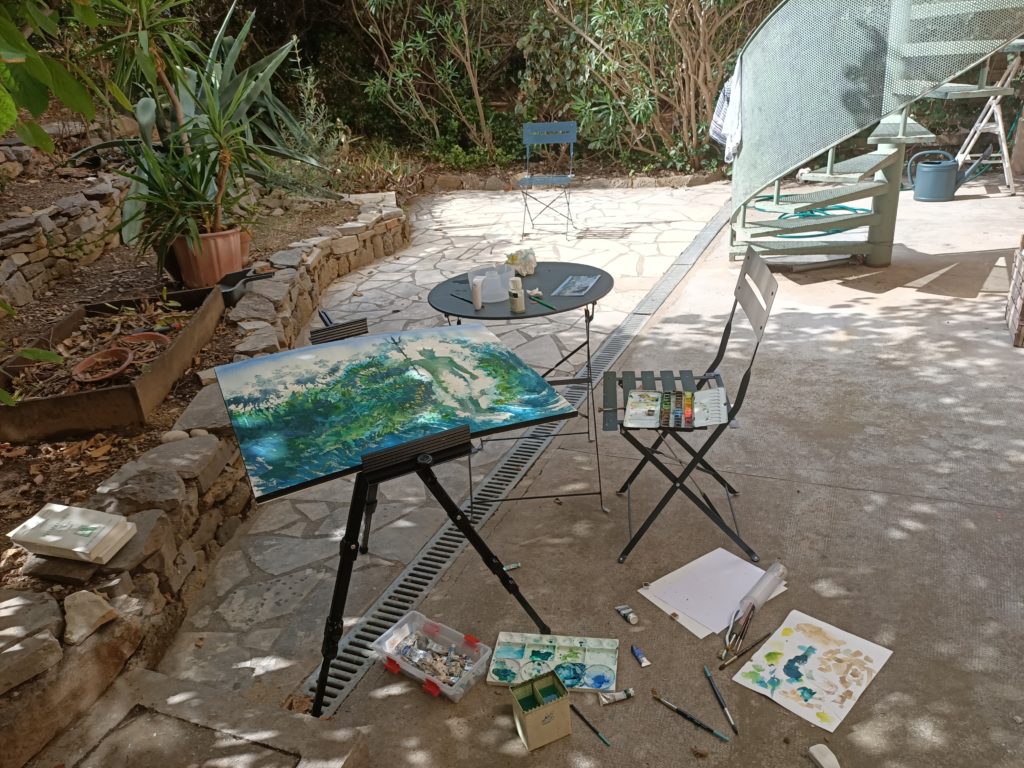
Christian Lévêque : l’écologie malade du « fixisme » ?

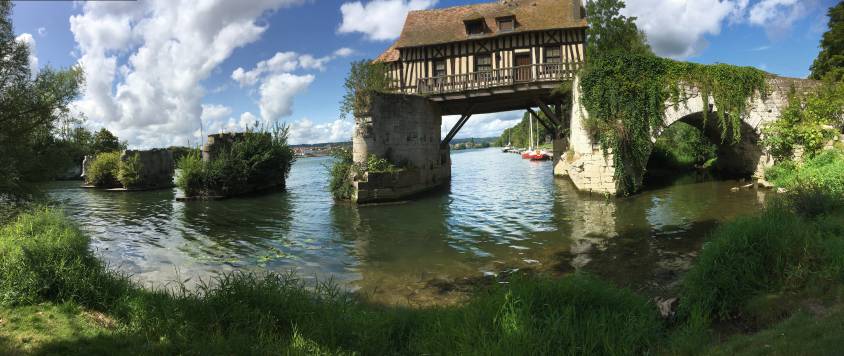
Karel Vereycken s’est entretenu fin mars 2021 avec l’écologue et hydrobiologiste Christian Lévêque, directeur de recherche émérite à l’Institut de recherche pour le développement (IRD) et spécialiste des écosystèmes aquatiques. Il est également président honoraire de l’Académie d’agriculture de France et membre de l’Académie des sciences d’Outre-mer.
Parmi ses derniers écrits, nous recommandons :
- La biodiversité avec ou sans l’homme ? (Quae, 2017) ;
- La mémoire des fleuves et des rivières (Ulmer, 2019) ;
- La gestion écologique des rivières françaises – Regards de scientifiques sur une controverse (L’Harmattan, 2020, avec JP. Bravard) ;
- Reconquérir la biodiversité, mais laquelle ? (Fondapol, 2021).
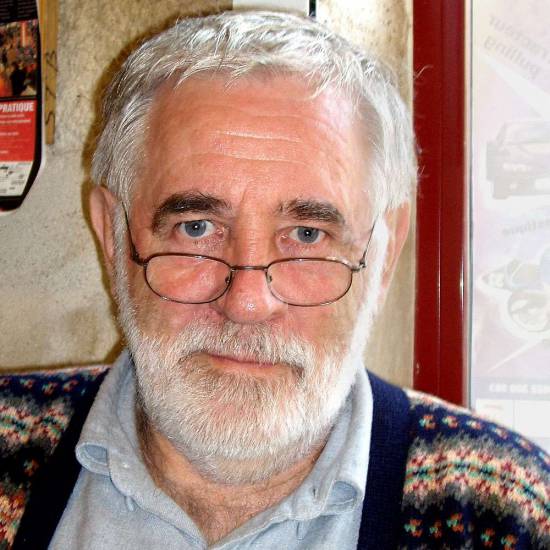
Karel Vereycken : Dans vos écrits, vous soulignez que le discours qu’on entend dans les médias sur l’écologie est plus idéologique que scientifique. Que voulez-vous dire et en quoi est-ce préoccupant ?
Christian Lévêque : La première chose qui me préoccupe dans le discours écologique, c’est qu’il s’agit d’un discours à sens unique : « L’Homme détruit la nature. » C’est un discours de mise en accusation de l’homme dans son rapport à la nature. Or, ce que je vois autour de moi, ce n’est pas tout à fait ça. Prenons le cas du parc naturel de la Camargue, qu’on présente parfois comme un pur produit de la nature. En réalité, il s’agit d’un système aménagé par l’homme pour la production de sel et la riziculture. C’est un système géré artificiellement qui est néanmoins labellisé « parc naturel ». On voit bien, avec cet exemple, que l’action de l’homme n’est pas forcément négative.
Prenons maintenant le cas du bocage normand. Une fois de plus, ce n’est pas un système naturel, mais aménagé par l’homme et l’agriculture. Il est amusant de constater que le bocage figure dans tous les livres traitant de la biodiversité comme un bel exemple de nature qu’il faut préserver. On pourrait multiplier les exemples. Je prends souvent le cas du lac du Der (lac du Der-Chantecoq, en Champagne) qui est un barrage-réservoir (de 48 km²) sur la Marne, construit il y a une trentaine d’années pour protéger Paris des crues de la Seine. Or, tout comme la Camargue, ce site a été consacré « site Ramsar » (Note 1) en matière de préservation de la nature, en particulier pour l’habitat qu’il offre aux oiseaux.
On voit donc que le « vécu des gens » (la réalité) ne correspond en rien à celle dont parlent un certain nombre de mouvements militants qui ne font qu’accuser l’homme de ravager la nature. Pour moi, il y a quelque chose de totalement incohérent dans cette démarche. Ce qui ne veut pas dire pour autant que tout va pour le mieux, et il y a bien entendu des contre-exemples. Mais il faut revenir à des regards plus réalistes et moins dogmatiques sur nos rapports à la nature.
Ce qui me préoccupe le plus dans leur approche, c’est cette « vision fixiste » de la nature, sous-jacente dans la plupart des discours en matière de conservation de la nature. On a l’impression qu’en créant des aires protégées, on va protéger la nature. On oublie que la nature n’arrête pas de changer et qu’une aire protégée ne protège rien dans la durée. La flore et la faune vont évoluer sous l’influence du climat par exemple. Ou sous l’influence d’espèces qui vont se naturaliser sur le site. Et les espèces que l’on cherche à protéger peuvent disparaître car les conditions écologiques ne leur seront plus favorables. Ce sont des mesures d‘urgence qui peuvent être utiles comme telles, mais ce n’est pas une assurance à long terme.
Beaucoup de projets de restauration ou d’aménagement qui cherchent à reconstituer un état écologique historique (c’était mieux avant…) oublient que l’avenir ne peut pas être le passé. Les systèmes écologiques évoluent et se modifient en permanence sur la flèche du temps.
J’avais demandé, il y a quelques années, de faire une simulation sur la remontée du niveau de la mer, dans l’estuaire de la Seine dont je m’occupais. Si la mer monte d’un mètre – ce qui est possible et probable, d’ici à la fin du siècle – vous avez la moitié de la réserve de l’estuaire de la Seine qui est sous l’eau. Et si ça monte de deux mètres, il n’y a plus de réserve du tout. Est-ce qu’on pourrait repositionner la réserve plus haut ? Comme il y a beaucoup d’urbanisation, cela posera de grandes difficultés. C’était une parenthèse pour dire que les réserves naturelles sont un peu limitées en tant que perspective historique…
Si je vous comprends bien, ces écologistes font en quelque sorte un instantané de l’évolution, qu’ils veulent geler artificiellement pour toujours ?
Lorsqu’on regarde dans le passé, comme le font les paléo-écologues, on voit bien que la nature était différente de celle d’aujourd’hui. L’Europe a connu à diverses reprises des périodes de glaciation qui ont profondément modifié la flore et la faune.
Je dis souvent : réfléchissez. Il y a 10 à 20 000 ans, le nord de l’Europe était sous les glaces ainsi que le massif alpin, et l’on était en zone de permafrost là où nous sommes aujourd’hui. Cela a beaucoup changé depuis, non ? On est passé des toundras de Sibérie à des forêts luxuriantes et la biodiversité a également beaucoup changé. Et cela, en relativement peu de temps. La flore et la faune se sont reconstituées par des migrations ou des introductions d’espèces depuis environ 10 000 ans, ce qui est récent. A l’échelle géologique ou à celle de l’évolution, c’est une goutte d’eau.
Il faut bien intégrer que la nature est dynamique. Il est illusoire de penser que l’on pourra figer cette dynamique en établissant des normes et des lois pour la protéger. J’ai conscience que c’est difficile à intégrer car nous n’aimons pas beaucoup le changement, qui est porteur d’incertitudes et donc de dangers… Pour les scientifiques, la biodiversité est le produit du changement et donc de l’adaptation permanente des espèces aux fluctuations de leurs conditions d’existence.

Les mouvements environnementalistes nous alertent sur une forte érosion de la biodiversité et certains évoquent même la menace d’une « sixième extinction de masse » provoquée par l’action humaine. Qu’en est-il ?
Tout cela est compliqué et relève pour partie de la communication de grandes ONG environnementales. Il est vrai que les hommes ont un impact, mais il faut l’évaluer raisonnablement et ne pas tomber dans des discours inflationnistes.
A ceux qui tiennent ces discours, répliquez : « Apportez-moi les données ! » Or, on a beaucoup de mal à trouver les données sur lesquelles sont basées ces assertions.
J’ai vu récemment une communication de l’International Union for the Conservation of Nature (IUCN, l’une des plus grandes associations environnementalistes) et de l’Office français de la biodiversité (OFB) sur le nombre d’espèces menacées de disparition en France, évalué à 2400 espèces. Quand vous regardez le détail, c’est une liste à la Prévert d’espèces dont certaines sont sans aucun doute en régression, il n’est pas question de le nier, et d’autres dont la présence sur la liste sert à faire du chiffre.
Deux exemples pour l’illustrer. Parmi les quelques rares espèces supposées éteintes en France, il y a trois espèces de poissons d’eau douce appartenant au groupe des corégones qui peuplent les lacs alpins. Ce groupe est connu chez les taxinomistes pour être très variable. Selon les auteurs, on distingue des dizaines d’espèces de corégones, ou seulement deux en Europe… Les trois « espèces » en question sont-elles de vraies espèces ou des écotypes ? Ce qui souligne la difficulté rarement abordée de la définition de l’espèce !
Autre exemple, on comptabilise parmi les espèces disparues ou pratiquement disparues en France, des espèces qui vivent dans des pays voisins et qui, pour des raisons diverses, font de temps à autre une incursion chez nous. Il existe ainsi sur cette liste deux espèces de poissons qui sont endémiques en Espagne, où elles sont très abondantes, mais qu’on a pu apercevoir à certains moments dans des régions frontalières en France. Ce sont des espèces qui peuvent être importées accidentellement par des oiseaux, des mammifères ou des hommes, et qui s’installent temporairement chez nous, avant de disparaître. Comptabiliser ce type d’espèces parmi les espèces en danger, c’est quand même un peu fort ! C’est ce que j’appelle faire du chiffre. On aimerait que les données qui sont diffusées par les médias fassent preuve d’une plus grande rigueur !
D’autre part, on mélange systématiquement dans ces analyses les espèces métropolitaines et les espèces ultra-marines.
C’est donc intellectuellement malhonnête…
C’est un problème de manipulation sémantique, oui. On sait que l’essentiel des disparitions d’espèces a lieu dans les îles. C’est clair, c’est net : 95 % des espèces recensées disparues sont des espèces insulaires, des îles indo-pacifiques notamment. Sur les continents, on a très, très peu d’espèces disparues à l’époque historique. Donc pratiquer l’amalgame et laisser croire que la situation est la même partout n’est pas honnête. Les problèmes sont très différents concernant l’érosion de la biodiversité sur l’île de la Réunion, à Mayotte ou en métropole.
Pour la plupart des métropolitains, la France, c’est la métropole ; il faudrait donc préciser en « France métropolitaine et ultra-marine », et distinguer ce qui concerne les îles et ce qui concerne les continents.
Le problème des îles porte sur les « espèces endémiques » (à distribution réduite, liées à un territoire). Dans ce sens, il y a des îles océaniques, mais également des îles continentales. Un lac peut être une « île continentale ». Le lac Tanganyika, en Afrique, est une île continentale dans la mesure où il n’a aucune connexion avec d’autres lacs. Dans une île, vous avez des populations (végétales et animales) qui vont évoluer de manière isolée et qui vont donner au bout d’un certain temps des espèces biologiquement différentes de celles qui existent sur les continents. En général, ces îles ont été peuplées d’espèces qui vivent sur le continent, et l’évolution a fait son œuvre.
En Corse, en Sardaigne, etc., vous avez des espèces endémiques. Si certaines sont de « vraies » espèces biologiques, il s’agit souvent de sous-espèces dont l’évolution n’est peut-être pas complètement terminée.
La faune endémique des îles a beaucoup souffert de l’introduction d’espèces domestiques (chats, chiens) et d’espèces commensales (rats), c’est incontestable. Mais ce n’est pas le cas en milieu continental. Il ne faut donc pas tout amalgamer, à moins de vouloir manipuler les chiffres pour donner l’impression qu’en métropole, il y a de nombreuses espèces qui ont disparu.
On évoque souvent le cas des insectes. Dans les années 1960, pour désigner le liquide lave-glace, on utilisait le terme « démoustiqueur », tellement on ramassait d’insectes sur le pare-brise lors des déplacements en voiture…

C’est vrai qu’il y a moins d’insectes, je ne le conteste pas. L’homme a forcément un impact sur son environnement. Ou alors il faut exclure l’homme comme le proposent certains, pour qui une belle nature est une nature sans l’homme. Veut-on suivre cette logique ? Ce n’est pas la mienne. Tous les animaux ont un impact sur la nature. Lorsque vous regardez les films animaliers à la télévision, il y a toujours cette pauvre lionne ou cette pauvre louve qui cherche désespérément de quoi nourrir ses petits… On voit avec plaisir et même avec soulagement la pauvre lionne tuer une antilope ou la louve tuer un chamois. C’est cruel, la nature. Ce n’est pas un monde paradisiaque. C’est un monde de rapports de force.
Pour revenir aux insectes, il faut, là encore, essayer de comprendre pourquoi, au cas par cas, certaines populations (pas toutes) sont en régression. Et si les pesticides sont au banc des accusés, ils ne sont pas les seuls coupables. Il y a les pratiques agricoles et la modification des paysages, mais aussi toutes les conséquences de l’artificialisation et des pollutions résultant de l’urbanisation.
Ce qui sous-tend vos propos, et je crois l’avoir vu dans vos écrits, c’est la notion de « co-construction » entre la civilisation humaine et la nature ?
C’est en effet ce que je dis – avec d’autres, car je ne suis pas seul dans ce domaine. La « nature » européenne est une co-construction entre les processus spontanés, c’est-à-dire la dynamique des espèces elles-mêmes, et les activités humaines. Le paysage européen, c’est le produit de l’agriculture, au sens large. Il n’y a plus rien d’originel. Mais c’est aussi de nos jours le produit de l’urbanisation. On voit bien que l’urbanisation artificialise le paysage. On n’a plus de grands espaces sans artifices.
En milieu urbain, notre « nature » est une hyper co-construction. On aménage des coins de nature en ville, des parcs, des jardins. C’est artificiel mais ces milieux hébergent également des espèces de plus en plus nombreuses qui s’adaptent à la ville. On y trouve même beaucoup d’espèces protégées.
Une vision romantique prétend que si l’homme disparaissait définitivement, la nature « reprendrait ses droits », mais on peut également craindre que cela ne soit pas forcément le cas. On peut même redouter que des formes plus primitives du vivant, du type virus « malveillants » ou autres, viennent ravager ce qui resterait.
On peut tout imaginer. Je ne suis pas hostile à ce qu’on réfléchisse à ces questions, loin de là. Je dirais que globalement, l’homme a besoin de la nature, c’est évident. Sans les ressources de la nature, il ne peut pas vivre, comme d’ailleurs beaucoup d’autres espèces. Le principe de la nature, c’est qu’il y a des mangeurs et des mangés, ne l’oublions pas. Néanmoins, la nature a existé pendant très longtemps sans l’homme. L’homme est un tout petit épisode dans l’histoire de la Terre et de la nature, en tout cas l’homme actuel. Et il y a fort à parier que si l’homme disparaît, la nature poursuivra son chemin…
Maintenant, ce qui est vrai, c’est que si l’on abandonne un certain nombre d’activités – notamment agricoles – de co-construction de la nature, les paysages vont changer. La déprise agricole (abandon et sous-utilisation à long terme des sols) entraîne ce qu’on appelle la « fermeture » des paysages. Ça veut dire que les systèmes forestiers vont prendre la place des systèmes prairiaux ouverts, ce qui provoquera un changement assez important dans les peuplements qui leur sont associés. Et l’une des raisons probables de l’érosion des populations d’oiseaux des champs en France et en Europe, dont on discute pas mal, est en partie liée à cette déprise agricole. Cela veut dire que beaucoup d’endroits qui étaient des milieux « ouverts » sont maintenant abandonnés à une forêt qui gagne du terrain en France.
Et puis il ne faut jamais oublier que l’artificialisation des sols (extension des zones habitables) progresse beaucoup. Lorsque l’on aborde le problème de la disparition des insectes (sans exclure le rôle des insecticides), il faut considérer le rôle de l’éclairage, celui des lampadaires qui tuent des quantités d’insectes. L’urbanisation détruit évidemment un certain nombre de milieux favorables aux insectes. Les pratiques agricoles, surtout avec les cultures extensives, éliminent les bosquets, etc. Je ne nie pas du tout le rôle des insecticides, mais je refuse d’en faire le seul facteur ou le bouc-émissaire de la disparition des espèces.
Derrière tout cela, je pose la question de savoir s’il est légitime ou pas que l’homme se protège des nuisances de la nature. N’a-t-on pas le droit de se protéger contre toutes ces nuisances que sont les insectes ravageurs des cultures, que sont les moustiques, que sont tous ces vecteurs de maladies, etc. ? Il y a une vraie question qui est posée… et jusqu’où aller ? Pouvons-nous imaginer des compromis et sur quelles bases ?
En plus, cette question ne se pose pas de la même façon dans les pays en voie de développement que dans les pays avancés. Lorsqu’on regarde le rôle des insectes dans la transmission des grandes maladies parasitaires, bactériennes et virales, on a un autre regard.

Moi, j’ai travaillé dans les pays en voie de développement. J’ai passé dix ans en Afrique et j’étais sur le terrain, pas derrière les écrans d’ordinateur d’un laboratoire français. Le discours actuel sur la biodiversité est complètement aberrant par rapport aux besoins et à la situation des pays en voie de développement.
Leur problème, ce n’est pas la conservation de la nature dans des réserves. Leur problème, c’est aussi de se protéger de la nature et de ses nuisances. Je dis bien aussi… car évidemment, ils ont aussi besoin de protéger leurs ressources.
Cette question des deux visages de la nature m’est particulièrement chère car dans le monde vécu des citoyens, la nature est une source inépuisable de nuisances (maladies, ravageurs de cultures, aléas climatiques, etc.). Mais les conservationnistes refusent d’en parler pour ne pas écorner cette image d’Epinal d’une nature bucolique assiégée par l’homme, qui est leur fonds de commerce !
Conservation de l’homme !
Ce n’est pas une guerre de tranchées, mais tout de même, ce n’est pas du tout la vision bucolique et idyllique que les « bobos » ont actuellement de la nature. Ça c’est vraiment un regard de pays riche.
Ce que vous avancez me semble très important. Pourtant, votre discours, sans être marginal, n’est pas médiatisé et reste très éloigné du discours dominant. Pourquoi y a-t-il tant de scientifiques qui s’adonnent à ce catastrophisme ?
C’est aussi une question que je me pose. Je me suis plusieurs fois étonné que mes collègues puissent avaliser des informations du type « 1 million d’espèces menacées de disparition », sans disposer des données permettant d’étoffer une telle affirmation ni savoir comment on l’a calculé. En principe, il existe une déontologie scientifique. Les scientifiques doivent parler de choses qui sont vérifiées, ou mettre des informations sur la table pour qu’on puisse en discuter. Or, on ne trouve nulle part de quelle manière ces chiffres ont été obtenus. Les affirmations de ce type qui tournent en boucle sur internet et sur les réseaux sociaux ne sont pas sourcées.
J’étais interrogé par l’hebdomadaire Le Point (20 février 2021) sur la question du WWF qui annonce, dans son rapport Planète vivante (Edition 2020) que 68 % des vertébrés ont disparu entre 1970 et 2016.
Manque de chance, il y a deux articles scientifiques qui, en s’appuyant sur les mêmes bases de données que le WWF, sortent des chiffres totalement différents. En gros, oui, il y a des espèces dont les populations sont en forte régression, c’est incontestable, on parle des lions, on parle des girafes, etc. Mais il y a également des populations qui sont en expansion et ça, on n’en parle jamais, de même qu’on ne parle jamais de l’évolution qui est en cours. On parle toujours de la disparition des espèces, mais quand on fait des analyses génétiques des populations, on s’aperçoit que l’évolution est toujours en cours. Vous avez des différences génétiques dans un même bassin fluvial, entre populations de poissons d’une même espèce à quelques dizaines de kilomètres de distance. L’évolution, c’est de l’adaptation, Les espèces sont en permanence en train de s’adapter. Quand vous introduisez une espèce américaine dans un lac européen, au bout de quelques décennies, elle se différencie de l’espèce d’origine et peut devenir une nouvelle espèce biologique.
Lors de conférences visant à populariser l’idée de la « grande réinitialisation » (Great Reset), c’est-à-dire le verdissement de la finance mondiale pour « sauver le climat », on a pu voir, à la fin de la grande session réunissant la fine fleur des financiers à Londres, le 11 novembre 2020, Greenpeace présenter la bande annonce de son film « Our Planet, Too Big too fail »…
Je sais…
On peut donc croire qu’il existe un lobby de la finance verte qui a bien besoin de ce genre de propagande…

Il y a « une machine à cash », pour dire les choses simplement. Si vous présentez un programme de recherche dans lequel vous dites « je veux montrer tout l’intérêt de la préservation du bocage et de sa transformation historique, soulignant le rôle positif de l’homme », alors vous ne trouverez absolument aucun financement. En revanche, si vous jouez le chercheur pyromane et que vous criez au feu : « Ah, les espèces invasives, ah, le changement climatique ! ça va tout transformer, ça va tout détruire ! »
Ça marche très bien au niveau des médias, ça marche très bien, hélas, au niveau d’un bon nombre de nos concitoyens, et là, vous allez obtenir des crédits, car vous allez dire « donnez-moi de l’argent, je vais vous apporter la solution ». Cela ressemble fort à ce qu’on appelait au Moyen-Âge le régime des indulgences (Note 2), lorsque l’Eglise disait « donnez-nous de l’argent, et votre âme sera sauvée ! »
C’est ce que dit le WWF : « Donnez-nous de l’argent et on va sauver la planète ! » Ça dure depuis des décennies sans que la question de l’érosion de la biodiversité soit réglée pour autant.
C’est pas mal, les indulgences vertes !
Tout cela crée une sorte de doxa. On se renvoie la balle, on fait de la surenchère. On a une « érosion sans précédent » mais qui n’est pas documentée. On se monte le bourrichon d’une certaine manière, mais ça rapporte – de la notoriété, parce qu’on passe dans les médias, et de l’argent parce que vous allez sauver le monde. Qui va dire le contraire ? On est dans un grand jeu de rôle.
Cela me conduit à la dernière question à laquelle vous avez déjà répondu en partie. Aux politiques, vous dites « regardez les chiffres et ne répondez pas aux images et aux émotions ». Existe-t-il des domaines de recherche prometteurs permettant de clarifier ce débat ?
Pour clarifier ce débat, il faudra d’abord que les politiques soient à l’écoute, ce qui n’est pas forcément le cas. C’est une question pour laquelle je n’ai pas de réponse définitive. Je ne suis pas un gourou. Je ne dis pas « il n’y a qu’à… » ou « il faut qu’on… ».
Lorsque je parle de préserver la diversité biologique, je souligne qu’il faut le faire dans un contexte qui dépasse la seule vision naturaliste. Il y a la nature « objet » et la nature vécue… et on ne peut pas parler de la préserver sans tenir compte des paramètres sociaux en matière d’usages et de santé.
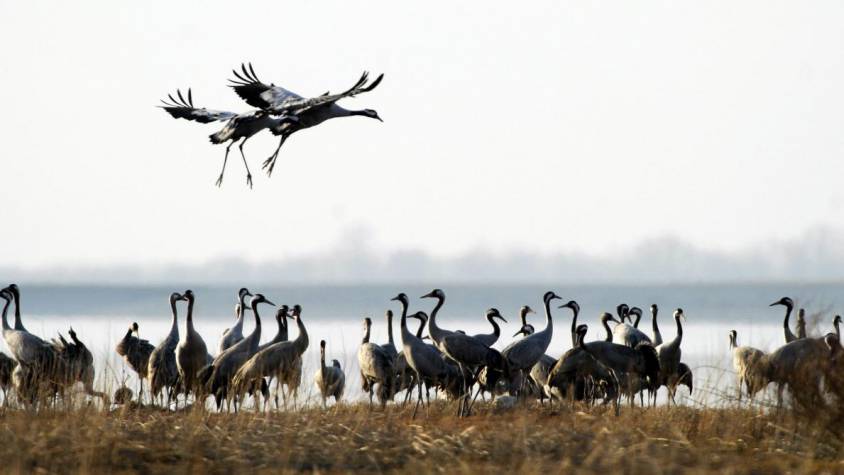
Revenons au lac du Der, qui est devenu une zone de protection pour les oiseaux. Une zone humide, un peu marécageuse, ce n’est pas compliqué à faire. Vous creusez un trou, vous y mettez de l’eau, et au bout d’un an ou deux, vous aurez une belle zone humide. La nature fait très bien les choses et il y a naturellement des échanges importants d’espèces d’un endroit à un autre par le biais des oiseaux, des mammifères, du vent, etc. Si vous avez la chance d’avoir un jardin, faites un trou et mettez de l’eau. Après quelques semaines vous verrez que la vie s’y est bien installée.
Oui, le vivant est conquérant !
Il y a eu des expériences intéressantes de création de marais au nord de Paris, dans le Parc départemental du Sausset (93), par un collègue qui est urbaniste. Au début, des paysagistes y ont mis des plantes. Quelques années après, tout cela avait disparu et l’endroit était envahi par une végétation spontanée de zones humides. A tel point que cette zone est devenue un centre d’attraction pour de nombreuses espèces d’oiseaux. Le public appréciait ce coin de nature sauvage… en milieu urbain.
C’est une chose qui a été déterminante dans ma réflexion, pour dire qu’effectivement l’action de l’homme n’est pas systématiquement négative. Mais ce qui était fait initialement pour distraire le public est devenu une réserve ornithologique fermée au public !
Comme je l’ai développé dans certains articles, on n’est pas obligé d’avoir une vision monolithique des choses. J’aborde souvent ces questions du point de vue des rapports nature-société. Si les hommes ont envie, quelque part, de coins de nature protégée, parce que ça leur fait plaisir, et parce qu’ils y trouvent un intérêt, pourquoi pas ? On n’est pas pour autant obligé de faire de la France tout entière une réserve naturelle ! On doit réfléchir sur la base d’un compromis entre différentes attentes des citoyens et des usages de la biodiversité.
Entre 100 % parking et 100 % réserve naturelle, il y a de la marge…

On parle actuellement de 30 % d’aires protégées (terrestres et maritimes), et certains conservationnistes disent que ce n’est pas assez, qu’il faudrait passer à 50 %. Mais où va-t-on mettre les hommes, là-dedans ? On va les mettre dans des réserves indiennes ? Ça, on ne le dit pas… C’est bien le problème, et c’est irresponsable.
Si l’on revient aux pays en voie de développement, lorsqu’on parle de 30 ou 50 % d’aires protégées alors que leur population est en forte augmentation, va-t-on y faire des zones hyper-peuplées et d’autres hyper-dépeuplées ? Tout ça pour qu’on puisse admirer une belle nature dans les zones protégées alors que les hommes crèvent de faim à côté ? Vous avez lu le livre Le colonialisme vert de Guillaume Blanc ? Lisez-le.
J’ai vécu ça en partie. J’ai connu les zones protégées en Afrique de l’Ouest, elles n’ont pas résisté longtemps lorsqu’il y a eu des révoltes sociales. C’étaient des réserves de viande de brousse. C’est un peu différent en Afrique de l’Est, où c’est devenu en réalité du grand business. Pourquoi pas !
Pour protéger les animaux, certains sont près à abattre les hommes dans ces réserves…
Abattre est peut-être un peu fort (mais c’est vrai au sujet des braconniers…), mais les expulser sans aucun doute. C’est ce que fait le WWF. C’est ce que dit Blanc également et ce comportement a été dénoncé dans des articles parus dans Le Monde diplomatique.
Oui, la télévision néerlandaise y a également consacré un reportage extrêmement documenté.
On peut accepter que dans certains pays comme la France, on crée des réserves dans des endroits où il n’y a personne. C’est le cas du parc du Mercantour. Mais il est vrai aussi que nous avons des parcs régionaux qui essaient d’associer protection et activités humaines, avec un certain succès.
Ou le retour des haies ?
On peut replanter des haies, et c’est ce que l’on fait à petite échelle, mais c’est encore assez anecdotique. Une haie, ce n’est pas que de l’aubépine, c’est aussi des arbres, et il faut du temps. Il y a en théorie des choses simples à faire pour recréer l’hétérogénéité des habitats. Au lieu d’avoir d’immenses étendues de champs labourés, on peut reconstituer quelques bosquets, ce qui serait certainement très positif pour la biodiversité.
Cela offre un plus pour les oiseaux…
Ce sont les arbres qui sont importants pour beaucoup d’oiseaux. Il est également clair qu’il faut réduire les pollutions, mais celles de toute nature, et pas seulement les pesticides. Les pollutions lumineuses, ça existe, et l’on pense que pour les insectes et les oiseaux, cela joue un rôle actuellement. Il y a des scientifiques qui semblent disposer de données pour le prouver. On voit bien qu’il y a des choses à faire, mais ce n’est pas forcément la révolution.
C’est en « co-construisant » avec la nature et en se posant la question : qu’est-ce qu’on veut comme nature ? Ce qui nous amène à prendre en compte non seulement des facteurs écologiques, mais également des facteurs économiques et sanitaires. Je ne suis pas sûr que les citoyens soient prêts à accepter le retour des moustiques, par exemple. Mais je respecte aussi les choix de nature éthique. Encore faut-il qu’ils ne deviennent pas exclusifs.
Aujourd’hui, dès qu’il y a un coq qui chante ou des grenouilles qui croassent, on appelle la police et on exige que le maire du village soit fusillé !
Ce qui compte, c’est de rechercher des solutions au cas par cas, qui ne seront pas les mêmes partout. En évitant les excès et les attitudes trop dogmatiques. Mais à certains moments, il faut aussi savoir trancher. Ça c’est de la politique, pas de la science.
C’est pour cela que le concept de co-construction est vraiment la chose à faire connaître.
Il faut tenir compte, selon les endroits, du contexte écologique, économique, sociologique, etc. Il faut tenir également compte des changements dans la société. Au XIXe siècle, la préoccupation majeure était de survivre. L’agriculture ne produisait pas assez, les gens crevaient de faim dans certains endroits. Il fallait donc produire. On ne se posait pas la question de la protection de la nature. Aujourd’hui, c’est la même chose dans les pays en voie de développement.
Je ne sais pas si vous avez vu le cri d’alarme lancé par Jean-Christophe Debar, de la FARM (Fondation pour l’agriculture et la ruralité dans le monde). Car il y a toute une offensive européenne en cours, au nom du Green New Deal, contre la viande, accusée d’être en grande partie responsable des émissions de gaz à effet de serre.
C’est ce que l’on dit… encore faut-il faire des évaluations honnêtes de ces émissions.
On a vu alors des gens sortir leur calculette pour évaluer comment réduire de moitié l’élevage. Face à cela, M. Debar met en garde qu’imposer des baisses de rendement risque d’obliger à doubler les surfaces à cultiver. En gros, cela équivaut à raser les forêts pour faire du bio… Ils se trouvent pris dans leurs propres paradoxes.

Pour produire la même chose en bio, cela demande 30 à 50 % plus de terres qu’en traditionnel. Je ne défends pas forcément le traditionnel, mais c’est un fait. A partir de là, on peut discuter. On peut certainement faire du bio dans certains endroits, mais dans l’état actuel, le bio est plus consommateur d’espaces. Moi je développe une autre idée. Je vis dans un pays où il y a encore du bocage (zone d’élevage). Eh bien, si l’on supprime la viande, qu’est-ce qu’il va devenir, ce bocage ? Ça va s’emboiser : friche, bois… ou ça va faire de belles zones industrielles pour centres commerciaux, ou des centres de loisirs. Donc, si on mange moins de viande, on va modifier nos paysages et sa biodiversité, ce qui montre la complexité des phénomènes et la limite des raisonnements « y’a qu’à, faut qu’on ».
On veut faire de nos agriculteurs de simples « capteurs de carbone ». Ils ne seront plus rémunérés pour les aliments qu’ils produisent, mais pour leur gestion de champs considérés comme des puits de carbone… La question est de savoir ce qui capte le plus de CO2 : une friche, une forêt ou un champ cultivé ?
Cela dépend des cultures et de ce qu’on intègre comme éléments de calcul. Vous parlez des émissions de gaz à effet de serre. On accuse les vaches.
Cependant, un des grands émetteurs de méthane, ce sont les zones humides… Les « feux follets », vous connaissez ? C’est du méthane. Avec la décomposition de la matière organique, il y a émission de méthane.
Pourtant on protège les zones humides, c’est un grand enjeu de conservation, n’est-ce pas ? Mais personne ne veut parler de la production de méthane par les zones humides… Les ONG montent au créneau quand on leur dit ça.
Ségolène Royal serait mécontente de vous entendre !

C’est pourtant évident. J’ai assisté à une séance de l’Académie de l’agriculture où on a parlé de l’émission de méthane par le rot des vaches. J’ai demandé à quoi ça correspond par rapport aux émissions des zones humides ? Silence… Il existe aussi des données démontrant que le permafrost qui se dégèle émet des quantités considérables de méthane. Il faut dire ces choses. On s’amuse avec le rot des vaches, mais est-ce le fond du problème ? On amuse la galerie, en réalité…
Ne pensez-vous pas qu’il est temps de former à nouveau des écologues et des biologistes prêts à aller sur le terrain pour y faire des relevés, plutôt que de tout miser sur des modélisations informatiques ?
C’est un des grands problèmes de l’écologie actuellement. Récolter des données, aller sur le terrain, ça coûte cher, ce n’est pas valorisant au niveau des publications, et c’est parfois sportif ! Pour ces différentes raisons, l’écologie est en partie devenue une science spéculative. Dans son bureau, on fait de l’écologie théorique sur ordinateur avec des « modèles » et on sort ensuite de grandes théories qui ne sont pas validées par les données de terrain.
Pour moi, l’écologie est avant tout une science d’observation ! le modèle est un outil qui aide à traiter ses informations. Ce n’est pas une fin, et encore moins un moyen de se substituer au terrain. Ou alors on en reste à la vision fixiste de l’écologie et on croit que le vivant se conforme aux théories que l’on a imaginées. Comment prendre en compte la variabilité et les aléas dans des modèles déterministes ? Le modèle auquel on accorde un crédit prédictif est l’antithèse de la démarche adaptative.
Un mot pour conclure ?
A mon sens, il est urgent que « l’écologie » (et pas l’écologisme) fasse sa révolution copernicienne. L’écologie est née autour de l’objectif d’identifier les lois qui régulent la nature.
C’était le but recherché au début du XXe siècle : découvrir les lois de la nature. Avec l’arrière-pensée que si l’on connaissait les lois, on pourrait agir sur la nature. Tout comme on avait trouvé les lois des orbites planétaires et de la gravité avec Copernic et Newton, on espérait trouver des lois définissant le fonctionnement général de la nature. Avec le temps, on s’est aperçu qu’il n’y avait pas (ou très peu) de lois pouvant expliquer le fonctionnement général de la nature, mais beaucoup de situations particulières (la contingence). La seule grande loi est celle qui montre que la distribution des espèces à la surface du globe dépend du climat et de la géomorphologie. A part cela, chaque système écologique est relativement différent et fonctionne d’une manière différente. Il faut donc éviter les généralisations et les globalisations, comme le font les mouvements militants et les ONG lorsqu’ils parlent d’érosion de la biodiversité. On l’a vu à propos de la différence entre les espèces continentales et les espèces insulaires.
Et surtout, il faut se mettre dans la perspective que la nature, ça bouge, ce n’est pas en équilibre, ce n’est pas stable, et que penser la préserver dans des réserves ou à travers des lois normatives, c’est un peu de la fiction.
Ils font la même erreur sur le climat en évoquant une température globale de la planète…
Oui, ils appellent cela la « température moyenne » pour l’ensemble du globe. J’ai dit une fois, par boutade, « qu’est-ce que c’est, cette connerie ? » Ça signifie quoi, une moyenne globale ? On voit bien que ce n’est pas si simple au niveau de la planète. Il y a à la fois des réchauffements et des refroidissements, des canicules et des vagues de froid, etc. Il en est de même pour la biodiversité, elle n’est pas la même partout.
Chaque région a son histoire climatique, géologique et anthropique. On dit que l’écologie est contingente, c’est-à-dire qu’un système écologique est le produit d’une histoire et d’un contexte local. La globalisation masque cette hétérogénéité qui est pourtant la caractéristique du vivant. Chaque système a son mode de fonctionnement, ce qui rend bien entendu difficile les généralisations. Les forêts méditerranéennes ne sont pas les forêts bretonnes, ni les forêts tropicales, et ça ne fonctionne pas de façon identique. La vie, c’est avant tout la diversité et l’hétérogénéité, c’est l’adaptation aux conditions locales…
Cela veut dire que l’écologie doit s’inscrire dans une perspective dynamique et non pas statique. Pour moi, c’est le fond du problème. On manque encore d’outils pour prendre en compte la dynamique des écosystèmes. On manque aussi d’informations sur leur évolution sur le temps long. On a longtemps pensé qu’un système écologique fonctionnait comme une machine dans laquelle toutes les espèces avaient leur rôle. Ce concept que l’on a qualifié de déterministe était pratique, car il donnait l’illusion que l’on pouvait gérer la nature si on en connaissait les lois de fonctionnement.
Depuis, on s’est rendu compte, à la suite des travaux du paléontologue S. Gould, par exemple, et ceux des généticiens, que le hasard jouait un rôle considérable dans la dynamique du vivant. Le vivant n’est pas le monde physique et il n’obéit pas aux mêmes lois.
Mais reconnaître le rôle du hasard (ou des aléas), c’est ouvrir la porte à l’incertitude, et on a du mal à y souscrire car ça rend difficile la prévision. Les gestionnaires sont alors démunis en matière d’anticipation. Mais on continue à faire comme si on pouvait prévoir le futur, avec ces nouveaux astrologues que sont les modélisateurs qui entretiennent l’illusion que le futur est prévisible… et donc maîtrisable !
Il faut dire clairement que l’on ne sait pas prévoir. Il faut le marteler car en réalité, ce que nous pouvons faire de mieux, c’est de nous adapter. C’est cette thématique d’une gestion adaptative qu’il faut promouvoir, bien différente de la gestion normative que nous pratiquons, qui consiste à établir des normes pour appliquer des lois qui n’ont aucune signification dans des systèmes dynamiques.
On en est, hélas, à une sorte de retour à une pensée moyenâgeuse. On fait tout un foin sur la complexité du monde, mais en fin de compte, c’est le rasoir d’Ockham, on adopte un truc simplet.
En effet, le public veut les explications les plus simples possibles. On est resté sur la logique : une cause, un effet. On a du mal à penser que dans un système écologique, un effet peut avoir plusieurs causes qui s’additionnent ou se compensent. On oublie aussi qu’une cause peut mettre beaucoup de temps avant d’avoir un effet. Les sécheresses cumulées sont l’une des causes du dépérissement des arbres.
Comme vous l’avez dit, on cherche des « effets de com’ ». Tout ce qui est ambigu, métaphorique, paradoxal ou réellement hypothétique, est écarté.
La complexité, on a du mal à l’intégrer. C’est pourquoi on opte pour les idées simples et le plus souvent fausses. Il n’est pas évident de résumer des phénomènes aussi complexes que les dynamiques naturelles. Et puis, il faut bien l’admettre, beaucoup de citoyens sont ravis quand on donne dans le catastrophisme. La preuve, c’est que ça marche au niveau du temps d’écoute des émissions radio ou télé. Et les ouvrages de collapsologie se vendent bien.
Soyons plus positifs. Ce qui fait l’intérêt de l’écologie de nos jours, ce n’est pas de faire la liste des notices nécrologiques, mais de redonner une vision positive et opérationnelle des relations homme-nature. Sans nier, bien évidemment, qu’elles ne sont pas toujours très cordiales, on doit aussi reconnaître que dans certaines régions du monde, les hommes ont co-construit une nature qui répond à leurs besoins de sécurité physique et alimentaire.
Et cette nature à l’exemple de celle que nous connaissons en Europe, n’est pas pour autant un champ de ruines. Ce n’est pas en stigmatisant continuellement le rôle de l’homme et en prédisant l’apocalypse que l’on mobilisera les citoyens. Il faut redonner de l’espoir, réenchanter la nature, comme le disait Serge Moscovici.
Et l’écologie scientifique doit apporter son concours à la reconstruction de rapports moins dogmatiques avec la nature, en montrant qu’il y a aussi des « lendemains qui chantent ». Ce qui suppose de réviser sérieusement les concepts fondateurs et de s’affranchir des discours militants basés sur des considérations idéologiques.
Je retiens votre image d’« indulgence verte ». D’ailleurs, lorsqu’on regarde les formulaires de don de certaines ONG militantes, on constate qu’ils vous demandent de leur léguer votre héritage. On culpabilise les gens à mort, et ensuite, pour pouvoir accéder au paradis par un petit chemin vert, ils vous disent « confiez-nous votre fortune ».
Il serait intéressant de savoir comment fonctionnent réellement ces organisations qui prétendent défendre la nature. Ce sont des multinationales qui brassent beaucoup d’argent. Ce que je sais, c’est que le niveau des rémunérations que touchent les milliers de « spécialistes » et d’employés de ces grands organismes sont supérieurs aux salaires des scientifiques français.
Il y a un combat d’idées à mener, et nous sommes très content que vous le meniez. Nous essayons, nous, de notre côté, d’y apporter notre pierre.
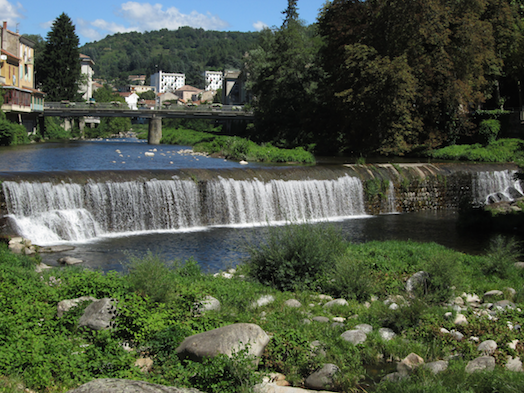
C’est un combat qu’on ne peut pas mener tout seul. Discuter de la doxa dominante est compliqué, on a du mal à se faire entendre, on a l’impression de ne pas être écouté. Mais on s’aperçoit aussi que les lignes commencent à bouger.
Ainsi, j’ai participé par visioconférence à une réunion du Sénat sur la « continuité écologique » des rivières en France.
Je vous rappelle qu’il y a quelques années, l’Office national de l’eau et des milieux aquatiques (ONEMA) et l’Office français de la biodiversité (OFB) avaient décidé que pour restaurer l’état écologique des rivières françaises, il fallait détruire tous les « seuils » [3], c’est-à-dire détruire tous les moulins, en quelque sorte. En clair, éliminer toutes les constructions qui pouvaient entraver la circulation de l’eau des rivières, afin de permettre à certaines espèces (en réalité une poignée) de remonter le cours de la rivière pour se reproduire.

Il y a eu pas mal d’actions très contestées et les propriétaires de moulins ont beaucoup manifesté. On est ici typiquement confronté à la fausse bonne idée, car la raréfaction des poissons migrateurs dans nos cours d’eau résulte de multiples causes, comme nous l’avons vu plus haut, notamment la qualité de l’eau, mais aussi l’endiguement des cours.
Avec un collègue géographe et d’autres auteurs, nous avons écrit un livre sur la restauration écologique des rivières, qui est paru l’année dernière.
Apparemment, cela a fait bouger un peu les lignes et on est en train d’évoluer vers l’abandon de ces mesures technocratiques consistant à supprimer systématiquement tous les seuils, qui, en outre, ne semblent pas donner les résultats escomptés mais détruisent un patrimoine. Il faut voir les choses au cas par cas et discuter de mesures alternatives avec les propriétaires. Il y a des politiques qui commencent à évoluer.
Je ne suis donc pas pessimiste, ce qui m’encourage à poursuivre ce combat d’idées.
NOTES:
- En 1971, lors d’une conférence à Ramsar, en Iran, 18 pays ont signé une convention sur la protection des zones humides, « importantes, en raison des fonctions écologiques et hydrologiques qu’elles remplissent, pour la conservation de la diversité biologique mondiale et la pérennité de la vie humaine ».
- Au Moyen Âge, l’Église catholique permettait à ses fidèles d’acheter en argent bien sonnant des indulgences, lesquelles devaient réduire, selon le montant accumulé, le temps qu’on devait passer au purgatoire après sa mort pour expier ses péchés. C’était fort commode pour les vilains qui avaient les moyens de s’offrir un peu plus de péchés que la moyenne. Bien avant Luther, l’humaniste Erasme de Rotterdam fut le premier à s’insurger contre cette pratique. KV.
- Le mot « seuil » désigne tout ouvrage fixe ou partiellement mobile, construit dans le lit mineur d’un cours d’eau et qui le barre en partie ou en totalité. On en recense plus de 60 000 en France.
Alain Bécoulet: la Science, puissant vecteur de rapprochement entre peuples



La coopération scientifique entre la France et la Chine dans le domaine du nucléaire civil est très ancienne.
Voici un entretien avec un chercheur qui y participe depuis trente ans, le physicien Alain Bécoulet, ancien directeur de l’Institut de recherche sur la fusion par confinement magnétique (IRFM) du CEA, aujourd’hui directeur du domaine « ingénierie » de l’International thermonuclear experimental reactor (ITER), un tokamak géant en voie d’assemblage à Cadarache, près d’Aix-en-Provence (13).
Au cours de sa longue carrière, Alain Bécoulet a travaillé, avant ITER, sur les tokamaks JET (Culham, Royaume-Uni), DIII-D (San Diego, Californie) et enfin Tore Supra (Cadarache, France).
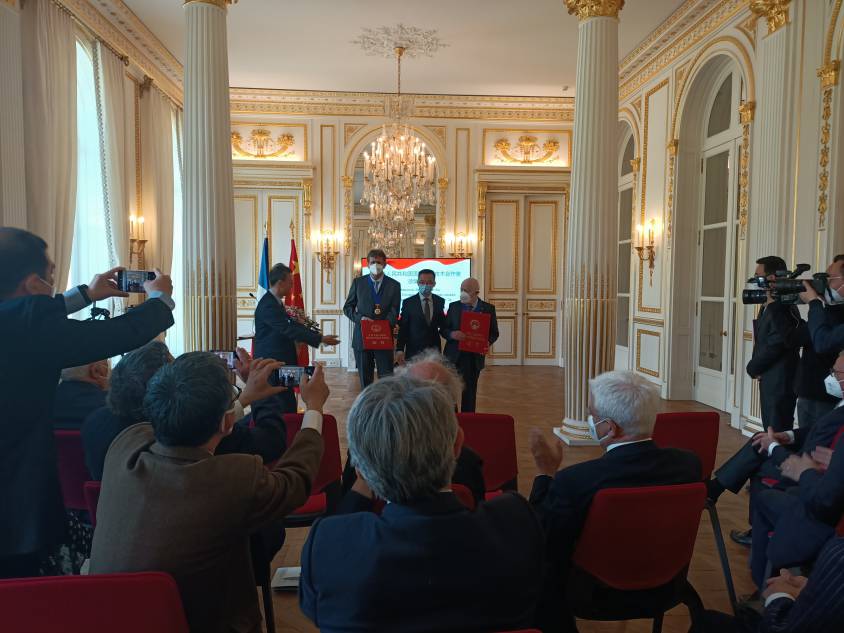
Karel Vereycken : Monsieur Bécoulet, bonjour.
Le 28 mars, lors d’une conférence de presse à Paris, en présence d’Alain Mérieux et de l’ancien président de l’Assemblée nationale Bernard Accoyer, le gouvernement chinois, par la voie de son ambassadeur, a remis son prix de la coopération scientifique et technologique internationale à deux chercheurs français au cœur de la coopération franco-chinoise : le professeur Jacques Caen, hématologue renommé, et vous-même, pour votre travail sur la fusion thermonucléaire dans le cadre du projet ITER.
Coût croissant des énergies fossiles et renouvelables, climat, conflits et croissance démographique. Autant de phénomènes qui interpellent brutalement nos gouvernements sur l’importance de l’énergie. Rappelez-nous brièvement ce qu’est la fusion et en quoi elle apporterait une réponse à ces défis ?
Alain Bécoulet : La fusion de noyaux atomiques légers est le mécanisme qui prévaut au fonctionnement de notre Soleil, et des étoiles en général. C’est une source nucléaire d’énergie virtuellement sûre, propre, décarbonée et très abondante. Si on arrive à la maîtriser, elle entrerait donc tout naturellement en première place des futurs mix énergétiques. Le défi, pour cela, est sa domestication sur Terre, qui entre seulement, avec ITER, dans sa démonstration de faisabilité à l’échelle 1.
Une fois cette étape franchie par ITER dans la deuxième moitié des années 2030, la voie sera ouverte vers des réacteurs électrogènes basés sur le principe de la fusion.
Puisque vous étiez de l’aventure, entre les premiers tokamaks et ceux d’aujourd’hui, quelles innovations ? Les progrès dans la supraconductivité ont-ils contribué à ces avancées ? Quel est l’objectif du tokamak géant ITER par rapport à ses prédécesseurs ?
Le défi est effectivement dans le déclenchement puis le maintien des réactions de fusion dans un « réacteur » de taille raisonnable, c’est-à-dire dans la miniaturisation à l’extrême d’un soleil.
Pour cela il a fallu, et il faut encore, plusieurs décennies non seulement de physique et d’expérimentation sur des « tokamaks » (c’est le nom que l’on donne à ce type de réacteurs) de formes et tailles diverses, mais également de nombreux développements et innovations technologiques.
Vous citez la supraconductivité : elle nous a en effet permis un saut considérable dans la réalisation des aimants continus nécessaires au confinement du milieu extrêmement chaud (une centaine de millions de degrés) dans lequel se passent les réactions de fusion.
La taille du tokamak est ensuite directement liée à la puissance que l’on peut extraire de ce type de réacteur, avec un effet à seuil en deçà duquel on ne peut pas déclencher de réactions. ITER, avec ses 830 m3 de « plasma » (c’est l’état dans lequel est le mélange de réactifs porté à de telles températures) va nous permettre de produire environ 500 MW de puissance fusion.
Un peu comme les missions spatiales, ITER (c’était d’ailleurs un des objectifs fixés par Gorbatchev et Reagan) a su réunir dans un projet commun des pays pas forcément amis. Le partage complet des informations et de la propriété intellectuelle est-il un élément fondamental pour cette coopération gagnant-gagnant ?
ITER est en effet construit par l’Organisation internationale, suite à un traité signé fin 2006 par sept partenaires : Chine, Corée du Sud, Etats-Unis, Inde, Japon, Russie et Union européenne. Cette dernière est le membre-hôte, hébergeant le site de construction à Cadarache, dans le sud de la France. Le traité ITER prévoit un partage complet de la propriété intellectuelle développée lors de la construction et de l’exploitation expérimentale d’ITER entre tous les membres.

Quelles retombées pour l’économie française ?
ITER est construit en France et il est clair que les retombées économiques sont très importantes pour le pays (contrats de construction et de transport, hébergement des personnels et de leur famille…). A ce jour (on est encore à environ cinq ans de la fin de l’assemblage du tokamak), on estime à plus de 4 milliards d’euros ces retombées.
La politique des sanctions et d’embargos ne risque-t-elle pas de nuire à une science dont les progrès, en dernière analyse, profitent à tous? Les 10 millions de pièces nécessaires à l’assemblage d’ITER seront-elles au rendez-vous?
De manière générale, ITER est construit par assemblage des millions de pièces fabriquées et fournies « en nature » par ses membres. Les échanges entre pays sont donc au cœur du maintien du planning de construction. L’assemblage d’ITER est ainsi fortement perturbé depuis deux ans par les effets de la pandémie de Covid-19, qui a non seulement déstructuré la production industrielle partout dans le monde, mais également ralenti et compliqué considérablement les transports.
Toute difficulté politique entre les membres d’ITER est effectivement également de nature à perturber la mise au point de la fusion. La situation de tension actuelle entre la Russie et les autres pays en fait partie. Rappelons cependant qu’ITER n’est pas une « collaboration » internationale, mais bel et bien un traité international.
A ce jour, ce traité n’a pas été questionné par ses membres et l’impact est essentiellement lié à la grande complication des échanges internationaux, dont ITER dépend fortement en effet.
En quoi la Chine contribue-t-elle à ITER ?

La Chine est l’un des signataires du traité ITER et à ce titre, contribue au projet via des fournitures en nature et sa contribution au budget de l’Organisation internationale. Elle a, en parallèle, un programme national de recherche et développement ambitieux et dynamique qui prévoit, comme plusieurs autres membres, de tirer tous les enseignements d’ITER dans le design et la construction des futurs réacteurs.
La France, notamment EDF, n’a-t-elle pas contribué dès le début au développement du nucléaire civil dans ce pays ? Comment a évolué la coopération franco-chinoise dans ce domaine ? Comment a-t-on su créer une confiance mutuelle dans un domaine aussi sensible ?
La coopération franco-chinoise en fusion a déjà plus de trente ans, et je suis d’ailleurs particulièrement fier d’y avoir contribué activement très tôt. A ce stade, elle a été portée par les grands instituts de recherche que sont le CEA d’une part et l’Académie des Sciences de Chine de l’autre. La CNNC (Compagnie nucléaire nationale chinoise) s’est jointe il y a une vingtaine d’années, via son institut SWIP. Les grands industriels du nucléaire commencent à rejoindre la fusion essentiellement depuis l’étape ITER.
Quel rôle avez-vous pu jouer dans ces échanges ?
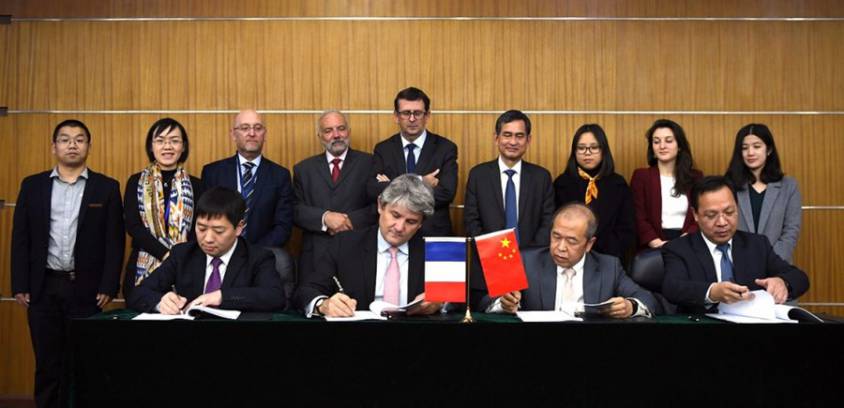
J’ai personnellement contribué au rapprochement de la Chine et de la France en fusion depuis plus de trente ans. Mes premières contributions ont évidemment été purement scientifiques et liées à mes propres activités de recherche, incluant de nombreux échanges dans les deux sens. Ce rôle s’est progressivement développé et amplifié au fur et à mesure du développement de mes responsabilités au CEA et au sein du programme fusion européen (programmes de recherche communs, échanges de matériel, projets communs, etc.), culminant au milieu des années 2010 par la création de SIFFER, le Sino-French Fusion Energy centeR, laboratoire virtuel joignant les forces en fusion du CEA, de l’Académie des Sciences Chinoise et du CNNC, en vue d’accélérer les échanges et la collaboration entre les deux pays. Des investissements significatifs sur les tokamaks des deux pays ont ainsi été réalisés dans des domaines technologiques tels que les composants face au plasma, la robotique d’inspection, les diagnostics, etc.
Racontez-nous un peu l’histoire de Tore Supra (devenu WEST), du projet EAST et des dernières percées obtenues en Chine.

Tore Supra est le premier tokamak, dans les années 1980, à avoir démontré la possibilité d’utiliser la technologie des aimants supraconducteurs pour la fusion. Il a ainsi réellement ouvert la voie technologique vers ITER. Tore Supra a ensuite continué systématiquement la mise au point des autres technologies-clés pour le maintien des conditions de fusion dans un tokamak (injection en continu de puissance, évacuation en continu de la chaleur, contrôle en temps réel…) avec de vrais succès et records mondiaux, dont notamment des plasmas maintenus plus de six minutes à très haute puissance injectée, au début des années 2000. Le tokamak EAST.

La Chine a voulu très tôt suivre la même voie de recherche, probablement grâce à l’excellente collaboration que nous avions déjà en place. Elle a ainsi conçu et construit le tokamak EAST, sur des concepts très proches de Tore Supra, et de très nombreux échanges ont permis l’émergence rapide d’EAST.
Quand il s’est agi de faire évoluer les technologies de composants face au plasma de Tore Supra (milieu des années 2010), en soutien au programme ITER, la Chine a très largement soutenu le CEA et j’ai voulu d’une certaine manière souligner ce « jumelage » grandissant entre les deux tokamaks en rebaptisant Tore Supra en WEST, combinant le clin d’œil géographique au fait que Tore Supra embarquait ainsi une technologie à base de tungstène, dont le symbole chimique est le W.
Que faut-il faire pour susciter des nouvelles vocations en France ? Comment cela se passe-t-il en Chine ?

La Recherche en général a besoin des meilleurs talents. Elle se développe ainsi sur un terreau de vocations. Dans le cas de la fusion, le défi est l’un des plus importants auquel l’humanité se soit attaquée. La route est encore assez longue et nécessite un soutien fort de la part des États mais aussi, de plus en plus, des acteurs de l’Energie au sens large, et des investisseurs privés. On voit actuellement un intérêt grandissant de ce côté. Il est de nature à soutenir ces vocations. Ceci est valable en Occident, mais également en Chine.

Votre livre, L’énergie de fusion, publié en français en 2019 chez Odile Jacob et déjà traduit en anglais et en néerlandais, sortira bientôt en chinois, c’est un bon signe ?
Ce livre a en effet pour but de sensibiliser le plus largement possible aux recherches en fusion, en « racontant » avec des mots simples quelles sont les avancées scientifiques et techniques déjà acquises et quels sont les défis qu’il reste à relever jusqu’au réacteur.
Il est de nature à susciter de nouvelles vocations, je l’espère, et les retours que j’ai des lecteurs et des éditeurs me font très plaisir.
Comment réagissez-vous au prix que la Chine vous a décerné ?
Comme je l’ai dit dans mon discours, au-delà de l’immense honneur que le gouvernement chinois me fait en me décernant ce prix plus que prestigieux, c’est la recherche en fusion et son caractère totalement ouvert et collaboratif qui sont distingués. Ma conviction professionnelle la plus profonde est que la Science est l’un des vecteurs les plus puissants du rapprochement entre les peuples, et donc de la paix. La volonté de savoir, de connaître, de décoder la Nature, est une source inépuisable et universelle de l’être humain. Je suis particulièrement fier d’y contribuer et très reconnaissant que cela ait été reconnu et salué par le gouvernement chinois au travers de ce prix. Il couronne aussi de très belles rencontres et amitiés qui se sont développées au cours de ces années, et le plaisir à chaque fois renouvelé pour moi des visites en Chine.
Omar Merzoug: Avicenne ou l’islam des lumières
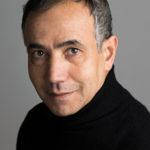
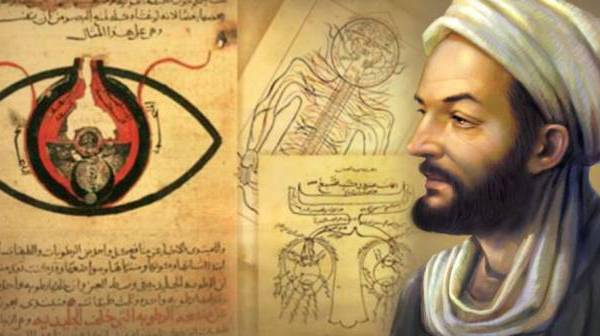
En avril 2022, Karel Vereycken s’est entretenu avec Omar Merzoug, docteur en philosophie et spécialiste de la pensée au Moyen Âge. Il a publié en 2018 Existe-t-il une philosophie islamique ? (Cahiers de l’Islam). Pendant sept ans, il a enseigné la philosophie et la civilisation islamique à l’Institut Al-Ghazâli de la Grande Mosquée de Paris.
This interview in EN (pdf)
Karel Vereycken : Monsieur Merzoug, bonjour. Après sept ans de recherches, d’études et de vérification de documents historiques, vous venez de publier en 2021, chez Flammarion, une biographie enthousiaste et fouillée d’Avicenne (980-1037). Qui était ce personnage et pourquoi avoir publié ce livre maintenant ?

Omar Merzoug : Il s’agit de l’illustre Ali Ibn Sînâ (que l’Occident nomme Avicenne), savant, médecin, philosophe et homme d’Etat, qui a eu une vie passionnante et fort mouvementée, et dont l’influence sur les penseurs chrétiens du Moyen Âge, de l’avis même des spécialistes les plus autorisés, fut considérable. Ce ne fut pas, comme on a tendance à le croire, un commentateur, mais c’était un penseur qui a créé tout un système s’inspirant d’Aristote, mais qui l’enrichit, le contredit.
Un penseur indépendant, par conséquent. Il fut lu comme philosophe jusqu’au XVIIe siècle et l’on retrouve dans les écrits des philosophes des Temps modernes, Malebranche, Leibniz et Spinoza, des échos de son œuvre. Comme médecin, ses travaux furent longtemps au programme des universités européennes. C’est donc une figure fort intéressante en tant que savant, mais aussi en tant qu’homme.
Publier ce livre maintenant, c’est d’abord saluer cette figure éminente du monde musulman à l’heure où, il faut bien le dire, l’islam n’a pas bonne presse. Le rationalisme d’Avicenne, sa curiosité intellectuelle, sa capacité à assimiler toutes sortes de savoir, son esprit encyclopédique et son inventivité philosophique sont autant de traits qui pourraient contribuer à une renaissance de la véritable culture philosophique dans le monde musulman, culture philosophique qui est bien malmenée aujourd’hui.
De père afghan, né en Ouzbékistan et d’éducation perse, de nombreux pays (qui n’existaient pas à son époque dans leurs frontières actuelles) se réclament les héritiers de sa gloire. Qui a raison ?
On ne prête qu’aux riches. Plus sérieusement, Avicenne est un persan d’Ouzbékistan. Tout l’indique, mais cela ne saurait empêcher Turcs, Arabes et Européens de se réclamer de lui, de le lire et même de le critiquer, et c’est d’ailleurs ce qui s’est produit.
La deuxième partie du titre de votre livre, L’islam des lumières, sous-entend qu’il y aurait plusieurs islams…
Il n’y a certes pas plusieurs islams, mais il y a des lectures et des approches différentes, et même contradictoires, de l’islam. Et cela ne date pas d’aujourd’hui. Il y a, pour résumer, une lecture littérale des textes fondamentaux de l’islam et il y a des lectures plus subtiles, plus soucieuses de faire prévaloir l’esprit sur la lettre. Au reste, le Coran lui-même autorise cette disparité des lectures (Sourate III, verset 7).
Comment Avicenne a-t-il concilié théologie et philosophie ?
Comme tous les grands penseurs du Moyen Âge et même des Temps modernes, Avicenne s’est attaqué à ce problème essentiel et inévitable du rapport entre la théologie et la philosophie. Il ne s’est pas tant agi de concilier la raison avec la foi, mais plutôt la Loi religieuse et la raison. Sur ce point, Avicenne présente notamment sa théorie de l’émanation comme la seule interprétation véritable de la création. Partant du principe qu’il ne faut pas prendre à la lettre les récits, les allégories, les métaphores et toute la symbolique du Coran, il conclut qu’il faut l’interpréter à l’aune des principes de la raison. C’est en définitive la raison qui garde la primauté en matière d’interprétation des textes religieux.
A son époque, Avicenne était-il apprécié pour son travail en médecine ou pour ses idées philosophiques ?
Sur ce point, les spécialistes d’Avicenne ne sont pas tous d’accord. En Orient on l’estime beaucoup plus comme médecin que comme philosophe. En Occident, on a plutôt tendance à le considérer comme philosophe, d’autant que sa médecine n’a plus, compte tenu des progrès de la science, qu’un intérêt historique.
Néo-platoniciens, aristotéliciens et thomistes se prétendent souvent disciples d’Avicenne, mais en le lisant, on constate que ce dernier n’entre dans aucune case. Quelle qualité faut-il donc avoir pour pouvoir se dire disciple d’Avicenne ?
Être disciple d’Avicenne aujourd’hui voudrait signifier être rationaliste, pas au sens d’une sorte d’agnosticisme ou d’athéisme, mais au sens où la raison a qualité pour examiner toutes choses, que peu de domaines sont soustraits à son empire. Bien entendu, dans sa mystique qui est intellectualiste, Avicenne ménage une transition vers un au-delà de la raison, qui ne peut être atteint que par une sorte d’illumination. C’est bien la raison pour laquelle certains penseurs chrétiens du Moyen Âge ont pu établir un lien entre saint Augustin et Avicenne.
Sans avoir vécu à Bagdad et né après la grande période des Abbassides, sous Al-Mamoun et ses Maisons de la sagesse réunissant penseurs arabes, juifs et chrétiens nestoriens pour traduire l’héritage grec et syriaque, voyez-vous en Avicenne un héritier de la démarche mutazilite qui fit la grandeur de Bagdad ?
Avicenne est certainement plus proche des Mu’tazila que des partisans de l’approche littéraliste et anthropomorphiste. Les Mu’tazila combattaient pour la liberté de l’esprit et c’est, à peu de chose près, le combat d’Avicenne, convaincu que tout outrage à ce principe serait catastrophique. S’il n’y a pas de débat, de controverse, de libre dialogue et de recherche indépendante, il ne saurait y avoir au bout du compte qu’un recul de la pensée. La grandeur de la civilisation de Bagdad a été précisément, sous Al-Ma’mûn et ses successeurs immédiats, de permettre, par une politique délibérée et réfléchie, ce bouillonnement culturel, cette effervescence intellectuelle extraordinaire qu’on n’a pas revue depuis dans le monde musulman.
En lisant votre biographie d’Avicenne, qui nous introduit à lui en partant de sa vie quotidienne, on découvre qu’il n’avait rien d’un intellectuel de salon. Activement engagé pour le bien commun et la santé de tous, sa vie est loin d’être une sinécure et on le voit souvent contraint de s’exiler. Pourquoi ?
Se situant dans la tradition platonicienne qui voulait que les philosophes gouvernent les Etats parce qu’ils sont les plus savants, Avicenne a directement exercé les responsabilités du pouvoir. A deux reprises, il a géré un Etat et cela a failli lui coûter la vie. Introduisant les réformes indispensables et luttant contre les privilèges qu’il estimait indus de l’armée, il a déclenché une mutinerie des prétoriens. Oui, s’engager dans la cité pour des causes méritoires, c’est être d’une certaine manière avicennien. Comme Platon, il a échoué dans son entreprise, mais elle méritait d’être tentée, comme elle le mérite toujours.
Pourquoi le Canon de la médecine d’Avicenne a-t-il permis tant de progrès en médecine ?
C’est un livre fort intéressant sous plusieurs angles. C’est une somme du savoir médical, qui a d’ailleurs, en tant que telle, une postérité exceptionnelle. Dans cet ouvrage, il y a plusieurs avancées intéressantes. C’est un livre fort bien composé et qui est fondé de part en part sur les règles et les principes de la logique. Il a été de surcroît conçu dans une perspective pédagogique. Des fragments entiers du Canon sont rédigés sous forme d’abrégés pour permettre une assimilation plus rapide du savoir médical.
Avicenne estime qu’on ne saurait comprendre la maladie et donc lui trouver un remède que si on établit des liens de causalité. Reprenant la théorie des quatre causes d’Aristote, il les adapte à sa recherche médicale et juge qu’on n’atteint la pleine connaissance d’une maladie que si on en recherche les causes, écartant ainsi une approche strictement empirique.
A ses yeux, il y a une unité entre les organes et les fonctions du corps, de la même manière qu’il établit un rapport entre l’organisme et le monde extérieur. C’est d’ailleurs pour cela qu’il accordait, en tant que médecin, une importance essentielle aux mesures prophylactiques et à l’environnement.
Autre chose à signaler, Avicenne fut certainement le premier à proposer une approche de l’anatomie de l’œil, à émettre le diagnostic de la pleurésie et de la pneumonie, à distinguer la méningite infectieuse des autres infections aiguës.
D’autre part, il accordait une importance primordiale aux exercices physiques. C’est sans doute le premier, dix siècles avant Freud, à avoir insisté sur l’importance de la sexualité et de son rôle dans l’équilibre psychologique de la personne. Enfin, il fut sans doute l’un des pionniers de la médecine psychosomatique. En témoigne le cas de l’amoureux transi que je rapporte dans ma biographie.
Estimant sa personnalité hors du commun capable d’inspirer le meilleur de la civilisation islamique, Mme Helga Zepp-LaRouche, la fondatrice de l’Institut Schiller, a lancé une grande « initiative Ibn Sînâ » pour reconstruire l’Afghanistan et de son système de santé. Comment voyez-vous cette démarche ?
C’est sans doute une initiative extrêmement louable qui réintègre Avicenne dans son milieu (son père était afghan) et qui, sous deux perspectives, la santé et la grandeur de sa gloire, lui rend hommage.
Les raisons du succès de votre livre ?
C’est toujours délicat pour un auteur de dire quelles sont les raisons qui expliquent le succès, relatif dans mon cas, d’un livre. Je l’attribue d’abord au genre biographique qui s’apparente un peu au roman – au reste, la vie d’Avicenne est très romanesque. Ensuite, à l’effort pédagogique qui rend accessible la présentation de cette éminente figure du savoir, et peut-être aussi, à un style littéraire agréable et délié.
On connaît bien, d’Avicenne, ses travaux en médecine et maintenant, grâce à votre biographie, sa vie. A quand un nouveau livre dédié plus spécifiquement à ses idées philosophiques ?
Il n’existe pas sur le marché d’exposé systématique de la pensée d’Avicenne. Ce qui existe, fruit du travail de certains universitaires travaillant dans le champ avicennien, ce sont des monographies sur des thèmes ou des concepts avicenniens.
C’est de toute façon un travail d’une tout autre nature que la biographie et pour un tout autre public, plus restreint. Je me laisserai peut-être tenté par un tel projet, qui sait ?
Avicenna and Ghiberti’s role in the invention of perspective during the Renaissance

By Karel Vereycken, Paris, France.
Same article in FR, même article en FR.
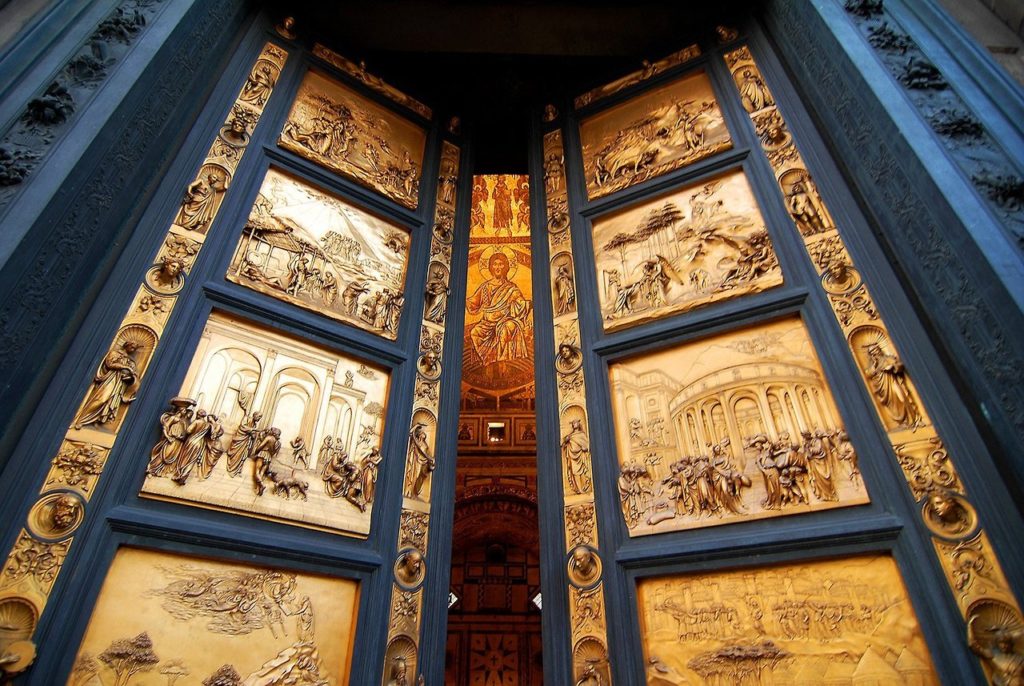
No visitor to Florence can miss the gilded bronze reliefs decorating the Porta del Paradiso (Gates of Paradise), the main gate of the Baptistery of Florence right in front of the Cathedral of Santa Maria del Fiore surmounted by Filippo Brunelleschi’s splendid cupola.

In this article, Karel Vereycken sheds new light on the contribution of Arab science and Ghiberti’s crucial role in giving birth to the Renaissance.
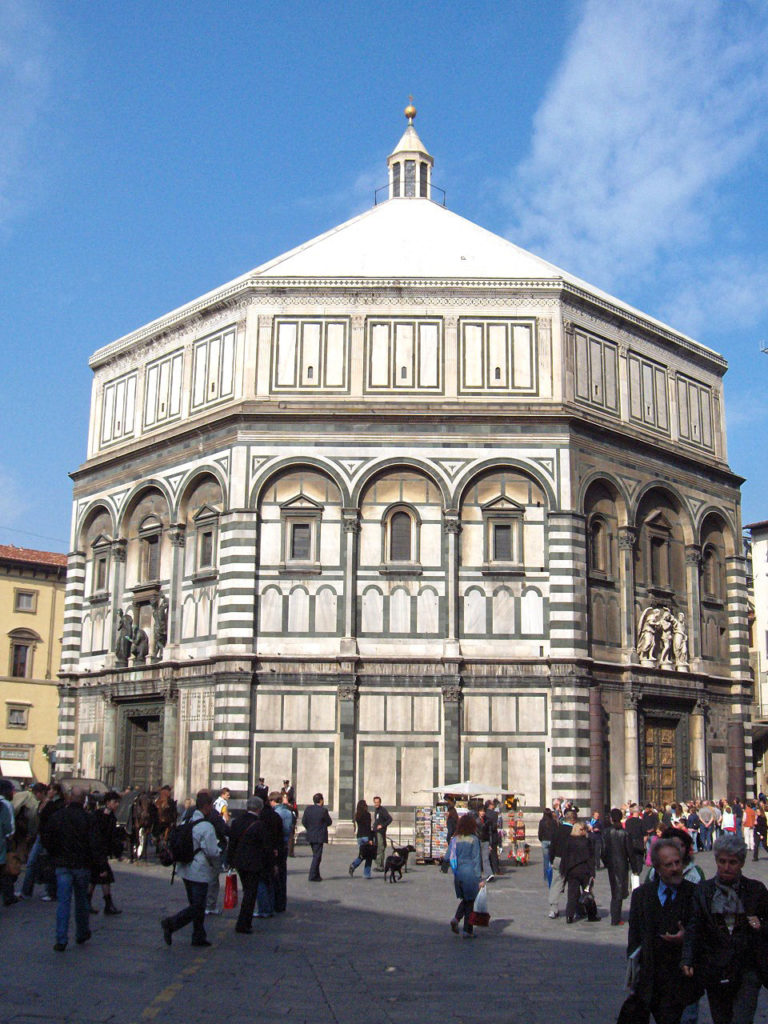
Historical context
The Baptistery, erected on what most Florentines thought to be the site of a Roman temple dedicated to the Roman God of Mars, is one of the oldest buildings in the city, constructed between 1059 and 1128 in the Florentine Romanesque style. The Italian poet Dante Alighieri and many other notable Renaissance figures, including members of the Medici family, were baptized in this baptistery.
During the Renaissance, in Florence, corporations and guilds competed for the leading role in design and construction of great projects with illustrious artistic creations.
While the Arte dei Lana (corporation of wool producers) financed the Works (Opera) of the Duomo and the construction of its cupola, the Arte dei Mercantoni di Calimala (the guild of merchants dealing in buying foreign cloth for finishing and export), took care of the Baptistery and financed the embellishment of its doors.
The Gates of Paradise
The Baptistry, an octagonal building, has four entrances (East, West, North and South) of which only three (South, North and East) have sets of artistically important bronze doors with relief sculptures. Three dates are key : 1329, 1401 and 1424.
- In 1329, the Calimala Guild, on Giotto‘s recommendation, ordered Andrea Pisano (1290-1348) to decorate a first set of doors (initialy installed as the East doors, i.e. seen when one leaves the Cathedral, but today South). These consist of 28 quatrefoil (clover-shaped) panels, with the 20 top panels depicting scenes from the life of St. John the Baptist (the patron of the edifice). The 8 lower panels depict the eight virtues of hope, faith, charity, humility, fortitude, temperance, justice, and prudence, praised by Plato in his Republic and represented during the XVIth century by the Flemish humanist painter and reader of Petrarch, Peter Brueghel the Elder. Construction took 8 years, from 1330 till 1338.

- In 1401, after having narrowly won the competition with Brunelleschi, the 23 year old and inexperienced young goldsmith Lorenzo Ghiberti (1378-1455), is commissioned by the Calima Guild to decorate the doors which are today the North Gate. Ghiberti cast the bronze high reliefs using a method known as lost-wax casting, a technique that he had to reinvent entirely since it was lost since the fall of the Roman Empire. One of the reasons Ghiberti won the contest, was that his technique was so advanced that it required 20 % less (7 kg per panel) bronze than that of his competitors, bronze being a dense material far more costly than marble. His technique, applied to the entire decoration of the North Gate, as compared to his competitors, would save some estimated 100 kg of bronze. And since in 1401, with the plague regularly hitting Florence, economic conditions were poor, even the wealthy Calimala took into account the total costs of the program.
The bronze doors are comprised of 28 panels, with 20 panels depicting the life of Christ from the New Testament. The 8 lower panels show the four Evangelists and the Church Fathers Saint Ambrose, Saint Jerome, Saint Gregory, and Saint Augustine. The construction took 24 years.

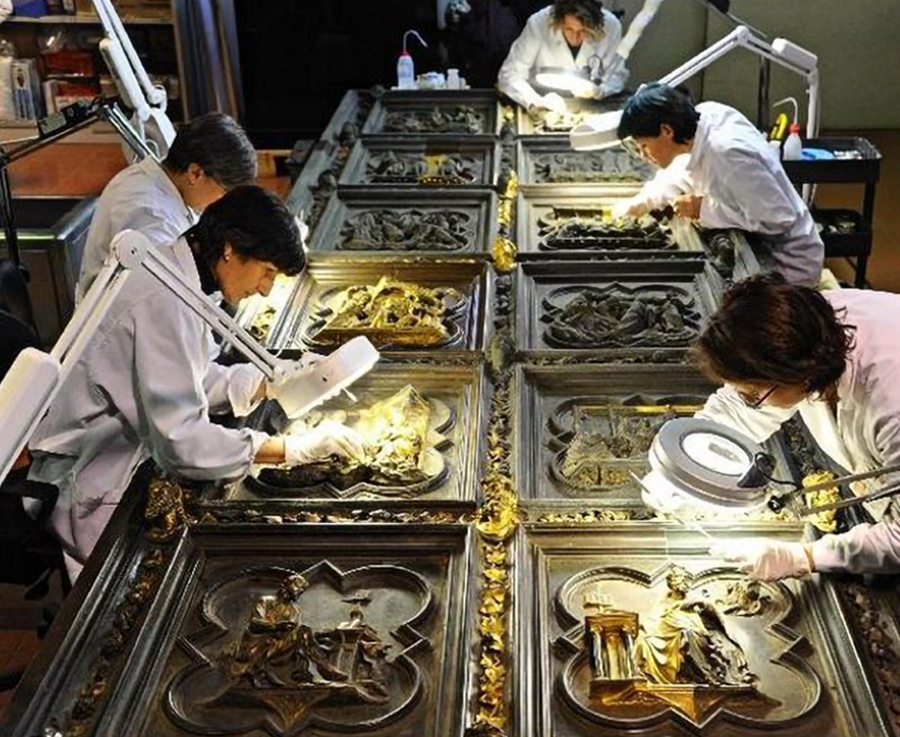
- In 1424, Ghiberti, at age 46, was given—unusually, with no competition—the task of also creating the East Gate. Only in 1452 did Ghiberti, then seventy-four years old, install the last bronze panels, since construction lasted this time 27 years! According to Giorgio Vasari (1511-1574), Michelangelo Buonarroti (1475-1564) later judged them « so beautiful they would grace the entrance to Paradise ».

Over two generations, a bevy of well paid assistants and pupils were trained by Ghiberti, including exceptional artists, such as Luca della Robbia, Donatello, Michelozzo, Benozzo Gozzoli, Bernardo Cennini, Paolo Uccello, Andrea del Verrocchio and Ghiberti’s sons, Vittore and Tommaso. And over time, the seventeen-foot-tall, three-ton bronze doors became an icon of the Renaissance, one of the most famous works of art in the world.
In 1880, the French sculptor Auguste Rodin was inspired by it for his own Gates of Hell on which he worked for 38 year
Revolution

Of utmost interest for our discussion here is the dramatic shift in conception and design of the bronze relief sculptures that occurred between the North and the East Gates, because it reflects how bot the artist as well as his patrons used the occasion to share with the broader public their newest ideas, inventions and exciting discoveries.
The themes of the North Gate of 1401 were inspired by scenes from the New Testament, except for the panel made by Ghiberti, « The Sacrifice of Isaac », which had won him the selection competition the same year. To complete the ensemble, it was therefore only logical that the East Gate of 1424 would take up the themes of the Old Testament.
Originally, it was the scholar and former chancellor of Florence Leonardo Bruni (1369-1444) who planned an iconography quite similar to the two previous doors. But, after heated discussions, his proposal was rejected for something radically new. Instead of realizing 28 panels, it was decided, for aesthetic reasons, to reduce the number of panels to only 10 much larger square reliefs, between borders containing statuettes in niches and medallions with busts.
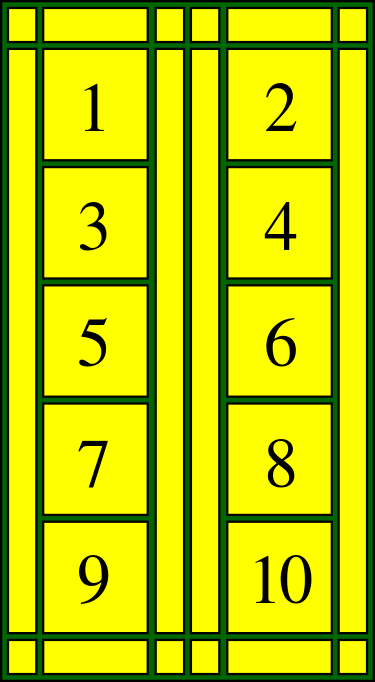
Hence, since each of the 10 chapters of the Old Testament contains several events, the total number of scenes illustrated, within the 10 panels has risen to 37 and all appear in perspective :
- Adam and Eve (The Creation of Man)
- Cain and Abel (Jalousie is the origin of Sin)
- Noah (God’s punishment)
- Abraham and Isaac (God is just)
- Jacob and Esau
- Joseph
- Moses
- Joshua
- David (Good commandor)
- Solomon and the Queen of Sheba
The general theme is that of salvation based on Latin and Greek patristic tradition. Very shocking for the time, Ghiberti places in the center of the first panel the creation of Eve, that of Adam appearing at the bottom left.
After the first three panels, focusing on the theme of sin, Ghiberti began to highlight more clearly the role of God the Savior and the foreshadowing of Christ’s coming. Subsequent panels are easier to understand. One example is the panel with Isaac, Jacob and Esau where the figures are merged with the surrounding landscape so that the eye is led toward the main scene represented in the top right.
Many of the sources for these scenes were written in ancient Greek, and since knowledge of Greek at that time was not so common, it appears that Ghiberti’s “theological advisor” was Ambrogio Traversari (1386-1439), with whom he had many exchanges.
Traversari was a close friend of Nicolas of Cusa (1401-1464), a protector of Piero della Francesca (1412-1492) and a key organizer of the Ecumenical Council of Florence of 1438-1439, which attempted to put an end to the schism separating the Church of the East from that of the West.
Perspective
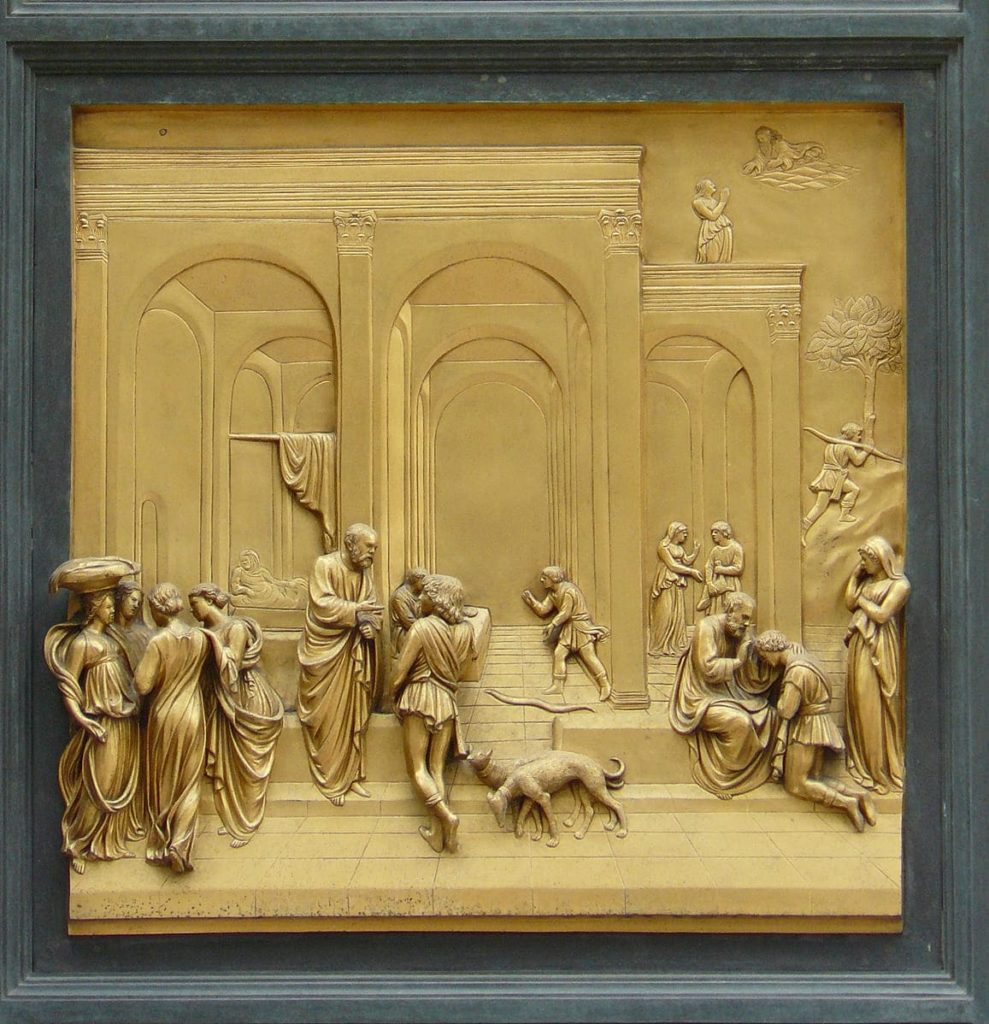
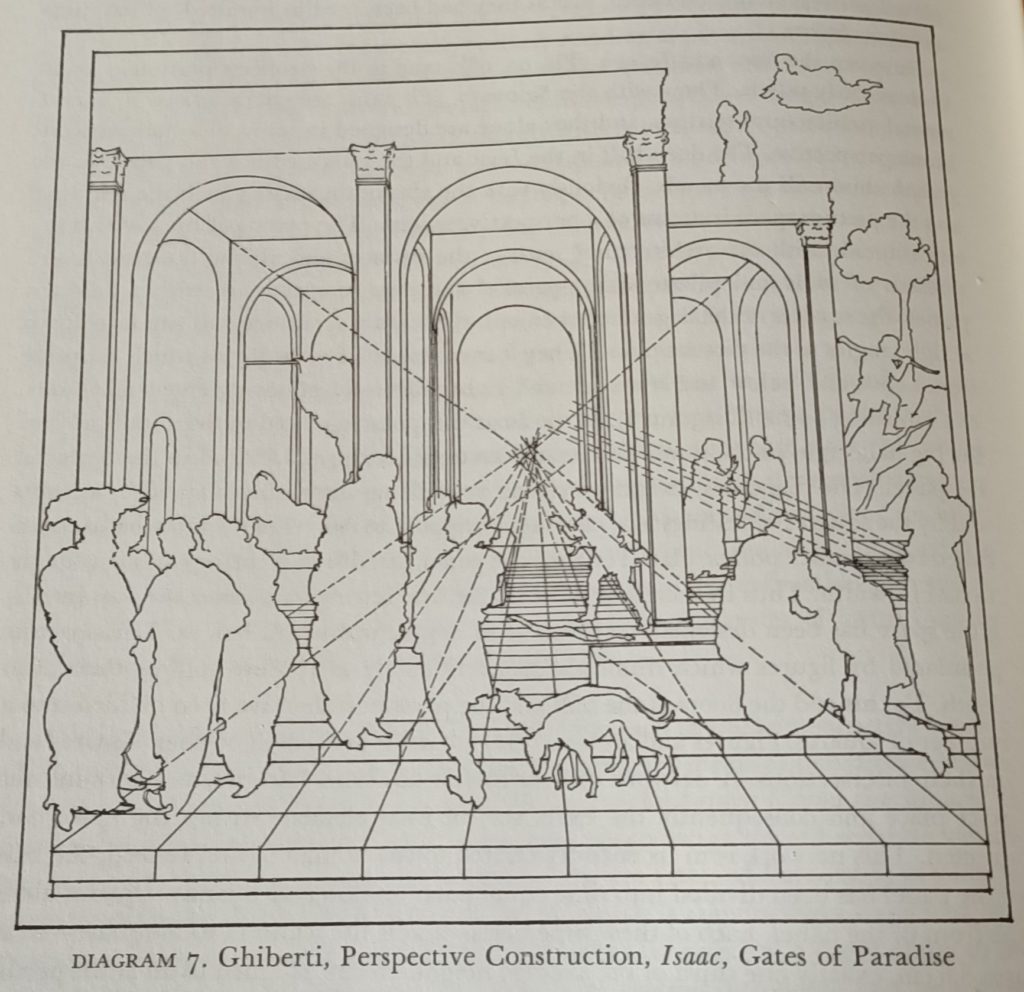
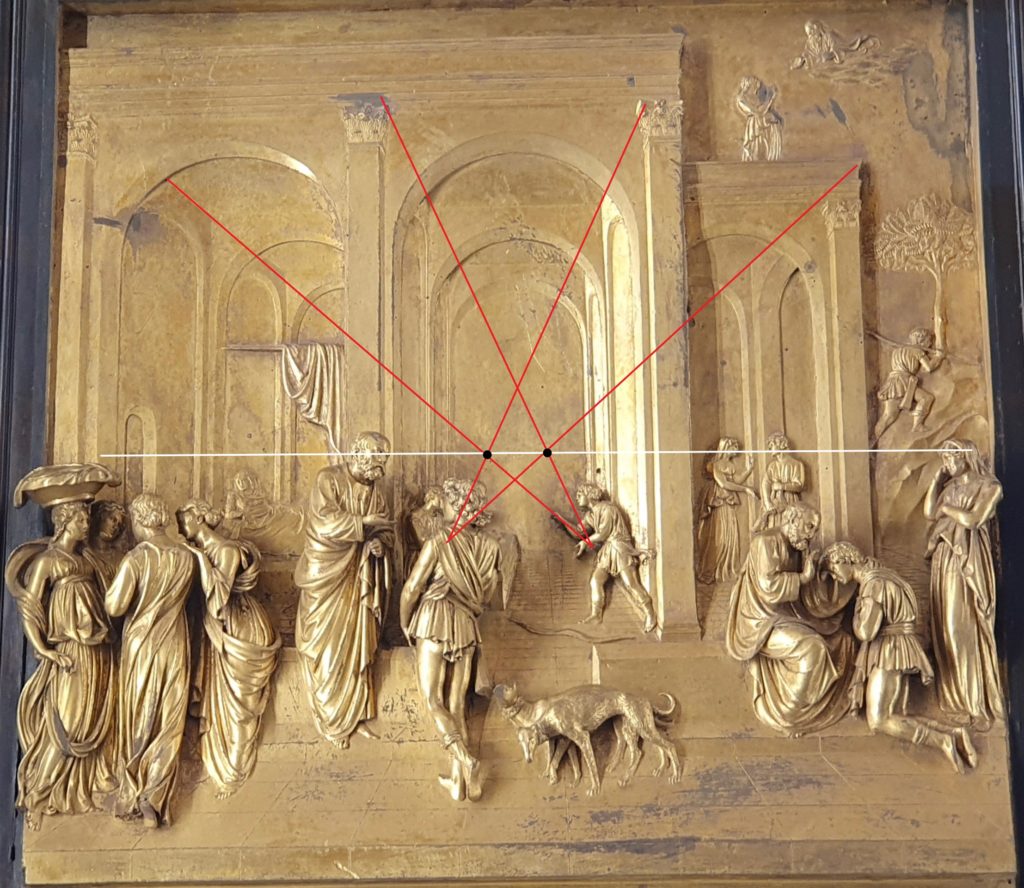
The bronze reliefs, known for their vivid illusion of deep space in relief, are one of the revolutionary events that epitomize the Renaissance. In the foreground are figures in high relief, which gradually become less protruding thereby exploiting the full illusionistic potential of the stiacciato technique later brought to its high point by Donatello. Using this form of “inbetweenness”, they integrate in one single image, what appears both as a painting, a low relief as well as a high relief. Or maybe one has to look at it another way: these are flat images traveling gradually from a surface into the full three dimensions of life, just as Ghiberti, in one of the first self-portraits of art history, reaches his head out of a bronze medal to look down on the viewers. The artist desired much more than perspective, he wanted breathing space!
This new approach will influence Leonardo Da Vinci (1452-1517). As art historian Daniel Arasse points out :
(…) It was in connection with the practice of Florentine bas-relief, that of Ghiberti at the Gate of Paradise (…) that Leonardo invented his way of painting. As Manuscript G (folio 23b) would much later state, ‘the field on which an object is painted is a capital thing in painting. (…) The painter’s aim is to make his figures appear to stand out from the field’ – and not, one might add, to base his art on the alleged transparency of that same field. It is by the science of shadow and light that the painter can obtain an effect of emergence from the field, an effect of relief, and not by that of the linear perspective.
Donatello
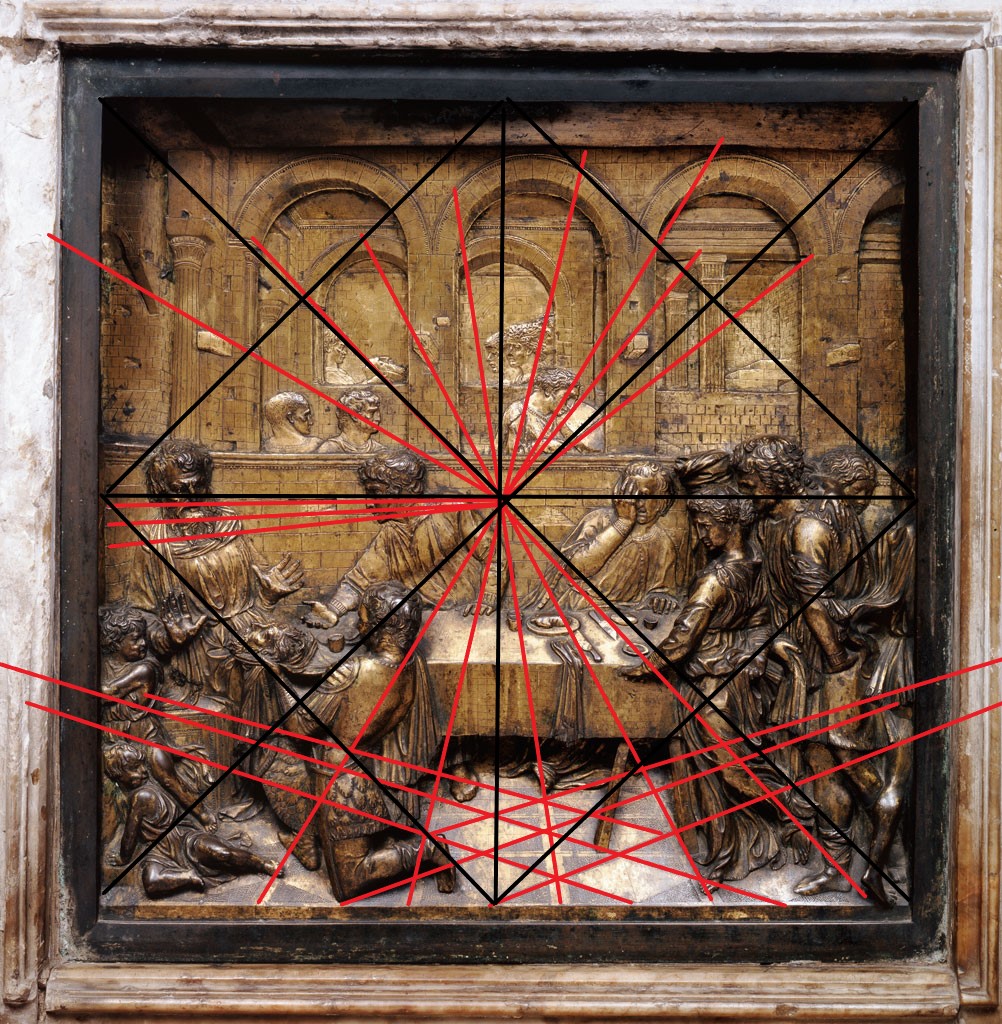
At the beginning of the 15th century, several theoretical approaches existed and eventuall contradicted each other. Around 1423-1427, the talentful sculptor Donatello, a young collaborator of Ghiberti, created his Herod’s Banquet, a bas-relief in the stiacciato technique for the baptismal font of the Siena Baptistery.
In this work, the sculptor deploys a harmonious perspective with a single central vanishing point. Around the same time, in Florence, the painter Massacchio (1401-1428) used a similar construction in his fresco The Trinity.
As we will see, Ghiberti, starting from the anatomy of the eye, opposed such an abstract approach in his works as well as in his writings and explored, as early as 1401, other geometrical models, called « binocular ». (see below).
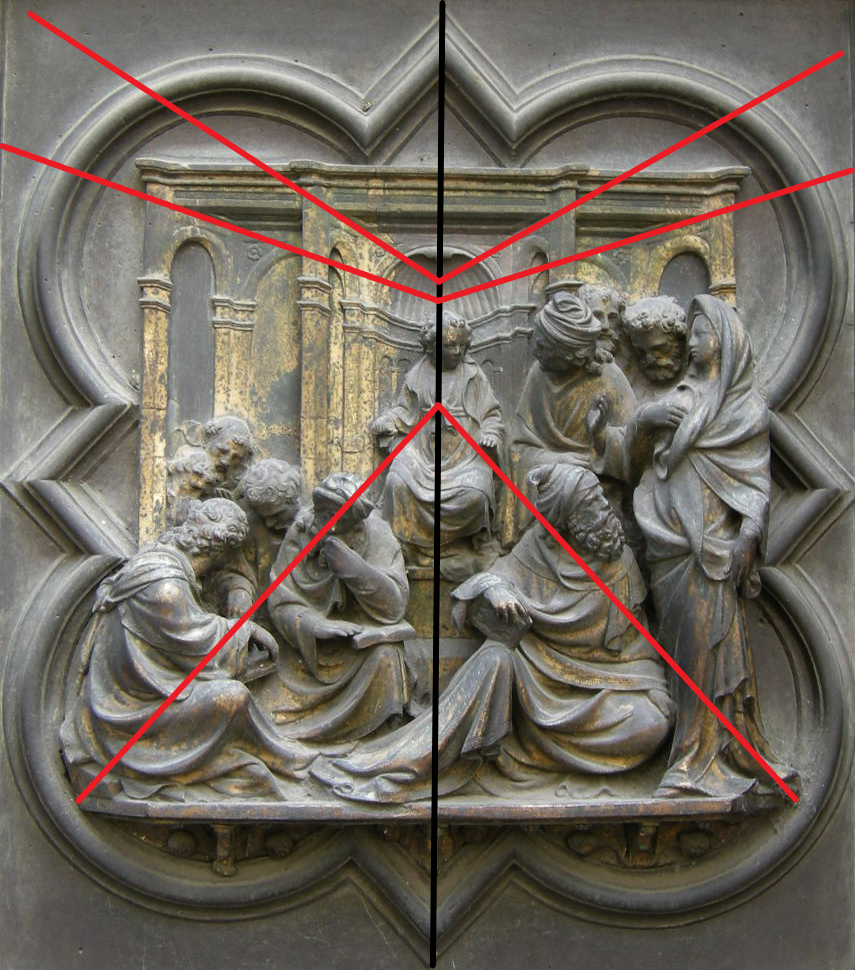
Christ among the Doctors, Ghiberti, before 1424.

Christ among the Doctors, Ghiberti, before 1424.
Then, as far as our knowledge reaches, in 1407, Brunelleschi had conducted several experiments on this question, most likely based on the ideas presented by another friend of Cusa, the Italian astronomer Paolo dal Pozzo Toscanelli (1397-1482), in the latter’s now lost treaty Della Prospettiva. What we do know is that Brunelleschi sought above all to demonstrate that all perspective is an optical illusion.
Finally, it was in 1435, that the humanist architect Leon Baptista Alberti (1406-1472), in his treatise Della Pictura, attempted, on the basis of Donatello’s approach, to theorize single vanishing point perspective as a representation of a harmonious and unified three-dimensional space on a flat surface. Noteworthy but frustrating for us today is the fact that Alberti’s treatise doesn’t contain any illustrations.
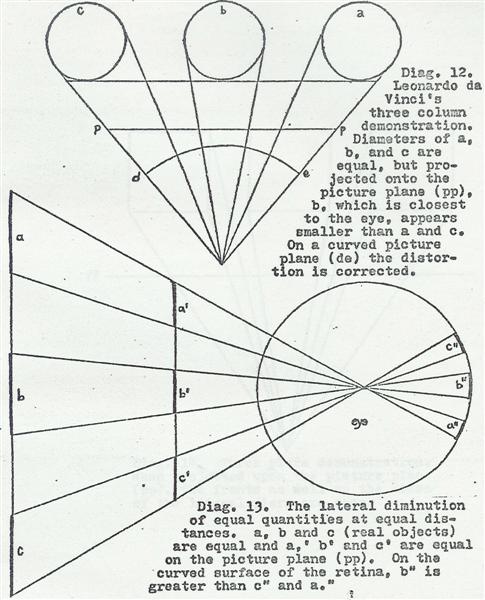
However, Leonardo, who read and studied Ghiberti’s writings on, would use the latter’s arguments to indicate the limits and even demonstrate the dysfunctionality of Alberti’s “perfect” perspective construction especially when one goes beyond a 30 degres angle.
In the Codex Madrid, II, 15 v. da Vinci realizes that « as such, the perspective offered by a rectilinear wall is false unless it is corrected (…) ».
Perspectiva artificialis versus perspectiva naturalis
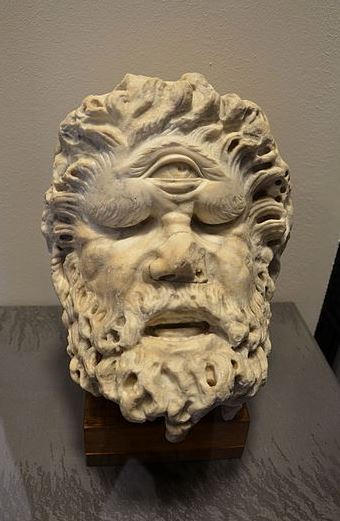
Alberti’s “perspectiva artificialis” is nothing but an abstraction, necessary and useful to represent a rational organization of space. Without this abstraction, it is fairly impossible to define with mathematical precision the relationships between the appearance of objects and the receding of their various proportions on a flat screen: width, height and depth.
From the moment that a given image on a flat screen was thought about as the intersection of a plane cutting a cone or pyramid, a method emerged for what was mistakenly considered as an “objective” representation of “real” three dimensional space, though it is nothing but an “anamorphosis”, i.e. a tromp-l’oeil or visual illusion.
What has to be underscored, is that this construction does away with the physical reality of human existence since it is based on an abstract construct pretending:
- that man is a single eyed cyclops;
- that vision emanates from one single point, the apex of the visual pyramid;
- that the eye is immobile;
- that the image is projected on a flat screen rather than on a curved retina.
Slanders and gossip
The crucial role of Ghiberti, an artist which “Ghiberti expert” Richard Krautheimer mistakenly presents as a follower of Alberti’s perspectiva artificialis, has been either ignored or downplayed.
Ghiberti’s unique manuscript, the three volumes of the Commentarii, which include his autobiography and which established him as the first modern historian of the fine arts, is not even fully translated into English or French and was only published in Italian in 1998.
Today, because of his attention to minute detail and figures « sculpted » with wavy and elegant lines, as well as the variety of plants and animals depicted, Ghiberti is generally presented as “Gothic-minded”, and therefore “not really” a Renaissance artist!
Giorgio Vasari, often acting as the paid PR man of the Medici clan, slanders Ghiberti by saying he wrote « a work in the vernacular in which he treated many different topics but arranged them in such a fashion that little can be gained from reading it. »
Admittedly, tension among humanists, was not uncommon. Self-educated craftsmen, such as Ghiberti and Brunelleschi on the one side, and heirs of wealthy wool merchants, such as Niccoli on the other side, came from entirely different worlds. For example, according to a story told by Guarino Veronese in 1413, Niccoli greeted Filippo Brunelleschi haughtily: « O philosopher without books, » to which Filippo replied with his legendary irony: « O books without philosopher ».
For sure, the Commentarii, are not written according to the rhetorical rules of those days. Written at the end of Ghiberti’s life, they may have simply been dictated to a poorly trained clerk who made dozens of spelling errors.
The humanists
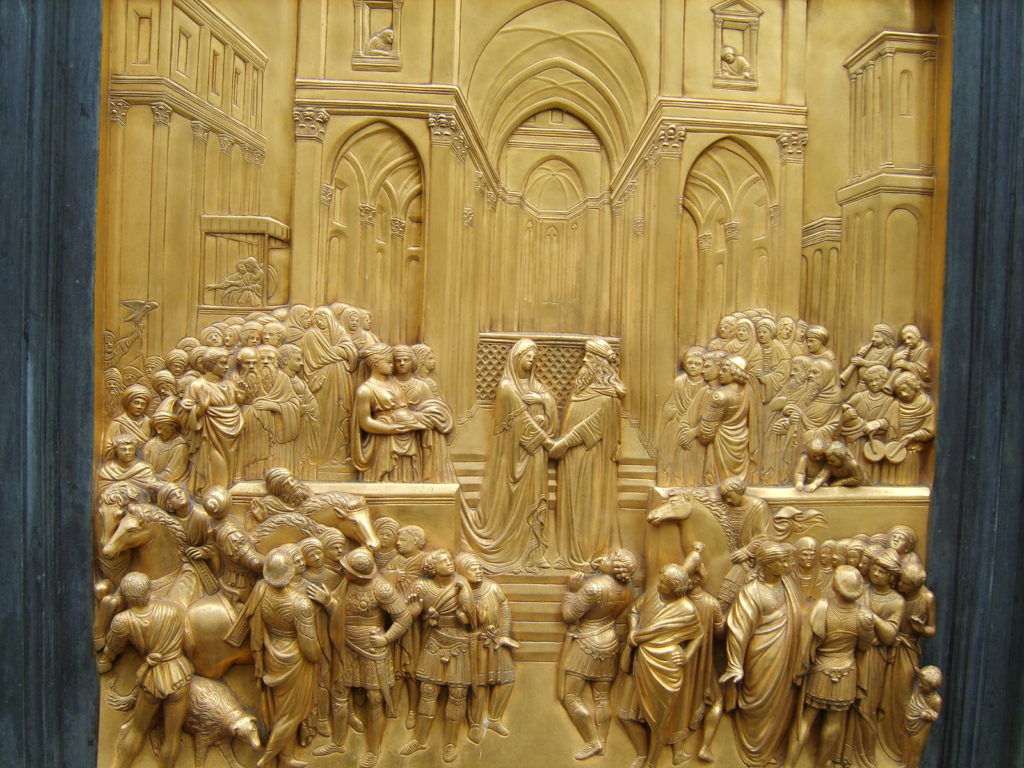
The Commentarii does reveal a highly educated author and a thinker having profound knowledge of many classical Greek and Arab thinkers. Ghiberti was not just some brilliant handcraft artisan but a typical “Renaissance man”.
In dialogue with Bruni, Traversari and the “manuscript hunter” Niccolo Niccoli, Ghiberti, who couldn’t read Greek but definitely knew Latin, was clearly familiar with the rediscovery of Greek and Arab science, a task undertaken by Boccaccio’s and Salutati’s “San Spirito Circle” whose guests (including Bruni, Traversari, Cusa, Niccoli, Cosimo di Medici, etc.) later would convene every week at the Santa Maria degli Angeli convent. Ghiberti exchanges moreover with Giovanni Aurispa, a collaborator of Traversari who brought back from Byzantium, years before Bessarion, the whole of Plato’s works to the West.
Amy R. Bloch, in her well researched study Lorenzo Ghiberti’s Gates of Paradise, Humanism, History, and Artistic Philosophy in the Italian Renaissance (2016), writes that « Traverari and Niccoli can be tied directly to the origins of the project for the Gates and were clearly interested in sculptural commissions being planned for the Baptistery. On June 21, 1424, after the Calima requested from Bruni his program for the doors, Traversari wrote to Niccoli acknowledging, in only general terms, Niccoli’s ideas for the stories to be included and mentioning, without evident disapproval, that the guild had instead turned to Bruni for advice. »
Palla Strozzi
Ghiberti’s patron, sometimes advisor, and close associate was Palla Strozzi (1372-1462), who, besides being the the richest man in Florence with a gross taxable assets of 162,925 florins in 1427, including 54 farms, 30 houses, a banking firm with a capital of 45,000 florins, and communal bonds, was also a politician, a writer, a philosopher and a philologist whose library contained close to 370 volumes in 1462.
Just as Traversari and Bruni, Strozzi learned Latin and studied Greek under the direction of the Byzantine scholar Manuel Chrysoloras, invited to Florence by Salutati.
Ghiberti’s close relationship with Strozzi, writes Bloch, « gave him access to his manuscripts and, as importantly, to Strozzi’s knowledge of them. »
But there was more. « The relationship between Ghiberti and Palla Strozzi was so close that, when Palla went to Venice in 1424 as one of two Florentine ambassadors charged with negociating an alliance with the Venetians, Ghiberti accompanied him in his retinue. »
Strozzi was known as a real humanist, always looking to preserve peace while strongly opposing oligarchical rule, both in Florence as in Venice.
In fact it was Palla Strozzi, not Cosimo de’ Medici, who first set in motion plans for the first public library in Florence, and he intended for the sacristy of Santa Trinita to serve as its entryway. While Palla’s library was never realized due to the dramatic political conflict knows as the Albizzi Coup that led to his exile in 1434, Cosimo who got a free hand to rule over Florence, would make the library project his own.
A bold statement
Ghiberti begins the Commentarii with a bold and daring statement for a Christian man in a Christian world, about how the art of antiquity came to be lost:
The Christian faith was victorious in the time of Emperor Constantine and Pope Sylvester. Idolatry was persecuted to such an extent that all the statues and pictures of such nobility, antiquity an perfection were destroyed and broken in to pieces. And with the statues and pictures, the theoretical writings, the commentaries, the drawing and the rules for teaching such eminent and noble arts were destroyed.

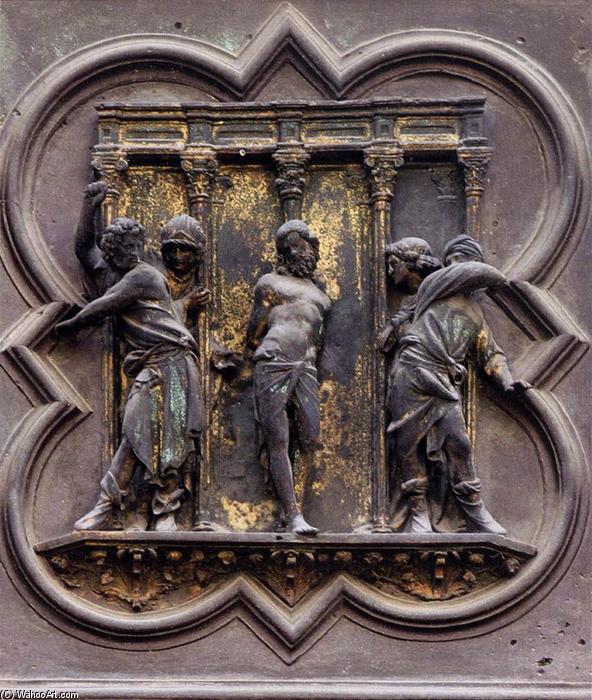
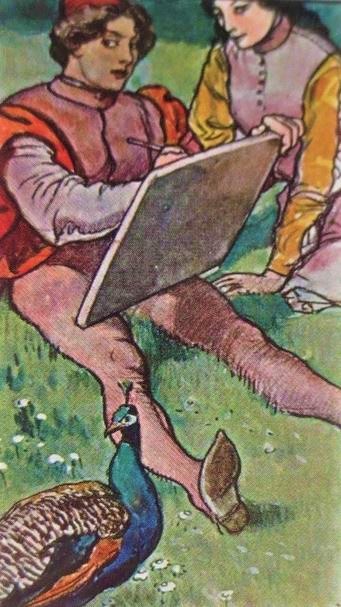
Ghiberti understood the importance of multidisciplinarity for artists. According to him, “sculpture and painting are sciences of several disciplines nourished by different teachings”.
In book I of his Commentarii, Ghiberti gives a list of the 10 liberal arts that the sculptor and the painter should master : philosophy, history, grammar, arithmic, astronomy, geometry, perspective, theory of drawing, anatomy and medecine and underlines that the necessity for an artist to assist at anatomical dissections.
As Amy Bloch underscores, while working on the Gates, in the intense process of visualizing the stories of God’s formation of the world and its living inhabitants, Ghiberti’s engagement « stimulated in him an interest in exploring all types of creativity — not only that of God, but also that of nature and of humans — and led him to present in the opening panel of the Gates of Paradise (The creation of Adam and Eve) a grand vision of the emergence of divine, natural, and artistic creation. »

The inclusion of details evoking God’s craftmanship, says Bloch, « recalls similes that liken God, as the maker of the world, to an architect, or, in his role as creator of Adam, to a sculptor or painter. Teh comparison, which ultimately derives from the architect-demiurge who creates the world in Plato’s Timaeus, appears commonly in medieval Jewish and Christian exegesis. »
Philo of Alexandria wrote that man was modeled « as by a potter » and Ambrose metaphorically called God a « craftsman (artifex) and a painter (pictor) ». Consequently, if man is « the image of God » as says Augustine and the model of the « homo faber – man producer of things », then, according to Salutati, « human affairs have a similarity to divine ones ».
The power of vision and the composition of the Eye
Concerning vision, Ghiberti writes:
I, O most excellent reader, did not have to obey to money, but gave myself to the study of art, which since my childhood I have always pursued with great zeal and devotion. In order to master the basic principles I have sought to investigate the way nature functions in art; and in order that I might be able to approach her, how images come to the eye, how the power of vision functions, how visual [images] come, and in what way the theory of sculpture and painting should be established.
Now, any serious scholar, having worked through Leonardo’s Notebooks, who then reads Ghiberti’s I Commentarii, immediately realizes that most of Da Vinci’s writings were basically comments and contributions about things said or answers to issues raised by Ghiberti, especially respecting the nature of light and optics in general. Leonardo’s creative mindset was a direct outgrowth of Ghiberti’s challenging world outlook.
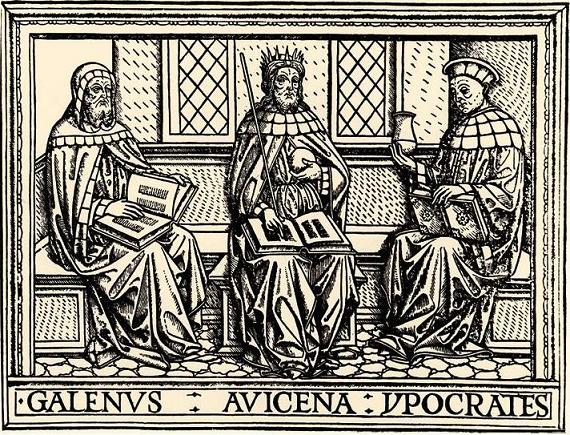
In Commentario 3, 6, which deals with optics, vision and perspective, Ghiberti, opposing those for whom vision can only be explained by a purely mathematical abstraction, writes that “In order that no doubt remains in the things that follow, it is necessary to consider the composition of the eye, because without this one cannot know anything about the way of seeing.” He then says, that those who write about perspective don’t take into account “the eye’s composition”, under the pretext that many authors would disagree.
Ghiberti regrets that despite the fact that many “natural philosophers” such as Thales, Democritus, Anaxagoras and Xenophanes have examined the subject along with others devoted to human health such as “Hippocrates, Galen and Avicenna”, there is still so much confusion.
Indeed, he says, “speaking about this matter is obscure and not understood, if one does not have recourse to the laws of nature, because more fully and more copiously they demonstrate this matter.”
Avicenna, Alhazen and Constantine


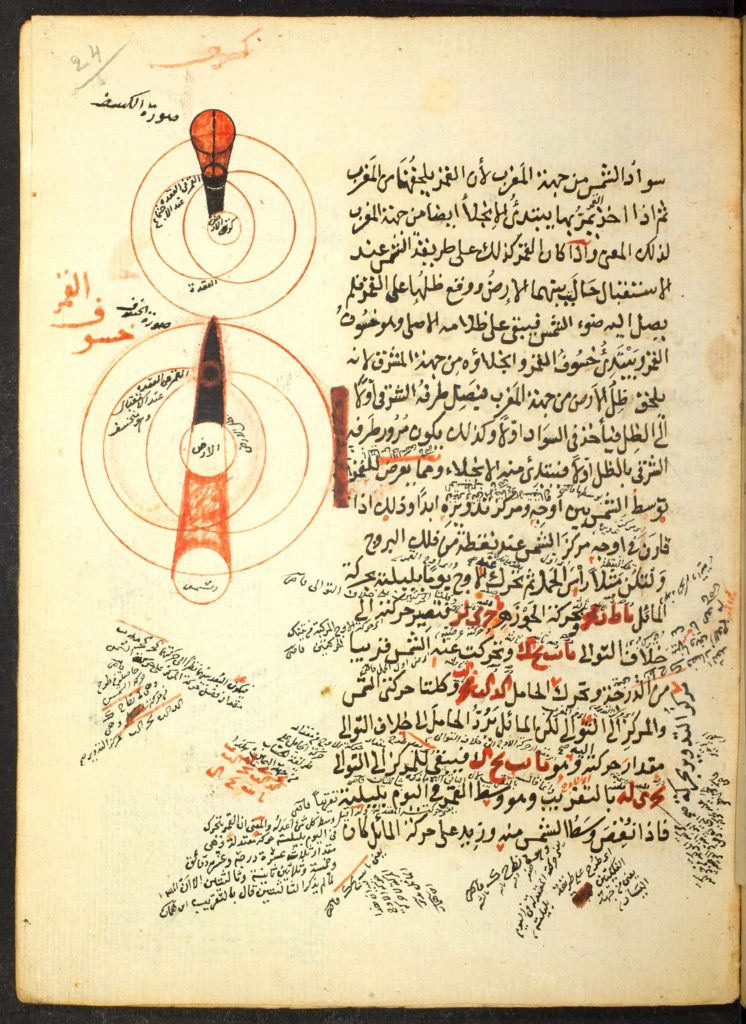
Therefore, says Ghiberti:
it is necessary to affirm some things that are not included in the perspective model, because it is very difficult to ascertain these things but I will try to clarify them. In order not to deal superficially with the principles that underlie all of this, I will deal with the composition of the eye according to the writings of three authors, Avicenna (Ibn Sina), in his books, Alhazen (Ibn al Haytham) in his first volume on perspective (Optics), and Constantine (the Latin name of the Arab scholar and physician Qusta ibn Luqa) in his ‘First book on the Eye’; for these authors suffice and deal with much certainty in these subjects that are of interest to us.
This is quite a statement! Here we have “the” leading, founding figure of the Italian and European Renaissance with its great contribution of perspective, saying that to get any idea about how vision functions, one has to study three Arab scientists: Ibn Sina, Ibn al Haytham and Qusta ibn Luqa ! Cultural Eurocentrism might be one reason why Ghiberti’s writings were kept in the dark.
Ibn al-Haytham (Alhazen) made important contributions to opthalmology and improved upon earlier conceptions of the processes involved in vision and visual perception in his Treatise on Optics (1021), which is known in Europe as the Opticae Thesaurus. Following his work on the camera oscura (darkroom) he was also the first to imagine that the retina (a curved surface), and not the pupil (a point) could be involved in the process of image formation.
Avicenna, in the Canon of Medicine (ca. 1025), describes sight and uses the word retina (from the Latin word rete meaning network) to designate the organ of vision.
Later, in his Colliget (medical encyclopedia), Ibn Rushd (Averroes, 1126-1198) was the first to attribute to the retina the properties of a photoreceptor.
Avicenna’s writings on anatomy and medical science were translated and circulating in Europe since the XIIIth century, Alhazen’s treatise on optics, which Ghiberti quotes extensively, had just been translated into Italian under the title De li Aspecti.
It is now recognized that Andrea del Verrocchio, whose best known pupil was Leonardo da Vinci (1452-1517) was himself one of Ghiberti’s pupils. Unlike Ghiberti, who mastered Latin, neither Verrocchio nor Leonardo mastered a foreign language.
What is known is that while studying Ghiberti’s Commentarii, Leonardo had access in Italian to a series of original quotations from the Roman architect Vitruvius and from Arab scientists such as Avicenna, Alhazen, Averroes and from those European scientists who studied Arab optics, notably the Oxford Fransciscans Roger Bacon (1214-1294), John Pecham (1230-1292) and the Polish monk working in Padua, Erazmus Ciolek Witelo (1230-1275), known by his Latin name Vitellion.
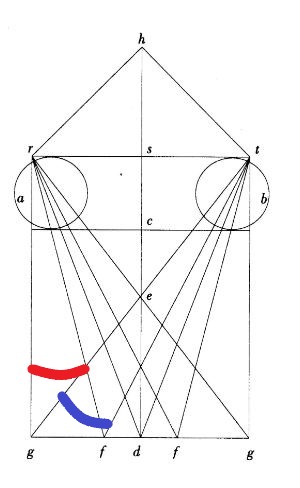
As stressed by Professor Dominque Raynaud, Vitellion introduces the principle of binocular vision for geometric considerations.
He gives a figure where we see the two eyes (a, b) receiving the images of points located at equal distance from the hd axis.
He explains that the images received by the eyes are different, since, taken from the same side, the angle grf (in red) is larger than the angle gtf (in blue). It is necessary that these two images are united at a certain point in one image (Diagram).
Where does this junction occur? Witelo says: « The two forms, which penetrate in two homologous points of the surface of the two eyes, arrive at the same point of the concavity of the common nerve, and are superimposed in this point to become one ».
The fusion of the images is thus a product of the internal mental and nervous activity.
The great astronomer Johannes Kepler (1571-1630) will use Alhazen’s and Witelo’s discoveries to develop his own contribution to optics and perspective. “Although up to now the [visual] image has been [understood as] a construct of reason,” Kepler observes in the fifth chapter of his Ad Vitellionem Paralipomena (1604), “henceforth the representations of objects should be considered as paintings that are actually projected on paper or some other screen.” Kepler was the first to observe that our retina captures an image in an inverted form before our brain turns it right side up.
Out of this Ghiberti, Uccello and also the Flemish painter Jan Van Eyck, in contact with the Italians, will construct as an alternative to one cyclopic single eye perspective revolutionary forms of “binocular” perspective while Leonardo and Louis XI’ court painter Jean Fouquet will attempt to develop curvilinear and spherical space representations.
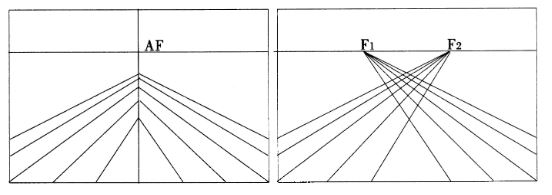
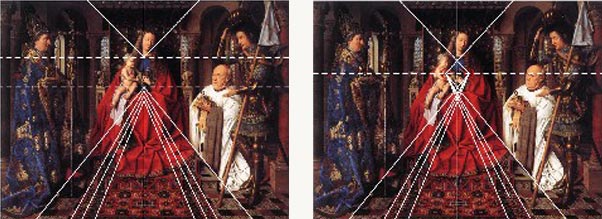


In China, eventually influenced by Arab optical science breakthrough’s, forms of non-linear perspective, that integrate the mobility of the eye, will also make their appearance during the Song Dynasty.
Light
Ghiberti will add another dimension to perspective: light. One major contribution of Alhazen was his affirmation, in his Book of Optics, that opaque objects struck with light become luminous bodies themselves and can radiate secondary light, a theory that Leonardo will exploit in his paintings, including in his portraits.
Already Ghiberti, in the way he treats the subject of Isaac, Jacob and Esau (Figure), gives us an astonishing demonstration of how one can exploit that physical principle theorized by Alhazen. The light reflected by the bronze panel, will strongly differ according to the angle of incidence of the arriving rays of light. Arriving either from the left of from the right side, in both cases, the Ghiberti’s bronze relief has been modeled in such a way that it magnificently strengthens the overall depth effect !

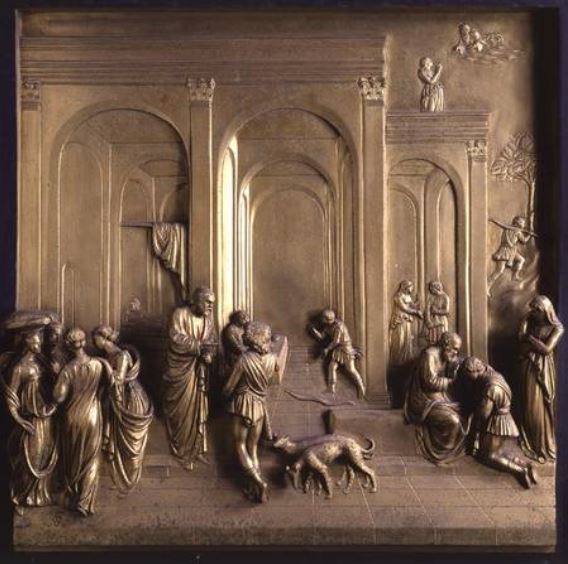
While the experts, especially the neo-Kantians such as Erwin Panofsky or Hans Belting, say that these artists were “primitives” because applying the “wrong” perspective model, they can’t grasp the fact that they were in reality exploring a far “higher domain” than the mere pure mathematical abstraction promoted by the Newton-Galileo cult that became the modern priesthood ruling over “science”.
Much more about all of this can and should be said. Today, the best way to pay off the European debt to “Arab” scientific contributions, is to reward not just the Arab world but all future generations with a better future by opening to them the “Gates of Paradise”.
See all of Ghiberti’s works at the WEB GALLERY OF ART
Short Biography
- Arasse, Daniel, Léonard de Vinci, Hazan, 2011;
- Avery, Charles, La sculpture florentine de la Renaissance, Livre de poche, 1996, Paris;
- Belting, Hans, Florence & Baghdad, Renaissance art and Arab science, Harvard University Press, 2011;
- Bloch, Amy R., Lorenzo Ghiberti’s Gates of Paradise; Humanism, History and Artistic Philosophy in the Italian Renaissance, Cambridge University Press, 2016, New York;
- Borso, Franco et Stefano, Uccello, Hazan, Paris, 2004 ;
- Butterfield, Andrew, Verrocchio, Sculptor and painter of Renaissance Florence, National Gallery, Princeton University Press, 2020 ;
- Butterfield, Andrew, Art and Innovation in Ghiberti’s Gates of Paradise, High Museum of Art, Yale University Press, 2007;
- Kepler, Johannes, Paralipomènes à Vitellion, 1604, Vrin, 1980, Paris;
- Krautheimer, Richard and Trude, Lorenzo Ghiberti, Princeton University Press, New Jersey, 1990;
- Martens, Maximiliaan, La révolution optique de Jan van Eyck, dans Van Eyck, Une révolution optique, Hannibal – MSK Gent, 2020.
- Pope-Hennessy, John, Donatello, Abbeville Press, 1993 ;
- Radke, Gary M., Lorenzo Ghiberti: Master Collaborator; The Gates of Paradise, Lorenzo Ghiberti’s Renaissance Masterpiece, High Museum of Atlanta and Yale University Press, 2007;
- Rashed, Roshi, Geometric Optics, in History of Arab Sciences, edited by Roshdi Rashed, Vol. 2, Mathematics and physics, Seuil, Paris, 1997.
- Raynaud, Dominique, L’hypothèse d’Oxford, essai sur les origines de la perspective, PUF, 1998, Paris.
- Raynaud, Dominique, Ibn al-Haytham on binocular vision: a precursor of physiological optics, Arabic Sciences and Philosophy, Cambridge University Press (CUP), 2003, 13, pp. 79-99.
- Raynaud, Dominique, Perspective curviligne et vision binoculaire. Sciences et techniques en perspective, Université de Nantes, Equipe de recherche: Sciences, Techniques, et Sociétés, 1998, 2 (1), pp.3-23.;
- Vereycken, Karel, interview with People’s Daily: Leonardo Da Vinci’s « Mona Lisa » resonates with time and space with traditional Chinese painting, 2019.
- Vereycken, Karel, Uccello, Donatello, Verrocchio and the art of military command, 2022.
- Vereycken, Karel, The Invention of Perspective, Fidelio, 1998.
- Vereycken, Karel, Van Eyck, un peintre flamand dans l’optique arabe, 1998.
- Vereycken, Karel, Mutazilism and Arab astronomy, two bright stars in our firmament, 2021.
- Walker, Paul Robert, The Feud That Sparked the Renaissance, How Brunelleschi and Ghiberti changed the World, HarperCollins, 2002.
Argenteuil, conservatoire de musique
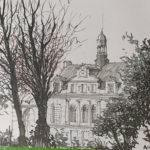
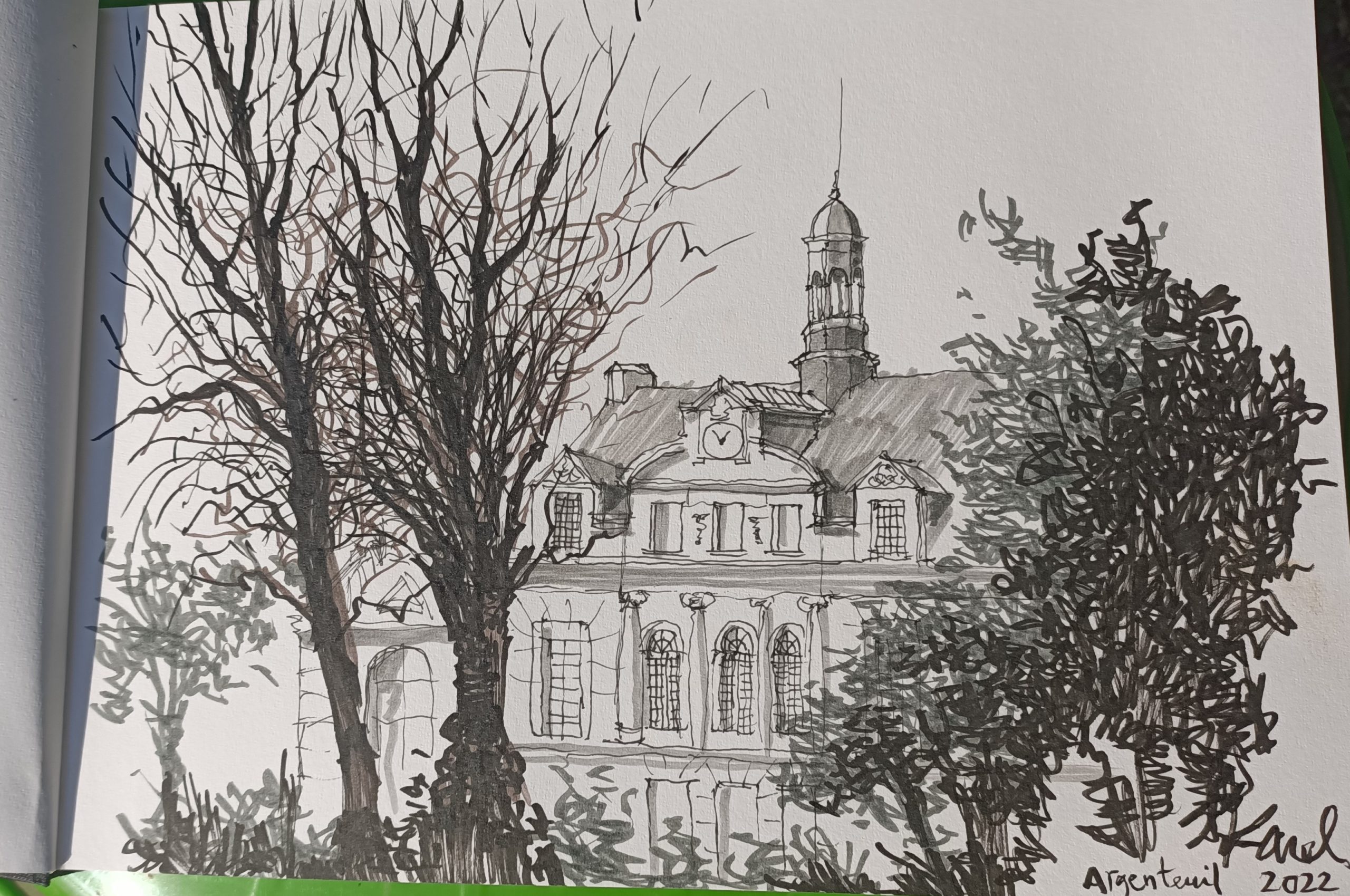
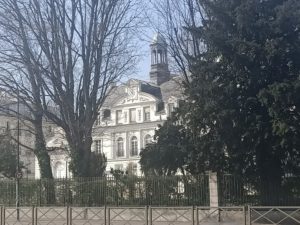
La paix de Westphalie, une réorganisation financière mondiale
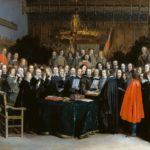
par Karel Vereycken, Paris, France.
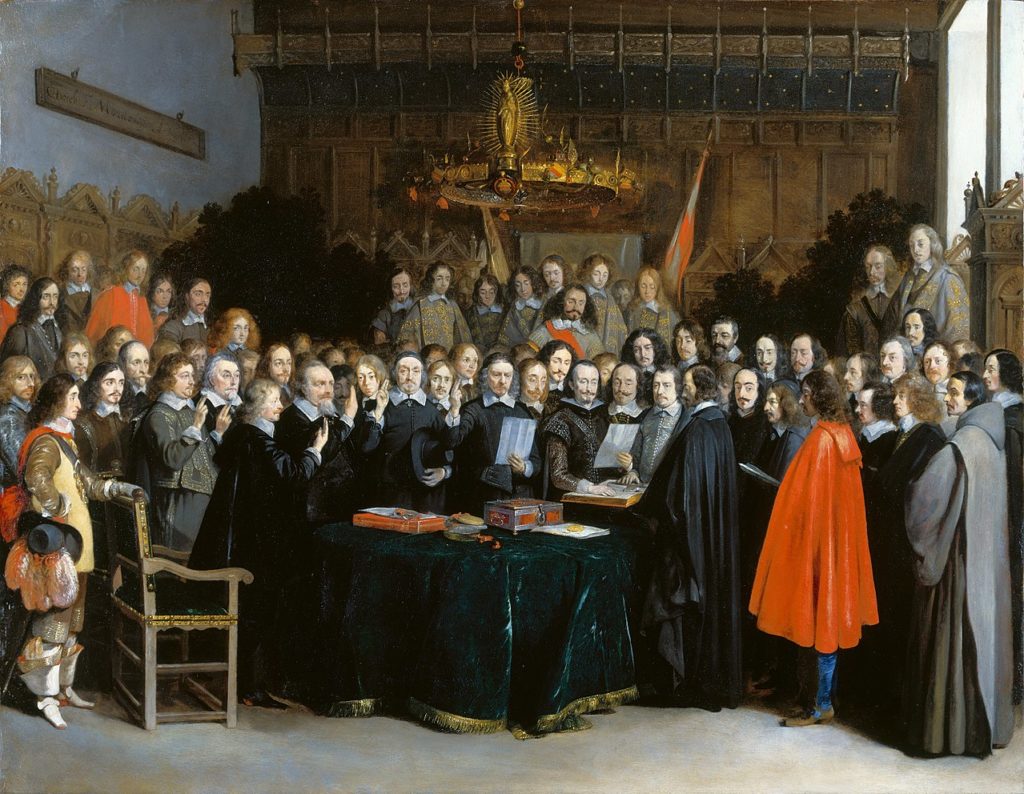
En 1648, après cinq ans de négociations, conduites notamment par le diplomate français Abel Servien sur les instructions du Cardinal Mazarin, était signée la « Paix de Westphalie » mettant fin à la guerre de Trente Ans. Bien avant la charte de l’ONU, 1648 fera de la souveraineté nationale, du respect mutuel et du principe de non-ingérence les fondements du droit international. La République des Pays-Bas et la Confédération helvétique sont reconnues et de nombreux traités bilatéraux de paix mettent fin aux conflits.
Mais ce n’est pas tout. Un lecteur attentif de ces traités de paix découvre que l’engagement de chacune des parties, qui consiste à prendre en considération « l’avantage d’autrui » autant, sinon plus, que le sien, se traduit par des actes concrets jetant les bases d’un nouvel ordre financier et économique international.
L’article 1 énonce le principe philosophique fondamental sur lequel repose la paix :
Qu’il y ait une paix chrétienne et universelle, et une amitié perpétuelle, vraie et sincère, entre [liste des parties renonçant au combat] ; et que cette paix et cette amitié soient observées et promues avec une telle sincérité et un tel zèle, que chaque partie s’efforce de procurer le bénéfice, l’honneur et l’avantage d’autrui ; et qu’ainsi, de tous côtés, ils puissent voir cette paix et cette amitié dans l’Empire romain, et le Royaume de France prospérer, en entretenant un bon et fidèle voisinage.
L’article 2 décrit ensuite le type de « réinitialisation » dont nous avons si urgemment besoin aujourd’hui :
Il y aura d’un côté et de l’autre un oubli, une amnistie ou un pardon perpétuel de tout ce qui a été commis depuis le début de ces troubles, en quelque lieu ou de quelque manière que les hostilités aient été pratiquées, de telle sorte qu’aucun acteur, sous quelque prétexte que ce soit, ne puisse pratiquer aucun acte d’hostilité, entretenir aucune inimitié ou causer aucun trouble ; (…) tout ce qui s’est passé d’un côté et de l’autre, aussi bien avant que pendant la guerre, en paroles, écrits et actions outrageantes, en violences, hostilités, dommages et dépenses, sans aucun respect pour les personnes ou les choses, sera entièrement aboli de telle sorte que tout ce qui pourrait être exigé ou prétendu par l’un et l’autre à ce sujet sera enseveli dans un oubli éternel.
Pendant des décennies, la plupart des belligérants de la guerre de Trente Ans se sont mutuellement infligés des dommages inouïs, essentiellement pour pouvoir rembourser leurs dettes avec le butin de leurs pillages et de leurs conquêtes, afin de satisfaire une minuscule oligarchie financière qui prêtait aussi généreusement aux uns qu’aux autres. C’est cet asservissement par la dette que le traité propose d’« ensevelir dans un oubli éternel ».
Ainsi, avant même de régler les disputes et les revendications territoriales, le traité s’attelle à créer les conditions mettant fin à la ruine financière dans laquelle tous se trouvaient plongés.
Les dettes, intérêts, obligations, rentes et créances financières impayables, insoutenables et illégitimes, explicitement identifiés comme alimentant une dynamique de guerre perpétuelle, sont examinés, triés et réorganisés, le plus souvent par l’annulation des dettes (articles 13 et 35, 37, 38 et 39), par des moratoires ou un rééchelonnement selon des échéanciers précis (article 69).
L’article 40 conclut que ces annulations s’appliqueront « à la réserve toutefois des sommes de deniers, qui durant la guerre ont été fournies de bon cœur et à bonne intention pour d’autres, afin de détourner les plus grands périls et dommages dont ils étoient menacez. » (Impliquant que ces dettes devront être honorées.)
Enfin, regardant vers l’avenir et pour faire en sorte que « le commerce refleurisse », le traité abolit de nombreux péages et octrois « inusités » et « privés », obstacles aux échanges des biens physiques et des savoirs-faire et donc du développement mutuel. (Art. 69).
Dans le texte :
- Art. 13 : « Le Seigneur Électeur de Bavière renoncera entièrement pour lui, ses héritiers et successeurs à la dette de treize millions, et à toute prétention sur la haute Autriche, et incontinent après la publication de la paix donnera à sa Majesté Impériale les actes obtenus sur cela pour être cassez et annullez. »
- Art. 35 : « La pension annuelle que le bas Marquisat avoit accoutumé de payer au haut Marquisat, soit en vertu du présent Traité entièrement supprimée, abolie et annullée, sans que doresnavant on puisse prétendre ou exiger pour ce sujet aucune chose, ni pour le passé, ni pour l’avenir. »
- Art. 37 : « Que les contracts, échanges, transactions, obligations, et promesses illicitement extorquez par force ou par menaces des États ou des sujets, (…) comme aussi les actions rachetées et cédées soient abolies et annullées ; en sorte qu’il ne sera permis à personne d’intenter aucun procès ou actions pour ce sujet. »
- Art. 38 : « Que si les débiteurs ont extorqué des créanciers par force ou par crainte les actes de leurs obligations, tous ces actes seront restituez, les actions sur ce demeurant en leur entier. »
- Art. 39 : « Que si l’une ou l’autre des parties qui sont en guerre, ont extorqué par violence, en haine des créanciers, des dettes causées pour achat, pour vente, pour revenus annuels, ou pour quelqu’autre cause que ce soit, il ne sera décerné aucune exécution contre les débiteurs qui allégueront, et s’offriront de prouver qu’on leur aura véritablement fait violence, et qu’ils ont payé réellement et de fait, si non après que ces exceptions auront été décidées en pleine connoissance de cause. Que le procès qui sera sur ce commencé, sera fini dans l’espace de deux ans à compter dez la publication de la paix, faute de quoi il sera imposé perpétuel silence aux débiteurs contumax. »
- Art. 40 : « Mais les procès qui ont été jusques-ici intentés contre eux de cette sorte ; ensemble les transactions, et les promesses faites pour la restitution future des créanciers, seront abolies et annullez ; à la réserve toutefois des sommes de deniers, qui durant la guerre ont été fournies de bon cœur et à bonne intention pour d’autres, afin de détourner les plus grands périls et dommages dont ils étoient menacez. »
- Art. 68 : « Quant à la recherche d’un moyen équitable et convenable, par lequel la poursuite des actions contre les débiteurs ruinez par les calamitez de la guerre, ou chargez d’un trop grand amas d’intérêts, puisse être terminée avec modération, pour obvier à de plus grans inconveniens qui en pourroient naître, et qui seroient nuisibles à la tranquillité publique, Sa Majesté Imperiale aura soin (…) »
- Art. 69 : « Et d’autant qu’il importe au public que la paix étant faite, le commerce refleurisse de toutes parts on est convenu à cette fin que les tributs, et péages, comme aussi les abus de la bulle Brabantine et les représailles et arrêts qui s’en seront ensuivis, avec les certifications étrangères, les exactions, les détentions, de même les frais excessifs des postes, et toutes autres charges, et empêchemens inusitez du commerce et de la navigation qui ont été nouvellement introduits à son préjudice et contre l’utilité publique çà et là dans l’Empire, à l’occasion de la guerre, par une authorité privée, contre tous droits et privilèges, sans le consentement de l’Empereur et des Électeurs de l’Empire, seront tout-à-fait ôtez ; en sorte que l’ancienne sûreté, la jurisdiction et l’usage tels qu’ils ont été longtemps avant ces guerres, y soient rétablis et inviolablement conservez aux Provinces, aux ports et aux rivières. »
Source des citations (texte du traité de Paix) :
https://mjp.univ-perp.fr/traites/1648westphalie.htm
Uccello, Donatello, Verrocchio and the art of military command
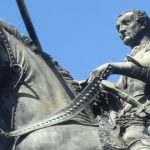
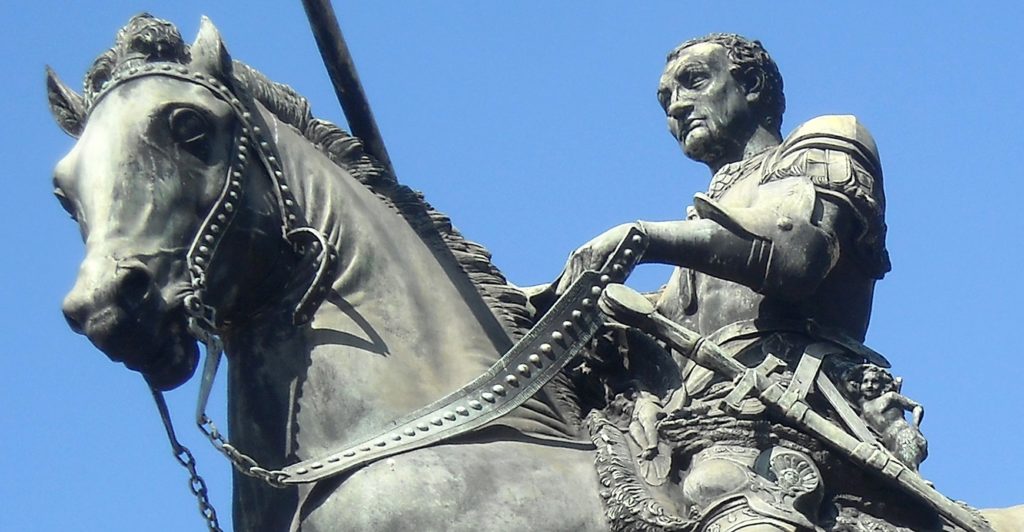
Uccello, Donatello, Verrocchio and the art of military command. An inquiry into the key events and artistic achievements that created the Renaissance. By Karel Vereycken, Paris.
Prologue

If there is still a lot to say, write and learn about the great geniuses of the European Renaissance, it is also time to take an interest in those whom the historian Georgio Vasari condescendingly called « transitional figures ».
How can one measure the contributions of Pieter Bruegel the Elder without knowing Pieter Coecke van Aelst? How can we value Rembrandt’s work without knowing Pieter Lastman? How did Raphaelo Sanzio innovate in relation to his master Perugino?
In 2019, an exceptional exhibition on Andrea Del Verrocchio (1435-1488), at the National Gallery in Washington, D.C., highlighted his great achievements, truly inspiring outbursts of great beauty that his pupil Leonardo da Vinci (1452-1519) would theorize and put to his greatest advantage.
The sfumato of Leonardo ? Verrochio is the pioneer, especially in the blurred features of portraits of women made with mixed techniques (pencil, chalk and gouache).
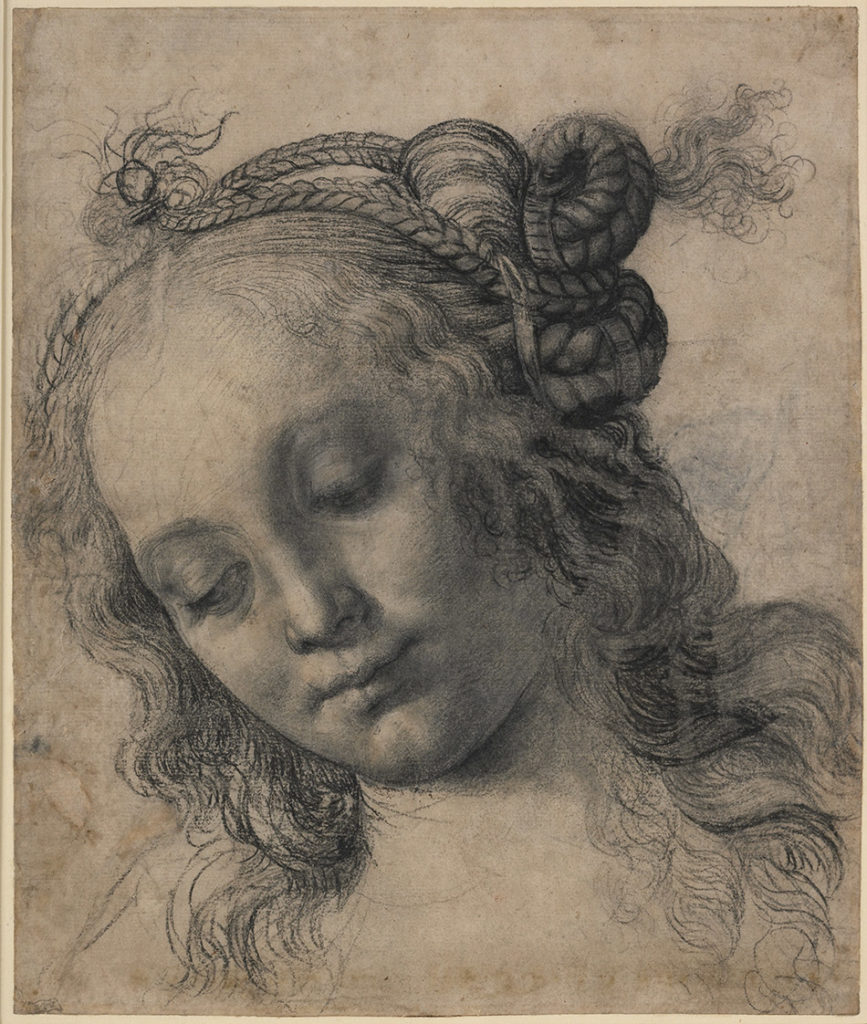
The joy of discovery
Leafing through the catalog of this exhibition, my joy got immense when I discovered (and to my knowledgne nobody else seems to have made this observation before me) that the enigmatic angel the viewer’s eye meets in Leonardo’s painting titled The Virgin on the Rocks (1483-1486) (Louvre, Paris), besides the movement of the body, is grosso modo a visual “quote” of the image of a terra cotta high relief (Louvre, Paris) attributed to Verrochio and “one of his assistants”, possibly even Leonardo himself, since the latter was training with the master as early as age seventeen ! The finesse of its execution and drapery also reminds us of the only known statue of Da Vinci, The Virgin with the laughing Child.

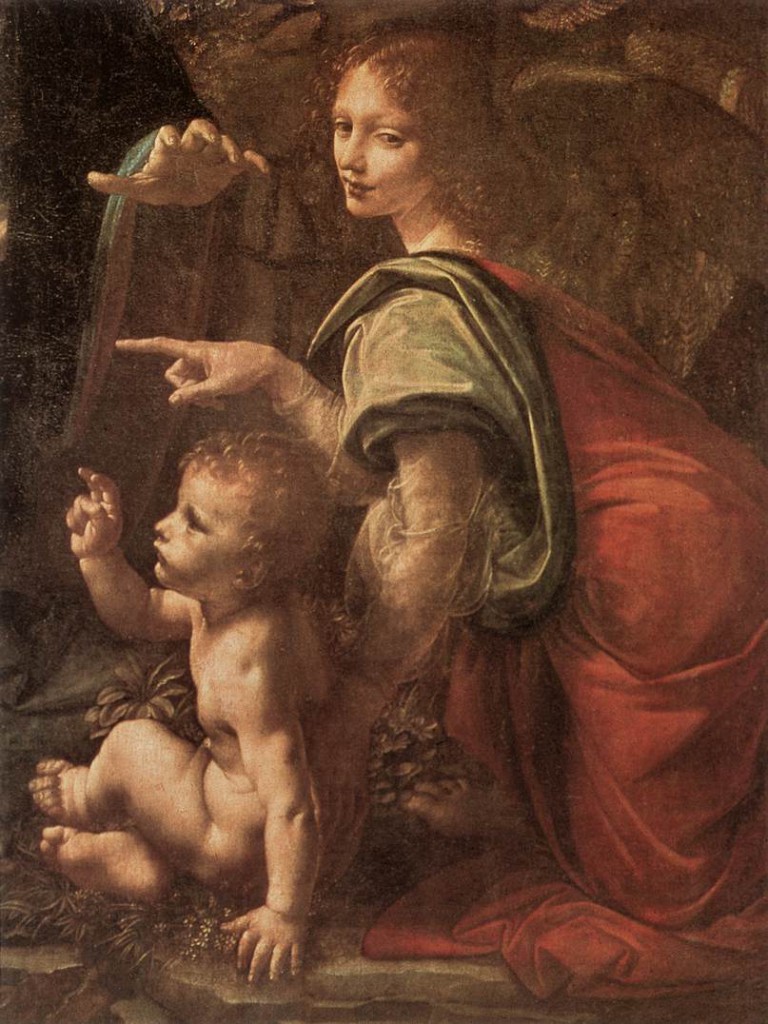
Many others made their beginnings in Verrocchio’s workshop, notably Lorenzo de Credi, Sandro Botticelli, Piero Perugino (Raphael’s teacher) and Domenico Ghirlandaio (Michelangelo’s teacher).
Coming out of the tradition of the great building sites launched in Florence by the great patron of the Renaissance, Cosimo de Medici for the realization of the doors of the Baptistery and the completion of the dome of Florence by Philippo Brunelleschi (1377-1446), Verrocchio conceived his studio as a true “polytechnic” school.
In Florence, for the artists, the orders flowed in. In order to be able to respond to all requests, Verrocchio, initially trained as a goldsmith, trained his students as craftsman-engineer-artists: drawing, calculation, interior decoration, sculpture, geology, anatomy, metal and woodworking, perspective, architecture, poetry, music and painting. A level of freedom and a demand for creativity that has unfortunately long since disappeared.
The Ghiberti legacy

In painting, Verrocchio is said to have begun with the painter Fra Filippo Lippi (1406-1469). As for the bronze casting trade, he would have been, like Donatello, Masolino, Michelozzo, Uccello and Pollaiuolo, one of the apprentices recruited by Lorenzo Ghiberti (1378-1455) whose workshop, starting from 1401, over forty years, will be in charge of casting the bronze bas-reliefs of two of the huge doors of the Baptistery of Florence.
Others suggest that Verrocchio was most likely trained by Michelozzo, the former companion of Ghiberti who said up shop with Donatello. As a teenager, Donatello had accompanied Brunelleschi on their joint expeditions to Rome to investigate the legacy of Greek and Roman art, and not only the architectural legacy.
In reality, Verrocchio only perpetuated and developed the model of Ghiberti’s « polytechnic » studio, where he learned the art. An excellent craftsman, Ghiberti was also goldsmith, art collector, musician and humanist scolar and historian.
His genius is to have understood the importance of multidisciplinarity for artists. According to him « sculpture and painting are sciences of several disciplines nourished by different teachings ».
The ten disciplines that he considered important to train artists are grammar, philosophy, history, followed by perspective, geometry, drawing, astronomy, arithmetic, medicine and anatomy.
You can discover, says Ghiberti, only when you managed to isolate the object of your research from interfering factors, and you can discover by detaching oneself from a dogmatic system;
as the nature of things want it, the sciences hidden under artifices are not constituted so that the men with narrow chests can judge them.
Anticipating the type of biomimicry that will characterize Leonardo thereafter, Ghiberti affirms that he sought:
to discover how nature functioned and how he could approach it to know how the objects come to the eye, how the sight functions and in which way one has to practice sculpture and painting.
Ghiberti, who was familiar with some of the leading members of the circle of humanists led by Salutati and Traversari, based his own reflexions on optics on the authority of ancient texts, especially Arabic. He wrote:
But in order not to repeat in a superficial and superfluous way the principles that found all opinions, I will treat the composition of the eye particularly according to the opinions of three authors, namely Avicenna [Ibn Sina], in his books, Alhazen [Ibn al Haytam], in the first book of his perspective, and Constantine [Qusta ibn Luqa] in the first book on the eye; for these authors are sufficient and treat with more certainty the things that interest us.
Deliberately ignored (but copied) by Vasari, Ghiberti’s Commentaries are a real manuel for artists, written by an artist. Most interestingly, it is by reading Ghiberti’s Commentaries that Leonardo da Vinci became familiar with important Arab contributions to science, in particular the outstanding work of Ibn al Haytam (Alhazen) whose treatise on optics had just been translated from Latin into Italian under the title De li Aspecti, and is quoted at length by Ghiberti in his Commentario Terzio. Author A. Mark Smith suggests that, through Ghiberti, Alhazen’s Book of Optics
may well have played a central role in the development of artificial perspective in early Renaissance Italian painting.

Ghiberti’s comments are not extensive. However, for the pupils of his pupil Verrocchio, such as Leonardo, who didn’t command any foreign language, Ghiberti’s book did make available in italian a series of original quotes from the roman architect Vitruvius, arab scientists such as Alhazen), Avicenna, Averroes and those european scientists having studied arab optics, notably the Oxford fransciscans Roger Bacon, John Pecham and the Polish monk working in Padua, Witelo.
Finally, in 1412, Ghiberti, while busy coordinating all the works on the Gates of the Baptistry, was also the first Renaissance sculptor to cast a life-size statue in bronze, his Saint John the Baptist, to decorate Orsanmichele, the house of the Corporations in Florence.
Lost wax casting
However, in order to cast bronzes of such a size, the artists, considering the price of metal, would use the technique known as “lost wax casting”.

This technique consists of first making a model in refractory clay (A), covered with a thickness of wax corresponding to the thickness of the bronze thought necessary.
The model is then covered with a thick layer of wet plaster (B) which, as it solidifies, forms an outer mold. Finally, the very hot molten bronze, pored into the mold it penetrates by rods (J) provided for this purpose, will replace the wax.

Finally, once the metal has solidified, the coating is broken. The details of the bronze (K) are then adjusted and polished (L) according to the artist’s choice.
This technique would become crucial for the manufacture of bells and cannons. While it was commonly used in Ifé in Africa in the 12th century for statuary, in Europe it was only during the Renaissance, with the orders received by Ghiberti and Donatello, that it was entirely reinvented.
In 1466, after the death of Donatello, it was Verrocchio’s turn to become the Medici’s sculptor in title for whom he produced a whole series of works, notably, after Donatello, his own David in bronze (Bargello National Museum, Florence).
If with this promotion his social ascendancy is certain, Verrocchio found himself facing the greatest challenge that any artist of the Renaissance could have imagined: how to equal or even surpass Donatello, an artist whose genius has never been praised enough?
Equestrian art
This being said, let us now approach the subject of the art of military command by comparing four equestrian monuments:
- Roman Emperor Marcus Aurelius on the Capitoline square in Rome (175 AD) ;
- Paolo Uccello’s fresco of John Hawkwood in the church of Santa Maria del Fiore in Florence (1436);
- Erasmo da Narni, known as “Gattamelata” (1446-1450), casted by Donatello in Padua.
- Bartolomeo Colleoni by Andrea del Verrocchio in Venice (1480-1488).
Equestrian statues appeared in Greece in the middle of the 6th century B.C. to honor the victorious riders in a race. From the Hellenistic period onward, they were reserved for the highest state figures, sovereigns, victorious generals and magistrates. In Rome, on the forum, they constituted a supreme honor, subject to the approval of the Senate. Apart from being bronze equestrian statues, each one is placed in a place where their troops fought.
While each statue is a reminder of the importance of military and political command, the way in which this responsibility is exercised is quite different.
Marcus Aurelius in Rome

Marcus Aurelius was born in Rome in 121 A.D., into a noble family of Spanish origin. He was the nephew of the emperor Hadrian. After the death of Marcus Aurelius’ father, Hadrian entrusted him to his successor Antonin. The latter adopts and gives him an excellent education. He was initiated early in philosophy by his master Diognetus.
Interested in the stoics, he adopted for a while their lifestyle, sleeping on the ground, wearing a rough tunic, before he was dissuaded by his mother.
He went to Athens in 175 A.D. and became a promotor of philosophy. He helps financially the philosophers and the rhetoricians by granting them a fixed salary. Concerned with pluralism, he supported the Platonic Academy, the Lyceum of Aristotle, the Garden of Epicurus and the Stoic Portico.
On the other hand, during his reign, persecutions against Christians were numerous. He saw them as troublemakers – since they refused to recognize the Roman gods, and as fanatics.

Erected in 175 A.D., the statue was entirely gilded. Its location in antiquity is unknown, but in the Middle Ages it stood in front of the Basilica of St. John Lateran, founded by Constantine, and the Lateran Palace, then the papal residence.
In 1538, Pope Paul III had the monument of Marcus Aurelius transferred to the Capitol, the seat of the city’s government. Michelangelo restored the statue and redesigned the square around it, one of the fanciest in Rome. It is undoubtedly the most famous equestrian statue, and above all the only one dating back to ancient Rome that has survived, the others having been melted down into coins or weapons…
If the statue survived, it is thanks to a misunderstanding: it was thought that it represented Constantine, the first Roman emperor to have converted to Christianity at the beginning of the 4th century, and it was out of the question to destroy the image of a Christian ruler.
Neither the date nor the circumstances of the commission are known.
But the presence of a defeated enemy under the right foreleg of the horse (attested by medieval testimonies and since lost), the emperor’s gesture and the shape of the saddle cloth, unusual in the Roman world, make us to belief that the statue commemorated Marcus Aurelius’ victories, perhaps on the occasion of his triumph in Rome in 176, or even after his death. Indeed, his reign (161-180) was marked by incessant wars to counter the incursions of Germanic or Eastern peoples on the borders of an Empire that was now threatened and on the defensive.
The horse, while not that large, but looking powerful, has been sculpted with great care and represented with realism. Its nostrils are strongly dilated, its lips pulled by the bit reveal its teeth and tongue.
One leg raised, he has just been stopped by his rider, who holds the reins with his left hand. Like him, the horse turns his head slightly to the right, a sign that the statue was made to be seen from that side. Part of his harness is preserved, but the reins have disappeared.
The size of the athletic rider nevertheless dominates that of a powerful horse that he rides without stirrups (accessories unknown to the Romans). He is dressed in a short tunic belted at the waist and a ceremonial cloak stapled on the right shoulder. It is a civil and not a military garment, adapted to a peaceful context. He is wearing leather shoes held together by intertwined straps.
The statue is striking for its size (424 cm high) and for the majesty it exudes. Without armor or weapons, eyes wide open and without emotion, the emperor raises his right arm. His authority derives above all from the function he embodies: he is the Emperor who protects his Empire and his people by punishing their enemies without mercy.
The fresco by Paolo Uccello

In 1436, at the request of Cosimo de’ Medici, the young Paolo Uccello was commissioned to paint a fresco depicting John Hawkwood (1323-1394), the son of an English tanner who had become a warlord during the Hundred Years’ War in France and whose name would be Italicized into Giovanno Acuto.
Serving the highest bidder, especially rival Italian cities, Hawkwood’s company of mercenaries was no slouch.
In Florence, although it may seem paradoxical, it was the humanist chancellor Coluccio Salutati (1331-1406) who put Hawkwood at the head of a regular army in the service of the Signoria.
This approach is not unlike that of Louis XI in France, who, in order to control the skinners and other cutthroats who were ravaging the nation, did not hesitate to discipline them by incorporating them into a standing army, the new royal army.
The humanists of the Renaissance, notably Leonardo Bruni (1370-1440) in his De Militia (1420), became aware of the curse of using mercenaries in conflicts and of the fact that only standing army, i.e. a permanent army formed of professionals and even better by citizens and maintained by a state or a city could guarantee a lasting peace.
Although Hawkwood faithfully protected the city for 18 years, his ugly “professionalism” as a mercenary was not unanimously accepted, to the point of inspiring the proverb “Inglese italianato è un diavolo Incarnato” (« An Italianized Englishman is a devil incarnate »).
Petrarch denounced him, Boccaccio tried in vain to mount a diplomatic offensive against him, St. Catherine of Sienna begged him to leave Italy, Chaucer met him and, no doubt, used him as a model for The Knight’s Tale (The Canterbury Tales).
All this will not prevent Cosimo, a member of the humanist conspiracy and a great patron of the arts, returning from exile, from wanting to honor him. But in the absence of the bronze equestrian statue (which had been promised to him…), Florence, will only offer him a fresco in the nave of Santa Maria del Fiore, that is to say under right under the cupola of the Duomo.

From the very beginning, Paolo Uccello’s fresco seems to have stirred quite a controversy. A preparatory drawing in the collections of Florence’s Uffizi Museum indicates the commander, more armed, taller, and, with his horse in a more military position. Uccello had originally depicted Hawkwood as « more threatening », with his baton raised and horse « at the ready ».
A recent ultraviolet study confirms the fact that the painter had originally depicted the condottiere armed from head to toe. In the final version, he wears a sleeveless jacket, the giornea, and a coat; only his legs and feet are protected by a piece of armor. The final version presents a less imposing rider, less warlike, more human and more individualized
In the dispute, it was not Uccello who was considered faulty, but his sponsors. Moreover, the painter was quickly given the task of redoing the fresco in a way deemed “more appropriate”.
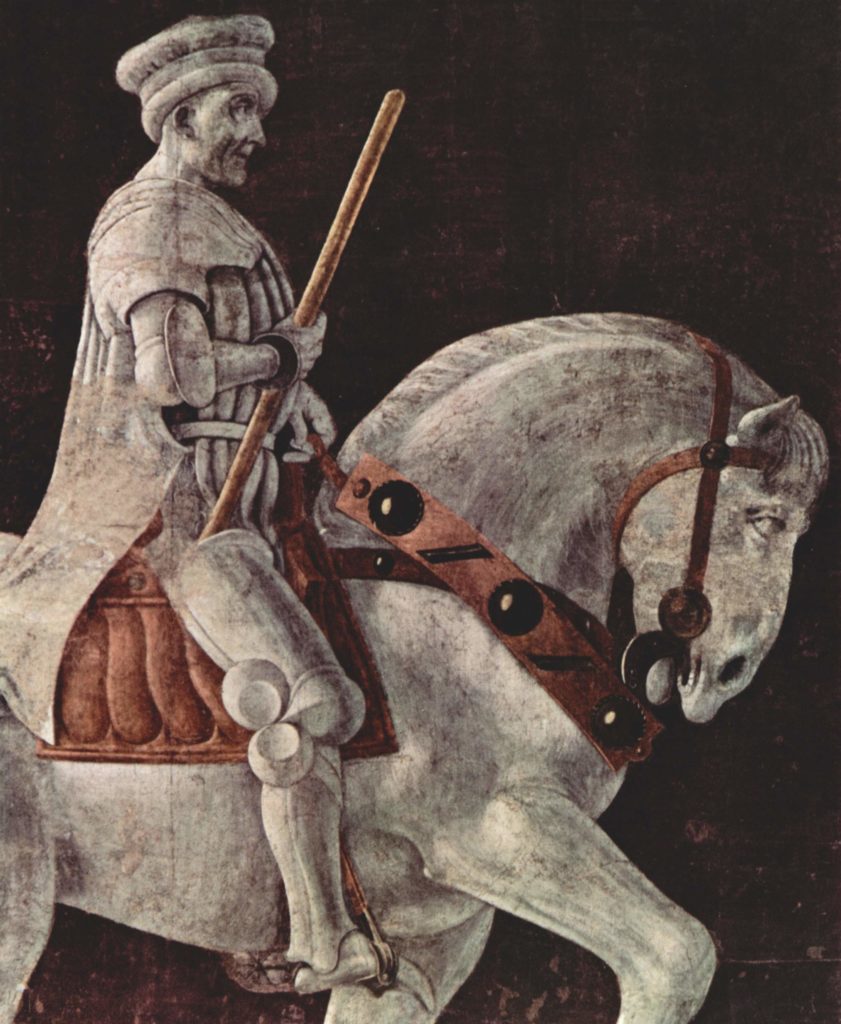
Unfortunately, there is no record of the debates that must have raged among the officials of the church fabric (Opera Del Domo). What is certain is the fact that in the final version, visible today, the condottiere has been transformed from a warlord running a gang of mercenaries, into the image of philosopher-king whose only weapon is his commanding staff. At the bottom of the fresco, we can read in Latin: “Giovanno Acuto, British knight, who was in his time held as a very prudent general and very expert in military affairs.”
The position of the horse and the perspective of the sarcophagus have been changed from a simple profile to a di sotto in su view.
If this perspective is somewhat surrealistic and the pose of the horse, raising both legs on the same side, simply impossible, it remains a fact that Uccello’s fresco will set “the standards” of the ideal and impassive image of virtue and command that must embody the hero of the Renaissance: his goal is no longer to “win” a war (the objective of the mercenary), but to preserve the peace by preventing it (the objective of a philosopher-king or simply a wise head of state).
Paradigm shift
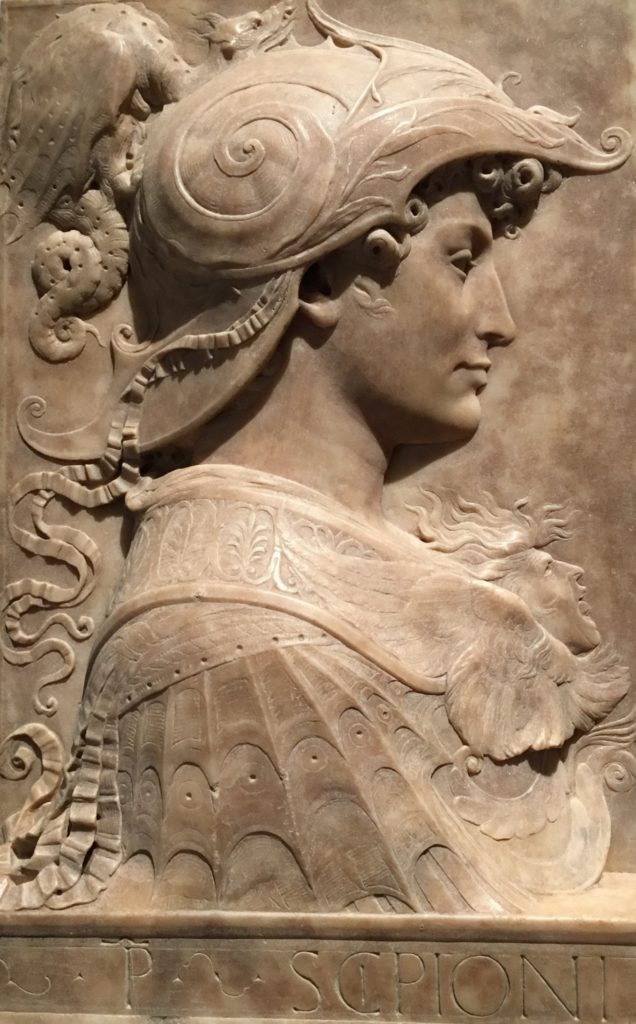
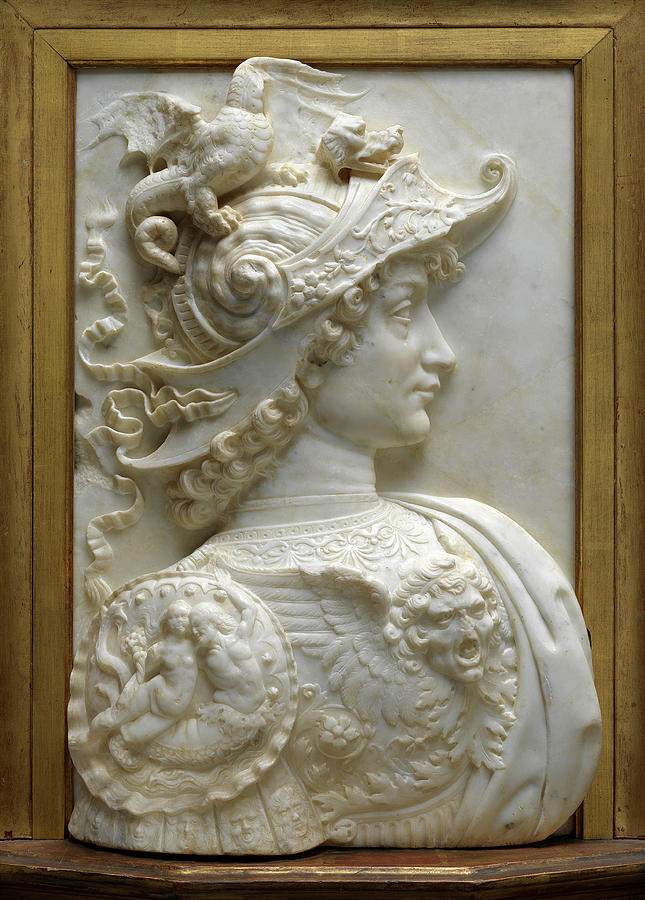

As such, one might say that Uccello’s fresco announces the “paradigm shift” marking the end of the age of perpetual feudal wars, to that of the Renaissance, that is to say to that of a necessary concord between sovereign nation-states whose security is indivisible, the security of one being the guarantee of the security of the other, a paradigm even more rigorously defined in 1648 at the Peace of Westphalia, when it made the agapic notion of the “advantage of the other” the basis of its success.
One historian suggests that the recommissioning of Uccello’s fresco was part of the « refurbishing » of the cathedral associated with its rededication as Santa Maria del Fiore by the humanist Pope Eugene IV in March 1436, determined to convince the Eastern and Western Churches to peacefully overcome their divisions and réunite as was attempted at the Council of Florence of 1437-1438 and for which the Duomo was central.
Interesting is the fact that Uccello’s fresco appeared at around the same time that Yolande d’Aragon and Jacques Coeur, who had his Italian connections, persuaded the French king Charles VII to put an end to the Hundred Years’ War by setting up a permanent, standing army.
In 1445, an ordinance was passed to discipline and rationalize the army in the form of cavalry units grouped into Compagnies d’Ordonnances, the first permanent army at the disposal, not of warlords or aristocrats, but of the King of France.
Donatello’s “Gattamelata” (1447-1453)

It was only some years later, in Padua, between 1447 and 1453, that Donatello would work on the statue of Erasmo da Narni (1370-1443), a Renaissance condottiere, i.e. the leader of a professional army in the service of the Republic of Venice, which at the time ruled the city of Padua. An important detail is that Erasmo was nicknamed “il Gattamelata”.
In French, « faire la chattemite » means to affect a false air of sweetness to deceive or seduce… Others explain that his nickname of “honeyed cat” comes from the fact that his mother was called Melania Gattelli or that he wore a crest (a helmet) in the shape of a honey-colored cat in battle…
The man was of humble origin, the son of a baker, born in Umbria around 1370. He learned to handle weapons from Ceccolo Broglio, lord of Assisi, and then, when he was in his thirties, from the captains of Braccio da Montone, who was known for recruiting the best fighters.
In 1427, Erasmo, who had the confidence of Cosimo de’ Medici, signed a seven-year contract with the humanist Pope Martin V, who wished to strengthen an army corps loyal to his cause with the aim of bringing to heel the lords of Emilia, Romagna and Umbria who were rebellious against papal authority.

He bought a huge suit of armor to reinforce his high stature. He was not an impetuous fighter, but a master of siege warfare, which forced him to take slow, thoughtful and progressive action. He spied on his prey for a long time before trapping it.
In 1432, he captured the fortress of Villafranca near Imola by cunning alone and without fighting. The following year he did the same to capture the fortified town of Castelfranco, thus sparing his soldiers and his treasure.
Those who were unable to grasp his tactics, accused him of being a coward for “running away” from the front-line, not realizing, that on a given moment, this was part of the tactics of his winning strategy.
He was a prudent captain, with a very well-mannered troop, and he was careful to maintain good relations with the magistrates of the towns that employed him. He obtained the rank of captain-general of the army of the Republic of Venice during the fourth war against the Duke of Milan in 1438 and died in Padua in 1443. Following his death, the Venetian Republic gave him full honors and Giacoma della Leonessa, his widow, commissioned a sculpture in honor of her late husband for 1650 ducats.
The statue, which represents the life-size condottiere, in antique-style armor and bareheaded, holding his commanding staff in his raised right hand, on his horse, was made by the lost-wax method. As early as 1447, Donatello made the models for the casting of the horse and the condottiere. The work progresses at full speed and the work is completed in 1453 and placed on its pedestal in the cemetery that adjoins the Basilica of Padua.
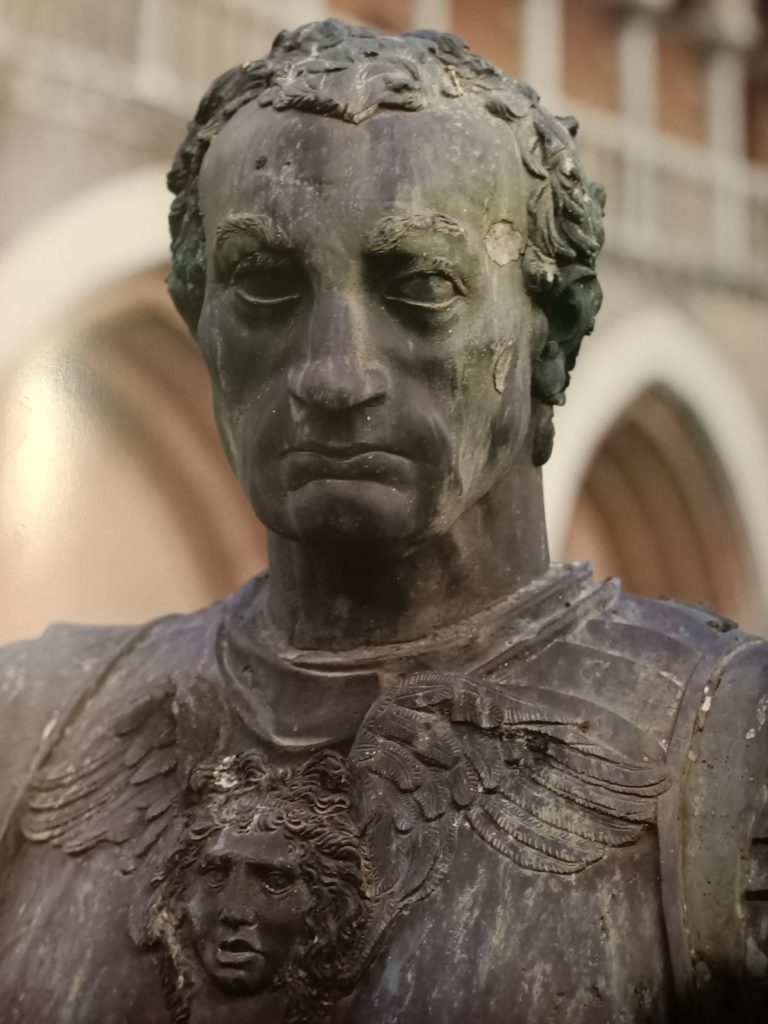
Brilliant for his cunning and guile, Gattamelata was a thoughtful and effective fighter in action, the type of leader recommended by Machiavelli in The Prince, and which appears in the sixteenth century by François Rabelais in his account of the “Picrocholine wars”.
Not the brute power of weapons, but the cunning and the intelligence will be the major qualities that Donatello will make appear powerfully in his work.
Contrary to Marcus Aurelius, it is not his social status that gives the commander his authority, but his intelligence and his creativity in the government of the city and the art of war. Donatello had an eye for detail. Looking at the horse, we see that it is a massive animal but far from static. It has a slow and determined gait, without any hesitation.
But that’s not all. A rigorous analysis shows that the proportions of the horse are of a “higher order” than those of the condottiere. Did Donatello make a mistake and make Erasmo too small and the horse too large? No, the sculptor made this choice to emphasize the value of Gattamelata who, thanks to his skills, is able to tame even wild and gigantic animals. In addition, the horse’s eyes show him as wild and untameable. Looking at him, one could say that it is impossible to ride him, but Gattamelata manages it with ease and without effort.
Because if you look at the reins in the hands of the protagonist, you will notice that he holds them in complete tranquility. This is another detail that highlights Erasmus’ powerful cunning and ingenuity.
Next, did you notice that one of the horse’s legs rests on a sphere? If this sphere (which could also be a cannonball, since Erasmus was a warrior) serves to give stability to Donatello’s composition as a whole, it also indicates how this animal of gigantic strength (symbolizing here warlike violence), once tamed and well used, allows the globe (the earthly kingdom) to be kept in balance.
Having told you about the horse, it is time to know more about the condottiere.
He has a proud and determined expression. The baton of command, which he holds in his hand, delicately touches the horse’s mane. The baton is not just a symbolic object; he may have received it in 1438 from the Republic of Venice.
Unlike Uccello’s fresco, Gattamelata is not dressed as a contemporary prince of commander, but as a figure beyond time embodying both the past, the present and the future. To capture this, Donatello, who takes care of every detail, has taken an ancient model and modernized it with incredible results. The details of the protagonist’s armor include purely classical motifs such as the head of Medusa, taken from Marcus Aurelius, in Greek mythology one of the three gorgons whose eyes had the power to petrify any mortal who crossed her gaze.
Although the helmet of Gattamelata would have allowed to identify him at eyesight, Donatello has discarded this option. With a helmet on his head, he would have been the symbol of a bloodthirsty warrior, rather than a cunning man. Even better, the absence of a helmet allows the artist to show us a fearless commander whose fixed gaze shows his determination. With the figure slightly bowed and legs extended, the sword in its scabbard placed at an angle, Donatello gives the illusion of an “imbalance” that reinforces in the viewer’s mind the idea that the horse is advancing with full strength.
Art historian John Pope-Hennessy is emphatic:
The fundamental differences between the Gattamelata and Marcus Aurelius are obvious. The (roman) emperor sits passively on his horse, legs dangling. In the fifteenth century, on the other hand, the art of riding implies the use of spurs. The impression of authority that emanates from the monument designed by Donatello comes from the total domination of the condottiere over his horse. (…) The soles of the feet are exactly parallel to the surface of the pedestal, as are the large six-pointed spurs, stretched to the middle of the animal’s flank.
As a result, Gattamelata is not a remake of the “classical Greek or Roman sculpture” of a hero with a sculpted physique, but a kind of new man who succeeds through reason. The fact that the statue has such a high pedestal also has its reason. Placed at such a height, the Gattamelata does not “share” our own space. It is in another dimension, eternal and out of time.
Verrocchio’s Colleoni

Some thirty years later, between 1480 and 1488, Andrea del Verrocchio, after a contest, was selected to make a large bronze equestrian statue of another Italian condottiere named Bartolomeo Colleoni (1400-1475).
A ruthless mercenary, working for a patron one day and his rival the next day, he served from 1454 the Republic of Venice with the title of general-in-chief (capitano generale). He died in 1475 leaving a will in which he bequeathed part of his fortune to Venice in exchange for the commitment to erect a bronze statue to his honor in St. Mark’s Square.
The Venetian Senate agreed to erect an equestrian monument to his memory, while charging the costs to the widow of the deceased…
In addition, the Senate refused to erect it in St. Mark’s Square, which was, along with St. Mark’s Basilica, at the heart of the city’s life. The Senate therefore decided to interpret the conditions set by Colleoni in his last will and testament without contradicting them, choosing to erect his statue in 1479, not in St. Mark’s Square, but in an area further from the city center in front of the Scuola San Marco, on the campo dei Santi Giovanni e Paolo.
Although Verrocchio had started working on the project since 1482, it remained unfinished at his death in 1488. And it is, not as Verrocchio wished, his heir Lorenzo di Credi who will cast the statue, but the Venetian Alessandro Leopardi (who lost the contest to Verrocchio), who will not hesitate to sign it!
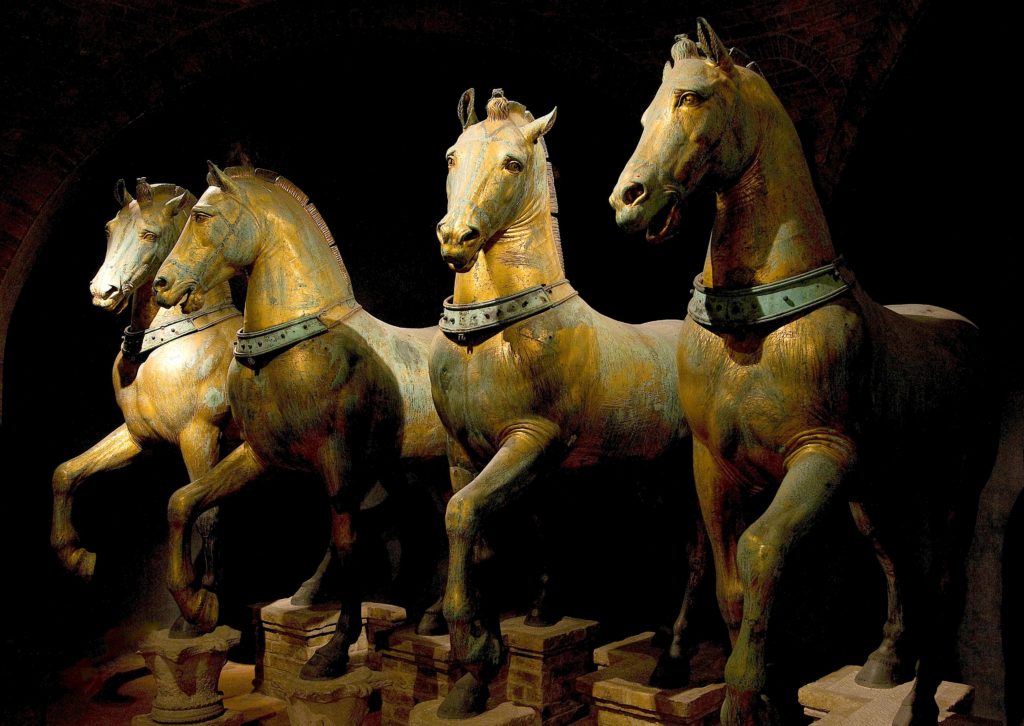
If the horse is in conformity with the typology of the magnificent horses composing the quadriga overseeing the Basilica of Saint Mark of Venice (Greek statuary of the IVth century BC brought back by the crusaders from Constantinople to Venice in 1204) and of the horse of Marcus Aurelius, its musculature is more nervously underlined and traced. Objectively, this statue is ideally more proportionate. There is also more fine detail, a result of new pre-sculpture techniques, making the work captivating and realistic to look at.

The sculpture overflows its pedestal. According to André Suarès quoted in The Majesty of Centaurs:
Colleone on horseback walks in the air, he will not fall. He cannot fall. He leads his earth with him. His base follows him […] He has all the strength and all the calm. Marcus Aurelius, in Rome, is too peaceful. He does not speak and does not command. Colleone is the order of the force, on horseback. The force is right, the man is accomplished. He goes a magnificent amble. His strong beast, with the fine head, is a battle horse; he does not run, but neither slow nor hasty, this nervous step ignores the fatigue. The condottiere is one with the glorious animal: he is the hero in arms.
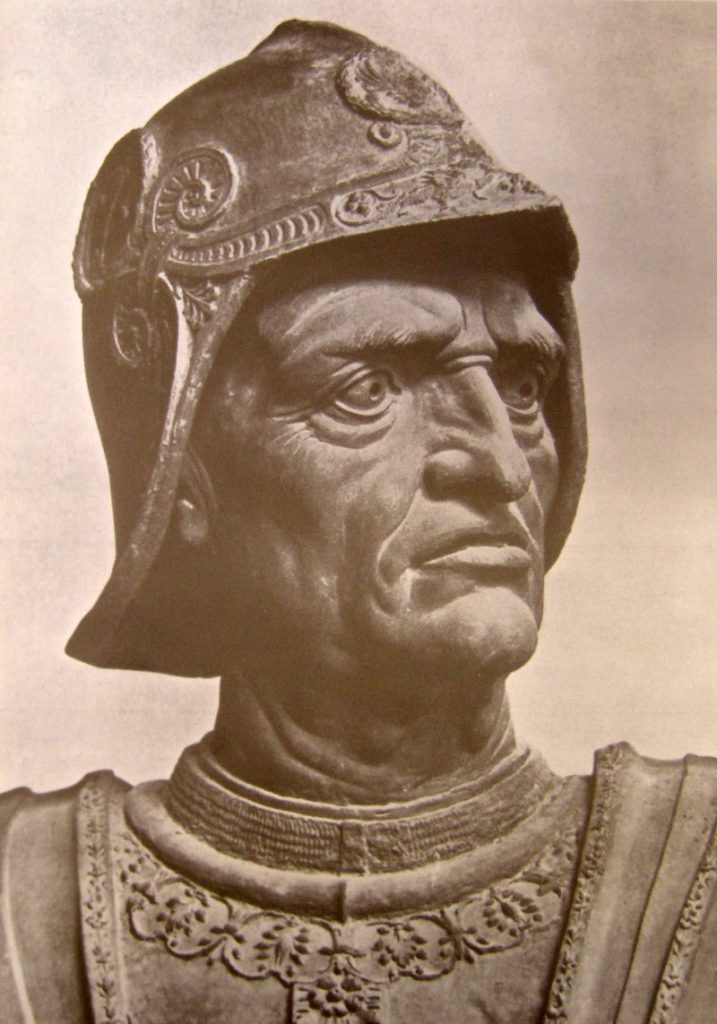
His baton of command is even metamorphosed into a bludgeon! But since it is not Verrocchio who finished this work, let us not blame the latter for the warlike fury that emanates from this statue.
Venice, a vicious slave-trading financial and maritime Empire fronting as a “Republic”, clearly took its revenge here on the beautiful conception developed during the Renaissance of a philosopher-king defending the nation-state.
On the aesthetic level, this mercenary smells like an animal. As a good observer, Leonardo warned us: when an artist represents a man entirely imprisoned by a single emotion (joy, rage, sadness, etc.), he ends up painting something that takes us away from the truly human soul. This is what we see in this equestrian statue.
If, on the contrary, the artist shows several emotions running through the figure represented, the human aspect will be emphasized. This is the case, as we have seen, with Donatello’s Gattamelata, uniting cunning, determination and prudence to overcome fear the face of threat.
Leonardo’s own, gigantic project to erect a gigantic bronze horse, on which he worked for years and developed new bronze casting techniques, unfortunately was never build, seen the hectic circumstances.
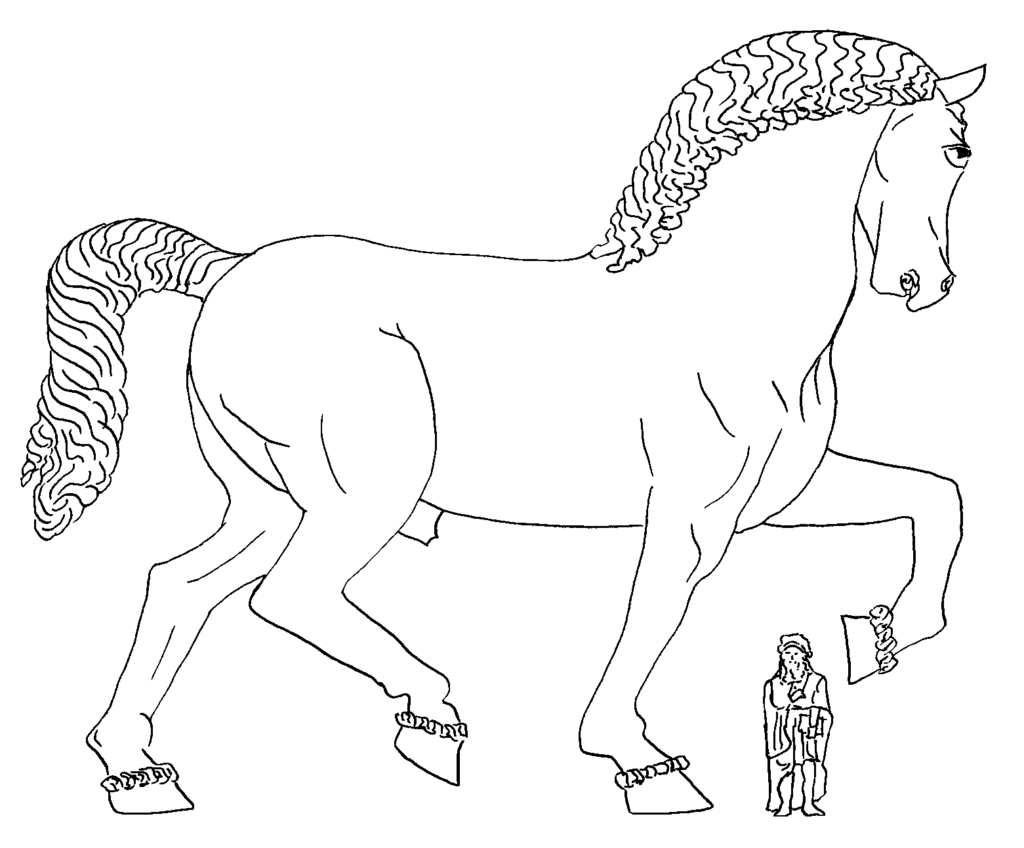
Finally, beyond all the interpretations, let us admire the admirable know-how of these artists. In terms of craft and skill, it generally took an entire life to become able to realize such great works, not even mentioning the patience and boundless passion required.
Up to us to bring it back to life !
Bibliography:
- Verrocchio, Sculptor and Painter of Renaissance Florence, Andrew Butterfield, National Gallery, Princeton University Press, 2020;
- Donatello, John Pope-Hennessy, Abbeville Press, 1993;
- Uccello, Franco and Stefano Borsi, Hazan, 2004;
- Les Commentaires de Lorenzo Ghiberti dans la culture florentine du Quattrocento, Pascal Dubourg-Glatigny, Histoire de l’Art, N° 23, 1993, Varia, pp. 15-26;
- Monumento Equestre al Gattamelata di Donatello: la Statua del Guerriero Astuto, blog de Dario Mastromattei, mars 2020;
- La sculpture florentine de la Renaissance, Charles Avery, Livre de poche, 1996 ;
- La sculpture de la Renaissance au XXe siècle, Taschen, 1999;
- Ateliers de la Renaissance, Zodiaque-Desclée de Brouwer, 1998;
- Rabelais et l’art de la guerre, Christine Bierre, 2007.
- The Greek language project, Plato and the Renaissance, Karel Vereycken, jan. 2021.

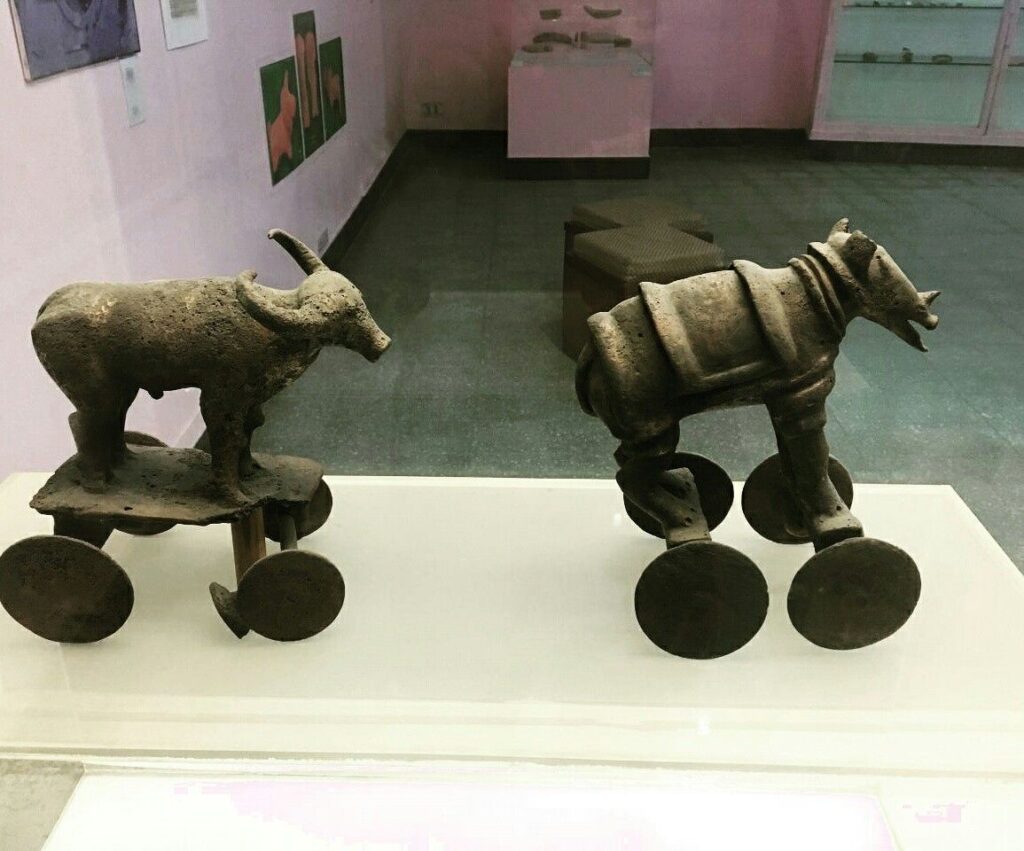
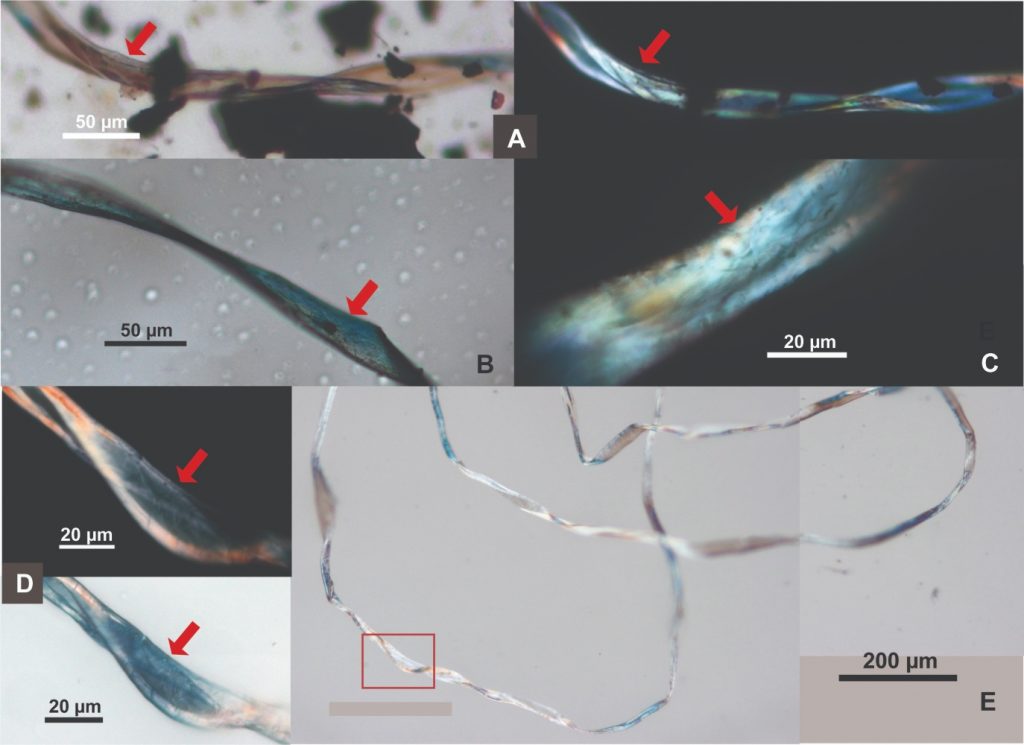


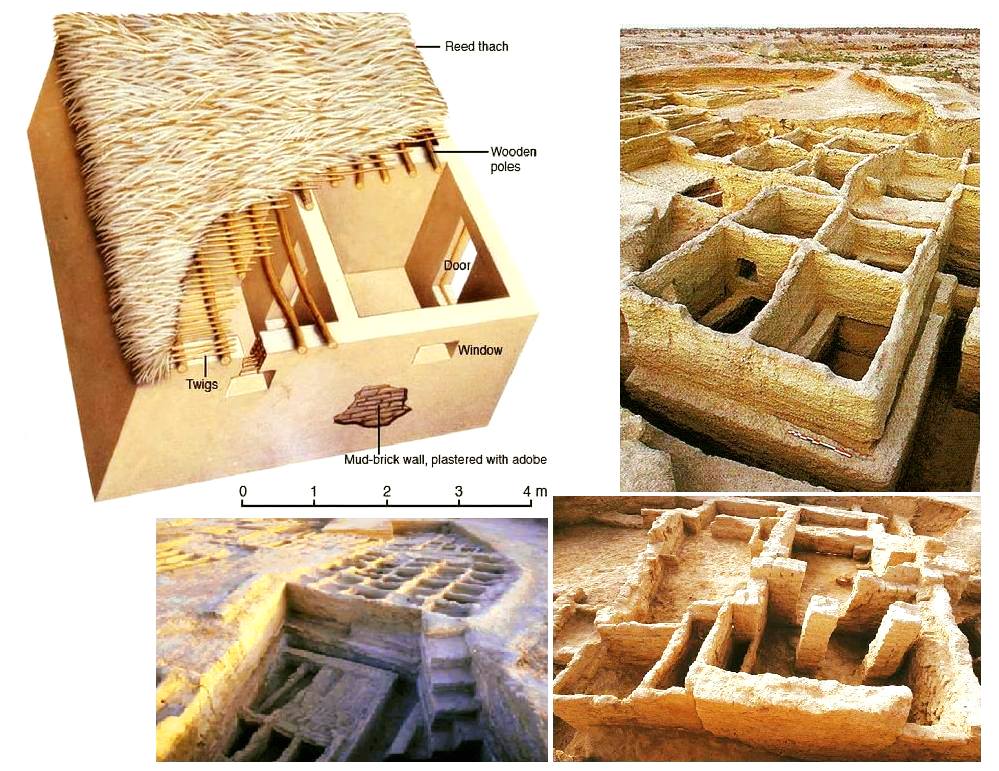


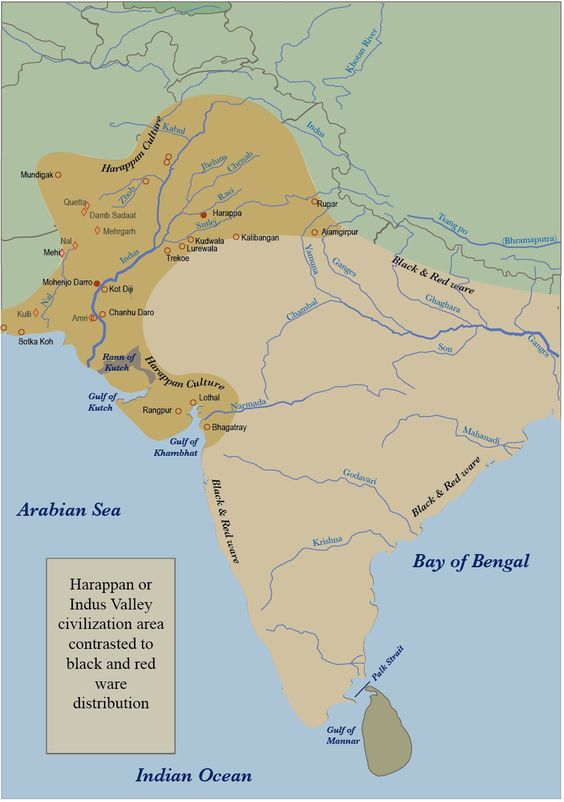


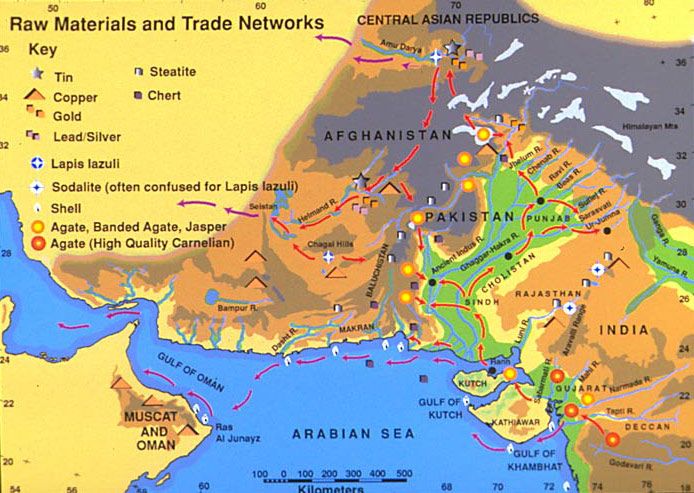

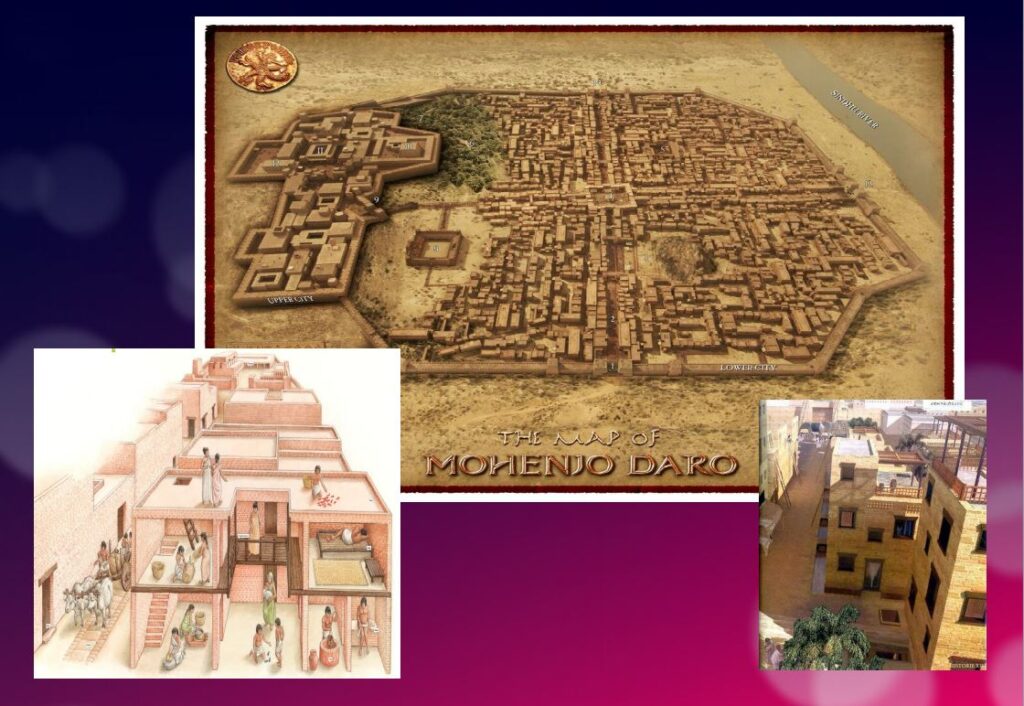
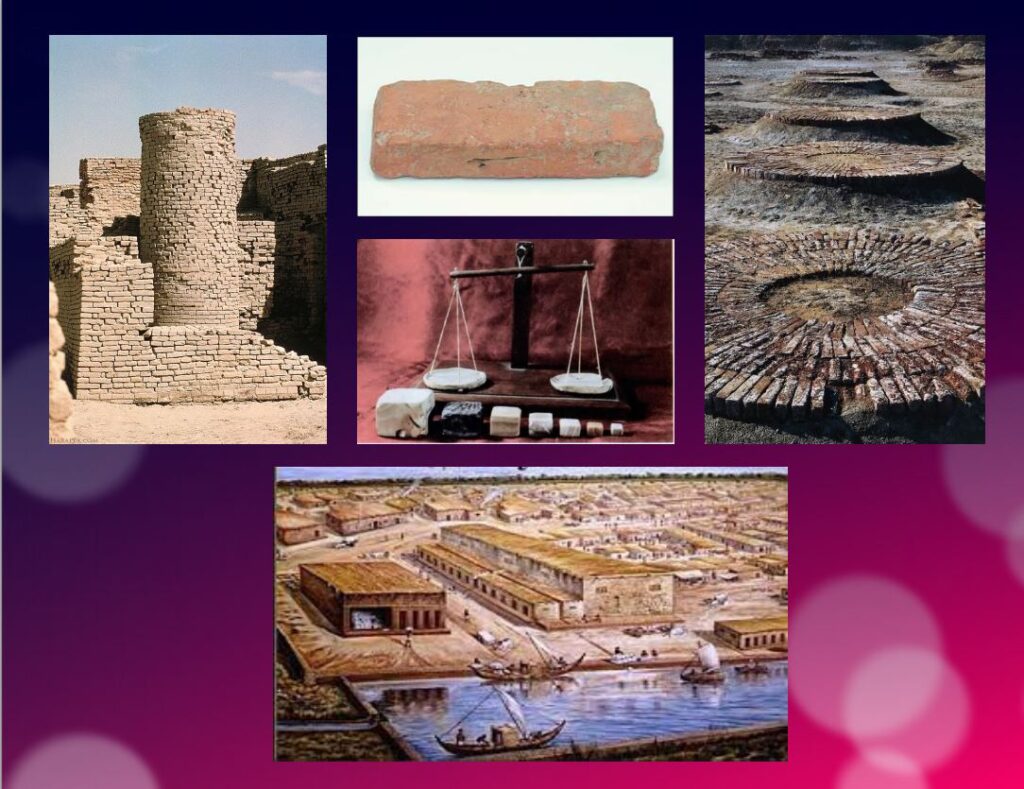
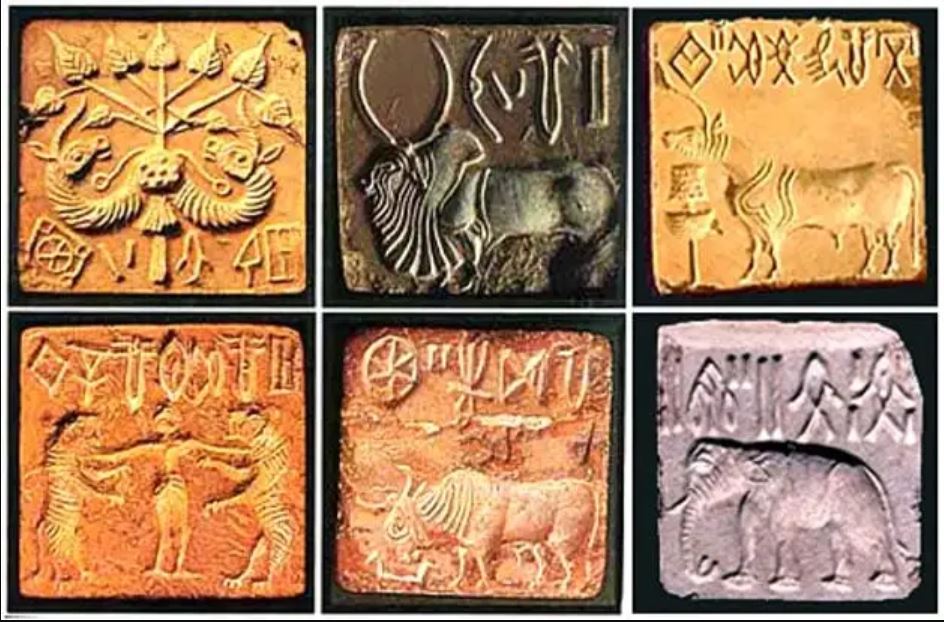
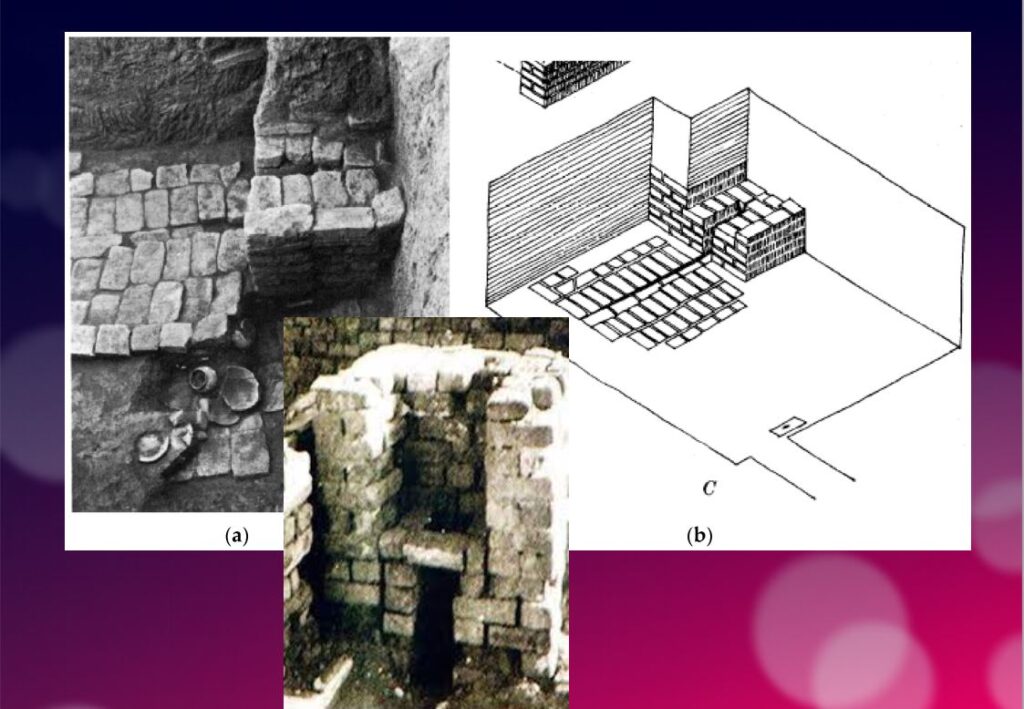

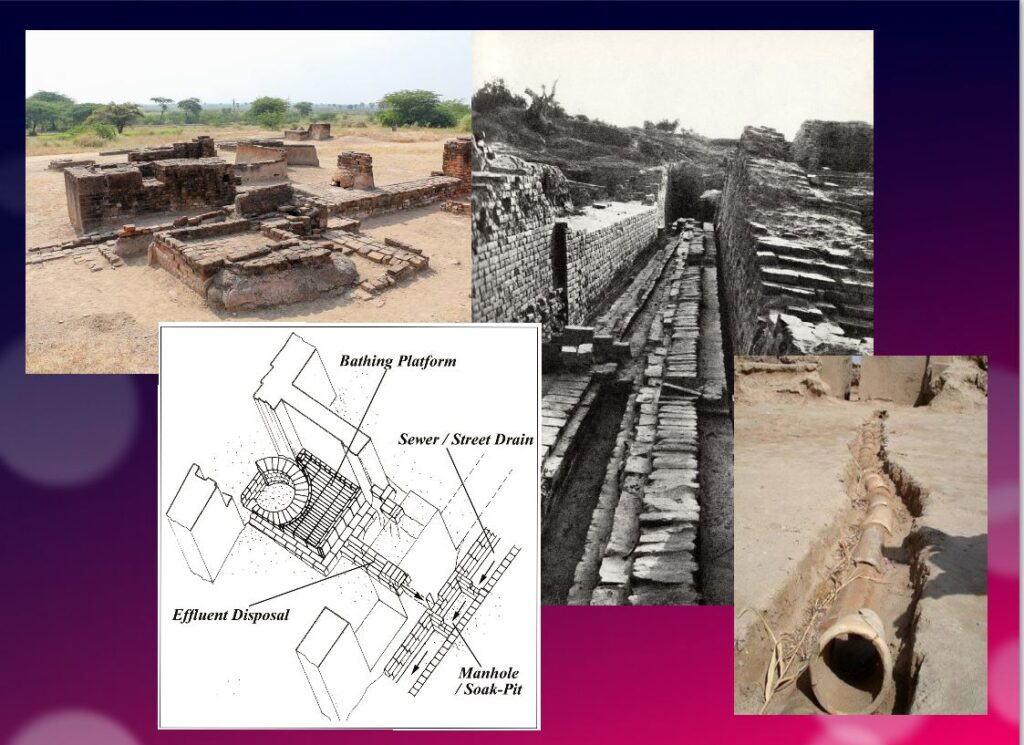
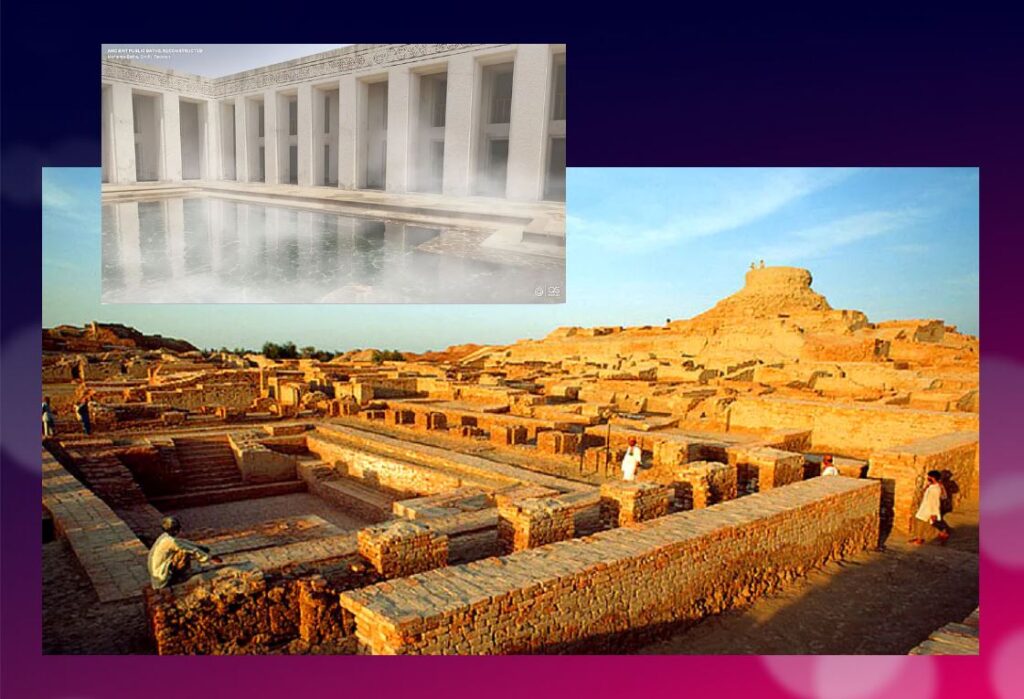


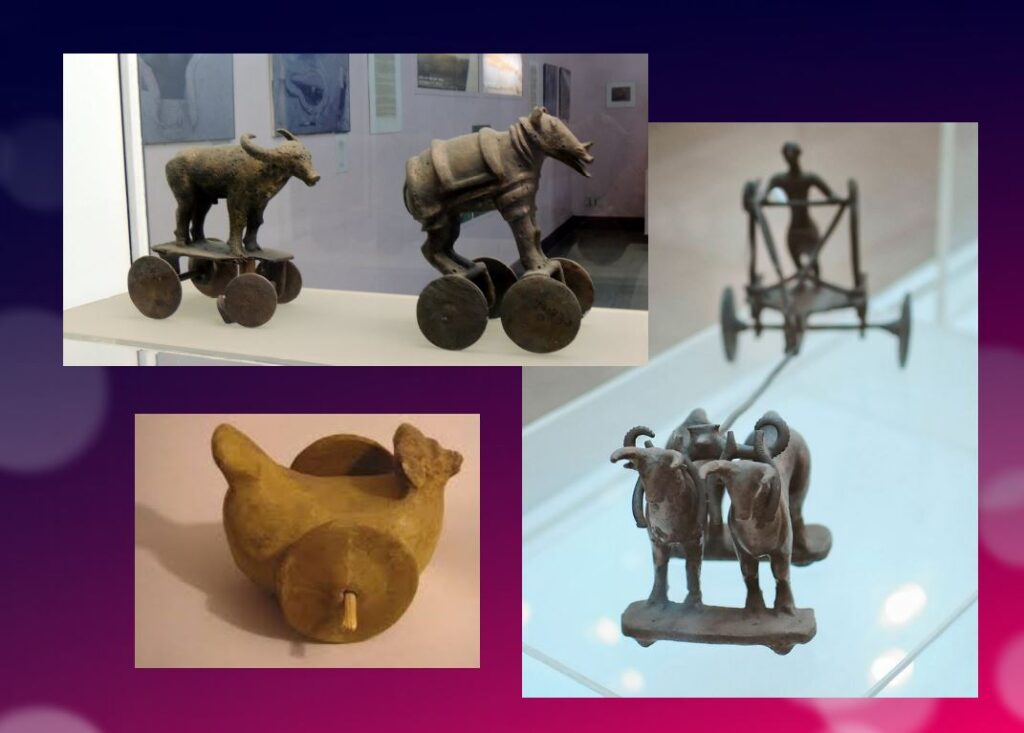
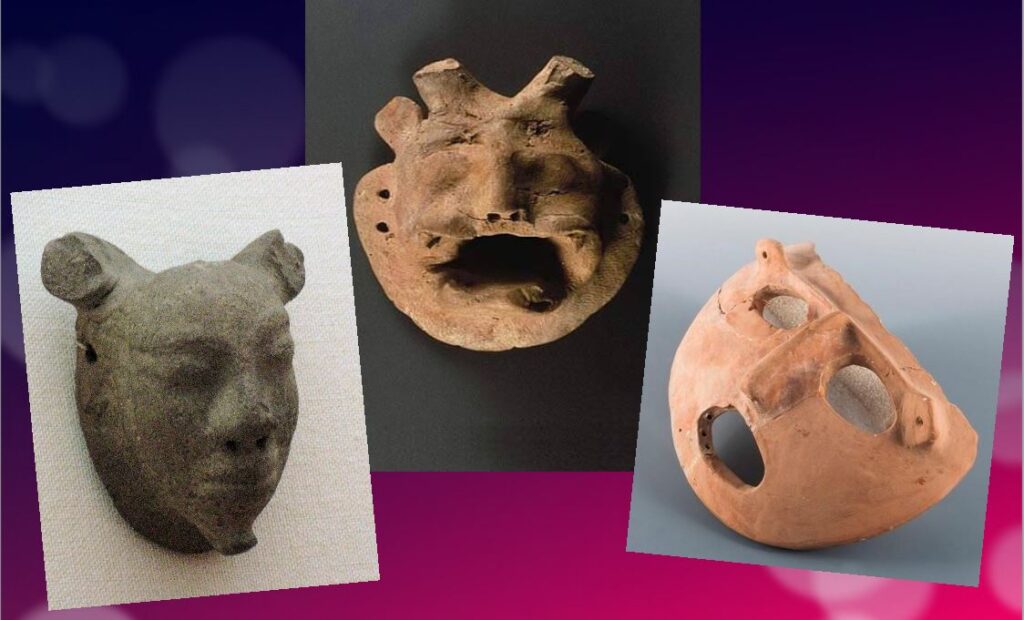


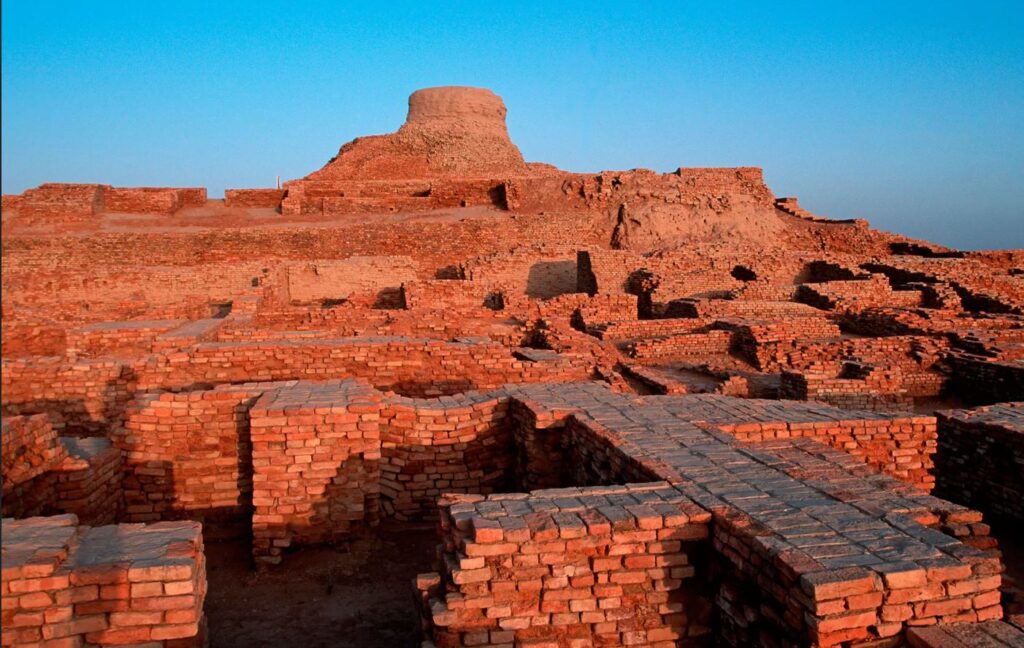

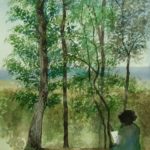
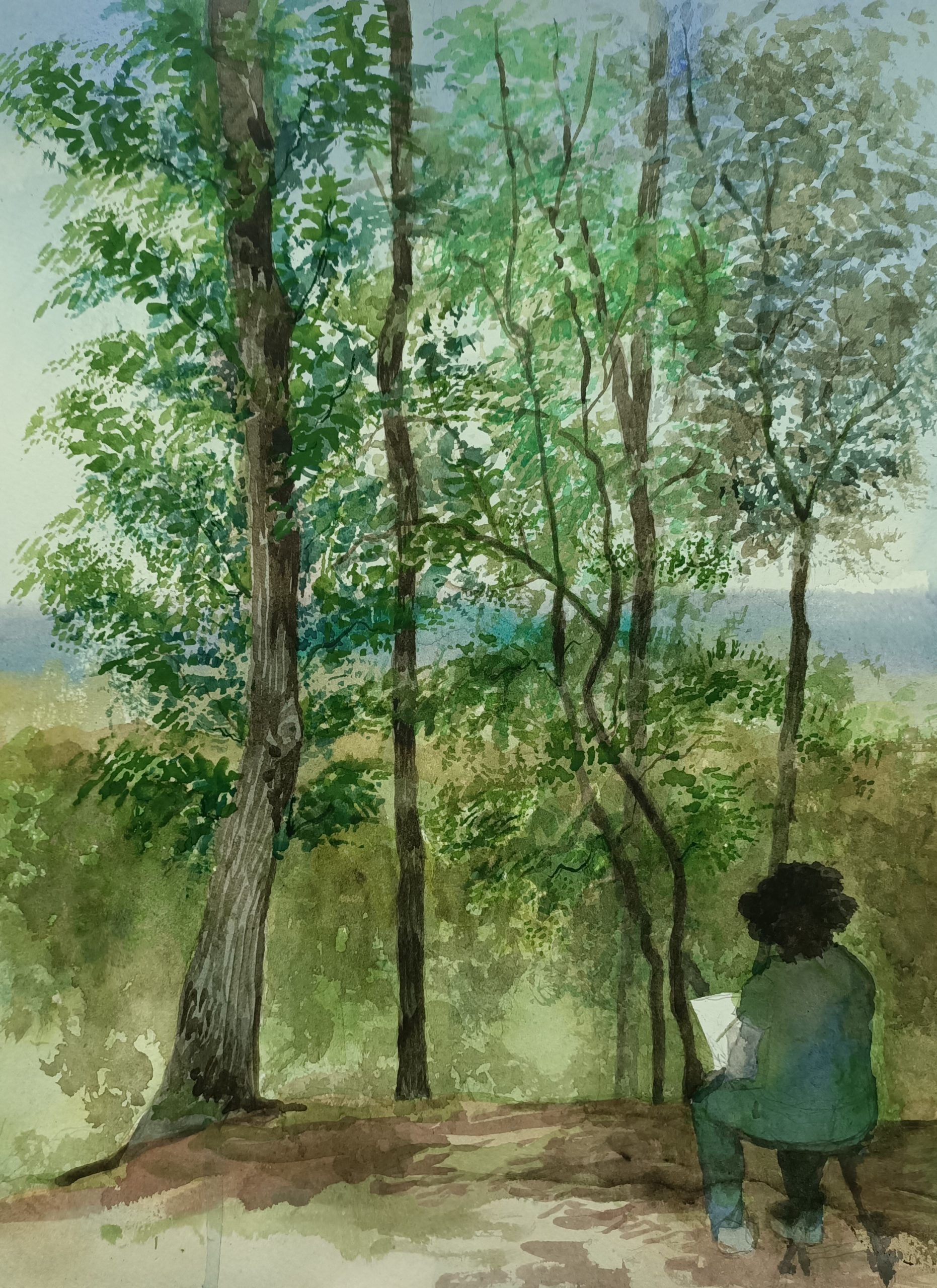
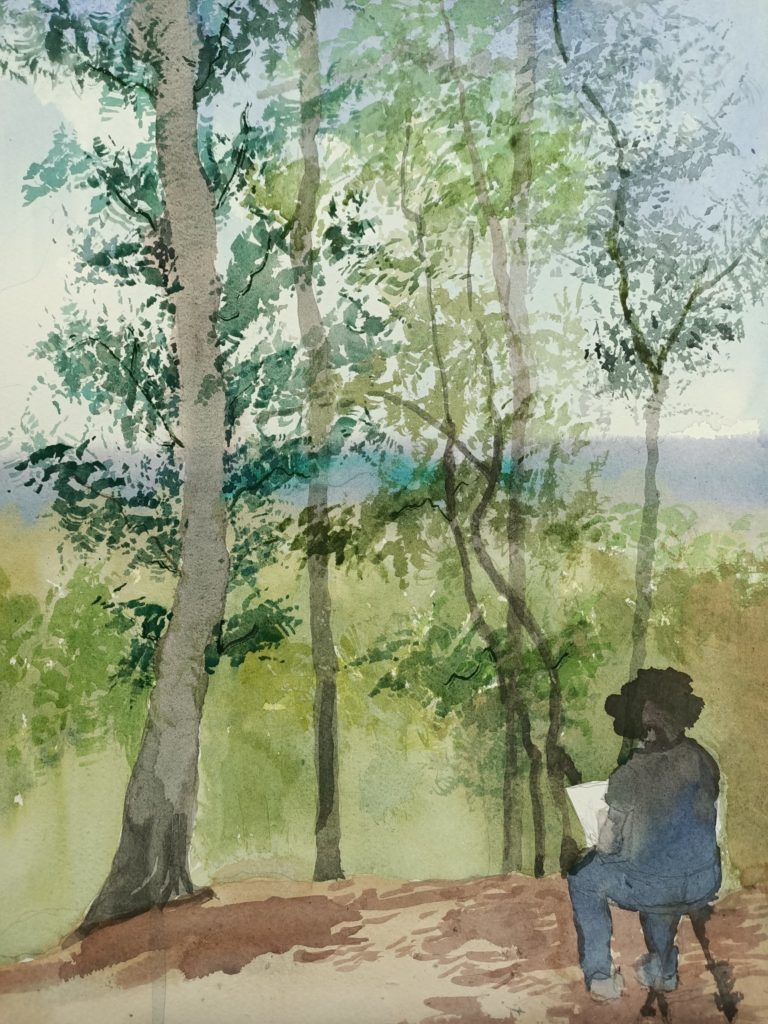
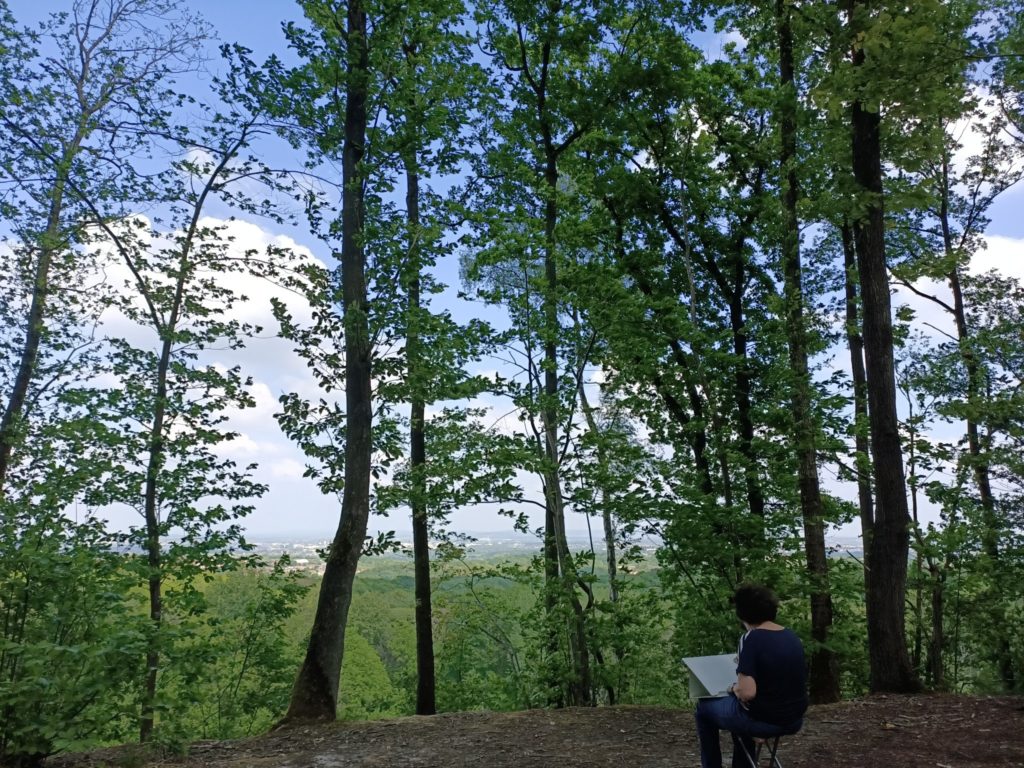

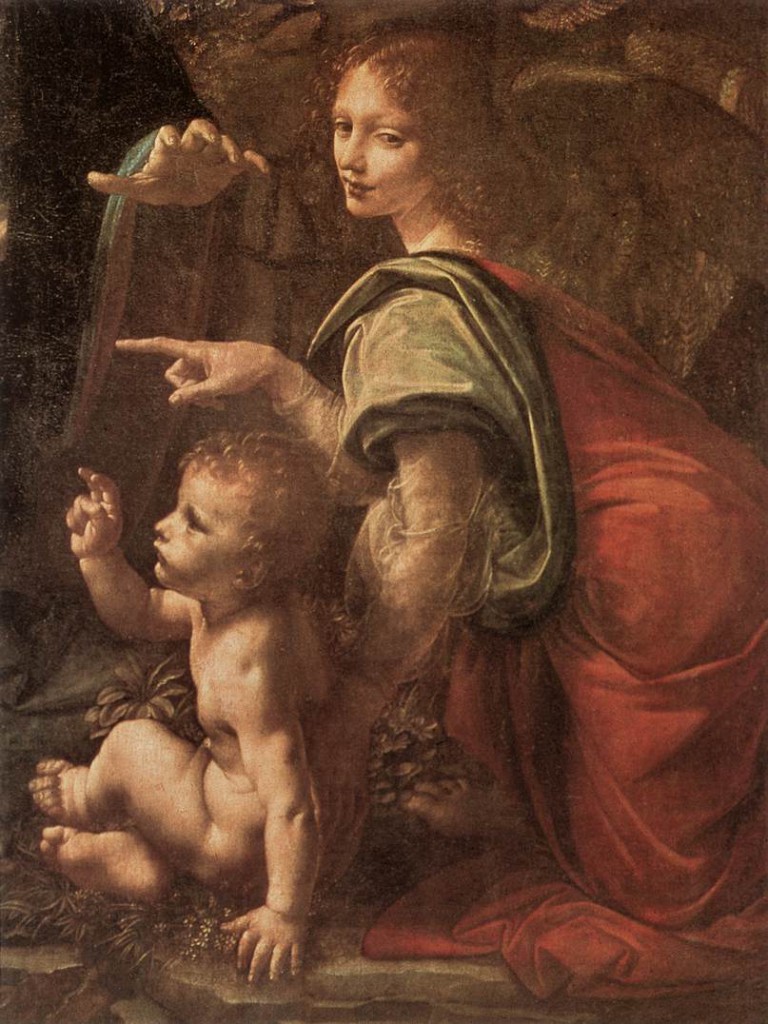




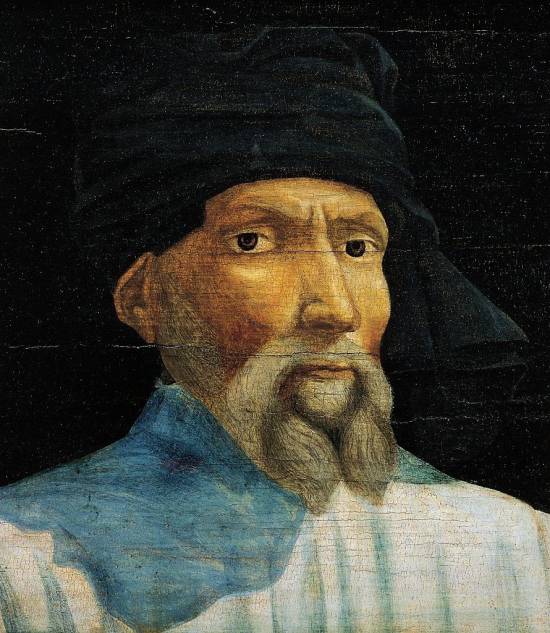



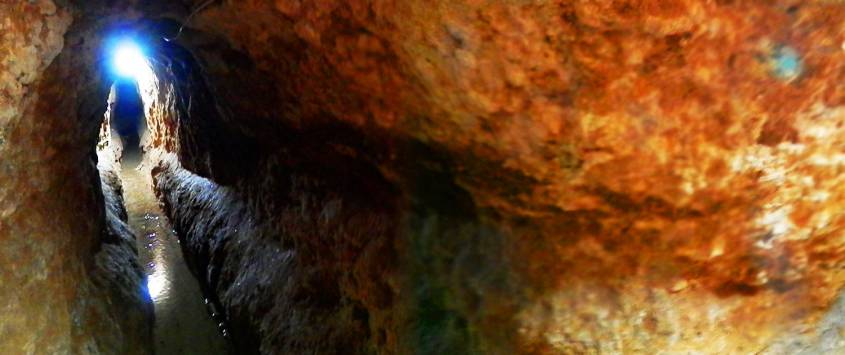

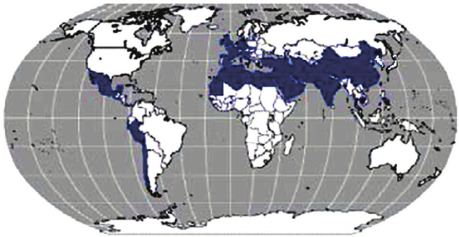
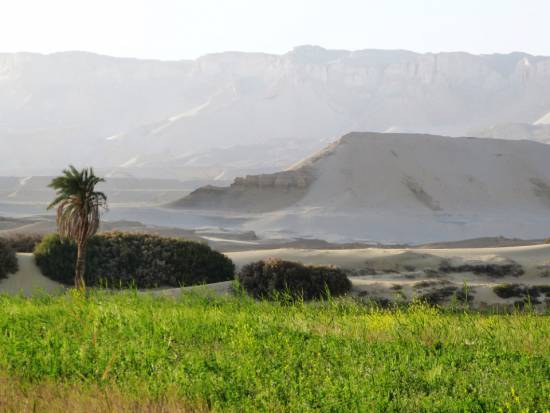
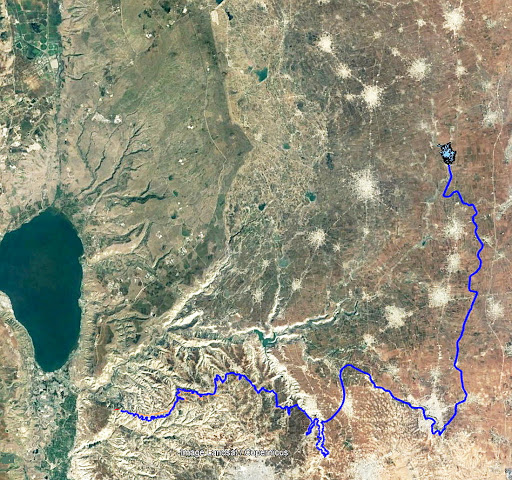

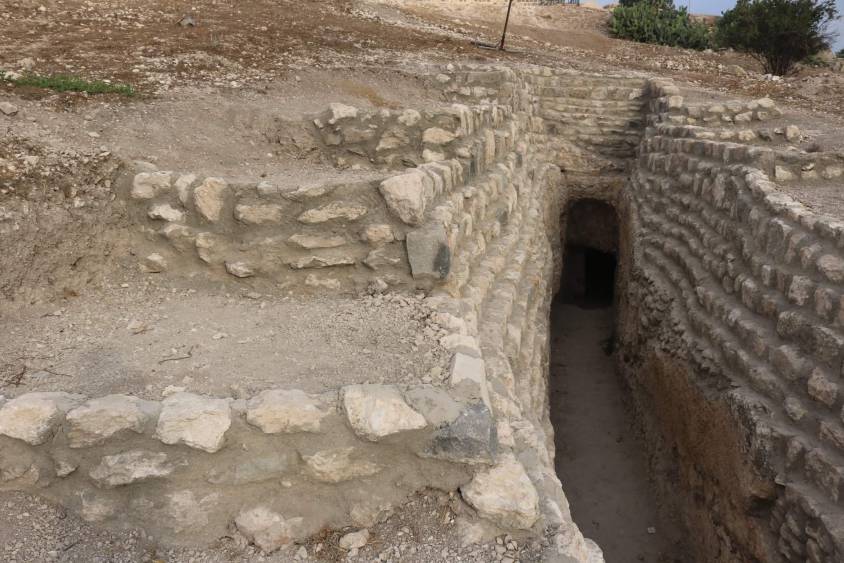
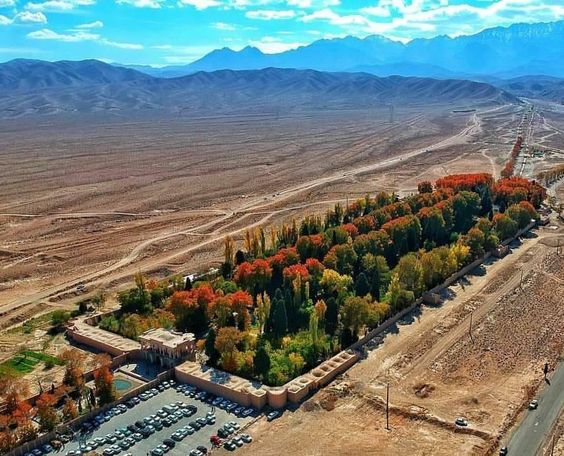
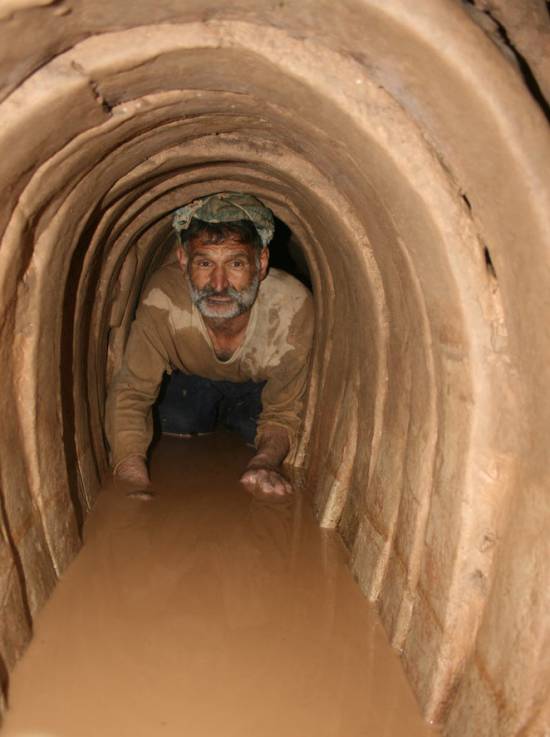
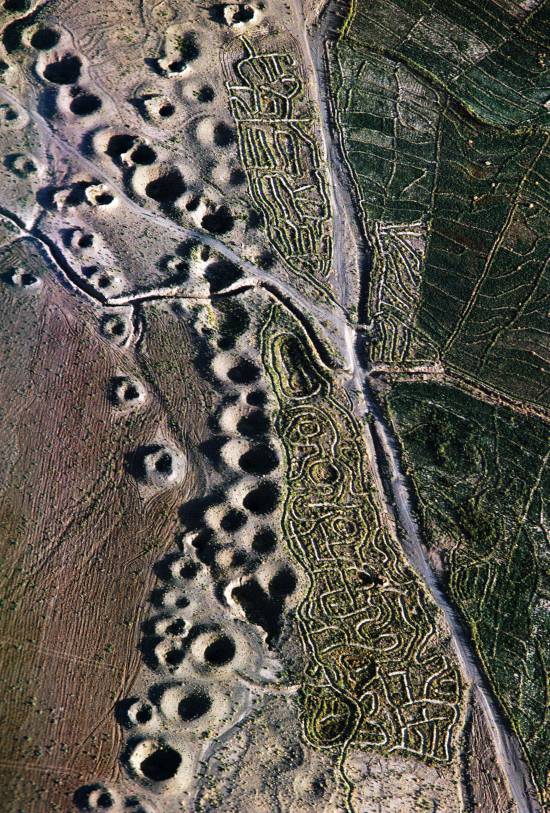
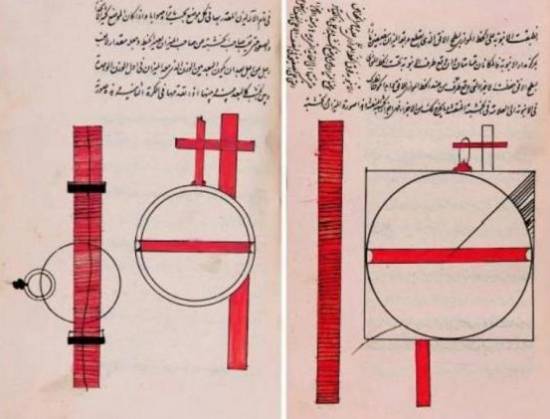


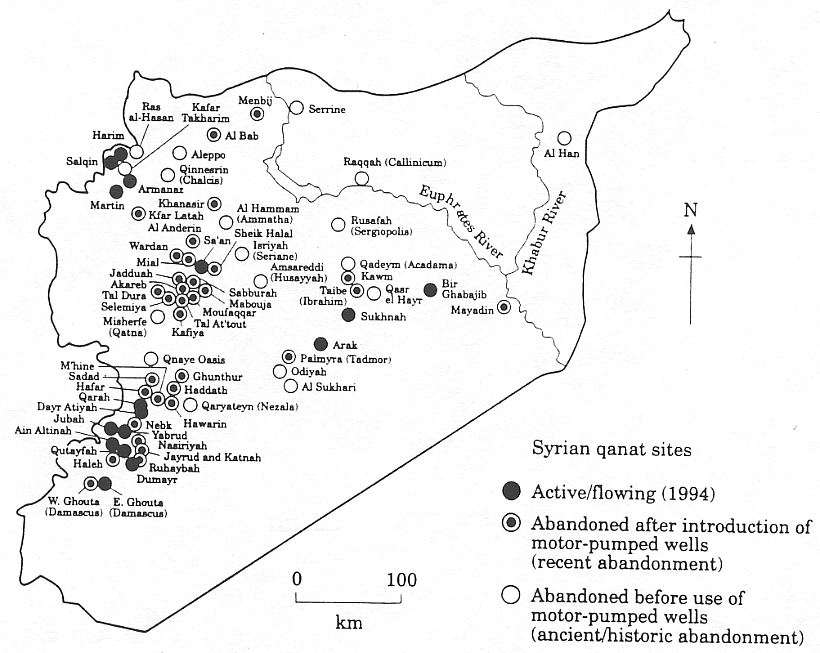
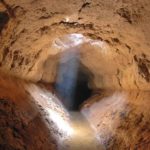
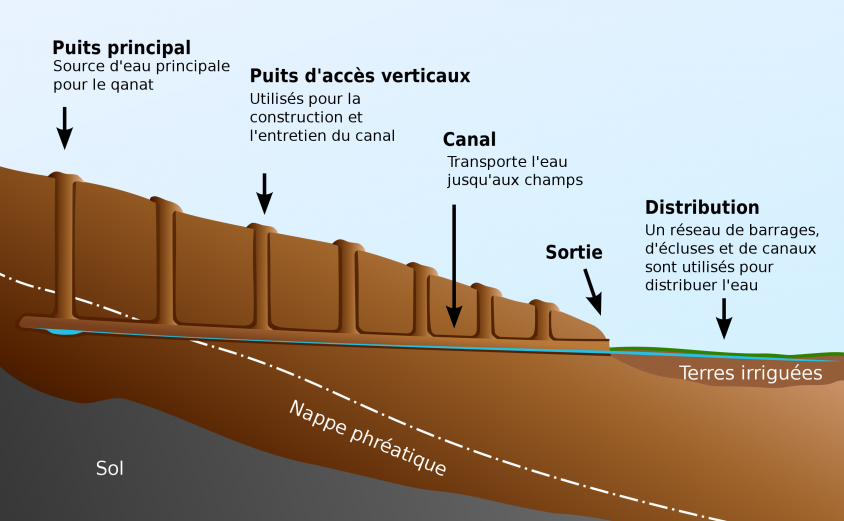
Posted by: Karel Vereycken | on avril 10, 2022
Avicenne et Ghiberti, leur rôle dans l’invention de la perspective à la Renaissance
This article, in EN
Tout visiteur du centre historique de Florence pose fatalement, à un moment donné, son regard sur les portes richement décorées du Baptistère, cet édifice roman faisant face à la cathédrale Santa Maria del Fiore, coiffée par Filippo Brunelleschi de sa magnifique coupole.
Dans cet article, Karel Vereycken apporte un éclairage nouveau sur les apports arabes à la science et le rôle crucial de Lorenzo Ghiberti dans l’invention de la perspective à la Renaissance.
Le Baptistère, que la plupart des Florentins pensaient être construit sur l’emplacement d’un temple romain dédié à Mars, le dieu tutélaire de l’ancienne Florence, est l’un des plus anciens bâtiments de la ville, construit entre 1059 et 1128 dans le style roman local.
Le poète italien Dante Alighieri et de nombreuses autres personnalités de la Renaissance, dont des membres de la famille Médicis, y furent baptisés.
A la Renaissance, à Florence, les corporations et les guildes se disputaient le premier rôle à coup de réalisations artistiques toutes aussi prestigieuses les unes que les autres.
Alors que l’Arte dei Lana (Corporation des producteurs de laine) finançait les Œuvres (Opera) du Duomo et donc la construction de sa coupole géante, l’Arte dei Mercatanti o di Calimala (Guilde des marchands d’étoffes étrangères) s’occupait du Baptistère et finançait l’embellissement des portes.
Les portes du Paradis
Le bâtiment octogonal possède quatre entrées, dont trois ont acquis une renommée artistique mondiale avec des portes ornées de bas-reliefs en bronze, recouverts entièrement ou en partie d’une fine couche d’or. Trois dates marquent les travaux : 1339, 1401 et 1424.
détail : baptême de Jésus (à gauche) et de ses disciples (à droite).
Avec l’aide de son père, il va réaliser son ouvrage en utilisant une technique connue sous le nom de « fonte à la cire perdue », technique qu’il a dû entièrement réinventer car perdue depuis la chute de l’Empire romain. L’une des raisons pour lesquelles Ghiberti a remporté le concours est le simple fait que sa technique était si avancée qu’elle nécessitait 20 % de métal en moins (7 kg par panneau) que celle de ses concurrents, le bronze étant un matériau onéreux, bien plus coûteux que le marbre. Sa technique, appliquée à l’ensemble de la décoration de la porte Nord, par rapport à celle de son concurrent, aurait permis d’économiser environ 100 kg de bronze. Or, en 1401, avec la peste qui harcelait régulièrement Florence, les conditions économiques étaient déclinantes, ce qui fait que la riche Calimala surveillait de près le coût du programme.
Pendant de l’œuvre de son prédécesseur, les bronzes de la porte nord comprennent eux aussi 28 panneaux, dont 20 représentent la vie du Christ d’après le Nouveau Testament. Les 8 panneaux inférieurs représentent les quatre évangélistes et les Pères de l’Église, saint Ambroise, saint Jérôme, saint Grégoire et saint Augustin.
Selon les Vies des artistes de Giorgio Vasari (1511-1574), Michelangelo Buonarroti (1475-1564) les jugera plus tard « si belles qu’elles orneraient l’entrée du Paradis ».
(commencées en 1424, terminées en 1452).
Dessin, sculpture, anatomie, perspective, travail des métaux, architecture, etc., en deux générations, le grand chantier des Portes permit à une myriade d’assistants et d’élèves bien payés d’accéder à une formation hors pair.
Parmi eux, plusieurs artistes exceptionnels tels que Luca della Robbia, Donatello, Michelozzo, Benozzo Gozzoli, Bernardo Cennini, Paolo Uccello, Andrea del Verrocchio et les fils de Ghiberti, Vittore et Tommaso. Au fil du temps, ces portes de bronze pesant trois tonnes et hautes de 5,06 mètres sont devenues une icône de la Renaissance, l’une des œuvres d’art les plus célèbres au monde.
En 1880, le sculpteur français Auguste Rodin s’en inspira pour ses propres Portes de l’Enfer, sur lesquelles il travailla pendant 38 ans.
La révolution
Le changement radical de conception de la sculpture en bronze, intervenu entre la Porte du nord et la Porte orientale, est essentiel pour notre discussion ici, car il reflète la façon dont l’artiste et ses mécènes ont voulu partager avec le public leurs nouvelles idées, inventions et découvertes.
Les thèmes du portail nord de 1401 s’inspiraient de scènes du Nouveau Testament, excluant de facto le panneau réalisé par Ghiberti, Le Sacrifice d’Isaac, qui lui avait valu de remporter le concours la même année. Pour compléter l’ensemble, il était donc tout à fait logique que la porte orientale de 1424 reprenne les thèmes de l’Ancien Testament.
A l’origine, c’est l’érudit et ancien chancelier de Florence Leonardo Bruni (1369-1444) qui avait programmé une iconographie assez semblable aux deux portes précédentes. Après des discussions animées, sa proposition fut écartée pour quelque chose de radicalement nouveau. En effet, au lieu de prévoir 28 panneaux, on décida, pour des raisons esthétiques, d’en réduire le nombre à seulement 10 reliefs carrés beaucoup plus grands, entre des bordures contenant des statuettes dans des niches et des médaillons avec des bustes.
Ainsi, chacun des 10 chapitres de l’Ancien Testament contient, pour ainsi dire, plusieurs événements, de sorte que le nombre net de scènes est passé de 20 à 37, et en plus, toutes apparaissent en perspective :
Le thème général est celui du salut à partir de la tradition patristique latine et grecque. Après les trois premiers panneaux, centrés sur le thème du péché, Ghiberti commence à mettre plus clairement en évidence le rôle du Dieu sauveur et la préfiguration de la venue du Christ. Les panneaux ultérieurs sont plus faciles à comprendre. C’est le cas du panneau Isaac, Jacob et Esaü, où les personnages se fondent dans une perspective de telle sorte que l’œil est guidé vers la scène principale.
La plupart des sources de ces scènes étant écrites en grec ancien, dont la maîtrise n’était pas si courante à l’époque, on pense que Ghiberti aurait eu pour conseiller théologique Ambrogio Traversari (1386-1439), avec qui il était en constante relation. Traversari était un proche de Nicolas de Cues (1401-1464), protecteur de Piero della Francesca (1412-1492) et organisateur actif du Conseil œcuménique de Florence de 1438-39, qui tenta de mettre fin au schisme séparant les Églises d’Orient et d’Occident.
Perspective
Les reliefs en bronze, connus pour leur vive illusion d’espace, sont l’un des événements révolutionnaires qui incarnent la Renaissance. On y voit de façon spectaculaire des figures passer d’une surface plane à toute la plénitude d’une existence en trois dimensions ! Techniquement parlant, on passe du stiacciato (développé à la perfection par Donatello)* à la ronde bosse, en passant par le bas-relief et le haut relief. Ghiberti avait bien conscience de son exploit, comme en témoigne son autoportrait sur la porte, la tête sortant d’une médaille de bronze, regardant avec satisfaction les spectateurs admirant son œuvre. L’artiste souhaitait bien plus qu’une perspective, il cherchait un espace de respiration !
Cette approche nouvelle influencera Léonard de Vinci (1452-1517). Comme le souligne l’historien d’art Daniel Arasse :
Au début du XVe siècle, plusieurs approches théoriques s’opposent. Vers 1423-1427, Donatello, un jeune collaborateur de Ghiberti réalisa son Festin d’Hérode, un bas relief selon la technique du stiacciato réalisé pour les fonts baptismaux du baptistère de Sienne.
Dans cette œuvre, le sculpteur déploie une perspective harmonieuse à point de fuite centrale. Vers la même époque, le peintre Massacchio (1401-1428) a utilisé une construction semblable dans sa fresque La Trinité.
Comme nous allons le voir, Ghiberti, partant de l’anatomie de l’œil, s’oppose aussi bien dans ses œuvres que dans ses écrits à cette approche abstraite et travaille, dès 1401, sur d’autres modèles géométriques, dites binoculaires. (voir plus bas).
Jésus parmi les docteurs, Ghiberti, avant 1424.
Jésus parmi les docteurs, Ghiberti, avant 1424.
Vers 1407, Brunelleschi a lui aussi mené plusieurs expériences sur cette question, très probablement sur la base d’idées développées par un autre ami de Nicolas de Cues, l’astronome italien Paolo dal Pozzo Toscanelli (1397-1482), dans son traité Della prospettiva, aujourd’hui perdu. Ce que l’on sait, c’est que Brunelleschi cherchait avant tout à démontrer que toute perspective n’est qu’illusion optique.
En 1435, l’architecte humaniste Leon Baptista Alberti (1406-1472), dans son traité Della Pictura, tentera, sur la base de l’approche de Donatello, de théoriser la représentation d’un espace tridimensionnel harmonieux et unifié sur une surface plane.
Malheureusement, au désespoir de bien des artistes, le traité d’Alberti, entièrement théorique, ne contient aucun diagramme ni illustration…
Sept ans plus tôt, le peintre Massacchio (1401-1428) avait utilisé, du moins en partie, une construction semblable dans sa fresque La Trinité.
Enfin, Léonard, qui avait lu et étudié les écrits de Ghiberti, utilisa ses arguments pour souligner les limites et même démontrer le dysfonctionnement de la construction de la perspective « parfaite » d’Alberti, surtout lorsqu’elle dépasse le cadre d’un angle de 30 degrés.
Dans le Codex Madrid, II, 15 v. de Vinci se rend à l’évidence qu’« en soi, la perspective offerte par une paroi rectiligne est fausse à moins d’être corrigée (…) »
Perspectiva artificialis versus perspectiva naturalis
La perspectiva articifialis d’Alberti n’est autre qu’une abstraction qui se veut nécessaire et utile pour représenter une organisation rationnelle de l’espace. Sans cette abstraction, nous dit-on, il est quasiment impossible de définir avec une précision mathématique les relations entre l’apparition des objets et le recul de leurs différentes proportions sur un écran plat : largeur, hauteur et profondeur.
A partir du moment où une image donnée sur un écran plat a été pensée comme la coupe transversale d’un cône ou d’une pyramide, une méthode a émergé pour ce qui est considéré, à tort, comme une représentation objective de l’espace tridimensionnel réel, alors qu’il ne s’agit que d’une anamorphose, c’est-à-dire un trompe-l’œil ou une illusion optique.
Ce qui est fâcheux, c’est que cette construction fait totalement abstraction de la réalité physique de notre appareil perceptif, en prétendant :
Calomnies et ragots
Pour des raisons qui restent à élucider, le rôle crucial de Ghiberti a été soit ignoré soit minimisé. Par exemple, les Commentarii, un manuscrit en trois volumes où Ghiberti retrace sa vie, son approche artistique et ses recherches sur l’optique et la perspective, n’a jamais été traduit en anglais ni en français. Et l’édition italienne ne date que de 1998.
Au XVIe siècle, Giorgio Vasari, qui fit souvent office d’agent de relations publiques pour le clan des Médicis, et dont l’ouvrage Les Vies des artistes est devenu l’alpha et l’oméga des historiens d’art, signale avec condescendance, mais sans évoquer une once de son contenu, que Ghiberti a écrit « un ouvrage en langue vernaculaire dans lequel il a traité de nombreux sujets différents, mais les a disposés de telle manière que l’on ne peut guère tirer profit de sa lecture ».
Qu’il ait pu exister des tensions entre humanistes, certes. Après tout, ces artisans autodidactes, tels que Ghiberti passionnés de progrès techniques, d’une part, et les héritiers de riches marchands de laine, tel le bibliophile Niccoli d’autre part, venaient de mondes totalement différents. D’après une anecdote racontée par Guarino Veronese, en 1413, Niccoli rencontre un jour Filippo et le salue de manière hautaine en ces termes : « Ô philosophe sans livres », à quoi Filippo lui aurait répliqué en souriant : « Ô livres sans philosophe… »
A cela s’ajoute que comme le stipulait le contrat, Ghiberti a accordé l’œuvre commandée en 1401 avec l’œuvre de Pisano d’inspiration gothique. Du coup, certains en déduisent que Ghiberti n’appartenait pas réellement à la Renaissance. Pour preuve, selon ses détracteurs, « son souci du détail et ses figures aux lignes ondulées et élégantes, ainsi que la variété des plantes et des animaux représentés… »
Les humanistes
symbolisée ici par la rencontre entre ces deux personnages royaux.
On pense que cette scène a été créée à la demande d’Ambrogio Traversari, présent dans la foule et instigateur du Conseil œcuménique de Florence de 1438.
Certes, les Commentarii ne sont pas rédigés selon les règles rhétoriques de l’époque. Écrits à la fin de sa vie, ils pourraient même avoir été dictés par l’artiste vieillissant à un clerc mal formé, faisant quantité de fautes d’orthographe.
Cependant, les propos de Ghiberti révèlent un auteur instruit, ayant une connaissance approfondie de nombreux penseurs classiques grecs et arabes. Il n’était pas seulement un brillant artisan, mais bien un « homme de la Renaissance » typique. En dialogue permanent avec Bruni, Traversari et le « chasseur de manuscrits » Niccolo Niccoli, Ghiberti, qui ne savait pas lire le grec mais connaissait bien le latin, était manifestement au courant de cette redécouverte de la science grecque et arabe.
Cette ambition était portée par les membres du Cercle San Spirito fondé par Boccace et Salutati, et dont les invités (parmi lesquels Bruni, Traversari, Cues, Niccoli, Côme de Médicis, etc.) se réuniront par la suite au couvent Santa Maria degli Angeli.
Ghiberti échange d’ailleurs avec Giovanni Aurispa, ce collaborateur de Traversari qui ramena, avant Bessarion, l’ensemble des oeuvres de Platon en Occident.
Amy R. Bloch, dans son étude très documentée Lorenzo Ghiberti’s Gates of Paradise, Humanism, History, and Artistic Philosophy in the Italian Renaissance (2016), note que « Traversari et Niccoli peuvent être liés directement aux origines du projet des Portes et étaient clairement intéressés par les commandes de sculptures prévues pour le Baptistère « .
« Le 21 juin 1424, après que la Calima ait demandé à Bruni son programme pour les portes, Traversari écrit à Niccoli en reconnaissant, en termes seulement généraux, les idées de Niccoli pour les histoires à inclure et en mentionnant, sans désapprobation évidente, que la guilde s’était plutôt tournée vers Bruni pour obtenir des conseils.«
Palla Strozzi
Ghiberti se lie également d’amitié avec Palla Strozzi (1372-1462), qui, en plus d’être l’homme le plus riche de Florence avec une fortune imposable de 162 925 florins en 1427, comprenant 54 fermes, 30 maisons, une entreprise bancaire au capital de 45 000 florins et des obligations communales, était aussi un homme politique, un écrivain, un philosophe et un philologue.
Tout comme Ambrogio Traversari, Paolo Rossi et Leonardo Bruni, Palla Strozzi a étudié le grec sous la direction de l’érudit byzantin Manuel Chrysoloras, invité à Florence par Salutati pour y enseigner le grec. A noter, le fait que Strozzi prit à sa charge une partie du traitement de Chrysoloras et fit venir de Constantinople et de Grèce les livres nécessaires à l’enseignement nouveau. La relation étroite de Ghiberti avec Palla Strozzi, écrit Bloch, « lui donnait accès à ses manuscrits et, ce qui est tout aussi important, à la connaissance qu’en avait Strozzi. «
Ce n’était pas tout, car « la relation entre Ghiberti et Palla Strozzi était si étroite que, lorsque Palla se rendit à Venise en 1424 comme l’un des deux ambassadeurs florentins chargés de négocier une alliance avec les Vénitiens, Ghiberti l’accompagna dans sa suite. »
Strozzi était connu comme un véritable humaniste, cherchant toujours à préserver la paix tout en s’opposant fermement au pouvoir oligarchique, tant à Florence qu’à Venise.
En fait, c’est Palla Strozzi, et non Cosimo de’ Medici, qui a été le premier à lancer les plans de la première bibliothèque publique de Florence, et il avait l’intention de faire de la sacristie de Santa Trinita son entrée. Si la bibliothèque de Palla n’a jamais été réalisée en raison du conflit politique dramatique connu sous le nom de Coup des Albizzi qui a conduit Strozzi à son exil en 1434, Cosimo, qui a eu les coudées franches pour régner sur Florence, fera sien le projet de bibliothèque.
Un constat audacieux
Tout d’abord, Lorenzo Ghiberti fait un constat audacieux, pour un chrétien dans un monde chrétien, sur la façon dont l’art de l’Antiquité a été perdu :
Ghiberti comprenait l’importance de la multidisciplinarité pour la formation de l’artiste.
Selon lui, « la sculpture et la peinture sont des sciences de plusieurs disciplines nourries par des enseignements différents ».
Dans le livre I de ses Commentarii, Ghiberti donne une liste des 10 arts libéraux que le sculpteur et le peintre doivent maîtriser : philosophie, histoire, grammaire, arithmétique, astronomie, géométrie, perspective, théorie du dessin, anatomie et médecine et souligne la nécessité pour un artiste d’assister aux dissections anatomiques.
Comme le souligne Amy Bloch, alors qu’il travaillait sur les Portes, dans le processus intense de visualisation des histoires de la formation du monde par Dieu et de ses habitants vivants, l’engagement de Ghiberti « a stimulé en lui un intérêt pour l’exploration de tous les types de créativité – non seulement celle de Dieu, mais aussi celle de la nature et des humains – et l’a conduit à présenter dans le panneau d’ouverture de la Porte du Paradis (La création d’Adam et Eve) une vision grandiose de l’émergence de la création divine, naturelle et artistique. »
création d’Adam, création d’Eve, la tentation et enfin, expulsion du Jardin d’Eden.
L’inclusion de détails évoquant le savoir-faire de Dieu, dit Bloch, « rappelle les images qui comparent Dieu, en tant que créateur du monde, à un architecte, ou, dans son rôle de créateur d’Adam, à un sculpteur ou à un peintre. Cette comparaison, qui dérive finalement de l’architecte-démiurge qui crée le monde dans le Timée de Platon, apparaît couramment dans l’exégèse médiévale juive et chrétienne ».
Philon d’Alexandrie a écrit que l’homme a été modelé « comme par un potier » et Ambroise a métaphoriquement appelé Dieu un « artisan (artifex) et un peintre (pictor) ».
Par conséquent, si l’homme est « l’image vivant du créateur » comme le dit Augustin et le modèle de « l’homo faber – homme producteur de choses », alors, soulignait l’humaniste Coluccio Salutati, « l’organisation des affaires humaines doit avoir une similitude avec celle des affaires divines ».
Ghiberti portait une attention particulière au fonctionnement de la vision :
Ainsi, tout chercheur honnête, qui a épluché les Carnets de Léonard après avoir lu les Commentarii de Ghiberti, se rend immédiatement à l’évidence que bien des observations de Léonard, dont le caractère génial est incontestable, font écho aux problématiques soulevées par Ghiberti, notamment en ce qui concerne la nature de la lumière et l’optique en général. L’état d’esprit créatif de Léonard était en partie le fruit de cette continuité, comme conséquence heureuse de la vision stimulante du monde de Ghiberti.
La composition de l’œil
Dans son Commentario 3, 6, qui traite de l’optique, de la vision et de la perspective, s’opposant à ceux pour qui la vision ne peut être expliquée que par une abstraction purement mathématique, Ghiberti écrit que « pour qu’aucun doute ne subsiste dans les choses qui suivent, il est nécessaire de considérer la constitution de l’œil, car sans cela, on ne peut rien savoir sur comment fonctionne la vision ». Selon lui, ceux qui écrivent sur la perspective ne tiennent aucun compte de « la composition de l’œil », sous prétexte que trop d’auteurs se contredisent.
Alhazen, Avicenne et Constantine
Il regrette aussi que, bien que des « philosophes de la nature » tels que Thalès, Démocrite, Anaxagore ou Xénophane, aient examiné le sujet avec d’autres s’intéressant à la santé humaine, tels qu’Hippocrate, Galien et Avicenne, trop de choses restent confuses et incomprises.
C’est pourquoi, dit Ghiberti, « parler de cette matière est obscur et incompris si l’on n’a pas recours aux lois de la nature, car elles démontrent cette question de manière plus complète et plus abondante ».
Par conséquent, poursuit Ghiberti,
Arrêtons-nous un instant sur ce passage qui nous dit tant de choses. Voici Ghiberti, un, ou plutôt « le » personnage central, fondateur de la Renaissance italienne et européenne et de son grand apport en termes de perspective, qui affirme que pour avoir une idée du fonctionnement de la vision, il faut étudier trois scientifiques arabes : Ibn Sina, Ibn al Haytham et Qusta ibn Luqa ! L’eurocentrisme culturel pourrait peut-être expliquer pourquoi les écrits de Ghiberti ont été ignorés et restent quasiment au placard.
Ibn al-Haytham (Alhazen) a apporté d’importantes contributions à l’ophtalmologie. Dans son Traité d’optique (1021, en arabe Kitab al-Manazir (كِتَابُ المَنَاظِر ), en latin De Aspectibus ou Opticae Thesaurus: Alhazeni Arabis), il a amélioré les conceptions antérieures des processus impliqués dans la vision et la perception visuelle. Au cours de ses travaux sur la camera oscura (chambre noire), il fut également le premier à imaginer que la rétine (une surface incurvée), et non plus la pupille (un point), pouvait être impliquée dans le processus de formation des images. Avicenne, dans le Canon de la médecine (vers 1025), décrit la vue et utilise le mot rétine (du latin rete qui signifie réseau) pour désigner l’organe de la vision. Plus tard, dans son Colliget (encyclopédie médicale), Averroès (1126-1198) est le premier à attribuer à la rétine les propriétés d’un photorécepteur.
Si les écrits d’Avicenne sur l’anatomie et la science médicale avaient été traduits et circulaient en Europe dès le XIIIe siècle, le traité d’optique d’Alhazen, que Ghiberti cite abondamment, venait d’être traduit en italien sous le titre De li Aspecti.
Il est désormais reconnu qu’Andrea del Verrocchio, dont l’élève le plus célèbre fut Léonard de Vinci (1452-1517), était lui-même un élève de Ghiberti. Contrairement à ce dernier, qui maîtrisait le latin, ni Verrocchio ni Léonard ne maîtrisaient de langue étrangère. Ainsi, c’est en étudiant les Commentarii de Ghiberti que Léonard eut accès à la traduction en italien de citations originales de l’architecte romain Vitruve et aux apports de scientifiques arabes tels qu’Avicenne, Alhazen ou Averroès, de scientifiques européens ayant étudié l’optique arabe, notamment les franciscains d’Oxford, Roger Bacon, John Pecham, ainsi que le moine polonais travaillant à Padoue, Erazmus Ciolek Witelo (Vitellion, 1230-1275).
Comme le souligne le Pr Domnique Raynaud, Vitellion introduit le principe de la vision binoculaire par des considérations géométriques.
Il donne une figure où l’on voit les deux yeux (a, b) recevant des images différentes provenant d’un même plan. Or, chaque œil, lorsqu’il observe par exemple le segment gf, le voit avec un angle différent, puisque l’œil a est plus proche que l’œil b du segment observé (l’angle de grf n’est pas le même que l’angle gtf). Il faut donc qu’à un moment donné ces images soient réunies en une seule. Où se produit cette jonction ?
Vitellion répond :
La fusion des images est donc un produit de l’activité mentale et nerveuse interne.
Le grand astronome Johannes Kepler (1571-1630) utilisera les découvertes d’Alhazen repris par Witelo pour développer sa propre contribution à l’optique et à la perspective.
« Bien que jusqu’à présent l’image [visuelle] ait été [comprise comme] une construction de la raison », observe Kepler dans le cinquième chapitre de son ouvrage Ad Vitellionem Paralipomena (1604), « désormais, les représentations des objets doivent être considérées comme des peintures qui sont effectivement projetées sur du papier ou sur un autre écran. »
Kepler fut le premier à constater que notre rétine capte l’image sous forme renversée, avant que notre cerveau ne la remette à l’endroit.
A partir de là, Ghiberti, Uccello, de même que le peintre flamand Jan Van Eyck (1390-1441), en contact avec les Italiens, construiront, comme alternative à la perspective abstraite, des formes de perspective « binoculaire », tandis que Léonard et Jean Fouquet, le peintre de la cour de Louis XI, tenteront de développer des représentations de l’espace curviligne et sphérique.
En Chine, sous l’influence éventuelle des percées de la science optique arabe, des formes de perspective non-linéaire, intégrant la mobilité de l’œil, feront également leur apparition sous la dynastie Song.
La lumière, une autre dimension
Ghiberti ajoutera une autre dimension à la perspective : la lumière. L’un des apports majeurs d’Alhazen est l’affirmation, dans son Livre sur l’optique, que les objets opaques frappés par la lumière deviennent eux-mêmes des corps lumineux et peuvent rayonner une lumière secondaire, une théorie que Léonard exploitera dans ses tableaux, y compris dans ses portraits.
Déjà Ghiberti, dans la façon dont il traite le sujet d’Isaac, Jacob et Ésaü, nous donne une démonstration étonnante de la façon dont on peut exploiter ce principe physique théorisé par Alhazen.
La lumière réfléchie par le panneau de bronze diffère fortement selon l’angle d’incidence des rayons lumineux qui arrivent. Arrivant soit du côté gauche, soit du côté droit, dans les deux cas, le relief en bronze de Ghiberti a été modelé de telle façon qu’il renforce magnifiquement l’effet de profondeur de la scène !
Conclusion
Les historiens d’art, en particulier les néo-kantiens comme Erwin Panofsky ou Hans Belting, qui affirment que ces peintres étaient des primitifs parce qu’ils appliquaient « le mauvais modèle » de perspective, s’avèrent en réalité incapables de concevoir que ces artistes qu’ils méprisent exploraient un domaine nettement supérieur à la pure abstraction mathématique promue par les grands prêtres de la science post-Leibniz, pour qui le dogme Newton-Galilée-Descartes sera l’évangile ultime.
Bien des sujets devront être exposés plus amplement que le résumé que j’en ai fait ici. En attendant, disons simplement que la meilleure façon d’honorer notre dette envers les contributions scientifiques arabes et les artistes de la Renaissance, serait de donner au monde entier, qui aurait dû en profiter bien plus tôt, la récompense d’un avenir meilleur bénéfique pour tous.
Il n’est pas trop tôt pour ouvrir toutes grandes les « Portes du Paradis ».
Regarder toutes les œuvres de Ghiberti sur la GALERIE D’ART WEB
Biographie sommaire
[1] Le relief aplati, relief écrasé ou stiacciato (de l’italien schiacciato, « écrasé »), est un terme qui désigne une technique sculpturale située entre le relief méplat et le bas-relief, permettant de réaliser sur une surface plane un relief de très faible épaisseur obéissant aux règles de la représentation en perspective. L’impression de profondeur par effet d’optique (plusieurs plans perspectifs) est donnée par une façon de sculpter graduellement en « relief écrasé », quelquefois sur une épaisseur de seulement quelques millimètres, du premier plan jusqu’à un point de fuite souvent central. Cette technique a été utilisée surtout aux XVe et XVIe siècles et Donatello en fut le principal initiateur.
Posted in Comprendre, Etudes Renaissance | Commentaires fermés sur Avicenne et Ghiberti, leur rôle dans l’invention de la perspective à la Renaissance
Tags: al Haytham, Alberti, Alhazen, anatomie, Ancien Testament, Andrea del Verrocchio, Andrea Pisano, antiqua, arabe, arithmétique, artkarel, astronomie, Averroès, avicenne, Bagdad, Baptistère, Belting, Benozzo Gozzoli, Bernardo Cennini, Borso, bronze, Brunelleschi, Calimala, chine, Christ, Côme, Commentarii, Concile de Florence, concours, corporations, coupole, cues, cyclope, Della Pictura, Descartes, dessin, dôme, Donatello, évangile, Florence, Galien, Galilée, géométrie, Ghiberti, gothique, grammaire, guildes, Hippocrate, Ibn Luqa, Ibn Sina, invention, Karel, Karel Vereycken, Kepler, Krauthammer, La vie des artistes, Lana, Léonard, Léonardo Bruni, Lorenzo Ghiberti, Luca della Robbia, Massacchio, médecine, Medecis, Michelange, Mutazilisme, Newton, Niccoli, Nouveau Testament, Occident, oeil, orfèvre, Orient, Panofsky, Paolo Uccello, perspective, Pétrarque, philosophie, Piero della Francesca, Pierre Brueghel l'Ancien, Portes du Paradis, Rashed, Raynaud, renaissance, retine, Sacrifice d'Isaac, saint Ambroise, Saint Augustin, saint Grégoire, saint Jean-Baptiste, Saint Jérôme, San Spirito, Santa Maria degli Agneli, Santa Maria del Fiore, schisme, sculpteur, song, stiacciato, Tommaso, toscanelli, Traversari, Van Eyck, Vasar, Vereycken, vinci, Vitellion, Vitruve, Vittore